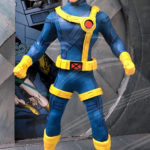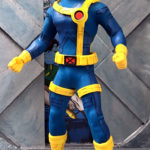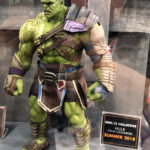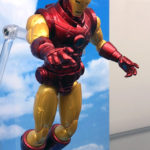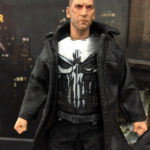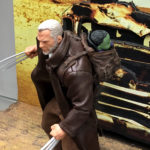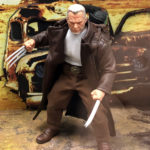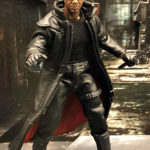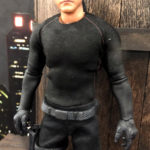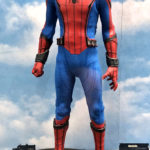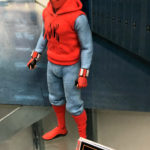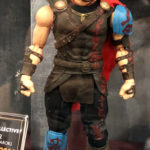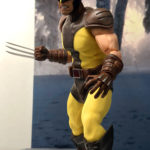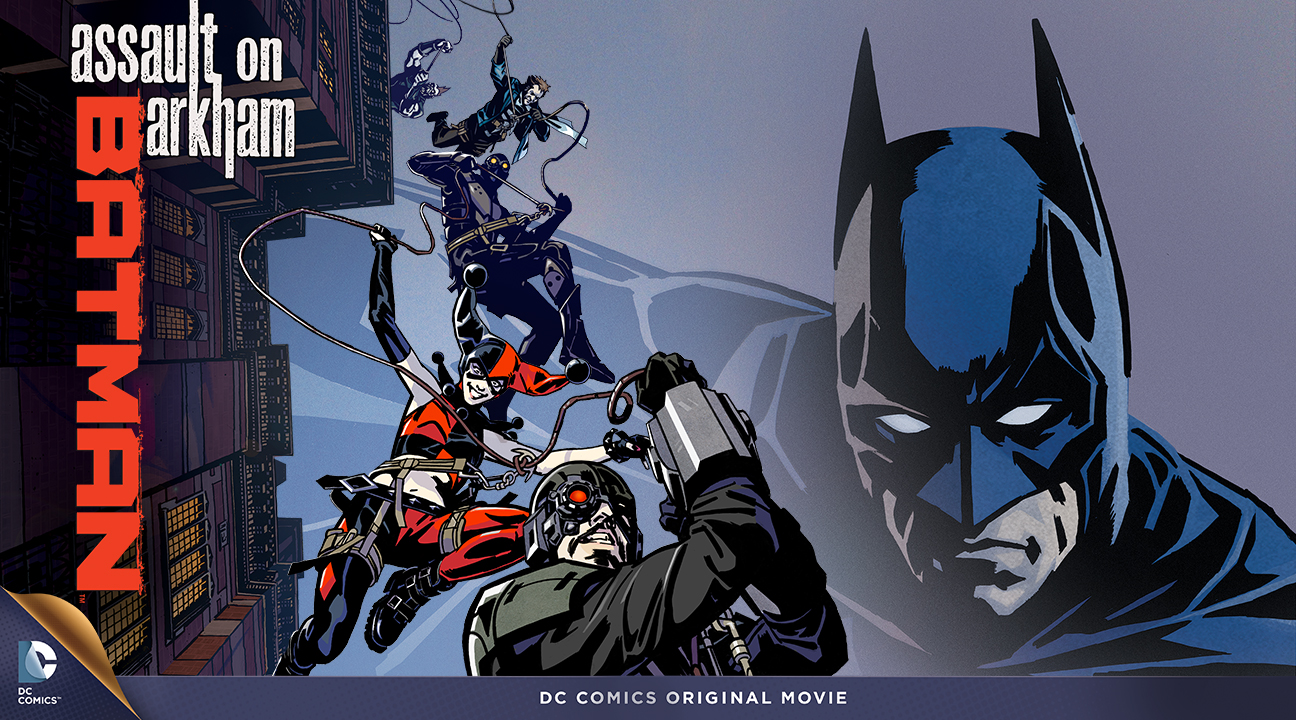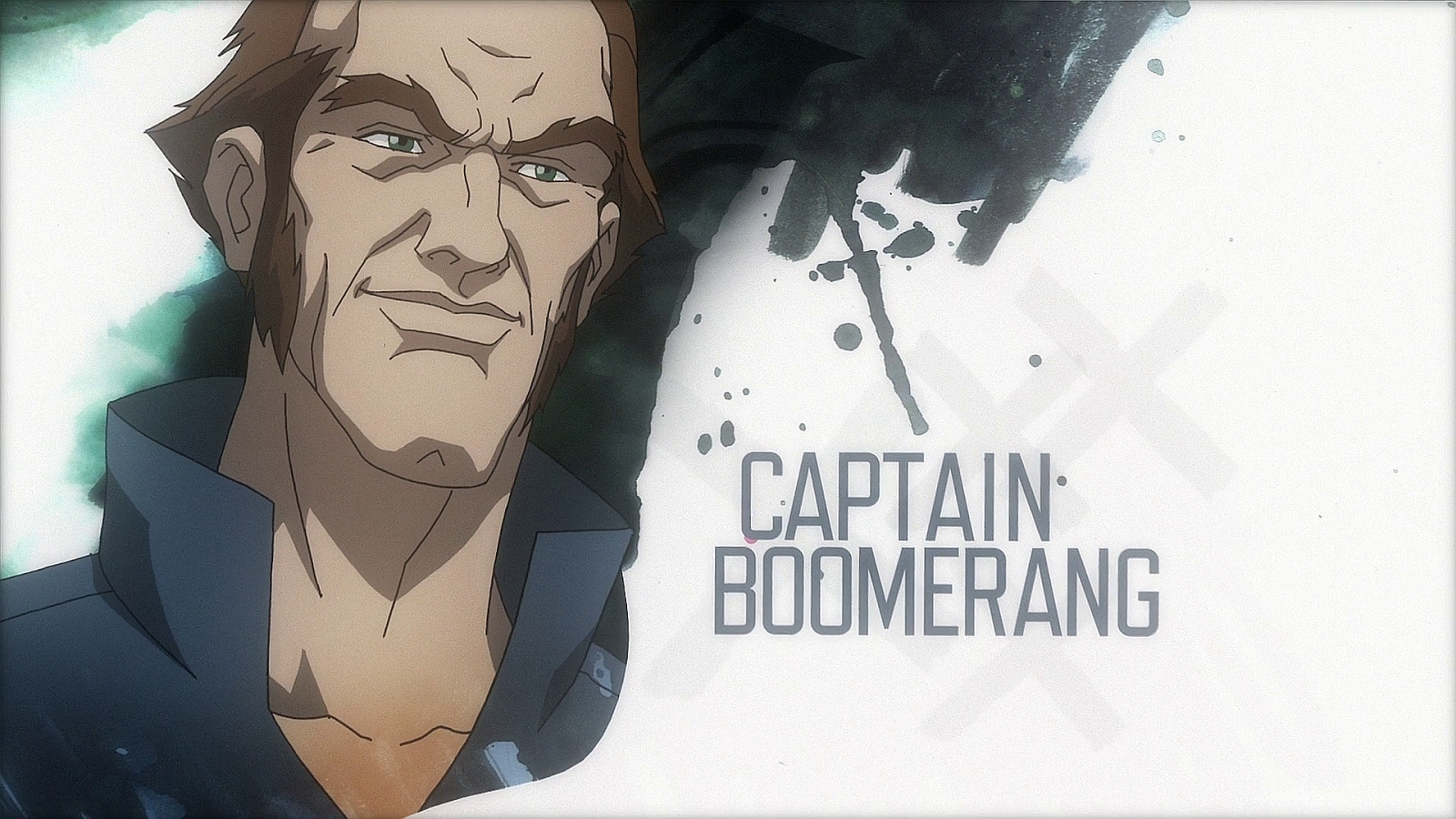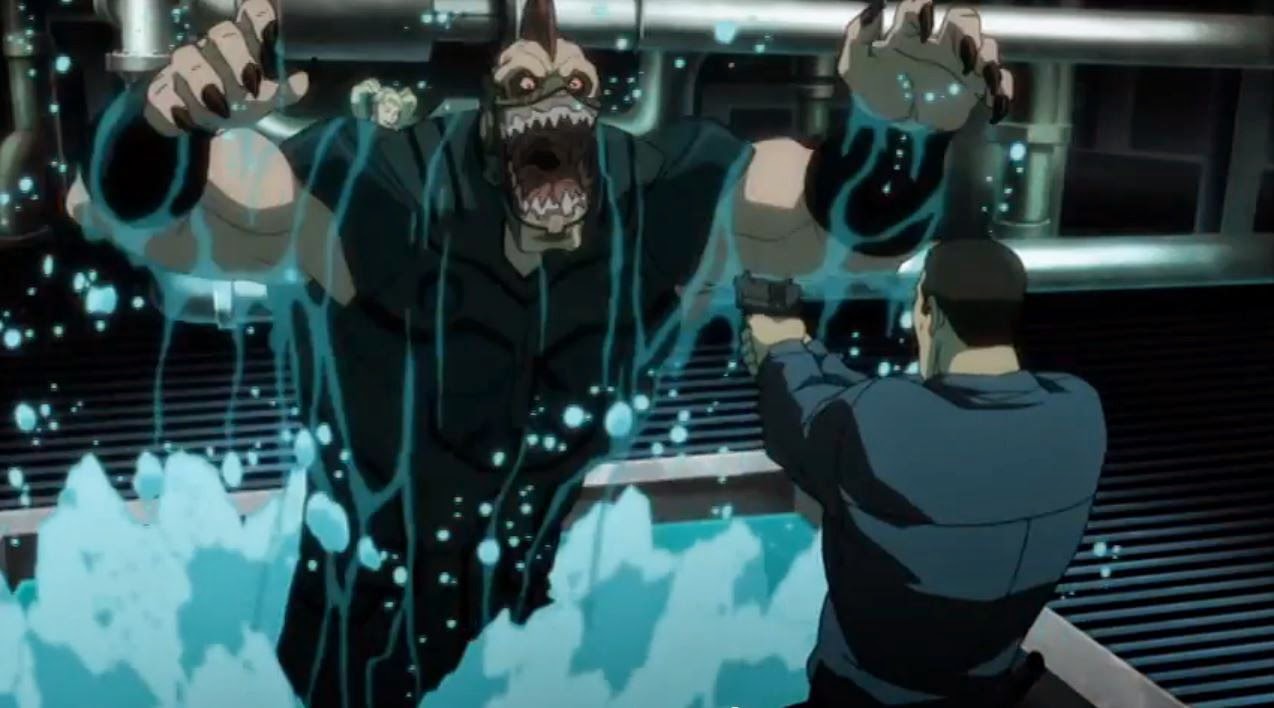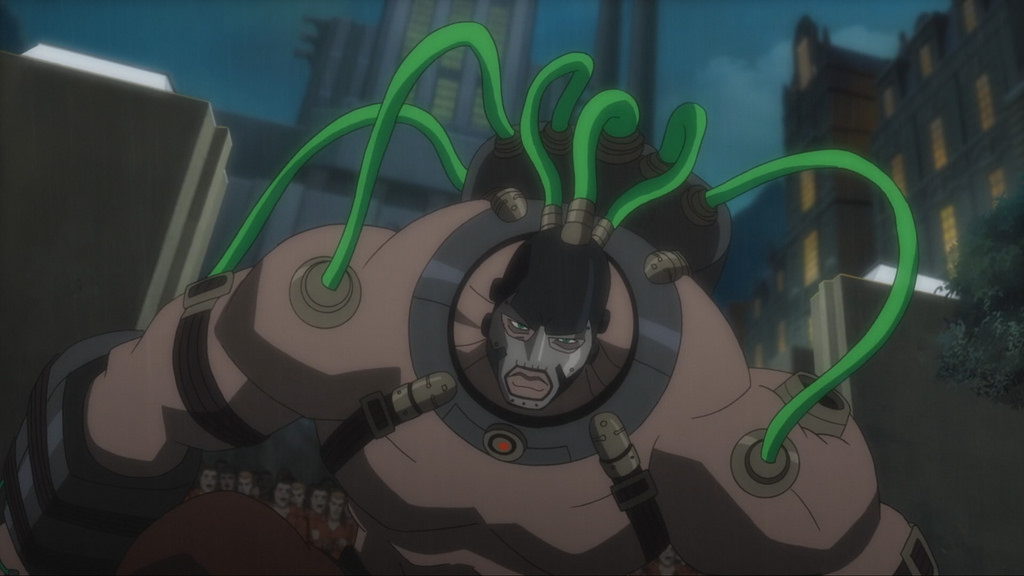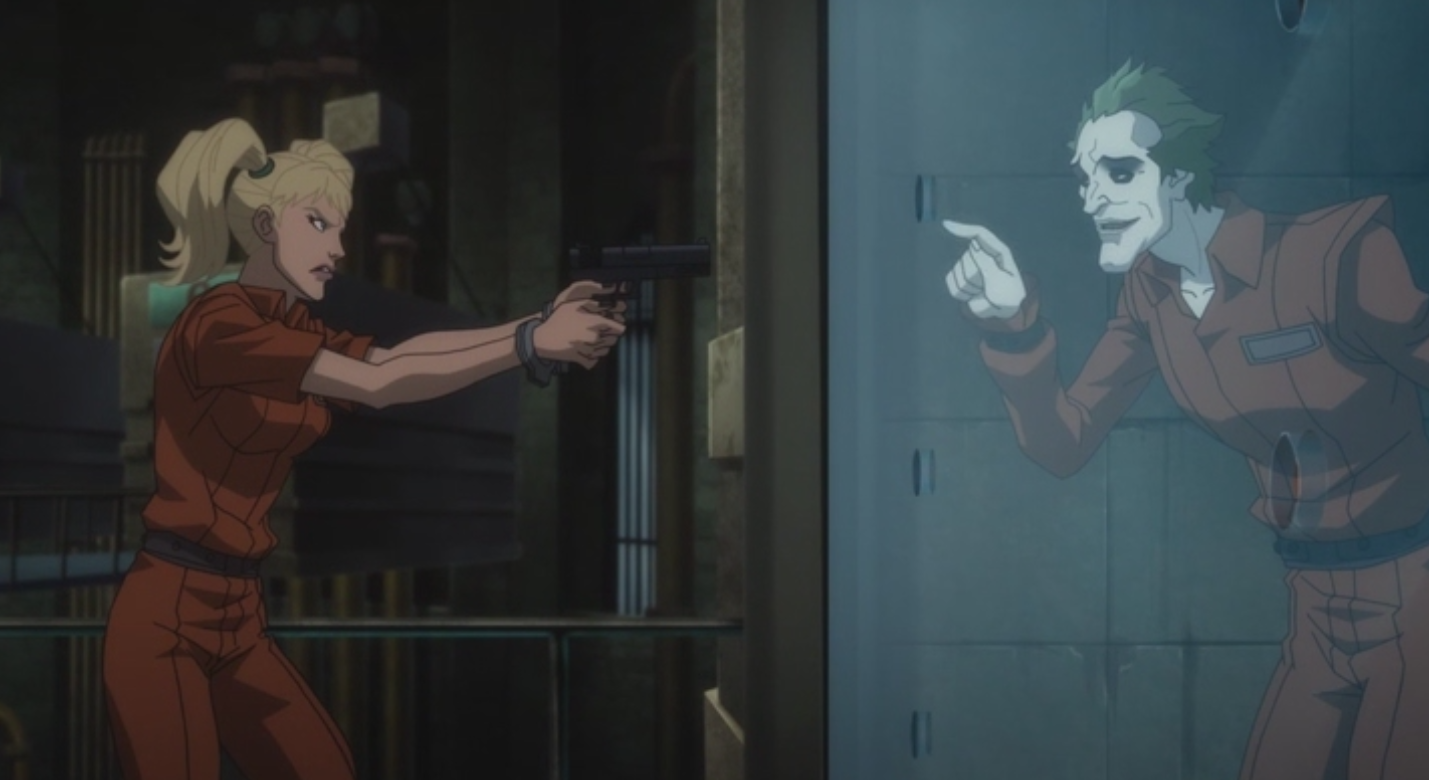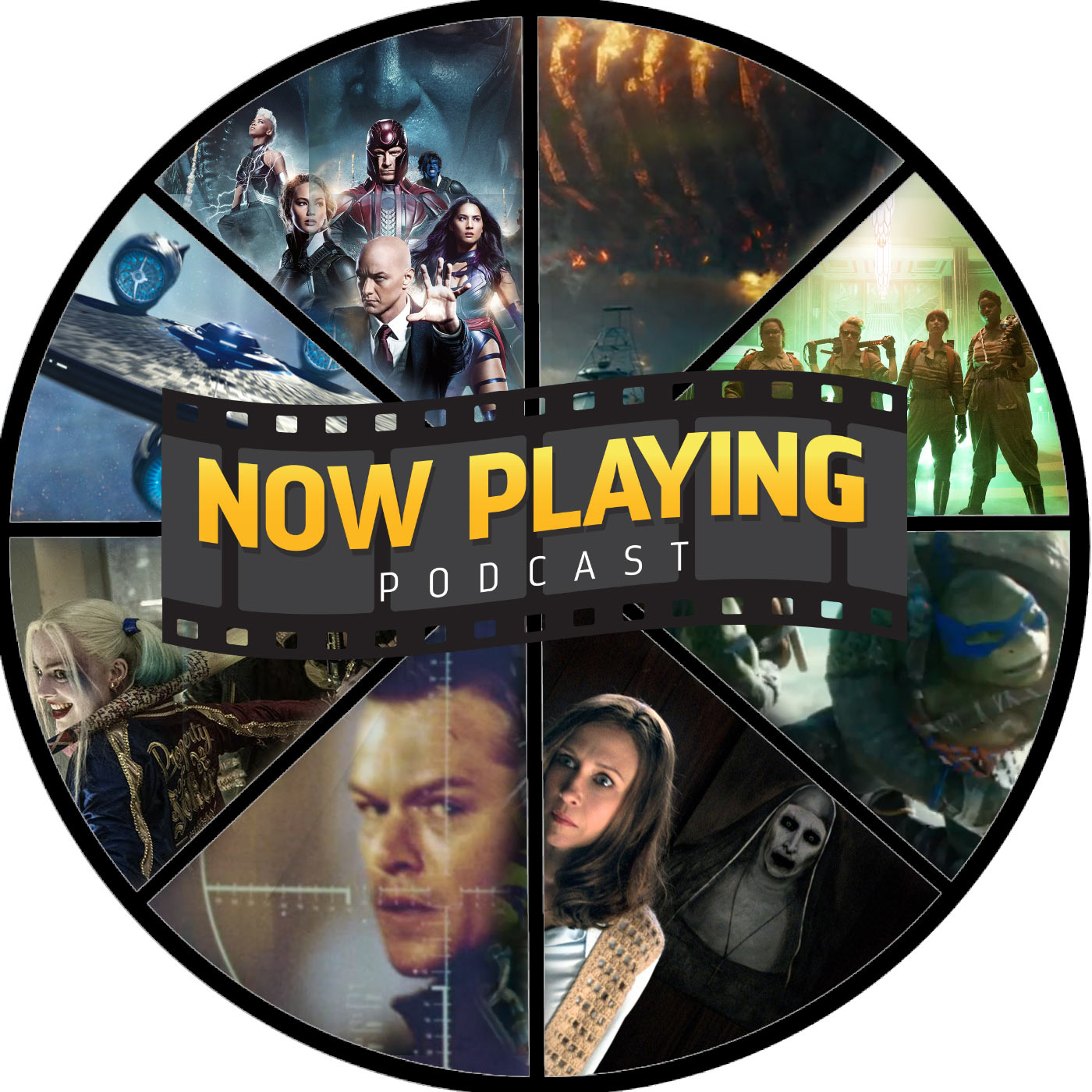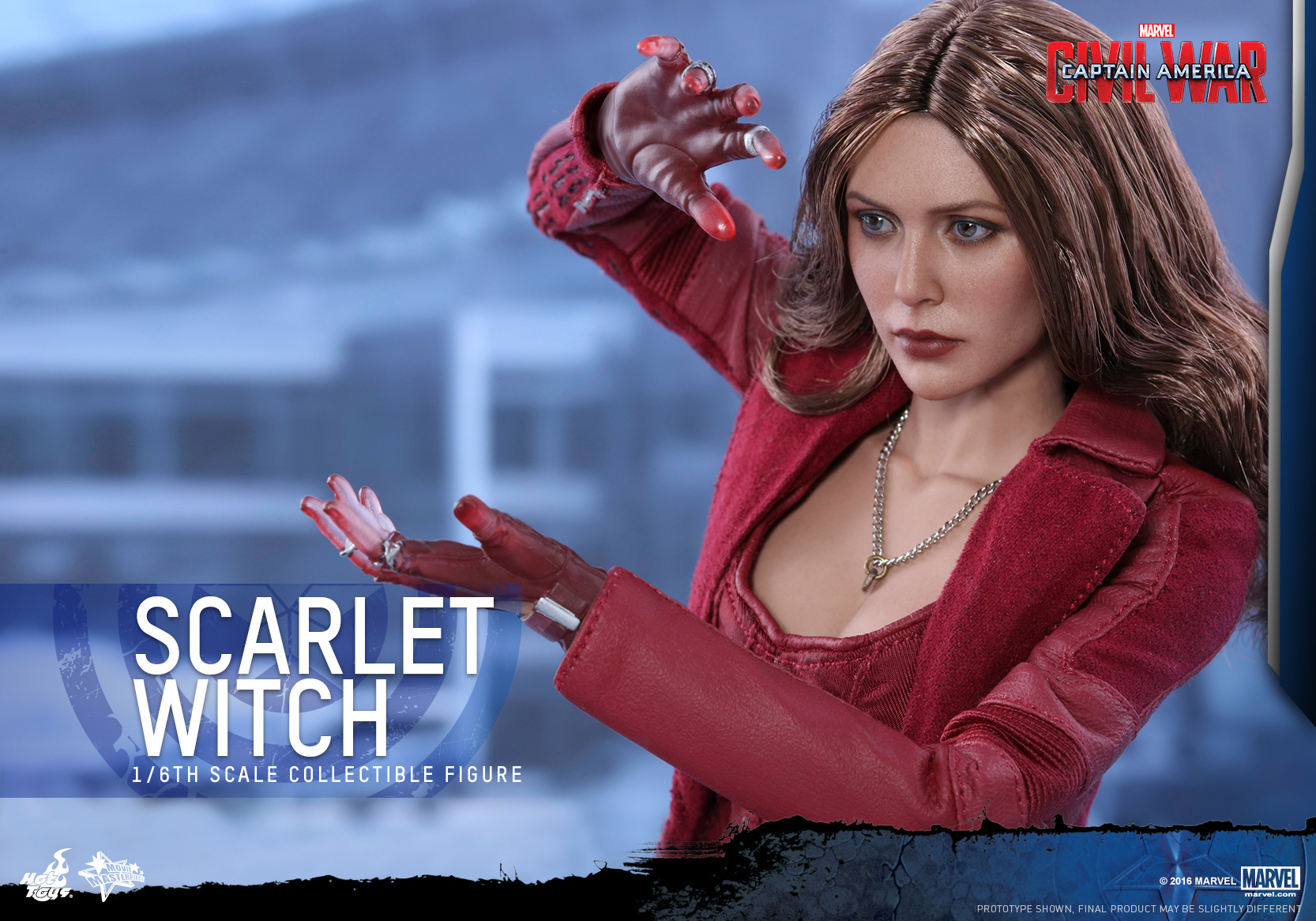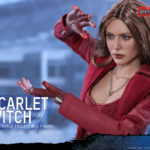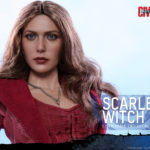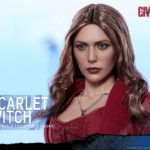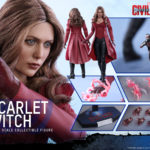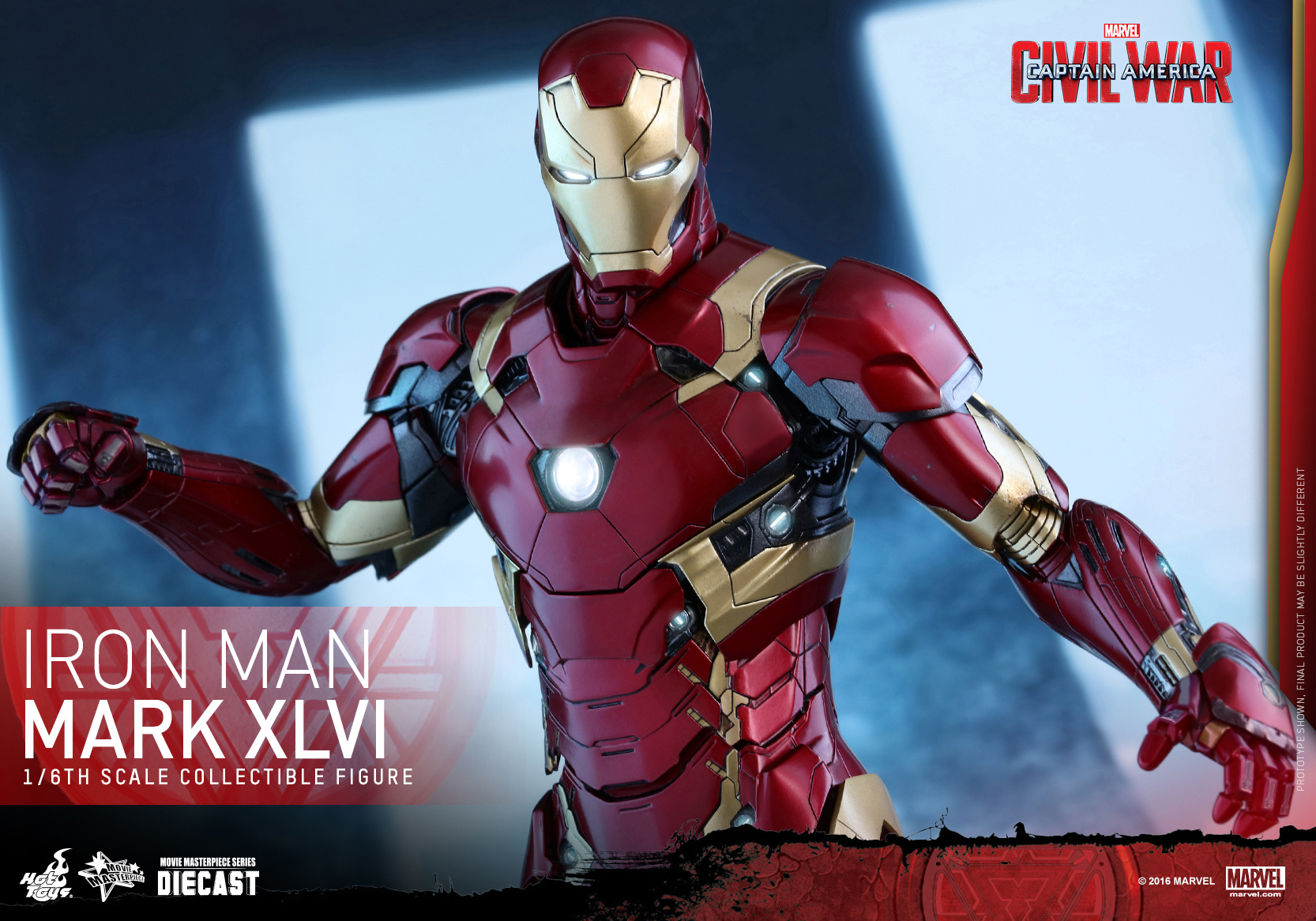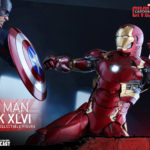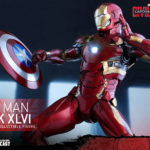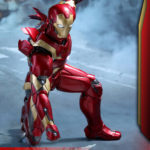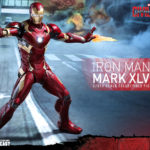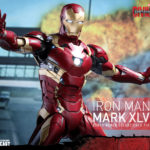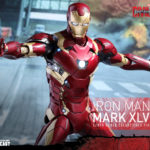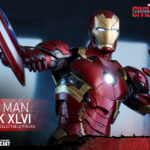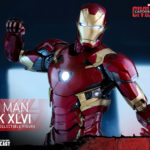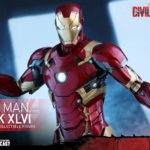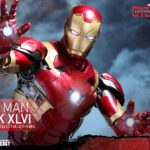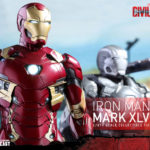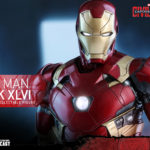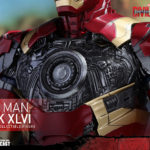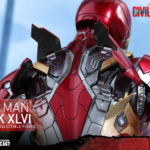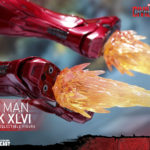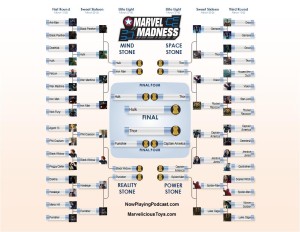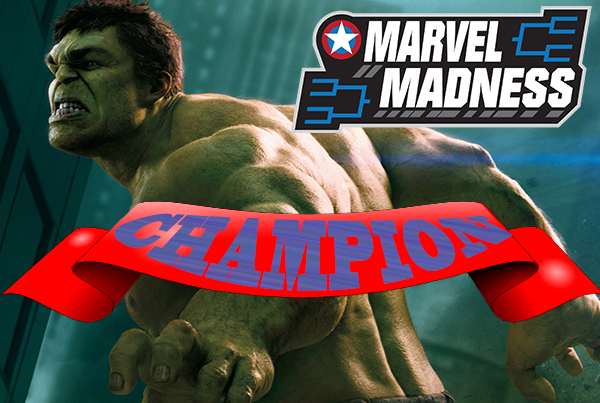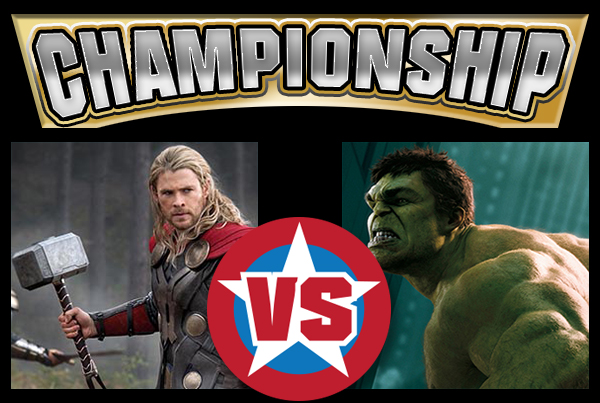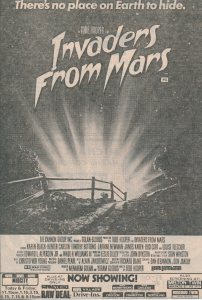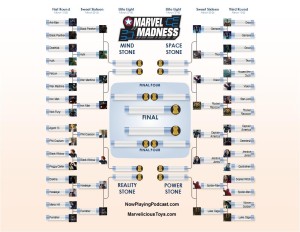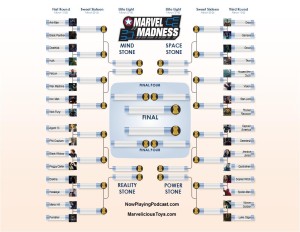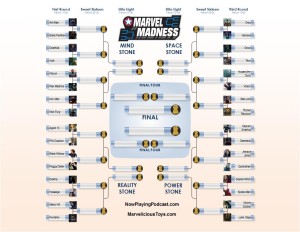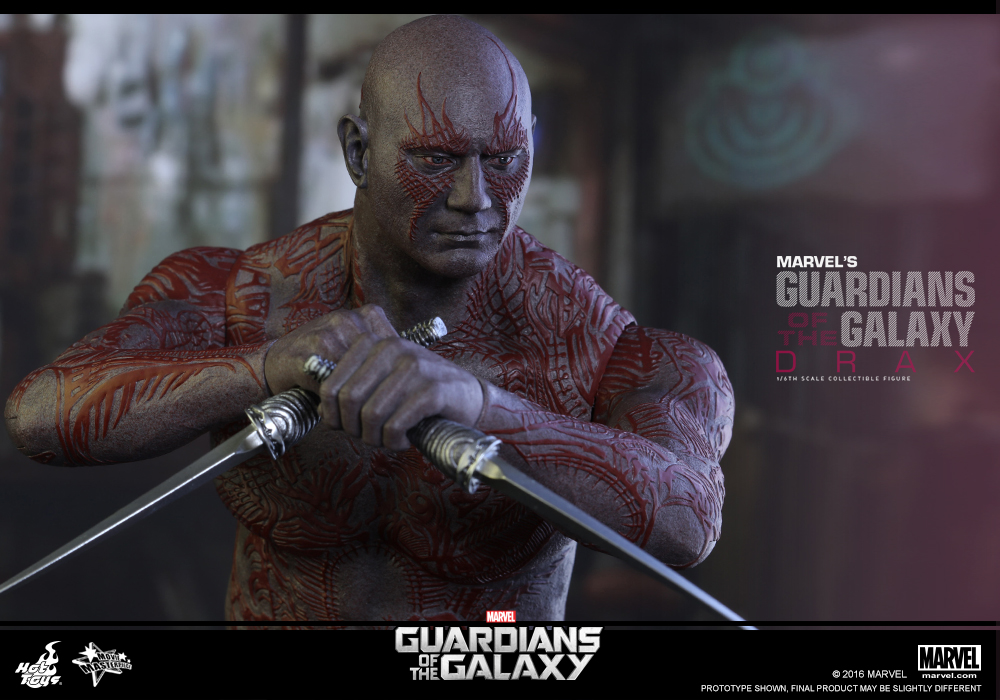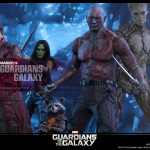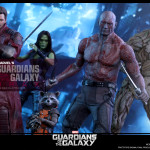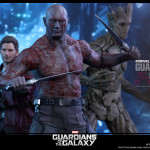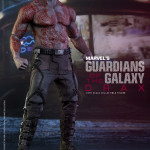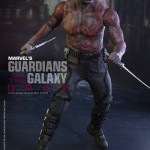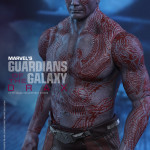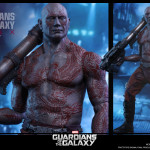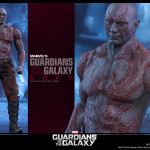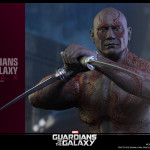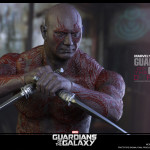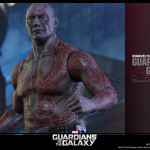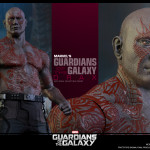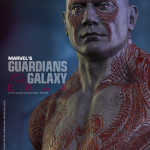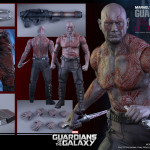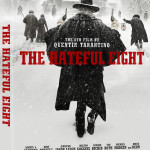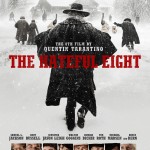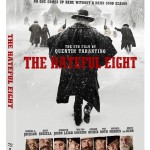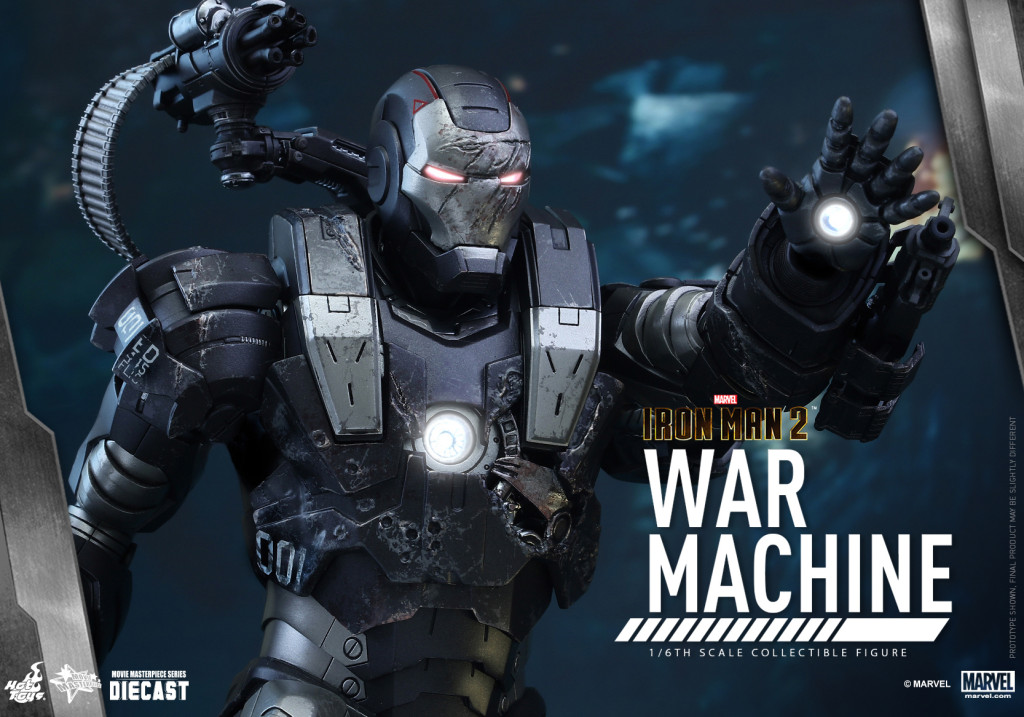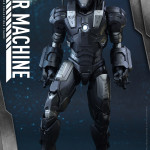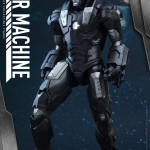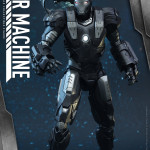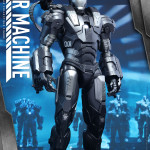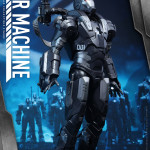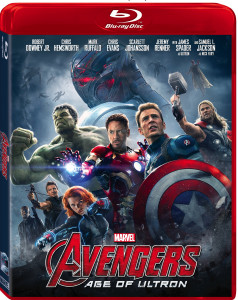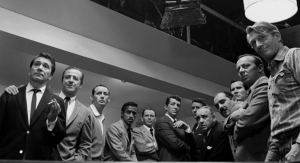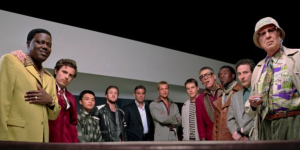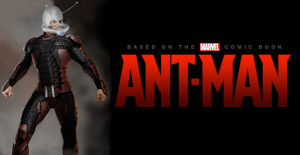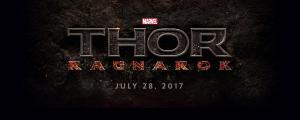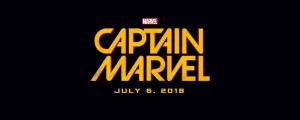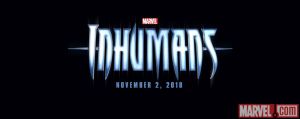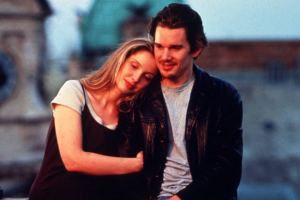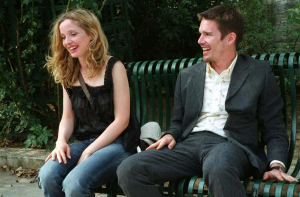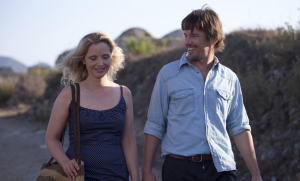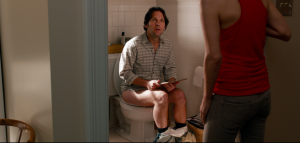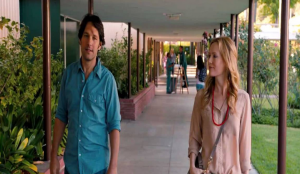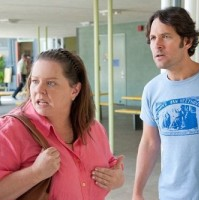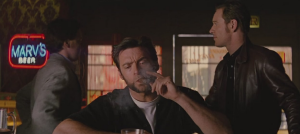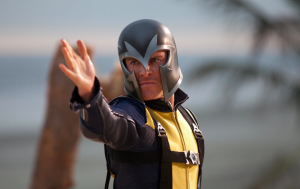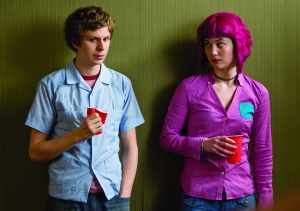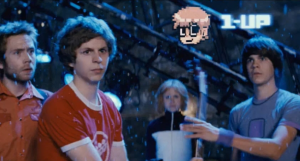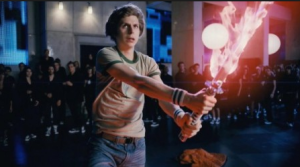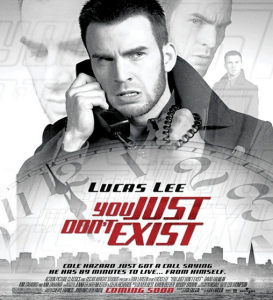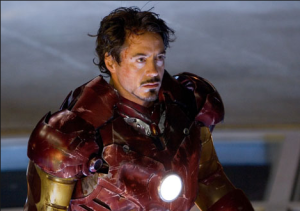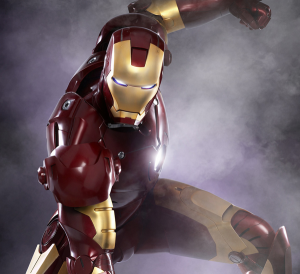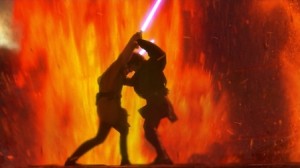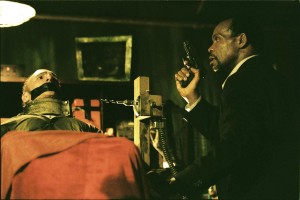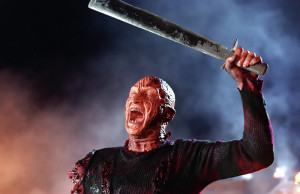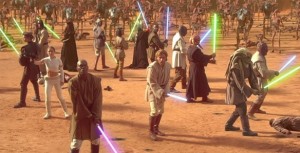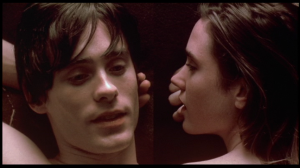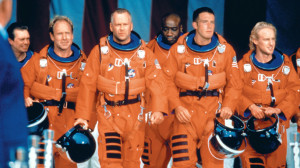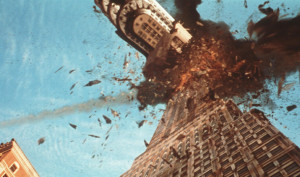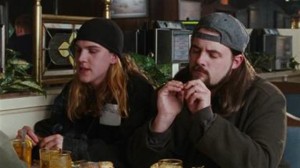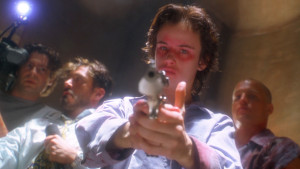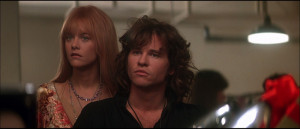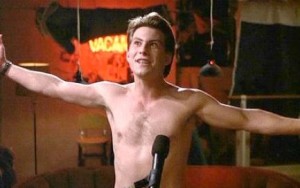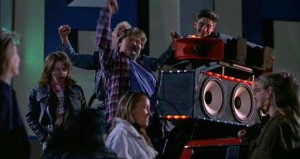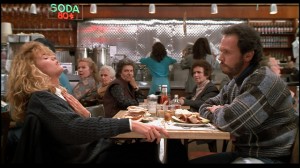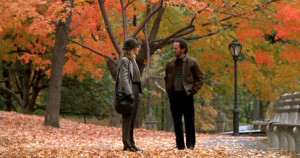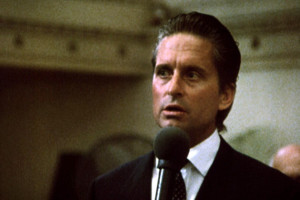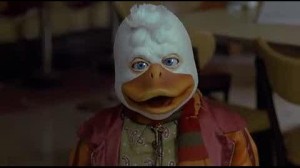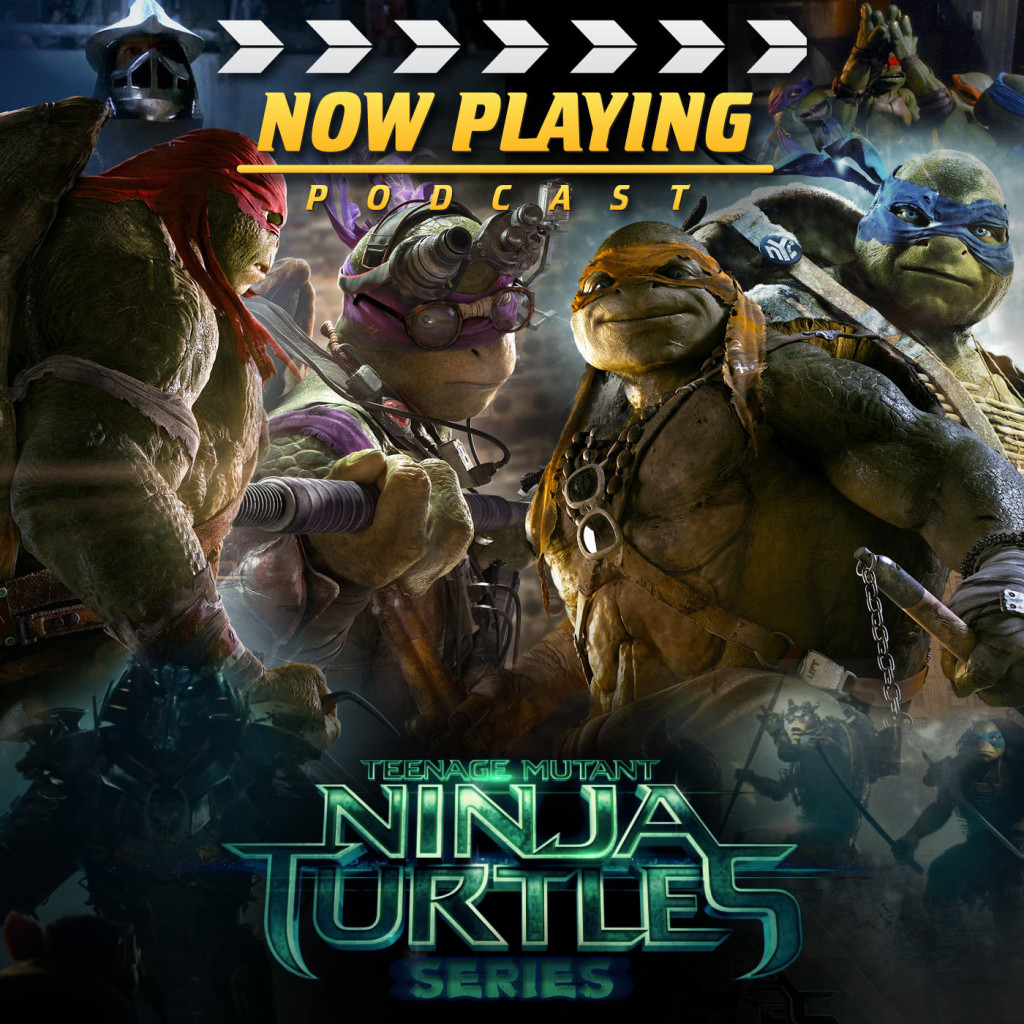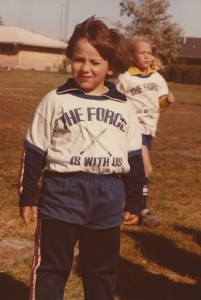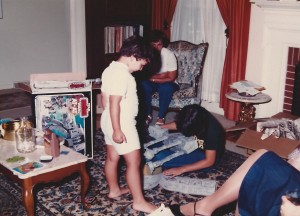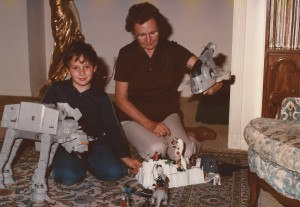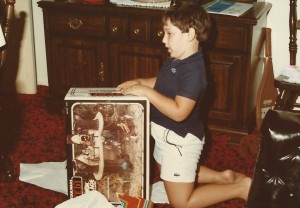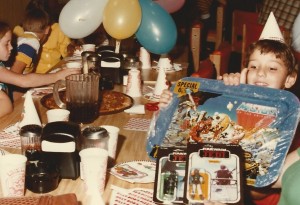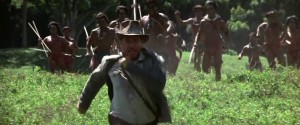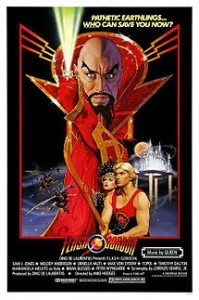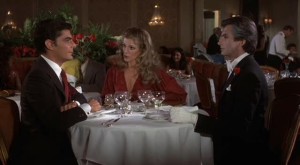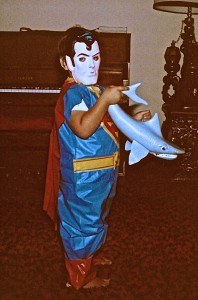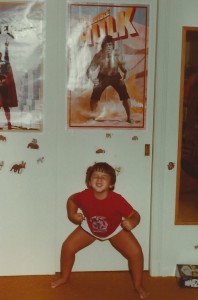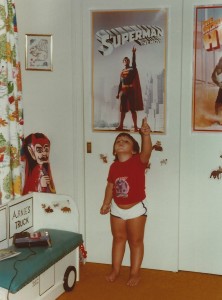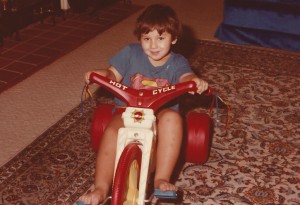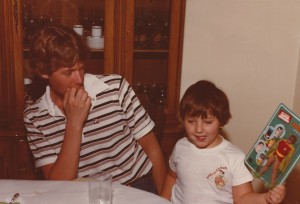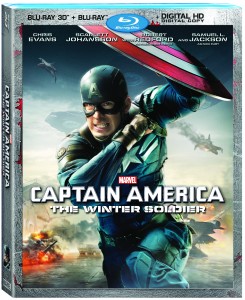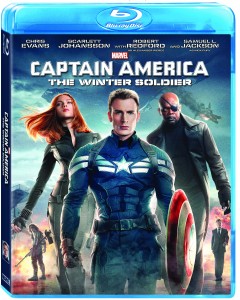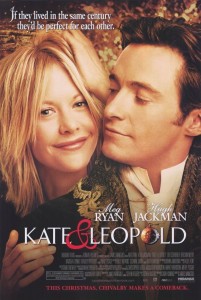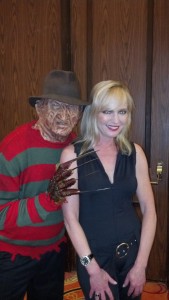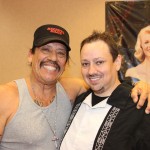Friday the 13th (2009) – Revisited
by Arnie Carvalho

“No matter how much you love the original films in the Friday the 13th series,
it’s virtually indisputable that the 2009 remake/reboot/re-
imagining is far and away the best made of all of them.”
— Adam-Troy Castro, Syfy.com
“Can we now admit ‘Friday the 13th’ 2009 was damn good?”
— Michael White, Bloody-Disgusting.com
“It is one of the best film franchise reboots put out in theaters in the past 15 years.”
— Jason Parker, Friday The 13th Franchise.com
“I’ve always been of the mind (and it’s a hill I’ll die on), that it kinda just
makes no sense to be a fan of the original Friday the 13th movies and yet not
a fan of Friday the 13th ’09”
— John Squires, Editor in Chief of Bloody Disgusting.com, on Twitter
“Stay away from this movie. It really is one of the bad ones…
Run from this movie. Do not reward the makers with your money”
— Arnie, Now Playing’s 2009 Podcast review
“In three years no one, absolutely no one, will remember that they saw it, that
they liked it, it will have no aftertaste whatsoever. People will remember
the original, they will not remember this movie.”
— Stuart, Now Playing’s 2009 Podcast review
Still Now Playing 10 Years Later…
Today is a momentous day in my life. It’s a birthday of sorts.
While Now Playing Podcast started in 2007 it (like many shows, TV, radio, podcast, and otherwise) went through some growing pains. Cast changes, an irregular release schedule, and format changes all marred the first two years.
That began to change on January 9, 2009 — the date we released the first episode in our first retrospective series: a review of 1980’s Friday the 13th leading up to the 2009 reboot. The show went from two hosts to three (that would begin rotating later that same year). The “Recommend/Not Recommend” finale was solidified, as were patterns of series-specific opening credits, art, and titles for each film series.
Yet it’s arguably today, Friday, February 13th, that could be seen as Now Playing’s true 10th anniversary. It was the day we recorded our final Friday the 13th review. By that point we knew the retrospective was a big hit. Despite initial misgivings, we decided to immediately continue the format and review Star Trek leading up to its reboot. Stuart even went out and bought a microphone and literally stopped “phoning it in.”
I’ll never forget the night of Friday, February 13th, 2009. I was in New York City covering Toy Fair International. I went to see the Friday the 13th reboot in a Times Square movie theater, accompanied by my wife Marjorie. The excitement that caused me to begin the retrospective series was reaching its peak as the lights went down and the movie started.
Flash forward to five hours later. I’m in our hotel room (small, as most all NYC rooms are). I’m pacing. My iPhone 3G is hot against my face from being on a call for so long. I’m on a telephone recording my disappointment with the 2009 Friday the 13th reboot. Brock is in Chicago recording the call, and he would edit the show released to our listeners the following Monday.
All three of us had very similar reactions, and the reboot became the fourth Friday the 13th, out of 12, to get three red arrows on our website.
I honestly never looked back.
“Distance not only gives nostalgia, but perspective, and maybe objectivity” — Robert Morgan
As the 10th anniversary of the Friday the 13th reboot approached I came upon an interesting and unexpected turn of events: a number of think pieces were published celebrating the film. Even those who had reacted poorly to the movie initially had come around and not only enjoyed but celebrated director Marcus Nispel’s fresh take on iconic slasher Jason Voorhees (played by Derek Mears).
I started to question my own memory. Could they be right? Could that movie have aged well?
Having been a movie critic for over a decade I know from experience one of the hardest things to do when reviewing a film is to separate expectations from the final product. Movies are marketed to create expectations–to get you into a theater seat and spending money expecting delivery on what trailers, interviews, and even posters have sold.
Going into Friday the 13th in 2009 my expectations were sky high. I had loved Nispel’s Texas Chainsaw Massacre remake far more than the original Tobe Hooper film. I loved Jason as a killer. Jason’s last appearance on screen in 2003’s Freddy vs Jason was one of his best, and that movie’s writing team of Damian Shannon and Mark Swift were writers for the remake.
Could the movie have been good, or at least recommendable, but simply not met my expectations?
10 years have passed, so I decided to find out. For this re-review of 2009’s Friday the 13th I watched the extended “Killer Cut” released on Blu-Ray and Video on Demand. This cut was nine minutes longer than what I saw in theaters.
The Review
I watched the movie having not listened to our 2009 podcast since it was released. I remembered very little going in, only that Stuart thought Jason was a pothead. Then after watching the movie I listened to our old podcast to see what it was that got me so worked up.
SPOILERS BELOW for this 10-year-old movie!
I liked the opening. This is a reboot, and people want Jason as the killer, not old lady Pamela Voorhees. Yet Pamela’s plight from Sean S. Cunningham’s 1980 original Friday is integral to the Jason mythos. To have the climax of the original movie done in montage fashion pays homage and checks the boxes. It does create a confusing timeline as to Jason’s supposed drowning, but handled well.
Then we have the second prologue and, not having seen the movie in a decade, I was faked out. I thought this would be the movie and these five characters, Wade (Jonathan Sadowski), Richie (Ben Feldman), Mike (Nick Mennell), Whitney (Amanda Righetti), and Amanda (America Olivo), were going to be our core cast. They actually seem like a fun group and call back to so many earlier Friday the 13th casts where there’s couples hooking up…and the lonely odd man out. That Jason comes in and killed so many so quickly was a shock.
Then comes our new Jason by Derek Mears. One of my big problems in 2009 goes back to expectation: I was used to the Jason played by Kane Hodder. Jason had gone through many iterations, from bag-wearing woodsman to space-zombie, but the walking after people who run, the nearly supernatural way of catching the prey, seemed like a staple.
This Jason was fast and aggressive. He killed brutally. And he used tools and more thought power than earlier Jasons. Hanging one woman over the campfire to burn while setting a bear trap for another victim really wasn’t in Jason’s modus operandi. But then I had to remember, this is a reboot, not a remake. The Friday the 13th series had lost its luster by doing the same things again and again. In 2009 I couldn’t reconcile this Jason with the ones before. Now I realize this reboot gives us an entirely new Jason.
If I just accept this is a new character, perhaps call him “Jimmy Voorhees”, I’d have no trouble with these new killings. Nispel wanted to revitalize the character and return him to his violent, horror roots. Nearly 30 years had passed since Jason first wielded his machete. It may not be the Jason I wanted, but this viewing I can accept this “Jimmy Voorhees.”
The two characters coming upon Jason’s cabin (plus the bag over Jason’s head) took me back to 1981’s Friday the 13th Part II, and I can go with it.
Not only did the prologue surprise me in killing (seemingly) everyone so fast, I also understand the need to have a body count. One of the pressures with each new horror movie installment was to have more kills. Here, we establish Jason as a badass killer, and we got five good kills. And for those who expect topless women in your Friday films, you got that out of the way too.
Plus, the gore! I was watching the unrated cut, but I marveled at how freely the blood flowed.
Then we actually get to the movie. Again, my expectation was, since we had Shannon and Swift writing again, that we would have a group of fun, believable characters like they gave us in Freddy vs. Jason. Instead, we have a group of character types that would never be friends. I had a real problem with that in theaters.
Yet, when watching it at home on a television, I found myself more forgiving. How many groups of totally different people went camping together in the past? Sure, Parts 1 and 2 made them counsellors thrown together, and 8 had them as classmates, but the victims in parts 3 and 4, and especially 7, don’t feel like they’d hang out together either. So, is this bad writing…or is this an intentional homage to the bad writing in previous installments? More, if I can accept these weird groups in earlier films, why not here too? So, I compartmentalized that complaint and, instead, found these seven young adults appealing, flawed characters, most of whom were obviously going to end up impaled on a machete.
Trent (Travis Van Winkle) is a great douche you love to hate (and with a rich boy name like Travis Van Winkle I wonder how much he was acting). Bree (Julianna Guill) is a wonderful seductress, and the attraction Chewie (Aaron Yoo) shows for Bree takes me back to Crispin Glover’s character in The Final Chapter.
Lawrence (Arien Escarpeta) is a stoner that feels like he would hang out with Chewie. The other couple of Chelsea (Willa Ford) and Nolan (Ryan Hansen) aren’t in the film long enough for me to get a bead on them.
Which does raise one flaw–this group is too big to keep track of. They’re here for a body count, but I’m not sure they are disparate enough where I can even assign them tropes of “the smart one” and “the shy one”, etc. Especially Chelsea and Nolan, they are the flattest of characters.
Then we have typical last-girl Jenna (Danielle Panabaker). Like so many Jason survivors in films past, she’s a brunette, she’s smart, she doesn’t smoke weed, and she doesn’t get naked. And when she encounters, and partners with, Clay Miller (Jared Padalecki) who is searching for his missing sister Whitney, I’m taken back (in a positive way) to the similar plot in The Final Chapter.
The kills also are varied. I had a problem with Jason using an arrow to kill Nolan, but he used a crossbow in Part II so this wasn’t so far off. And again, this is the new “Jimmy Voorhees.” He’s a survivalist. He has to hunt to survive. It makes sense he’d be good with a bow. (It equally makes sense that this Jason is far more intelligent than the previous incarnations and so he uses Kerosene to power his home). And Chelsea’s machete-in-the-head gave Jason his usual, nearly supernatural sense of where his victims hide.
So halfway in the movie I wonder…was I too harsh on Friday the 13th? Did I allow my expectation to cloud what was delivered?
The answer is….partially, for the movie really does fall apart in the second half.
Nispel was best known (and may still be best known) for his Texas Chainsaw reboot. I don’t know if Nispel rewrote any of Shannon and Swift’s script, but the second half does turn this new Jason into a wannabe Leatherface. Why are there catacombs underneath Camp Crystal Lake? It makes no sense. Why did Jason kidnap Whitney? It makes no sense. Why does Whitney look so good after six weeks of captivity? It makes no sense.
Yet the deaths continue to impress. In this “Killer Cut” Chewie’s slow death in the tool shed was painful to watch as he writhes, groans, and bleeds for a very long time. Lawrence’s kill by Jason throwing an ax goes back to the survivalist skills, and creates a more “realistic” Jason who can’t just walk after every person who runs.
The best death/fake-out may belong to Trent, though. Waving down a tow truck, a silent hand waves Trent to get on. Can this Jason drive a car? No…it’s an old man on oxygen, unable to shout to the young man whose hesitation results in his being impaled on the truck as it drives away.
Yet another decent fake-out is Jenna. She seemed like the perfect “last girl” and, echoing The Final Chapter‘s Trish, I thought it was a given she’d escape. But two brunettes is one to many in a Friday the 13th film so when Whitney is discovered alive Jenna had to die.
The rest is pretty rote action with Jason just dead enough for a climax, yet, of course, always ready to come back for another sequel.
The Verdict
So, was I too harsh on the 2009 Friday the 13th? Yes, I clearly was. My expectation of what the previous Fridays had given clouded my ability to appreciate the changes Nispel tried to bring to make a Jason that could be scary in the 21st century.
Yet, the writing becomes very lazy in the second half. The film is almost a straight downward line, its quality decreasing with every passing frame of film, start to end. At no point does the body of the film reach the highs of its two prologues.
While this is a totally new Jason, much of the film, including the group of victims, is a throwback to the installments released 1980-1984. I wasn’t a fan of many of those early groups, so this is not a success, but it’s not worthy of the damnation I gave on the podcast.
So is it a recommend or not recommend?
It is on the borderline. I think that slasher fans will have a lot to enjoy, while old school Friday the 13th fans will have a lot to swallow.
The ridiculous ending, including everything after the rescue of Whitney (the tunnels under the camp, the convenient machinery, the obvious final “jump scare”), make me stand by my red arrow. But it’s a close call, and it’s what I’d call on the podcast “A very weak not recommend”…which is the most positive thing said about this movie in the entire history of Now Playing Podcast. |  |
(the tunnels under the camp, the convenient machinery, the obvious final “jump scare”), make me stand by my red arrow. But it’s a close call, and it’s what I’d call on the podcast “A very weak not recommend”…which is the most positive thing said about this movie in the entire history of Now Playing Podcast.
Yet the film has had a longer lifespan than I had imagined ten years ago today and, had it not been for endless legal wrangling over Friday the 13th’s IP rights, I have no doubt “Jimmy Voorhees” would have returned to slay again.
Yet while lawsuits continue over who has the right to make the next Friday film, I look forward to it. Ten years is the longest Jason has ever gone without a movie since his inception in 1980. He is missed, and hopefully Jason Voorhees, not “Jimmy”, will return to the silver screen again in the near future.
Agree? Disagree? Let us know in the comments below!
Hear Now Playing Podcast’s original retrospective series, 12 reviews of Friday the 13th films (plus a bonus recap episode), all available now at NowPlayingPodcast.com
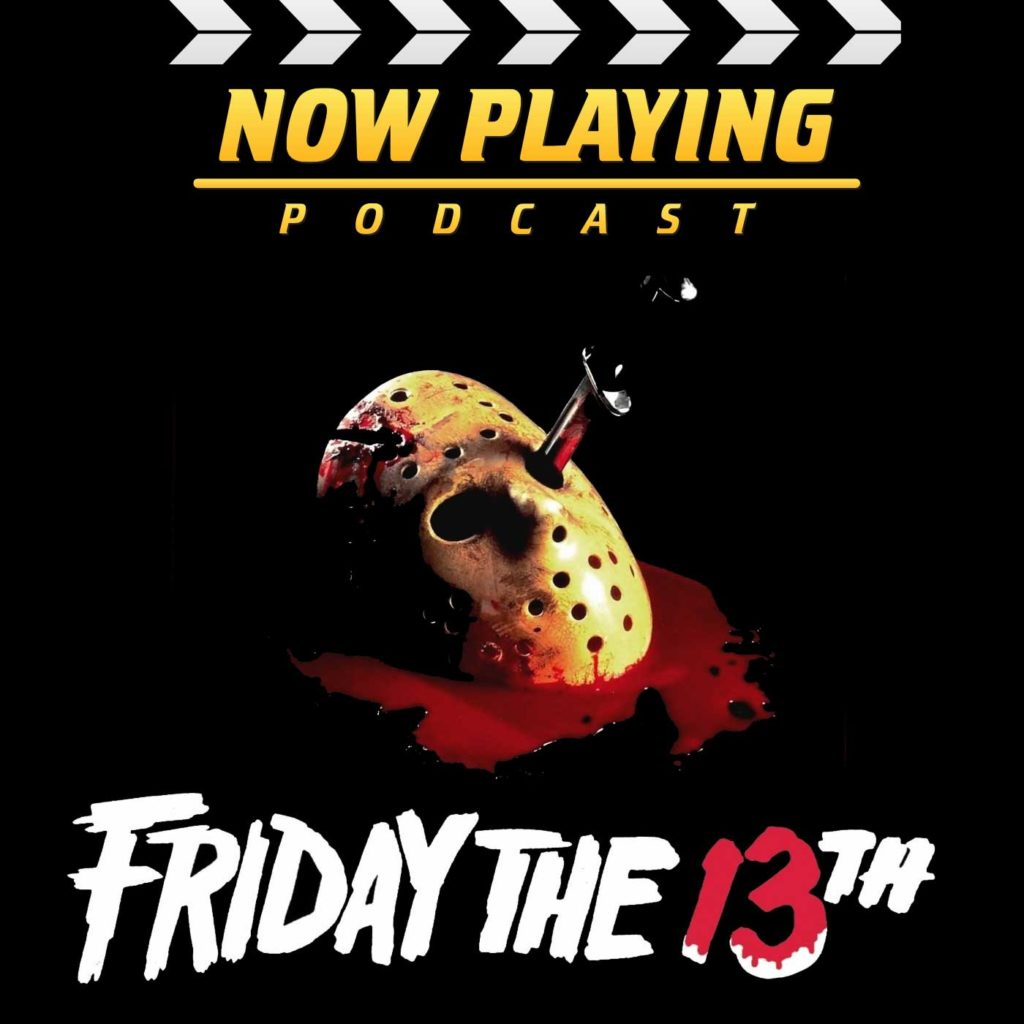
February 13, 2019 Posted by Arnie C | Movies, News, Now Playing Podcast, Podcasts | 2009, Friday the 13th, jason voorhees, Marcus Nispel, Movie, Movies, Now Playing, Now Playing Podcast, Podcast, Podcasting, Podcasts, Reboot, Remake, Review | 3 Comments
Toy Fair 2018 Roundup — Marvel & Movies Come to Life with Mezco
The clear winner of Best in Show for Toy Fair 2018 is Mezco. Their One:12 series of Marvel figures is entering its third year, and Mezco unveiled some truly awesome and surprising upcoming releases!
On display at the Javitz center were some figures we’d seen before at San Diego Comic-Con, such as the Gladiator Hulk and Thor from Thor: Ragnarok, and the Spider-Man in his homemade suite from Homecoming. New additions to the line however include Black Panther with his movie-style outfit. The silver accents and the detail in the black outfit really make this six-inch figure stand out!
Also new in the Marvel Cinematic Universe was revealed Hela–Mezco’s first female Marvel One:12 figure! She comes with her large headdress and a Cate Blanchett likeness that is downright perfect. My only hope for this figure would be an alternate head (or variant released) without the helmet.
Similarly, in the Marvel Television Universe, three figures were shown. Daredevil is coming in both his Season One black outfit and his season two red. And also from Daredevil Season Two (and his own series) comes The Punisher. He is wearing an armored chestplate, and has an amazing beat-up Jon Bernthal likeness.
For comic-based Marvel fans, though, there was some real excitement! Revealed at the show were two new mutant figures, Cyclops and his son from the future, Cable! Cyclops is in his classic yellow-and-blue outfit, and the soft goods fit the figure perfectly. The shade of blue is spot-on with the ’90s version of the character.
Cable is on a much larger buck than usual, and has more solid plastic than soft goods from what I could see. The robotic arm has incredible sculpting detail, and he is a good size to stand among your other One:12 figures without dwarfing them!
Finally, for horror movie fans of Now Playing Podcast some of Mezco’s horror line of One:12 figures were revealed. They continued their look into the many iterations of Jason (leaving me hoping for a Jason X in the near future!), plus Michael Myers and Ash from Evil Dead 2. I did ask if a Pinhead might be joining this One:12 series soon. Mezco has the Hellraiser rights (as shown with their large figure and fuzzy-dice puzzle boxes). Drake could not confirm Pinhead being slated for the line, but he gave me hope stating, “I’m not saying no…”
Two surprising reveals included John Wick–with an uncanny Keanu Reeves likeness. With the third film, and a TV series, in production there seem to be several companies looking to light the fuse on this new action star.
Plus–in the single most incredible valut-pull I saw at Toy Fair, they are making a One:12 figure of Diabolik from the 1968 film Danger: Diabolik! This is a movie championed in Now Playing’s book Underrated Movies we Recommend and to see the John Phillip Law character realized in six inches was nothing short of astonishing.
Check out our video and photo coverage of Mezco below, and be sure to follow Marvelicious Toys for updates and reviews as these products start to ship!
March 1, 2018 Posted by Arnie C | Comic Books, Conventions, Marvelicious Toys, Movies, Movies & Television, News, Now Playing Podcast, Podcasts | Marvel Cinematic Universe, Marvelicious Toys, Mezco, Now Playing, One:12 | Comments Off on Toy Fair 2018 Roundup — Marvel & Movies Come to Life with Mezco
Hellraiser – Pinhead’s JUDGMENT – A Video Interview With Paul T. Taylor
Hosted by Arnie Carvalho
In the tenth HELLRAISER film a new actor gets nailed with the starring role — Paul T. Taylor. In this video Taylor discusses his acting past, how he got the role, how the production went, and his hopes on how the new HELLRAISER: JUDGMENT is judged by fans!
Join Arnie and Paul now in this spoiler-free behind-the-scenes look at this upcoming Hellraiser film!
January 18, 2018 Posted by Arnie C | Movies, Movies & Television, News, Now Playing Podcast, Podcasts | Clive Barker, Direct-To-Video, Entertainment, Film, Hellraiser, Hellraiser Judgment, horror, Movies, News, Now Playing, Now Playing Podcast, Paul T Taylor, Podcasts | Comments Off on Hellraiser – Pinhead’s JUDGMENT – A Video Interview With Paul T. Taylor
IMAX, 4k, Ring the Death Knell for 3D
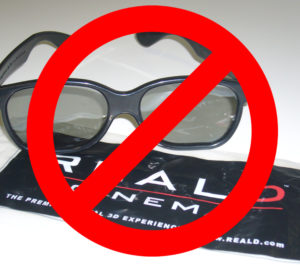 by Arnie Carvalho
by Arnie Carvalho
Did James Cameron wait too long for his Avatar sequels? It seems that by the time Avatar 2 is released (optimistically scheduled for 2020) the 3D format utilized by that 2009 original may be a thing of the past.
IMAX Announces 2D “Preference”
IMAX CEO Richard Gelfond announced this week that the company will be reducing the number of 3D screenings on their high-priced, large format projectors and screens. He cited a “clear preference” from North American audiences for 2D films.
This statement of direction does not signal an abrupt shift. IMAX’s most recent release, Christopher Nolan’s Dunkirk, was filmed and released only in 2D. (Nolan has a history of disliking the 3D format, refusing Warner Bros’ requrest for his Dark Knight films to be released in the format which commands a higher ticket price.) Before that, the 3D post-converted Spider-Man: Homecoming was shown on IMAX screens in a combination of 2D and 3D presentation. This is a change from even a year ago when most IMAX viewings required the audience to don a pair of special, plastic glasses.
This follows a recent history of movie-goers intentionally choosing 2D presentation and falling 3D ticket sales.
Home Video Flattens Out
It’s not only in theaters that 3D is dying. Movie viewers also have shown a preference for the 2D picture in their homes. In 2010, riding off Avatar’s success, High Definition Blu-Ray discs started shipping in 3D formats (the first of which was Cloudy with a Chance of Meatballs). 3D features were included on all high-end 1080p televisions and home projectors.
However, with the recent advances in 4k resolution, 3D has become a feature of the past. Over the past few years television manufacturers like Sony and LG have phased out 3D capabilities on most of their 4k televisions. With their 2016 models LG only offered 3D on their curved television sets; in 2017 3D was removed altogether. Likewise 4k home projectors are removing support for 3D, with only Sony offering true 4k projectors that are backwards-compatible with the 3D Blu-Ray format.
Indeed, there is no established standard for 4k home video content to be displayed in 3D; currently movie buyers must choose between the higher resolution or the greater depth in their films.
Is this a win for consumers?
These changes follow the standard market practice of meeting consumer demand.
The 3D format has long been rife with viewer complaints. In addition to being forced to wear glasses to watch 3D content, be it in theaters or at home, many viewers could not appreciate the added dimension. Per vision insurance company VSP, 5% of the population cannot percieve 3D, and another 25% have trouble perceiving 3D images. Another 25% or more have complained of headaches, eye strain, and eye fatigue from current 3D digital projection.
These complaints have gotten many people to buy special “2D Glasses” which allow them to see (non IMAX) 3D films in 2D format. (Now Playing Podcast host Marjorie can vouch for these glasses’ effectiveness.)
Many theater-goers also complained about the unreliable quality of 3D in films, much due to the post-conversion process many studios use to save money. The vast majority of 3D films were post-converted–in 2017 only Transformers: The Last Knight was shot natively in the 3D format. On Now Playing Podcast we have complained about lackluster 3D in Spider-Man: Homecoming, War for the Planet of the Apes, Pirates of the Caribbean: Dead Men Tell No Tales, and other movies.
Hollywood studios fought this trend. Many studios intentionally limited 2D availability of films, including 2012’s Prometheus, in order to reap higher profits from the inflated ticket prices.
Will this hurt studios?
Yet despite these consumer complaints, studios have continued to push the 3D format, which commands higher ticket prices. As movie budgets continue to expand, the higher priced 3D tickets, IMAX tickets, and other “premium” theater experiences have bolstered studio bottom lines. More, the 3D Blu-Rays sell for $30 or more, while their 2D counterparts are often half that. (Of note, the higher-resolution 4k Blu-Ray discs are often priced equal to, or higher than, their 3D counterparts.)
While the 3D Post Conversion can add $10 million or more to a film’s cost, the increased revenue often offsets that. Many older films, including Jurassic Park and Top Gun were post-converted and re-released to theaters to grab their studios a quick buck.
Yet this switch back to 2D may not bring cheaper ticket prices. AMC Theaters charges the same for 2D and 3D IMAX screenings. It’s possible theaters may raise all ticket prices to current 3D prices to help offset these losses. Also, studios and theater chains have discussed having “event movie” pricing, where tickets cost more for big-budget blockbusters with or without “premium” gimmicks like 3D.
No change for animation?
The movie format that has generated the greatest 3D success is kids’ fare and computer-animated movies, such as LEGO Batman and Moana. As these films are entirely computer-generated the 3D is more ingrained in their development. The effects are better, and the audience for those films are primarily younger and not yet burnt-out by the format. While Gelfond made no specific mention of animated films staying in 3D, it is likely these will remain in that format for years to come.
Modern 3D History
The modern 3D era was brought in by Cameron in two waves. In 2003 the first modern, digital 3D film was his IMAX documentary Ghosts of the Abyss. The format had a slow growth over the next six years, mostly as a gimmick in kids films including Spy Kids and The Polar Express.
The change to 3D was a clumsy one. Superman Returns and Harry Potter and the Order of the Phoenix both had select scenes converted to IMAX 3D–requiring customers to don and remove
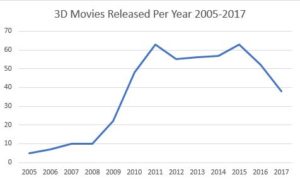
Source: https://en.wikipedia.org/wiki/List_of_3D_films_(2005_onwards)
glasses through the films.
Modern 3D came into its own in 2009. By that time the 3D cameras required had come down in price. Horror films (which had heavily relied on 3D in the ’80s) got into the game with My Bloody Valentine 3D and The Final Destination. Animated films premiered in the format, including Coraline, Monsters vs. Aliens, Ice Age: Dawn of the Dinosaurs and Cloudy with a Chance of Meatballs.
But Cameron ushered in a new age with the 3D film Avatar. Somewhat bolstered by 3D and IMAX ticket prices, Avatar became the top-grossing film of all-time. This created a 3D “gold rush” among studios, exponentially increasing the quantity of 3D films produced.
This growth continued until 2011, when 63 3D movies were released. Growth then leveled off through 2015, when the number of films started to decline.
With these changes to home video and IMAX formats, it is likely 3D films may return to their pre-Avatar numbers.
What do we lose, besides depth?
I’m no great fan of 3D. However, as a movie-goer who prefers to see the movie as the director intended, I’m slightly upset by the loss of the 3D home format. Every movie I’ve purchased since 2010 has been in 3D, if available. I was especially happy with the Transformers films which not only were released in 3D but also changed to the IMAX aspect ratio for their home video releases.
I remember growing up watching movies like Friday the 13th Part III, Jaws 3-D, Emmanuelle 4, and Freddy’s Dead: The Final Nightmare on video. All three films had 3D components in theaters which translated poorly to television. The moments of “I can tell that should be 3D” worsened each viewing experience.
I recently purchased my first 4k TV and had to go through great pains to find one that would continue to support my 3D Blu-Ray discs. It seems in the next five years any movie with great 3D, such as Avatar, Tron: Legacy, and X-Men: Apocalypse will only be seen in their flattened versions.
Even movies filmed in 2D, such as Star Wars: The Force Awakens and Guardians of the Galaxy Vol. 2 had effects sequences specifically designed in 3D to showcase the technology.
Home movie viewers will lose the ability to view many movies from the past decade as they were intended to be seen.
Final Thought
But overall, I believe 3D is a gimmick that more than ran its course. I applaud IMAX for choosing consumers over studios, and I hope that filmmakers now focus on plot and character depth, instead of manufactured depth on the screen.
What do you think? Sound off in the comments!
July 28, 2017 Posted by Arnie C | Movies, News | 3D, 4k, Enertainment, Film, IMAX, Marvel, Marvel Cinematic Universe, Marvel Comics, Movie, Movies, News, Now Playing, Now Playing Podcast, sci-fi, Spider-Man, Star Wars, X-Men | 5 Comments
PEELERS Review: This Zombie/Stripper Film Isn’t APEEL-ing, it’s Appalling.
Review copy provided courtesy of October Coast Publicity
I like zombies. I like strippers. So it seems zombie-strippers would be (pardon the pun) a no-brainer. But 2008’s Jenna Jameson/Robert Englund film Zombie Strippers fell in its high heels. 2012’s Zombies Vs Strippers failed to get a rise out of me. And defying my expectations, Sevé Schelenz’s new film Peelers is even worse than those two previous efforts.
Peelers’ concept is simple enough. When four coal miners accidentally strike oil they head to the Titty Balls Strip Club to celebrate. And it’s the club’s last night as owner “Blue” Jean Douglas, played by Wren Walker, has sold the club to a land developer who plans to shut it down. Soon their night of revelry turns into revulsion as the black ooze infected the miners turning them into bloodthirsty, mindless killers. No one in the club is safe, and the infection is spreading.
This set-up seems like a perfect throwback to ‘80s slasher films. I had low expectations for Peelers, but if it could give me base genre thrills along the lines of Prom Night 3 (yeah, part 3, not even part 1) or Friday the 13th Part VIII: Jason Takes Manhattan I would have given this film a solid recommend.
Sure enough, the film’s set-up seems to indicate that’s what I’ll get as we’re introduced to owner “Blue Jean”, her bad-boy brother Logan (Madison J. Loos), and the various strippers, bouncers, bartenders, and cooks that populate the Titty Balls. Instantly we see a large cast we know will lead to a decent body count. And it doesn’t take long before the miners arrive, and one begins regurgitating and transforming into a zombie.
And I was jazzed by some comic book cred. One character is named Logan, and another is Remy. I could chalk that up to a coincidence, but when the bartender drops a line about adamantium it’s obvious writer Lisa DeVita is an X-Men fan.
From there all the film had to do was coast on “cruise control” and give me some inventive kills along the way. Unfortunately first-time screenwriter DeVita can’t even accomplish that.
The set-ups in this film are so obvious I thought DeVita was trying to be funny. In the first fifteen minutes of the film we are introduced to what I can only call Chekhov’s arsenal: the strip club has a baseball bat, several handguns, and even, improbably enough, a chainsaw. Clearly every awkwardly-shown item will (and does) lead to later zombie defense.
But soon I realize the script wasn’t being ironic, it’s just poor. The plotting is confusing in several ways. For example, the miners believe they found oil, but it smells awful and converts them to zombies. Yet later we’re told it is still actual oil that can fuel your vehicle…and turn you into the living dead?
Beyond ridiculous, the script is downright ignorant. (Minor spoiler) The kryptonite for these oil monsters isn’t a gunshot to the head, it’s….water? The rationale is “Water and oil don’t mix” so, obviously, water will kill these bloodthirsty beasts?
Unlikely as it seems, the stupidity only escalates from there! The survivors in the club could just run away, but “Blue Jean” marshals them to stay and fight, lest these monsters go to the general population. Yet no one realizes that if they just wait out one good rainstorm then the problem will take care of itself.
Additionally, this group has every weapon known to god and man, but not one person has a cell phone?
If I gave the film the benefit of the doubt I’d say this was all intentional humor, but the leaden dialogue delivered by a cast of complete unknowns makes it all seem deadly serious. And deathly boring.
Yet I found myself slightly impressed with the production. Post-viewing research told me Peelers was a Kickstarter-funded film made for about $20,000. For that small sum Peelers achieved quality sound work, and decent camerawork. I looked up cinematographer Lindsay George and he has over a decade’s work on shorts and television. The result is a professional looking production that seems to make spectacular work of existing lights, and good effect of digital video cameras that work well in low-light conditions.
Some of the gore effects are also passable for cheapie-horror.
But if I’m complimenting a movie for saying it’s well lit, I’m stretching to find compliments. George is a good cameraman but he had nothing good in front of the camera to film. And several times he’s let down by poor staging and editing that makes action scenes downright confusing.
If you’re only requirement for this film is gratuitous nudity, yes, you’ll find it here, but every single bit of it is undercut by the most repugnant of “humor.” One stripper does her dance, only to end by giving guys in the front row a golden shower. Another stripper is late into her third trimester. I’ve been to a couple dive clubs in my life, but this is simply grotesque.
And yes, one zombie is indeed killed when the pregnant stripper’s water breaks on his head. If you think that sounds cool, you’ll still be bored as hell by Peelers.
It takes a lot to revolt me. The strippers here pulled it off. So…congratulations? But it wasn’t even in the fun Human Centipede way. More in the vein of “no one should have to watch this.”
Finally, the title Peelers was misleading. From the poster, showing an amputated stripper, and the title I thought I’d be watching a film about creatures that peel the skin off their victims. It would be the ultimate strip-club irony–a monster that continues to “undress” their nude victims. But these beasts just bite and gouge. The title, I suppose, references the strippers, but I’ve never heard a dancer called a “peeler” before. I suppose it’s a shame the title Striptese, Zombies vs Strippers, Zombie Strippers, Showgirls, and Zombeavers were taken. (FYI, every single movie listed there is more enjoyable than Peelers).
The end result is a film that seems to think it’s a cheapie From Dusk ‘Til Dawn rip-off, and ends up being so much worse than either of Dawn’s direct-to-video sequels. It’s not even fun in a so-bad-it’s-good way. It’s a mind-numbing 90 minutes that I will never get back.
The cover art reads “You may not get the happy ending you were looking for.” I certainly didn’t. Neither will anyone who watches this imbecilic production.
Congratulations to the film crew for accomplishing what they did on so little budget, but next time perhaps give that script a second draft before you start shooting.
July 14, 2017 Posted by Arnie C | Movies, News, Reviews | horror, Movie, Movies, News, Now Playing, Now Playing Podcast, Podcasts, Review, Reviews, Romero, Slasher, Strippers, Zombies | Comments Off on PEELERS Review: This Zombie/Stripper Film Isn’t APEEL-ing, it’s Appalling.
Batman: Assault on Arkham is the Original Suicide Squad!
NOTE: Now Playing Podcast and La La Land Records are giving away 5 copies of The Killing Joke limited CD Soundtrack. Follow @nowplayingpod on Twitter and retweet their pinned tweet to enter!
Starting today, DC movies are committing Suicide. Sure, everyone knows Batman, Superman, and Wonder Woman – the featured characters in last Spring’s Batman v Superman: Dawn of Justice. But Killer Croc? Deadshot? Captain Boomerang? These are some lesser known characters–and the stars of the new movie Suicide Squad. With an August release date and a story of criminals out to do good, it’s obvious DC is hoping to capture some of Marvel’s Guardians of the Galaxy magic (and dollars). Outside of comic book die-hards these characters aren’t household names, but with this film DC hopes they will be. So to prepare for this live action film, I watched another movie version of this tale: DC’s 2014 animated direct-to-video Batman: Assault on Arkham.
Like the live-action film, this cartoon tells of a “Suicide Squad” formed to infiltrate Arkham Asylum — Gotham City’s infamous sanitarium for the criminally insane. Government official Amanda Waller calls together a team of seven criminals to covertly infiltrate the prison. Batman foe The Riddler is imprisoned there, and he has a thumb drive that could expose Waller’s above-the-law operations. The group she assembles consists of five lesser-known DC baddies: Captain Boomerang, King Shark, Killer Frost, Black Spider, and the hilariously named KGBeast. For a little star power, the headliners are two more popular Batman enemies: Harley Quinn and Deadshot. For full disclosure, I certainly hadn’t heard of most of the characters in this film. When it comes to DC comics, if a character wasn’t featured in a live-action film or the ‘60s Batman TV show, odds are I don’t know them. I have seen a handful of episodes of Batman: The Animated Series though, and I find great enjoyment in several of DC’s direct-to-video animated films.
I suspect those excited by seeing Captain Boomerang and KGBeast in action are already DC Comics readers and fans. Those die-hards would excitedly pre-order a Suicide Squad animated film, because they know what that means. Instead, for marketing, this movie is called Batman: Assault on Arkham but the Dark Knight is very much a supporting player in this tale. This movie should have been called Suicide Squad, but wasn’t, I suspect, for two reasons. First, invoking Arkham in the title shows this movie is set in the universe of the immensely successful Batman: Arkham video games. In fact, the movie is a sequel to Arkham: Origins and takes place about two years before the original Arkham Asylum game. Second, giving Batman top billing appeals to more casual fans like me. Without a heavy marketing campaign like the live-action film has, I would likely skip an animated movie called Suicide Squad. Call it Batman and you have my interest. If you don’t know these characters as I didn’t, it won’t be a barrier to your enjoyment. These enslaved villains are introduced quickly with ‘70s style title cards announcing their names. Before you know it, this motley crew is rounded up and told of their mission. If they don’t comply, Waller will detonate explosives planted in their necks.
Why are these specific people chosen? Why use criminals instead of more traditional assassins? The film glosses over the answers so we can get to the action! |
| Once the titular Assault begins, the fun never ends. The plot is full of so many twists and turns I am hesitant to discuss them lest I rob you of the fun of discovery. Suffice it to say the team’s objectives change every ten to fifteen minutes, and when Quinn’s former beau The Joker shows up, it all goes sideways.
The animation is rudimentary, and I sometimes had trouble distinguishing between Deadshot and Black Spider. Even though one is African-American and the other Caucasian, the coloring muted the skin tones. Add to that identical facial hair, somewhat similar hairstyles, and my lack of familiarity with these characters, at times I found myself confused.
Despite that, this hard PG-13 cartoon did the seemingly impossible–the action excited me. This Squad isn’t afraid to kill some cops in brutal ways. In truth, I haven’t seen so many decapitations since David Cronenberg’s original Scanners! Not only are nameless guards and cops taken out, but so are some characters from DC Comics. The team is called a Suicide Squad and, surely enough, some of them don’t survive the mission. This feeling that all the characters are at risk upped the suspense–no one feels safe in this cartoon. If you know these characters, if you are steeped in the Arkham video game universe, I can only imagine your enjoyment is even greater than mine. I did, however, become giddy when Poison Ivy, Bane, Penguin, and other characters I actually knew, made minor appearances.
Beyond violence, there is a PG level sex scene, and some “almost see it” nudity with the femme fatales Quinn and Frost. What the film lacks in visuals, it makes up for in the score. The music is omnipresent and sets a mood that the script and characterizations sometimes fail to do. But I found myself tapping my fingers throughout. The voice acting is also well done. Nearly all the actors, including Kevin Conroy (Batman), C.C.H. Pounder (Waller), and Jennifer Hale (Killer Frost), have played these characters for years. Their familiar performances were welcome. Newcomers Greg Ellis (Captain Boomerang), Neal McDonough (Deadshot) and Giancarlo Esposito (Black Spider) also do very well.
I did, however, truly miss Mark Hamill and Arleen Sorkin, the respective voices of The Joker and Harley Quinn since the ‘90s Batman: The Animated Series and several of the Batman: Arkham games. Both had retired from the role (though Hamill reprised in this year’s Batman: The Killing Joke). Troy Baker and Hynden Walch are fine in the roles, but I felt a lack of menace and chaos from both. While Batman: Assault on Arkham is by no means a perfect movie, its manic action is a blast. The script does an admirable job of introducing the characters and the “Suicide Squad” concept. And, based on the trailers, I strongly suspect today’s live-action Suicide Squad took many beats from this animated version. I give Assault on Arkham a solid Recommend. Now Playing Podcast’s review of Suicide Squad will be released Tuesday, Aug 9th! Buy Batman: Assault on Arkham now on Blu-Ray Buy Batman: The Killing Joke now on Blu-Ray Hear Now Playing Podcast’s entire Batman movie review series. *Note: There are no plans for Now Playing Podcast to do podcast reviews of the direct-to-video DC Animated films. |
August 4, 2016 Posted by Arnie C | Comic Books, Movies, Music, Reviews | Batman, Comic Books, Comics, DC Comics, Enertainment, Film, Harley Quinn, Movie, Movies, Now Playing, Now Playing Podcast, Podcasts, Review, Reviews, Suicide Squad, The Joker | Comments Off on Batman: Assault on Arkham is the Original Suicide Squad!
A New Voice Joins Now Playing Podcast
 Now Playing Podcast is getting a new host; one whose voice will sound familiar to longtime Venganza Media listeners. Justin Kozisek, a host and contributor to Marvelicious Toys and Star Wars Action News, will add Now Playing duties to his plate for some upcoming, unannounced (that means it’s a secret) shows.
Now Playing Podcast is getting a new host; one whose voice will sound familiar to longtime Venganza Media listeners. Justin Kozisek, a host and contributor to Marvelicious Toys and Star Wars Action News, will add Now Playing duties to his plate for some upcoming, unannounced (that means it’s a secret) shows.
Kozisek becomes the seventh member of the rotating panel, and although he’s primarily known for his collecting and customizing knowledge, listeners have heard him offer film critique during movie segments on Marvelicious Toys, a show that he has hosted since its launch in 2010.
A fan of indie comedies, Kozisek ranked Wet Hot American Summer, Kiss Kiss Bang Bang, and Dazed & Confused among his favorites, although he can find reasons to love films of every genre.
“I’m a ‘try anything once’ kind of guy and will give almost any movie a chance,” he said. “I look at movies as entertainment first and art second, then based on what a film is trying to accomplish I adjust my outlook accordingly.”
“I very rarely hate a movie and when I love a movie it’s because it earned it!”
Kozisek is also a professional industrial designer with experience in model making, drafting, special FX and latex make-up design. He has created album artwork for hundreds of bands, PC and Nintendo games. More than a fan of films, Kozisek’s design background has led to him working on several. He was creative director on the documentary There Will Be No Stay, also designing its movie poster. He also was a graphic designer on indie film No Resolution.
“All of this adds up to me being infatuated by the treatment of products in films,” he said. “If an item like Pepsi pops up in a movie today we all know that it was paid for, but I enjoy catching a glimpse of things that were supposed to be obscured in older movies (before the tie-in game was afoot). I love it when someone like Tarantino makes a brand for his movie universe – Apple Cigarettes is a great example.”
Movie making is a family affair for Kozisek. His wife Chevy is a producer and make-up artist with work  ranging from horror films to music videos. She has done both studio and FX make-up. Her effects work can be seen in April Showers, a film about a school shooting directed by Columbine survivor Andrew Robinson. Chevy also produced the 2016 drama No Resolution.
ranging from horror films to music videos. She has done both studio and FX make-up. Her effects work can be seen in April Showers, a film about a school shooting directed by Columbine survivor Andrew Robinson. Chevy also produced the 2016 drama No Resolution.
When asked about his favorite Now Playing Podcast retrospective, Kozisek pointed to the 2010 A Nightmare on Elm Street series, which is well known among fans for including songs from an obscure “Freddy’s Greatest Hits” album (featuring a surprisingly game Robert Englund).
“I think that retrospective really helped solidify what Now Playing is all about,” he said. “I think you’d be hard pressed to find anyone that truly loves all of those movies, but the shows really made revisiting them a lot of fun.”
As do the fans. Kozisek credited Now Playing’s longevity (the show will turn 10 next year) and the popularity of Venganza’s podcasts to its listenership and the community they’ve formed on social media and the show forums. The podcast format, he said, creates a shared experience, much like watching a film you own on television.
“There’s something comforting about knowing you are watching the same movie that other people are watching, and Now Playing creates a ‘couch’ for people to gather and enjoy the experience together.”
Hear Justin’s First Now Playing Review – Short Circuit – at NowPlayingPodcast.com
June 30, 2016 Posted by Arnie C | Movies, News, Podcasts | Enertainment, Film, Marvelicious Toys, Movie, Movies, News, Now Playing, Now Playing Podcast, Podcasts, Press Release, Star Wars Action News | Comments Off on A New Voice Joins Now Playing Podcast
CIVIL WAR: Choose your side – VOD on 9/2 or Blu-Ray on 9/13!
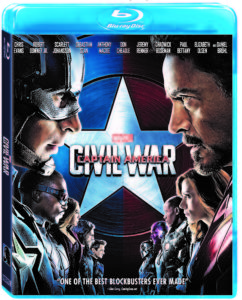 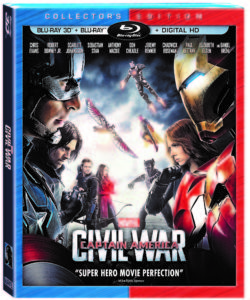 |
|||
| Captain America: Civil War comes home! Video on Demand Sep 2, Blu-Ray Sep 13!
The year’s best action film, Captain America: Civil War has a release date set. The question is: can your home theater handle all the heroes on screen? Featuring Captain America and Iron Man, along with Winter Soldier, Black Widow, Falcon, Vision, Black Panther, Scarlet Witch, Hawkeye, Ant-Man, Spider-Man, War Machine, and more, this is the biggest super-hero movie ever and it’s coming to your home! A 3-D Blu-Ray deluxe set will be released, alongside a regular Blu-Ray. Bonus features include a commentary by directors Anthony and Joe Russo, “United We Stand, Divided We Fall” – a two-part making-of documentary, deleted and extended scenes, and more! Hear Now Playing Podcast’s full review of the movie, then head to Amazon.com now and get your pre-order in! The full press release about Civil War is below.
|
|||
June 30, 2016 Posted by Arnie C | Comic Books, Movies, News | Ant-Man, Avengers, Captain America, Civil War, Collecting, Comic Books, Comics, Enertainment, Film, Iron Man, Marvel, Marvel Cinematic Universe, Marvel Comics, Marvelicious Toys, Movie, Movies, Now Playing, Now Playing Podcast, Podcasts, Pre-Order, Press Release, Review, Scarlet Witch, sci-fi, Spider-Man, Television, Vision, War Machine, Winter Soldier | Comments Off on CIVIL WAR: Choose your side – VOD on 9/2 or Blu-Ray on 9/13!
This Summer NOW PLAYING is Now Playing in Theaters!
When Now Playing Podcast’s X-Men: Apocalypse episode arrived last week, it kick started a summer schedule stacked with week of release reviews for the 9-year-old show and its panel of hosts.
In a way, Now Playing is going back to the beginning.
Longtime listeners will remember the early days, when the show launched with the goal of reviewing a just released flick every week. Those 2007-08 era shows are notable for their shorter run times (the first Iron Man review runs a little more than 8 minutes) and films that would never fit in Now Playing Retrospective Series (reviews of Fever Pitch and 21 are standout examples).
Show creator and producer Arnie Carvalho reflected on that time. “The original idea for Now Playing was to be weekly, recorded off-the-cuff immediately after stepping out of a theater. There was to be no editing, just a ‘live on tape’ show. We’ve come a long way since those days. First came editing, then came retrospectives, then came lots of editing!”
Having established its popularity and found its footing with the first retrospective (for Friday the 13th) in 2009, the show has stuck to its celebrated formula – review every film in a series leading up to the latest release. In summer that usually means a handful of new release reviews wrapped inside the longer retrospectives. Summer 2015, for example, was largely dedicated to the Mad Max and Mission Impossible franchises, with appearances by Marvel heroes and that Terminator sequel we’ve all forgotten.
The summer slate that begins with the aforementioned X-Men review will see the hosts back in theaters for eight new releases over the next 11 weeks, reviewing everything from the latest Teenage Mutant Ninja Turtles and Star Trek sequels, to DC Comics’ Suicide Squad. Three new retrospective series’ will make their debuts this summer, with Matt Damon’s Bourne films taking up the most space on the calendar, and the Independence Day and Ghostbusters franchises offered as a bonus in Now Playing’s bi-annual donation drive.
“The shows we do within days of their US premiere are simply more difficult shows,” Carvalho said. “In three days or less we have to do research that would usually take a week. We have to coordinate our (busy) schedules to find weekend recording time. Then the editor has 20-40 hours of work to cram into just two days. But we are very excited to be doing the films we are, and our listeners match that anticipation, so all of the work is worth it. It looks like a good summer. Out of these eight movies, I’m very excited for six of them!”
Listeners may even be in for a surprise or two, the host hinted. What that means is anyone’s guess, as the calendar turns to June and Now Playing’s summer schedule is stacked through Suicide Squad. The current schedule can be seen at the show’s website, and if you look closely your eyes are not deceiving you – there are two reviews coming for The Bourne Identity. Listeners who love Now Playing’s completist approach to Hollywood franchises will be delighted to know there was a 1988 television movie adaptation of the story, starring a post-Alan Quatermain Richard Chamberlain and former Charlie’s Angel Jaclyn Smith. That should be good.
“Our listeners love when we go obscure. So Chamberlain in a mini-series that hews more closely to the original novel than the Damon films? We’re in!”
June 9, 2016 Posted by Arnie C | Movies, Podcasts | Comic Book, Conjuring, Conjuring 2, Ghostbusters, Harley Quinn, James Wan, Jason Bourne, Marvel, Now Playing, Podcast, star trek, Suicide Squad, Teenage Mutant Ninja Turtles, X-Men | Comments Off on This Summer NOW PLAYING is Now Playing in Theaters!
Pre-Order Alert: Hot Toys Scarlet Witch MMS – Civil War Version
Marvel’s Captain America: Civil War has been critically acclaimed and enjoyed by audience around the world since its release! As the Avengers’ actions in Lagos have caused collateral damage where innocent people are killed, the Sokovia Accords proposed by the United Nations has divided the Earth’s mightiest heroes into opposing teams led by Captain America and Iron Man!
Today Hot Toys put up for pre-order the 1/6th scale collectible figure of the gorgeous and powerful member of Team Cap –Scarlet Witch!
The highly-accurate collectible is specially crafted based on the image of Elizabeth Olsen as Scarlet Witch in the film featuring head sculpt with long curly brown real fabric hair and new makeup application, brand-new and specially tailored costume, interchangeable hands with red translucent fingertips and effect accessories to simulate Scarlet Witch using her powers, and an Captain America: Civil War themed figure stand. Furthermore, an approximately 2.5cm tall miniature running Ant-Man is included as a bonus accessory!
Do not miss out on the opportunity to add the stunning new Scarlet Witch to your collection today!
Hot Toys – MMS370 – Captain America: Civil War – 1/6th scale Scarlet Witch Collectible Figure Specification
~ Movie Masterpiece Series ~
The 1/6th scale Scarlet Witch Collectible Figure features:
- – Authentic and detailed likeness of Elizabeth Olsen as Scarlet Witch in Captain America: Civil War
- – Head sculpt with movie-accurate facial expression, new makeup application, and long curly light-brown real fabric hair implantation
- – Body with over 28 points of articulations
- – Approximately 28 cm tall
- – Seven (7) pieces of interchangeable gloved hands including:
- – One (1) pair of relaxed hands
- – One (1) pair of hands with red translucent fingertips for power-using effects accessories
- – One (1) gesturing right hand with red translucent fingertips
- – Two (2) gesturing left hands with red translucent fingertips
- – Each piece of head sculpt is specially hand-painted
Costume :
- – One (1) red colored top
- – One (1) red colored leather-like coat
- – One (1) pair of black leather-like pants
- – One (1) pair of black boots
- Accessories:
- – One (1) necklace
- – Two (2) types of power effects accessories
- – Captain America: Civil War themed Team Captain America figure stand with character’s nameplate and the movie logo
Bonus Accessory:
- – One (1) miniature Ant-Man in running position (Approximately 2.5cm tall)
Are you bewitched yet? Then head over and order now!
May 31, 2016 Posted by Arnie C | Comic Books, Movies, News | Captain America, Civil War, Collecting, Comic Books, Comics, Elizabeth Olsen, Enertainment, Film, Hot Toys, Marvel, Marvel Cinematic Universe, Marvel Comics, Marvelicious Toys, Movie, Movies, Now Playing, Now Playing Podcast, Pre-Order, Press Release, Scarlet Witch, sci-fi, Sideshow Collectibles, Toys, X-Men | Comments Off on Pre-Order Alert: Hot Toys Scarlet Witch MMS – Civil War Version
Ranking The Avengers Movies Before CIVIL WAR
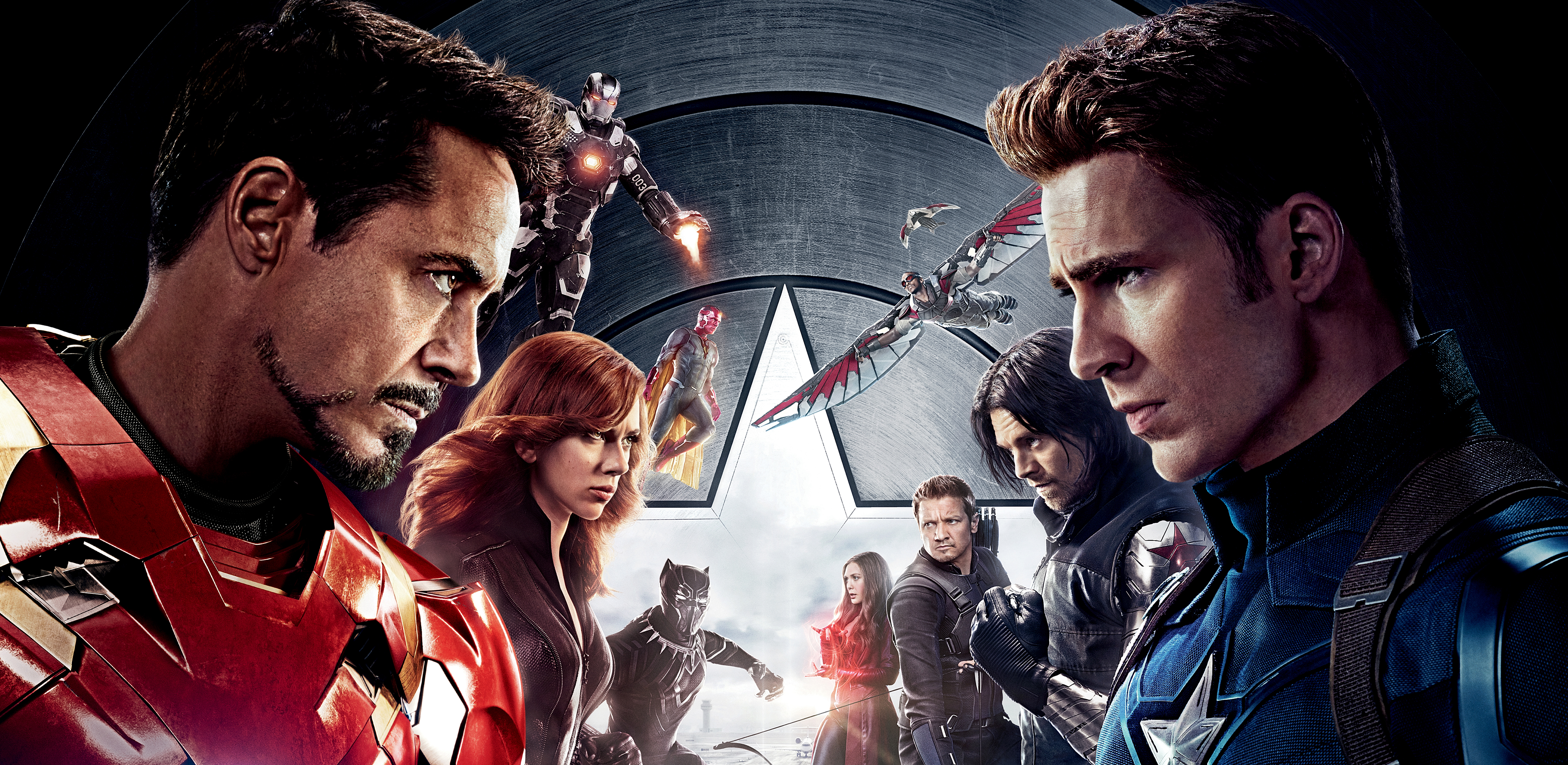
Captain America: Civil War is released in theaters today. This first film in “Phase 3” of the Marvel Cinematic Universe has a huge character roster. Its spotlight scene in trailers and marketing show over a dozen Marvel characters on screen duking it out. With Iron Man, Ant-Man, Spider-Man, and a full Avengers roster, Civil War feels less like a third Captain America movie, and more like the culmination of everything that has come before.
In preparation for this superhero “Monster Mash” here is a recap of the first two phases of the Marvel Cinematic Universe, ranked from worst to best!
May 6, 2016 Posted by Arnie C | Comic Books, Movies, News, Reviews | Ant-Man, Avengers, Captain America, Comic Books, Enertainment, Film, Guardians of the Galaxy, Hulk, Incredible Hulk, Iron Man, Marvel, Marvel Cinematic Universe, Marvel Comics, Movie, Movies, Now Playing, Now Playing Podcast, Spider-Man, Thor, Winter Soldier | 1 Comment
Pre-Order Alert: Hot Toys Die Cast Iron Man Mk 46 from Civil War
Today, #TeamIronMan gets love from Hot Toys. Up for pre-order now is the 1/6th scale collectible figure of Tony Stark’s new Iron Man armor – the Mark XLVI to the Hot Toys MMS Diecast series which the collectible figure is made of diecast material, and realistically designed to look even more like the armor as it appears in the film.
The highly-accurate Mark XLVI collectible figure is greatly detailed and specially crafted based on the image of Robert Downey Jr. as Tony Stark/Iron Man Mark XLVI in Captain America: Civil War. It features a newly sculpted Tony Stark head sculpt, an interchangeable helmeted head, sophistically developed sleek and streamline designed armor, 28 LED light-up points throughout the body, specially applied metallic red, gold and silver colored painting on armor, real-like thrust fire accessories, the helmet of Captain America, and a specially designed debris diorama figure stand.
Do not pass up on the opportunity to add the leader of Team Iron Man to your prized collection!
Check out the gallery below and get your order in now!
Hot Toys – MMS353D16 – Captain America: Civil War – 1/6th scale Mark XLVI Collectible Figure Specification
~ Movie Masterpiece Series Diecast ~
The 1/6th scale Mark XLVI Collectible features:
- – Authentic and detailed likeness of Mark XLVI in Captain America: Civil War
- – Newly sculpted head sculpt with authentic likeness of Robert Downey Jr. as Tony Stark in the movie
- – Alternate helmeted head with LED light-up function (white light, battery operated)
- – Approximately 32 cm tall
- – Metallic red, gold and silver colored painting on the sleek and streamline Mark XLVI armor design
- – Contains diecast material
- – 28 LED light-up points throughout parts of the armor (white light, battery operated)
- – Chest armor can be detached to reveal interior mechanical design
- – Interchangeable shoulder armor (regular, missile firing)
- – Fully deployed air flaps at back of the armor
- – Four (4) pairs of interchangeable hands including:
- – One (1) pair of fists
- – One (1) pair of hands with articulated fingers and light-up repulsors (white light, battery operated)
- – One (1) pair of battle palms with light-up repulsor (white light, battery operated)
- – One (1) pair of hands with real-like thrust fire effect
- – Articulations on waist armor which allow flexible movement
Accessories:
- – One (1) 1/6th scale Captain America helmet
- – Two (2) real-like thrust fire accessories attachable to the feet of the figure
- – Debris diorama figure stand with with Mark XLVI nameplate and the movie logo
April 18, 2016 Posted by Arnie C | Comic Books, Movies, News | Captain America, Civil War, Collecting, Comic Books, Comics, Enertainment, Film, Hot Toys, Iron Man, Marvel, Marvel Cinematic Universe, Marvel Comics, Marvelicious Toys, Movie, Movies, News, Now Playing, Now Playing Podcast, Podcasts, Pre-Order, Press Release, Sideshow Collectibles, Toys | Comments Off on Pre-Order Alert: Hot Toys Die Cast Iron Man Mk 46 from Civil War
Marvel Madness — And the Winner Is……
What a March Marvel Madness it has been! We started with 32 heroes plucked from the Marvel Cinematic Universe, including films, TV shows, and Netflix. 29 single-elimination matches took place with you deciding the results in each case! Sure, you could have voted Howard the Duck beats Hulk, but the voters seemed to keep to the reality defined by the Marvel media.
There were close matches, like when Luke Cage beat Winter Soldier by 1 vote. And there were landslides, like when Hulk smashed Deathlok. But throughout there were fun match-ups that pitted friend vs friend. The full bracket with results is above.
And the end result came down to the two strongest heroes — Hulk vs Thor for the championship! And the contest wasn’t even close. With 68% of the vote, the winner is……..
Hulk smashed his way through Deathlok, Black Panther, Iron Man, Punisher, and Thor to become the 2016 Marvel March Madness Champion! This green golliath truly was unstoppable in this mash-up of heroes! (Perhaps this is why Banner was sent away on a Quinjet in Age of Ultron as Civil War would simply be decided by Hulk).
Thanks from all of us at Now Playing Podcast and Marvelicious Toys to everyone who voted in any and all of these matches. It was fun for us to see how the results went, and maybe next year we can do it again with new heroes like Dr. Strange, or perhaps with the villains — Iron Monger vs Abomination is a match I’d pay to see!
Finally, a special shout-out to Stephen Finley who wrote out narratives for each of the matches — and more often than not the vote followed his story! He posted several of them in our forums, and they’re a very fun read!
Finally, don’t forget to check NowPlayingPodcast.com in just a few weeks for our review of Captain America: Civil War, and join us biweekly at MarveliciousToys.com for the latest Marvel toy collecting news and reviews!
Thanks again for taking part, and EXCELSIOR!
See all the details of the Marvel Madness Infinity Gauntlet and download your bracket sheet
Hear all the Marvel Movies discussed at NowPlayingPodcast.com
Love Marvel Toys? Head to MarveliciousToys.com!
April 6, 2016 Posted by Arnie C | Comic Books, Movies | Action, Avengers, Captain America, Comic Books, Comics, Enertainment, Film, Hulk, Incredible Hulk, Iron Man, March Madness, Marvel, Marvel Cinematic Universe, Marvel Comics, Marvel Madness, Marvelicious Toys, Match-Up, Movie, Movies, My Dad can beat up your dad, Now Playing, Now Playing Podcast, Podcasts, sci-fi, Spider-Man | Comments Off on Marvel Madness — And the Winner Is……
Marvel Madness Finals – Hulk vs Thor
It’s a fight staged again and again. It was in the first Avengers movie, and in countless comics. Now the two strongest Avengers are the finalists in March Marvel Madness. It’s Hulk vs Thor for the championship!
Both proved worthy competitors as they defeated every fight they had. You can see the full result bracket of March Marvel Madness below:
Who will win it all? You decide so vote now!
[poll id=”35″]
See all the details of the Marvel Madness Infinity Gauntlet and download your bracket sheet
Hear all the Marvel Movies discussed at NowPlayingPodcast.com
Love Marvel Toys? Head to MarveliciousToys.com!
April 5, 2016 Posted by Arnie C | Comic Books, Movies | Action, Avengers, Captain America, Comic Books, Comics, Enertainment, Film, Hulk, Incredible Hulk, Iron Man, March Madness, Marvel, Marvel Cinematic Universe, Marvel Comics, Marvel Madness, Marvelicious Toys, Match-Up, Movie, Movies, My Dad can beat up your dad, Now Playing, Now Playing Podcast, Podcasts, sci-fi, Spider-Man | 1 Comment
Marvel Madness Final 4 – Captain America vs Thor
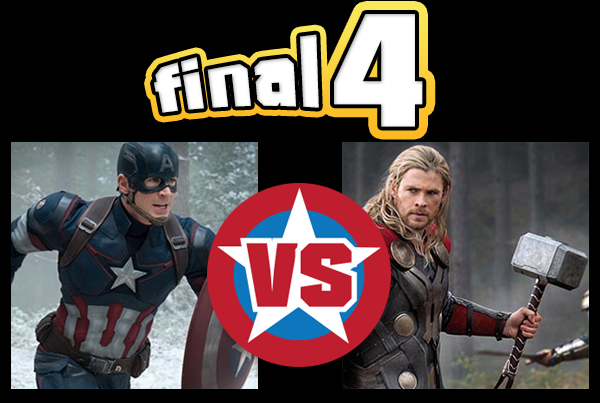
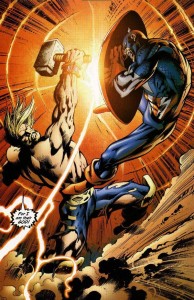 Thor, God of Thunder, has hammered through victory after victory, earning his spot in the Marvel Madness Final Four! He splintered Groot in the first round. His hammer bested Gamora’s blade in the Sweet Sixteen. He even proved more worthy than Vision, defeating the android in the Elite Eight. Can Thor fly fast enough to take it all?
Thor, God of Thunder, has hammered through victory after victory, earning his spot in the Marvel Madness Final Four! He splintered Groot in the first round. His hammer bested Gamora’s blade in the Sweet Sixteen. He even proved more worthy than Vision, defeating the android in the Elite Eight. Can Thor fly fast enough to take it all?
He’s facing daring competition in this round–Captain America! Daredevil proved no match against the Star Spangled Avenger, and Jessica Jones fared little better. Even when up against Spider-Man in the Elite Eight, The First Avenger won.
Who makes it into the finals, and who goes home battered and bruised? You decide so vote now!
[poll id=”34″]
See all the details of the Marvel Madness Infinity Gauntlet and download your bracket sheet
Hear all the Marvel Movies discussed at NowPlayingPodcast.com
Love Marvel Toys? Head to MarveliciousToys.com!
April 4, 2016 Posted by Arnie C | Comic Books, Movies | Action, Avengers, Captain America, Comic Books, Comics, Enertainment, Film, Hulk, Incredible Hulk, Iron Man, March Madness, Marvel, Marvel Cinematic Universe, Marvel Comics, Marvel Madness, Marvelicious Toys, Match-Up, Movie, Movies, My Dad can beat up your dad, Now Playing, Now Playing Podcast, Podcasts, sci-fi, Spider-Man | 1 Comment
Now Playing Podcast to Deliver Summer of Sci-fi
Now Playing Podcast announced its Spring 2016 Donation Series last week, a lineup of film reviews bookended by two highly requested comedy franchises along with a motley crew of cult classics from the summer of 1986. The latter series, dubbed “Sci-Fi of Summer 1986” should appeal to some of the show’s longtime fans who have been lobbying for those films that they may have missed in theaters but grew up watching on USA “Saturday Nightmares” or Joe Bob Briggs’ “Monstervision.”
As is tradition, donors will get to choose between Silver, Gold, and Platinum tiers.
Silver
The Silver Level series ($10 or more) features Will Smith in his prime, headlining Now Playing Podcast reviews of the Men In Black franchise, along with Independence Day and its upcoming sequel.
Gold
The Gold Level series ($25 or more) is where things get really interesting. For the first time, the Now Playing hosts will dissect a series of non-franchise releases with no connection to one another: Critters, Tobe Hooper’s Invaders From Mars, SpaceCamp, Labyrinth (starring Jennifer Connelly and the late, great David Bowie), John Carpenter’s Big Trouble in Little China, and Night of the Creeps. While none were blockbusters in 1986, they still have their fans, most notably Big Trouble and Creeps, which listeners have long requested Now Playing review.
While there is no official Carpenter retrospective, the Big Trouble review will check off another title in the director’s filmography. The Now Playing hosts have previously reviewed Halloween, The Thing, Prince of Darkness, and They Live, with Christine somewhere on the show’s future calendar as part of the Stephen King retrospective. We can all cross our fingers for The Fog or Escape from New York someday, but in the meantime it’s more than a gift to have the director writing the foreword to Now Playing’s first book, “Underrated Movies We Recommend.”
Platinum
When the summer is in full swing, the donation series will focus on one of the greatest comedies of all-time, its pretty great sequel, and the controversial remake/reboot that arrives July 15. A Platinum Level donation of $35 or more will deliver all of the aforementioned reviews, and the Ghostbusters retrospective. The director of Bridesmaids and Spy helms the latest incarnation of the New York-based paranormal investigators and eliminators, and following a mixed reception to the first trailer, it will be fascinating to see if this new Ghostbusters can amass the kind of fan following the first films earned.
The Now Playing Podcast Spring Donation Drive runs from April 1 to July 31, with the first review scheduled for release on April 22. Sign up now to get all of these bonus shows!
April 3, 2016 Posted by Jason Latham | Movies, News | big trouble in little china, bridesmaids, christine, critters, escape from new york, Ghostbusters, ghostbusters 2, Halloween, independence day, independence day resurgence, invaders from mars, joe bob briggs, John Carpenter, labyrinth, men in black, men in black 2, men in black 3, monstervision, News, night of the creeps, Now Playing, Now Playing Podcast, paul feig, Podcasts, prince of darkness, spacecamp, spy, the fog, They Live, usa network | Comments Off on Now Playing Podcast to Deliver Summer of Sci-fi
Marvel Madness Elite 8 – Spider-Man vs Captain America
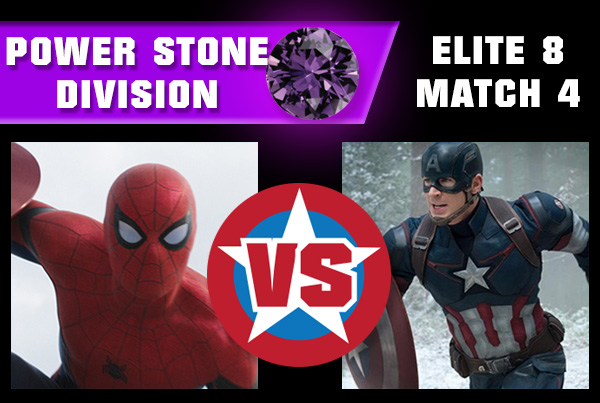
Spider-Man was tougher than Power Man and became one of the Marvel Madness Elite 8. Meanwhile, Cage’s wife fared even worse when up against Captain America.
Now it’s Winghead vs. Web-head to advance to the Final Four. We know Spidey is #TeamIronMan and, well, Cap is #TeamCap. But who wins when they go head to head?
Vote now to choose!
[poll id=”32″]
See all the details of the Marvel Madness Infinity Gauntlet and download your bracket sheet
Hear all the Marvel Movies discussed at NowPlayingPodcast.com
Love Marvel Toys? Head to MarveliciousToys.com!
April 2, 2016 Posted by Arnie C | Comic Books, Movies | Action, Avengers, Captain America, Comic Books, Comics, Enertainment, Film, Hulk, Incredible Hulk, Iron Man, March Madness, Marvel, Marvel Cinematic Universe, Marvel Comics, Marvel Madness, Marvelicious Toys, Match-Up, Movie, Movies, My Dad can beat up your dad, Now Playing, Now Playing Podcast, Podcasts, sci-fi, Spider-Man | Comments Off on Marvel Madness Elite 8 – Spider-Man vs Captain America
Marvel Madness Elite 8 – Punisher vs Black Widow
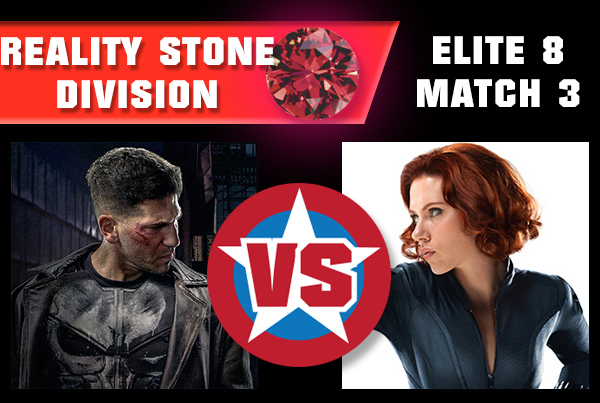
The Punisher easily outgunned Hawkeye to advance to the Elite 8. And Black Widow defeated every other S.H.I.E.L.D. agent to enter this round. But now can Natasha’s fighting skills and widow’s sting compete against The Punisher’s military training and endless supply of guns? Vote now to choose!
[poll id=”31″]
See all the details of the Marvel Madness Infinity Gauntlet and download your bracket sheet
Hear all the Marvel Movies discussed at NowPlayingPodcast.com
Love Marvel Toys? Head to MarveliciousToys.com!
April 2, 2016 Posted by Arnie C | Comic Books, Movies | Action, Avengers, Captain America, Comic Books, Comics, Enertainment, Film, Hulk, Incredible Hulk, Iron Man, March Madness, Marvel, Marvel Cinematic Universe, Marvel Comics, Marvel Madness, Marvelicious Toys, Match-Up, Movie, Movies, My Dad can beat up your dad, Now Playing, Now Playing Podcast, Podcasts, sci-fi, Spider-Man | Comments Off on Marvel Madness Elite 8 – Punisher vs Black Widow
Marvel Madness Elite 8 – Vision vs Thor
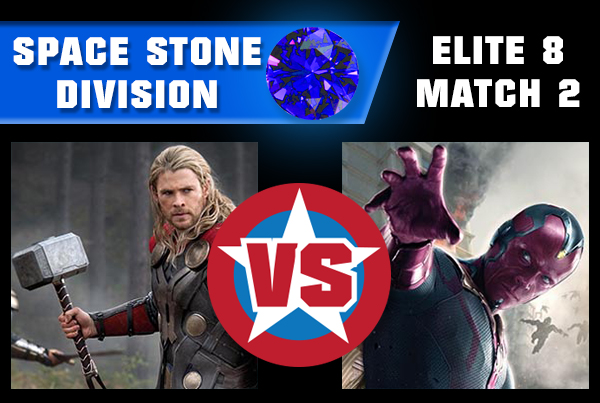
Hulk was the first hero in March Marvel Madness’ Elite 8, having little more trouble beating Black Panther than he did Deathlok. Meanwhile, in a battle of the armored Avengers, Iron Man came out on top.
Now Hulk and Iron Man face off in the first match of the Elite 8. Who makes it to the Final 4? Vote now to choose!
[poll id=”30″]
See all the details of the Marvel Madness Infinity Gauntlet and download your bracket sheet
Hear all the Marvel Movies discussed at NowPlayingPodcast.com
Love Marvel Toys? Head to MarveliciousToys.com!
April 1, 2016 Posted by Arnie C | Comic Books, Movies | Action, Avengers, Captain America, Comic Books, Comics, Enertainment, Film, Hulk, Incredible Hulk, Iron Man, March Madness, Marvel, Marvel Cinematic Universe, Marvel Comics, Marvel Madness, Marvelicious Toys, Match-Up, Movie, Movies, My Dad can beat up your dad, Now Playing, Now Playing Podcast, Podcasts, sci-fi, Spider-Man | 1 Comment
Marvel Madness Elite 8 – Hulk vs Iron Man!
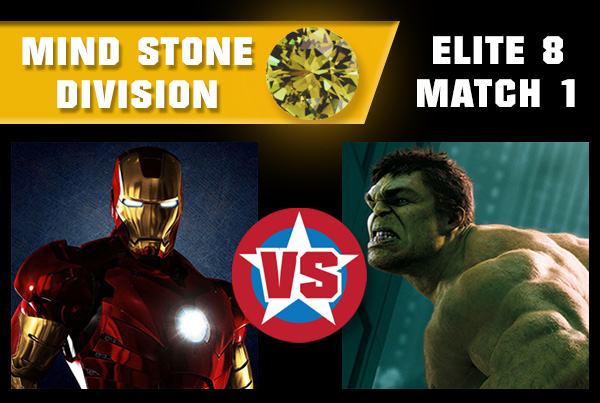
Hulk was the first hero in March Marvel Madness’ Elite 8, having little more trouble beating Black Panther than he did Deathlok. Meanwhile, in a battle of the armored Avengers, Iron Man came out on top.
Now Hulk and Iron Man face off in the first match of the Elite 8. Who makes it to the Final 4? Vote now to choose!
[poll id=”28″]
See all the details of the Marvel Madness Infinity Gauntlet and download your bracket sheet
Hear all the Marvel Movies discussed at NowPlayingPodcast.com
Love Marvel Toys? Head to MarveliciousToys.com!
April 1, 2016 Posted by Arnie C | Comic Books, Movies | Action, Avengers, Captain America, Comic Books, Comics, Enertainment, Film, Hulk, Incredible Hulk, Iron Man, March Madness, Marvel, Marvel Cinematic Universe, Marvel Comics, Marvel Madness, Marvelicious Toys, Match-Up, Movie, Movies, My Dad can beat up your dad, Now Playing, Now Playing Podcast, Podcasts, sci-fi, Spider-Man | Comments Off on Marvel Madness Elite 8 – Hulk vs Iron Man!
Marvel Madness Sweet 16 Match 8 – Jessica Jones vs Captain America
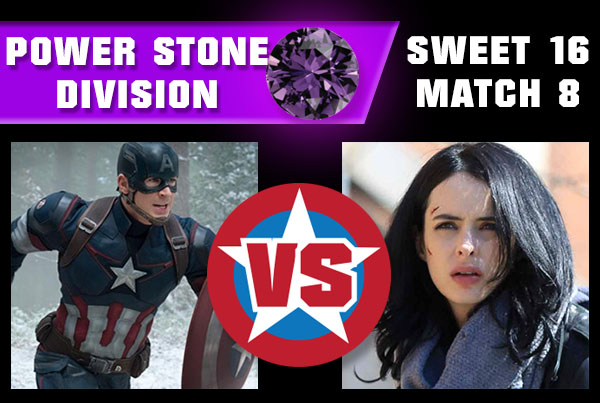
Jessica Jones scored a narrow victory over Quicksilver, advancing to March Marvel Madness’ Sweet 16. Meanwhile Captain America obliterated his competitor Daredevil. Can Jessica Jones succeed where her Netflix brother failed? You pick in the final match of the Sweet 16 fights! Then come back tomorrow for the Elite 8!
[poll id=”27″]
See all the details of the Marvel Madness Infinity Gauntlet and download your bracket sheet
Hear all the Marvel Movies discussed at NowPlayingPodcast.com
Love Marvel Toys? Head to MarveliciousToys.com!
March 26, 2016 Posted by Arnie C | Comic Books, Movies | Action, Avengers, Captain America, Comic Books, Comics, Enertainment, Film, Hulk, Incredible Hulk, Iron Man, March Madness, Marvel, Marvel Cinematic Universe, Marvel Comics, Marvel Madness, Marvelicious Toys, Match-Up, Movie, Movies, My Dad can beat up your dad, Now Playing, Now Playing Podcast, Podcasts, sci-fi, Spider-Man | Comments Off on Marvel Madness Sweet 16 Match 8 – Jessica Jones vs Captain America
Marvel Madness Sweet 16 Match 7 – Agent Coulson vs Black Widow
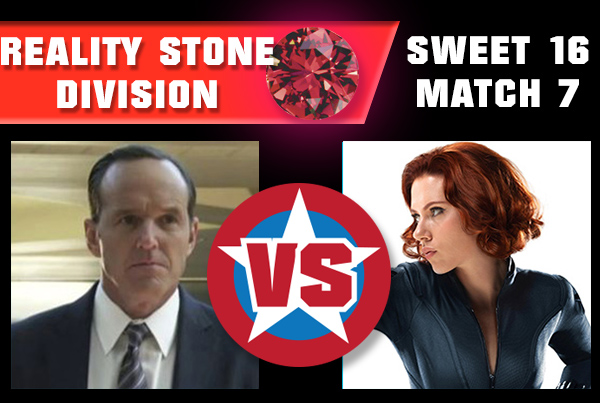
There seems to be a lot of in-fighting at SHIELD these days. Is Hydra involved? Either way, Agent Coulson easily defeated Agent 13, and Black Widow used extreme prejudice to take out SHIELD founder Peggy Carter.
Now Coulson and Black Widow go head to head. Only one Agent of SHIELD is going to advance to March Marvel Madness’ Elite 8. Who will it be? You decide!
[poll id=”25″]
See all the details of the Marvel Madness Infinity Gauntlet and download your bracket sheet
Hear all the Marvel Movies discussed at NowPlayingPodcast.com
Love Marvel Toys? Head to MarveliciousToys.com!
March 26, 2016 Posted by Arnie C | Comic Books, Movies | Action, Avengers, Captain America, Comic Books, Comics, Enertainment, Film, Hulk, Incredible Hulk, Iron Man, March Madness, Marvel, Marvel Cinematic Universe, Marvel Comics, Marvel Madness, Marvelicious Toys, Match-Up, Movie, Movies, My Dad can beat up your dad, Now Playing, Now Playing Podcast, Podcasts, sci-fi, Spider-Man | Comments Off on Marvel Madness Sweet 16 Match 7 – Agent Coulson vs Black Widow
Marvel Madness Sweet 16 Match 6 – Vision vs Rocket Raccoon
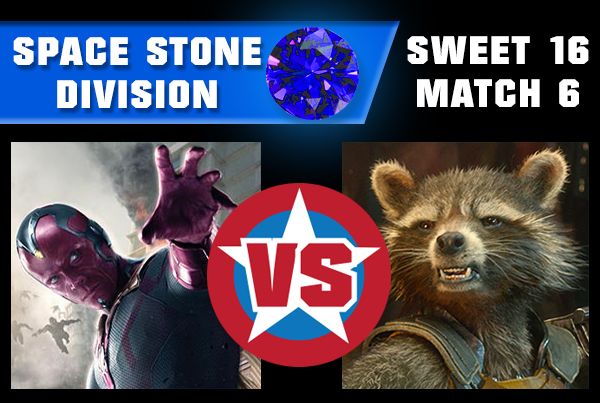
It turns out 12% of a plan wasn’t enough for Star-Lord to face Rocket, so the short, furry Guardian entered our Sweet 16. Vision had a much easier time overcoming his opponent Howard the Duck.
Now Vision and Rocket must do battle in what must be the strangest March Marvel Madness match yet! Will Rocket’s weaponry overcome Vision’s density? Vote now!
[poll id=”24″]
See all the details of the Marvel Madness Infinity Gauntlet and download your bracket sheet
Hear all the Marvel Movies discussed at NowPlayingPodcast.com
Love Marvel Toys? Head to MarveliciousToys.com!
March 25, 2016 Posted by Arnie C | Comic Books, Movies | Action, Avengers, Captain America, Comic Books, Comics, Enertainment, Film, Hulk, Incredible Hulk, Iron Man, March Madness, Marvel, Marvel Cinematic Universe, Marvel Comics, Marvel Madness, Marvelicious Toys, Match-Up, Movie, Movies, My Dad can beat up your dad, Now Playing, Now Playing Podcast, Podcasts, sci-fi, Spider-Man | Comments Off on Marvel Madness Sweet 16 Match 6 – Vision vs Rocket Raccoon
Marvel Madness Sweet 16 Match 5 – Iron Man vs War Machine
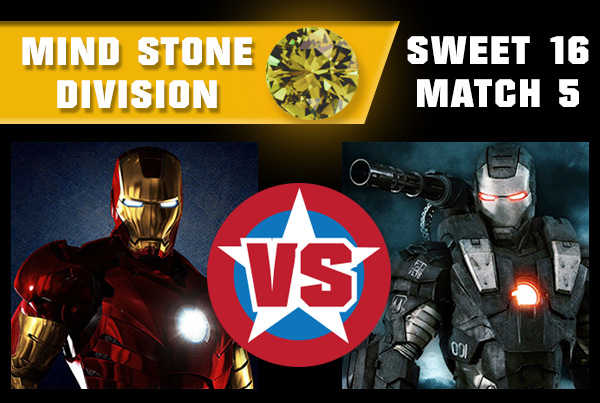
Both of the Armored Avengers won their Round 1 matches. Iron Man scored an easy victory over Nick Fury, and War Machine clipped Falcon’s wings. But now it’s time for these two friends to face off in March Marvel Madness!
War Machine has a big gun, but is he the big gun? Vote Now!
[poll id=”23″]
See all the details of the Marvel Madness Infinity Gauntlet and download your bracket sheet
Hear all the Marvel Movies discussed at NowPlayingPodcast.com
Love Marvel Toys? Head to MarveliciousToys.com!
March 25, 2016 Posted by Arnie C | Comic Books, Movies | Action, Avengers, Captain America, Comic Books, Comics, Enertainment, Film, Hulk, Incredible Hulk, Iron Man, March Madness, Marvel, Marvel Cinematic Universe, Marvel Comics, Marvel Madness, Marvelicious Toys, Match-Up, Movie, Movies, My Dad can beat up your dad, Now Playing, Now Playing Podcast, Podcasts, sci-fi, Spider-Man | Comments Off on Marvel Madness Sweet 16 Match 5 – Iron Man vs War Machine
Marvel Madness Sweet 16 Match 4 – Luke Cage vs Spider-Man
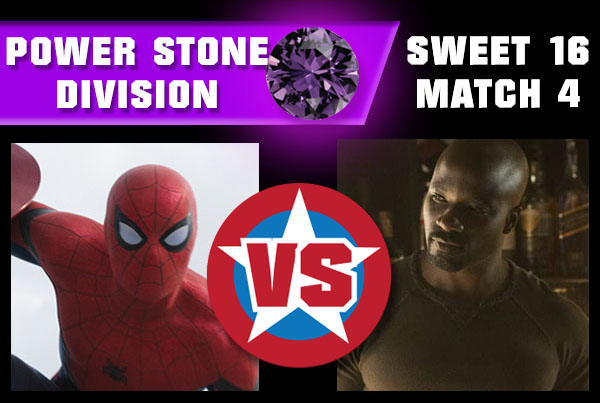
In his first match Spider-Man had a fight on his hands, narrowly defeating Scarlet Witch to join the March Marvel Madness Sweet 16. But the vote was even closer when Luke Cage defeated The Winter Soldier by only one vote!
Now Spider-Man and Luke Cage duke it out for a spot in the Elite 8. In the comics these two hung out quite a bit, but how do their powers compare in combat? YOU DECIDE! Vote now in the poll below
[poll id=”22″]
See all the details of the Marvel Madness Infinity Gauntlet and download your bracket sheet
Hear all the Marvel Movies discussed at NowPlayingPodcast.com
Love Marvel Toys? Head to MarveliciousToys.com!
March 24, 2016 Posted by Arnie C | Comic Books, Movies | Action, Avengers, Captain America, Comic Books, Comics, Enertainment, Film, Hulk, Incredible Hulk, Iron Man, March Madness, Marvel, Marvel Cinematic Universe, Marvel Comics, Marvel Madness, Marvelicious Toys, Match-Up, Movie, Movies, My Dad can beat up your dad, Now Playing, Now Playing Podcast, Podcasts, sci-fi, Spider-Man | 1 Comment
Marvel Madness Sweet 16 Match 3 – Punisher vs Hawkeye
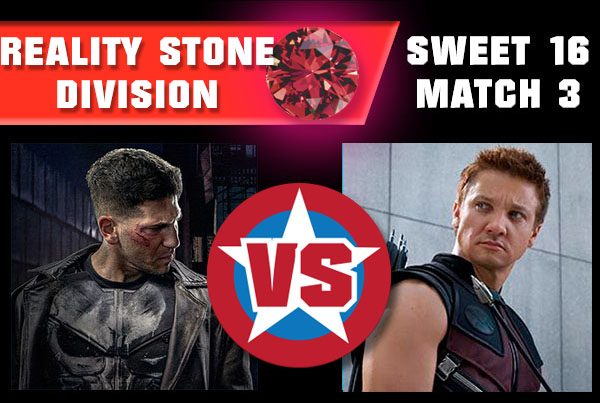
In Round 1 Hawkeye barely overcame Elektra, winning by just one vote! The Punisher, however, obliterated Maria Hill with 83%. Now these two must face off.
How does Hawkeye’s aim and trick arrows compare to The Punisher’s arsenal and war experience? Tell us in the poll below!
[poll id=”21″]
See all the details of the Marvel Madness Infinity Gauntlet and download your bracket sheet
Hear all the Marvel Movies discussed at NowPlayingPodcast.com
Love Marvel Toys? Head to MarveliciousToys.com!
March 24, 2016 Posted by Arnie C | Comic Books, Movies | Action, Avengers, Captain America, Comic Books, Comics, Enertainment, Film, Hulk, Incredible Hulk, Iron Man, March Madness, Marvel, Marvel Cinematic Universe, Marvel Comics, Marvel Madness, Marvelicious Toys, Match-Up, Movie, Movies, My Dad can beat up your dad, Now Playing, Now Playing Podcast, Podcasts, sci-fi, Spider-Man | 1 Comment
Marvel Madness Sweet 16 Match 2 – Gamora vs Thor
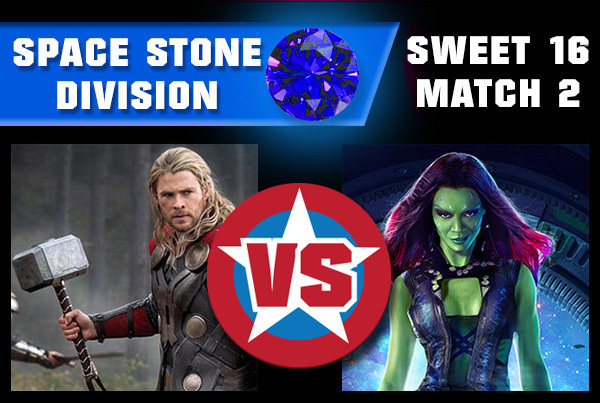
Two Guardians of the Galaxy were eliminated in Round 1 of March Marvel Madness. Drax the Destroyer put up a fight and got 44% of the vote, but it wasn’t enough to beat Gamora. Meanwhile, Groot splinted under the might of Thor’s hammer.
Now these two alien beings face off. Can Gamora’s training under Thanos help her best the son of Odin? You decide!
[poll id=”20″]
See all the details of the Marvel Madness Infinity Gauntlet and download your bracket sheet
Hear all the Marvel Movies discussed at NowPlayingPodcast.com
Love Marvel Toys? Head to MarveliciousToys.com!
March 23, 2016 Posted by Arnie C | Comic Books, Movies | Action, Avengers, Captain America, Comic Books, Comics, Enertainment, Film, Hulk, Incredible Hulk, Iron Man, March Madness, Marvel, Marvel Cinematic Universe, Marvel Comics, Marvel Madness, Marvelicious Toys, Match-Up, Movie, Movies, My Dad can beat up your dad, Now Playing, Now Playing Podcast, Podcasts, sci-fi, Spider-Man | 1 Comment
Marvel Madness Sweet 16 Match 1 – Black Panther vs Hulk
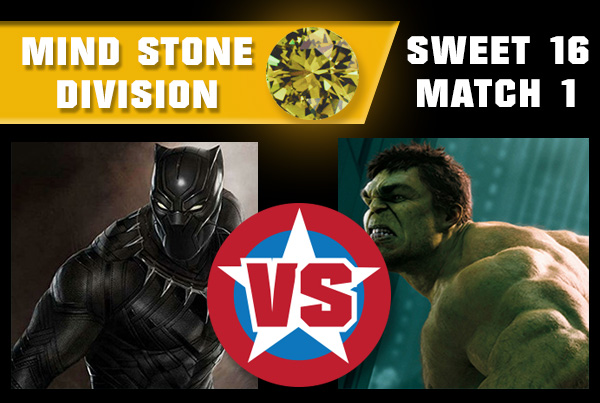
Hulk easily smashed Deathlok, getting 94% of the votes, to progress to our Sweet 16. Meanwhile, Black Panther narrowly defeated Ant-Man. Now the two face off. Will Hulk SMASH puny Panther, or will T’Challa’s superhuman strength and agility give him the edge? Vote now to decide!
[poll id=”19″]
See all the details of the Marvel Madness Infinity Gauntlet and download your bracket sheet
Hear all the Marvel Movies discussed at NowPlayingPodcast.com
Love Marvel Toys? Head to MarveliciousToys.com!
March 23, 2016 Posted by Arnie C | Comic Books, Movies | Action, Avengers, Captain America, Comic Books, Comics, Enertainment, Film, Hulk, Incredible Hulk, Iron Man, March Madness, Marvel, Marvel Cinematic Universe, Marvel Comics, Marvel Madness, Marvelicious Toys, Match-Up, Movie, Movies, My Dad can beat up your dad, Now Playing, Now Playing Podcast, Podcasts, sci-fi, Spider-Man | 2 Comments
The March Marvel Madness Sweet 16 Are Chosen!
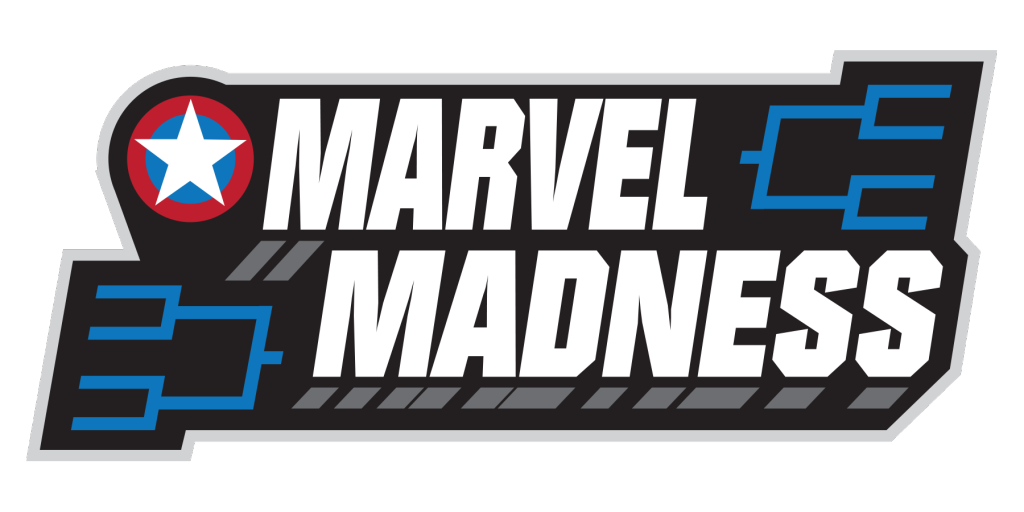
The Sweet 16 Heroes of March Marvel Madness have been selected!
The competition started March 15. Each day two pairs of heroes were plucked from the Marvel Cinematic Universe and competed head to head. Marvel fans across the globe voted at VenganzaMedia.com and from the 32 contestants, 16 winners were chosen.
Now those winners go head to head, the victors advancing to the Elite 8, and you decide the results!
Each day at 1pm EDT from March 23rd through March 26th two more face-offs will be posted. The matches will be:
March 23: Black Panther vs Hulk
March 23: Gamora vs Thor
March 24: Hawkeye vs Punisher
March 24: Spider-Man vs Luke Cage
March 25: War Machine vs Iron Man
March 25: Vision vs Rocket Raccoon
March 26: Agent Phil Coulson vs Black Widow
March 26: Captain America vs Jessica Jones
Come back to VenganzaMedia.com each day to vote for the winner! The victors advance to our March Marvel Madness Elite 8. Then, starting March 27, one match will be posted per day until only one Marvel champion remains!
Marvel collectors: get your dose of Marvel toy and statue collecting news on the Marvelicious Toys podcast!
Marvel movie fans: hear reviews of every Marvel movie, from Howard the Duck through Ant-Man on the Now Playing podcast!
March 23, 2016 Posted by Arnie C | Comic Books, Movies, News | Agents of SHIELD, Avengers, Black Panther, Black Widow, Captain America, Comic Books, Comics, Daredevil, Defenders, Enertainment, Film, Gamora, Guardians of the Galaxy, Hawkeye, Heroes for Hire, Hulk, Incredible Hulk, Iron Man, Jessica Jones, Luke Cage, March Madness, Marvel, Marvel Comics, Marvel Madness, Marvelicious Toys, Movie, Movies, Netflix, News, Now Playing, Now Playing Podcast, Phil Coulson, Podcasts, Press Release, Punisher, sci-fi, Spider-Man, Thor, Vision, War Machine | Comments Off on The March Marvel Madness Sweet 16 Are Chosen!
Marvel Madness Match 16 – Captain America vs Daredevil
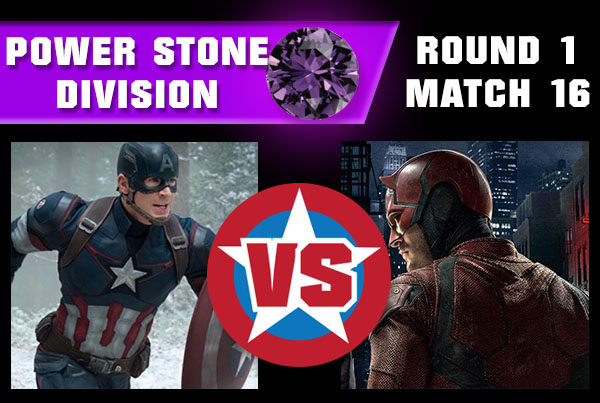
It’s the final fight in March Marvel Madness’ first round, and two heavy hitters collide! Can Captain America’s shield and strength overcome Daredevil’s heightened senses and reflexes? It’s a Spring ’16 battle of big screen vs small, and you decide the winner!
Then come back tomorrow as we start our Sweet 16 matches!
[poll id=”17″]
See all the details of the Marvel Madness Infinity Gauntlet and download your bracket sheet
Hear all the Marvel Movies discussed at NowPlayingPodcast.com
Love Marvel Toys? Head to MarveliciousToys.com!
March 22, 2016 Posted by Arnie C | Comic Books, Movies | Action, Avengers, Captain America, Comic Books, Comics, Enertainment, Film, Hulk, Incredible Hulk, Iron Man, March Madness, Marvel, Marvel Cinematic Universe, Marvel Comics, Marvel Madness, Marvelicious Toys, Match-Up, Movie, Movies, My Dad can beat up your dad, Now Playing, Now Playing Podcast, Podcasts, sci-fi, Spider-Man | Comments Off on Marvel Madness Match 16 – Captain America vs Daredevil
Marvel Madness Match 15 – Agent 13 vs Agent Coulson
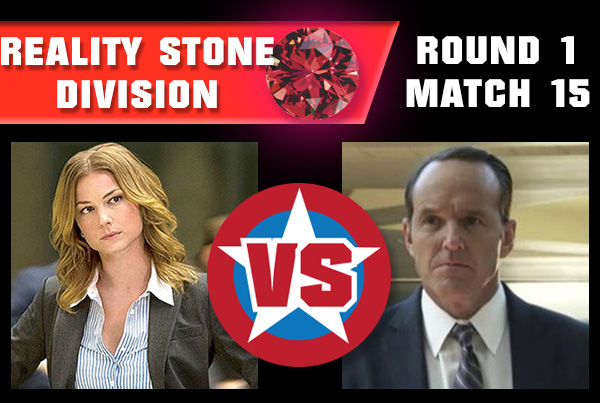
Despite both being Agents under the command of Nick Fury, we’ve never seen Agent Sharon Carter and Agent Phil Coulson together. But one has gone on to be the Director of newly reformed S.H.I.E.L.D. and the other is joining #TeamCap for a Civil War. But if they went head to head, would experience overcome agility? You decide!
[poll id=”16″]
See all the details of the Marvel Madness Infinity Gauntlet and download your bracket sheet
Hear all the Marvel Movies discussed at NowPlayingPodcast.com
Love Marvel Toys? Head to MarveliciousToys.com!
March 22, 2016 Posted by Arnie C | Comic Books, Movies | Action, Avengers, Captain America, Comic Books, Comics, Enertainment, Film, Hulk, Incredible Hulk, Iron Man, March Madness, Marvel, Marvel Cinematic Universe, Marvel Comics, Marvel Madness, Marvelicious Toys, Match-Up, Movie, Movies, My Dad can beat up your dad, Now Playing, Now Playing Podcast, Podcasts, sci-fi, Spider-Man | Comments Off on Marvel Madness Match 15 – Agent 13 vs Agent Coulson
Marvel Madness Match 14 – Rocket Raccoon vs Star-Lord!
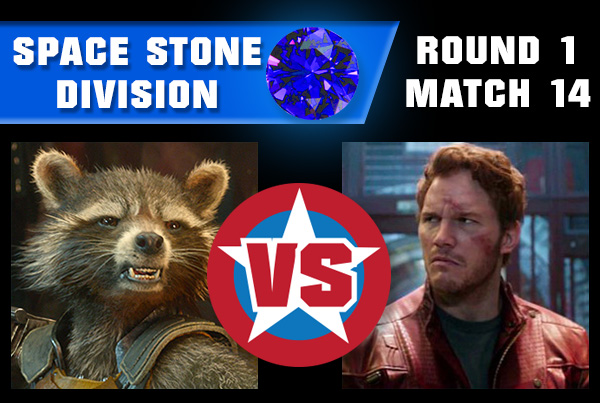
Two galactic Guardians go head to head in a winner takes-all deathmatch! YOU decide if Star-Lord’s 12% of a plan can overcome Rocket’s weaponry!
[poll id=”15″]
See all the details of the Marvel Madness Infinity Gauntlet and download your bracket sheet
Hear all the Marvel Movies discussed at NowPlayingPodcast.com
Love Marvel Toys? Head to MarveliciousToys.com!
March 21, 2016 Posted by Arnie C | Comic Books, Movies | Action, Avengers, Captain America, Comic Books, Comics, Enertainment, Film, Hulk, Incredible Hulk, Iron Man, March Madness, Marvel, Marvel Cinematic Universe, Marvel Comics, Marvel Madness, Marvelicious Toys, Match-Up, Movie, Movies, My Dad can beat up your dad, Now Playing, Now Playing Podcast, Podcasts, sci-fi, Spider-Man | Comments Off on Marvel Madness Match 14 – Rocket Raccoon vs Star-Lord!
Marvel Madness Match 13 – Nick Fury vs Iron Man!
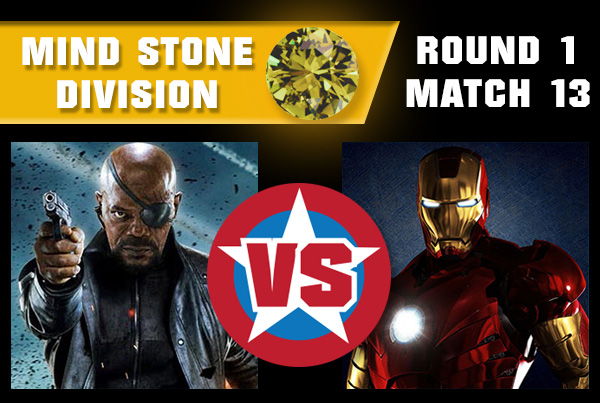
Nick Fury has years of training and combat experience. Iron Man has attitude and a really cool suit. Can the Director of S.H.I.E.L.D. overcome the Iron Avenger? You decide!
[poll id=”14″]
See all the details of the Marvel Madness Infinity Gauntlet and download your bracket sheet
Hear all the Marvel Movies discussed at NowPlayingPodcast.com
Love Marvel Toys? Head to MarveliciousToys.com!
March 21, 2016 Posted by Arnie C | Comic Books, Movies | Action, Avengers, Captain America, Comic Books, Comics, Enertainment, Film, Hulk, Incredible Hulk, Iron Man, March Madness, Marvel, Marvel Cinematic Universe, Marvel Comics, Marvel Madness, Marvelicious Toys, Match-Up, Movie, Movies, My Dad can beat up your dad, Now Playing, Now Playing Podcast, Podcasts, sci-fi, Spider-Man | Comments Off on Marvel Madness Match 13 – Nick Fury vs Iron Man!
Marvel Madness Match 12 – Jessica Jones vs Quicksilver!
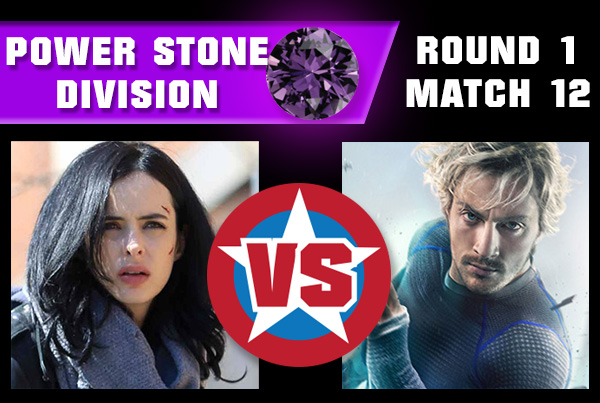
Jessica Jones and Quicksilver both started as normal people, but experiments turned them into superheroes. But can Jones’ strength overcome Quicksilver’s speed? You decide!
[poll id=”13″]
See all the details of the Marvel Madness Infinity Gauntlet and download your bracket sheet
Hear all the Marvel Movies discussed at NowPlayingPodcast.com
Love Marvel Toys? Head to MarveliciousToys.com!
March 20, 2016 Posted by Arnie C | Comic Books, Movies | Action, Avengers, Captain America, Comic Books, Comics, Enertainment, Film, Hulk, Incredible Hulk, Iron Man, March Madness, Marvel, Marvel Cinematic Universe, Marvel Comics, Marvel Madness, Marvelicious Toys, Match-Up, Movie, Movies, My Dad can beat up your dad, Now Playing, Now Playing Podcast, Podcasts, sci-fi, Spider-Man | 2 Comments
Marvel Madness Match 11 – Agent Carter vs Black Widow
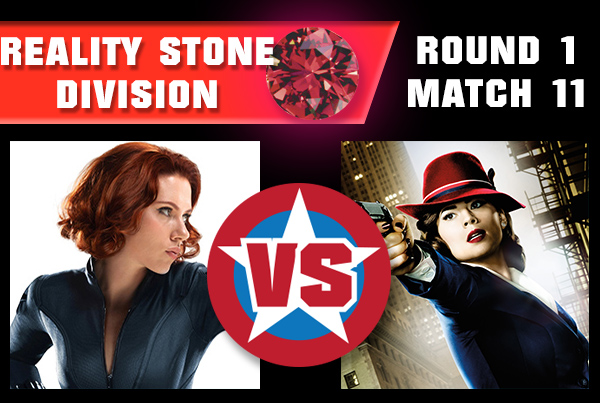
Both women are highly trained operatives, skilled in combat and undercover infiltration. But when these two secret agents battle it out, who comes out on top — Agent Peggy Carter or the Black Widow?
[poll id=”12″]
See all the details of the Marvel Madness Infinity Gauntlet and download your bracket sheet
Hear all the Marvel Movies discussed at NowPlayingPodcast.com
Love Marvel Toys? Head to MarveliciousToys.com!
March 20, 2016 Posted by Arnie C | Comic Books, Movies | Action, Avengers, Captain America, Comic Books, Comics, Enertainment, Film, Hulk, Incredible Hulk, Iron Man, March Madness, Marvel, Marvel Cinematic Universe, Marvel Comics, Marvel Madness, Marvelicious Toys, Match-Up, Movie, Movies, My Dad can beat up your dad, Now Playing, Now Playing Podcast, Podcasts, sci-fi, Spider-Man | Comments Off on Marvel Madness Match 11 – Agent Carter vs Black Widow
Marvel Madness Match 10 – Howard the Duck vs Vision!
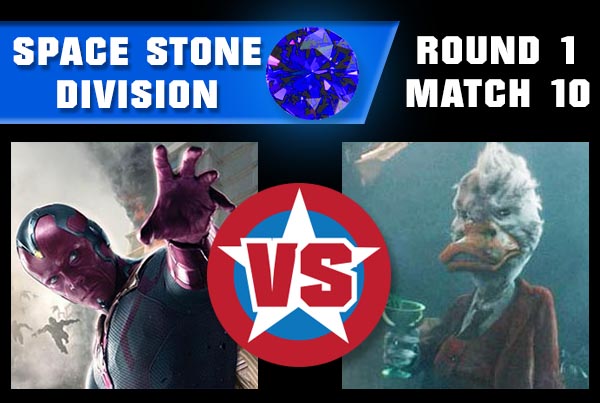
This may seem like an unfair fight — after all, what chance does an Infinity Gem powered android stand against an anthropomorphic water fowl? But both had encounters with infinity stones, and Howard is a master of Quack-Fu. And you get to decide which of them progresses to the Marvel Madness Sweet Sixteen!
[poll id=”11″]
See all the details of the Marvel Madness Infinity Gauntlet and download your bracket sheet
Hear all the Marvel Movies discussed at NowPlayingPodcast.com
Love Marvel Toys? Head to MarveliciousToys.com!
March 19, 2016 Posted by Arnie C | Comic Books, Movies | Action, Avengers, Captain America, Comic Books, Comics, Enertainment, Film, Hulk, Incredible Hulk, Iron Man, March Madness, Marvel, Marvel Cinematic Universe, Marvel Comics, Marvel Madness, Marvelicious Toys, Match-Up, Movie, Movies, My Dad can beat up your dad, Now Playing, Now Playing Podcast, Podcasts, sci-fi, Spider-Man | 1 Comment
Marvel Madness Match 9 – Falcon vs War Machine!
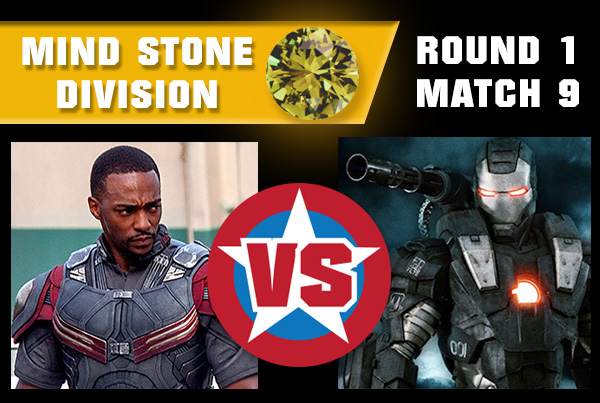
Never in Marvel Madness history have we had such equal opponents. These super sidekicks both have military histories, and their powered suits got them roles in the Avengers! But Falcon is #TeamCap and War Machine is #TeamStark so one has to fall. Can the “big gun’s” fight overcome Falcon’s flight?
[poll id=”10″]
See all the details of the Marvel Madness Infinity Gauntlet and download your bracket sheet
Hear all the Marvel Movies discussed at NowPlayingPodcast.com
Love Marvel Toys? Head to MarveliciousToys.com!
March 19, 2016 Posted by Arnie C | Comic Books, Movies | Action, Avengers, Captain America, Comic Books, Comics, Enertainment, Film, Hulk, Incredible Hulk, Iron Man, March Madness, Marvel, Marvel Cinematic Universe, Marvel Comics, Marvel Madness, Marvelicious Toys, Match-Up, Movie, Movies, My Dad can beat up your dad, Now Playing, Now Playing Podcast, Podcasts, sci-fi, Spider-Man | 1 Comment
Marvel Madness Match 8 – Scarlet Witch vs Spider-Man!
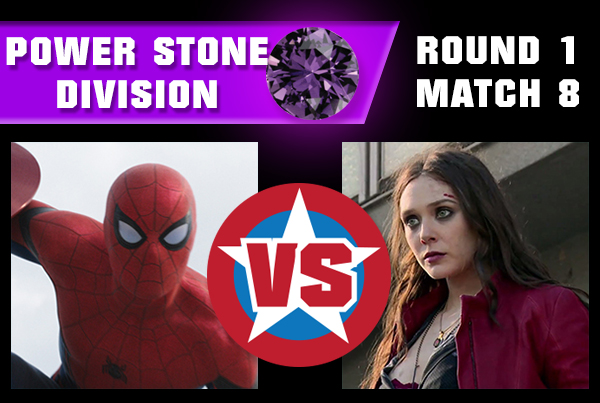
Can webs and wits win over a witch with hex powers? Vote now to see which Avenger comes out on top!
[poll id=”9″]
See all the details of the Marvel Madness Infinity Gauntlet and download your bracket sheet
Hear all the Marvel Movies discussed at NowPlayingPodcast.com
Love Marvel Toys? Head to MarveliciousToys.com!
March 18, 2016 Posted by Arnie C | Comic Books, Movies | Action, Avengers, Captain America, Comic Books, Comics, Enertainment, Film, Hulk, Incredible Hulk, Iron Man, March Madness, Marvel, Marvel Cinematic Universe, Marvel Comics, Marvel Madness, Marvelicious Toys, Match-Up, Movie, Movies, My Dad can beat up your dad, Now Playing, Now Playing Podcast, Podcasts, sci-fi, Spider-Man | 3 Comments
Marvel Madness Match 7 – Elektra vs Hawkeye!
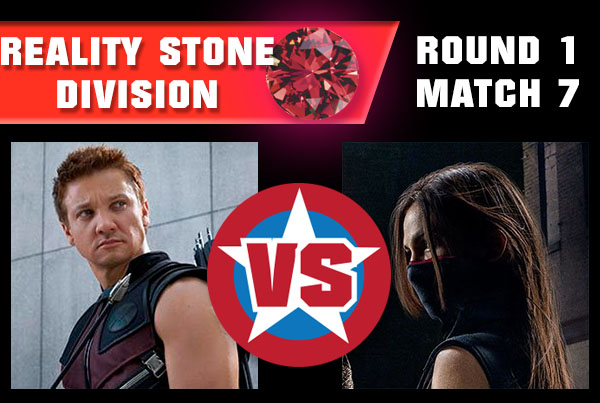
Hawkeye lost his parents, joined a carnival, and became a master archer. Elektra lost her parents and became a ninja assassin. But when they go head to head, who will be victorious?
[poll id=”8″]
See all the details of the Marvel Madness Infinity Gauntlet and download your bracket sheet
Hear all the Marvel Movies discussed at NowPlayingPodcast.com
Love Marvel Toys? Head to MarveliciousToys.com!
March 18, 2016 Posted by Arnie C | Comic Books, Movies | Action, Avengers, Captain America, Comic Books, Comics, Enertainment, Film, Hulk, Incredible Hulk, Iron Man, March Madness, Marvel, Marvel Cinematic Universe, Marvel Comics, Marvel Madness, Marvelicious Toys, Match-Up, Movie, Movies, My Dad can beat up your dad, Now Playing, Now Playing Podcast, Podcasts, sci-fi, Spider-Man | 3 Comments
Marvel Madness Match 6 – Thor vs Groot!
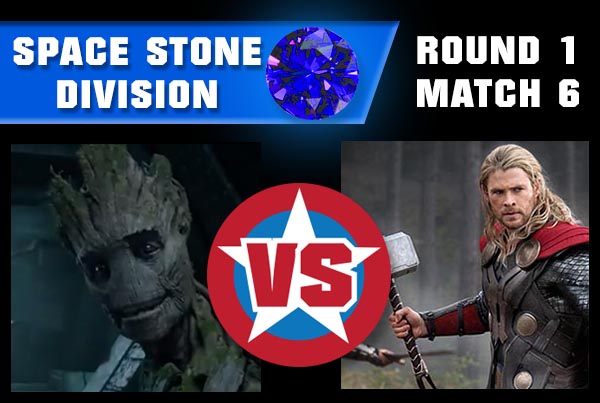
A god versus a Groot — but who is worthy to advance to the Sweet Sixteen of Marvel Madness?
[poll id=”7″]
See all the details of the Marvel Madness Infinity Gauntlet and download your bracket sheet
Hear all the Marvel Movies discussed at NowPlayingPodcast.com
Love Marvel Toys? Head to MarveliciousToys.com!
March 17, 2016 Posted by Arnie C | Comic Books, Movies | Action, Avengers, Captain America, Comic Books, Comics, Enertainment, Film, Hulk, Incredible Hulk, Iron Man, March Madness, Marvel, Marvel Cinematic Universe, Marvel Comics, Marvel Madness, Marvelicious Toys, Match-Up, Movie, Movies, My Dad can beat up your dad, Now Playing, Now Playing Podcast, Podcasts, sci-fi, Spider-Man | 1 Comment
Marvel Madness Match 5 – Deathlok vs The Hulk!
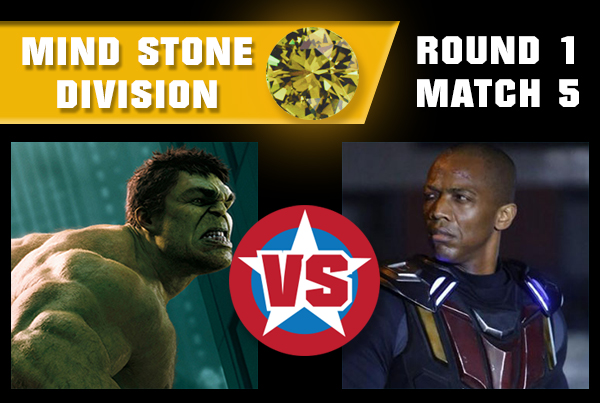
It’s brawn versus tech in today’s match! Who wins and gets to advance to the Sweet Sixteen — The Hulk or Deathlok?
[poll id=”6″]
See all the details of the Marvel Madness Infinity Gauntlet and download your bracket sheet
Hear all the Marvel Movies discussed at NowPlayingPodcast.com
Love Marvel Toys? Head to MarveliciousToys.com!
March 17, 2016 Posted by Arnie C | Comic Books, Movies | Action, Avengers, Captain America, Comic Books, Comics, Enertainment, Film, Hulk, Incredible Hulk, Iron Man, March Madness, Marvel, Marvel Cinematic Universe, Marvel Comics, Marvel Madness, Marvelicious Toys, Match-Up, Movie, Movies, My Dad can beat up your dad, Now Playing, Now Playing Podcast, Podcasts, sci-fi, Spider-Man | 1 Comment
Marvel Madness Match 4 – Winter Soldier vs Luke Cage!
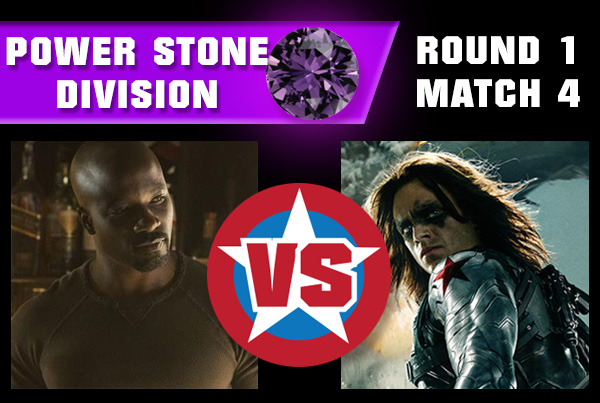
They were once normal humans until science made them something more. But who wins this battle — Luke Cage or The Winter Soldier?
[poll id=”5″]
See all the details of the Marvel Madness Infinity Gauntlet and download your bracket sheet
Hear all the Marvel Movies discussed at NowPlayingPodcast.com
Love Marvel Toys? Head to MarveliciousToys.com!
March 16, 2016 Posted by Arnie C | Comic Books, Movies | Action, Avengers, Captain America, Comic Books, Comics, Enertainment, Film, Hulk, Incredible Hulk, Iron Man, March Madness, Marvel, Marvel Cinematic Universe, Marvel Comics, Marvel Madness, Marvelicious Toys, Match-Up, Movie, Movies, My Dad can beat up your dad, Now Playing, Now Playing Podcast, Podcasts, sci-fi, Spider-Man | 3 Comments
Marvel Madness Match 3 – Maria Hill vs The Punisher!
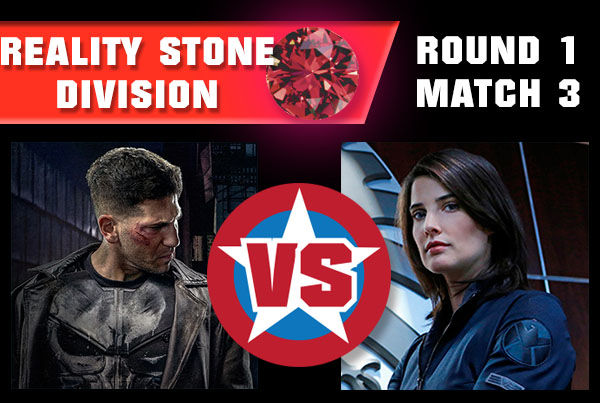
Vigilante justice or teamwork and leadership? Who wins when these two draw their guns — The Punisher or Maria Hill?
[poll id=”4″]
See all the details of the Marvel Madness Infinity Gauntlet and download your bracket sheet
Hear all the Marvel Movies discussed at NowPlayingPodcast.com
Love Marvel Toys? Head to MarveliciousToys.com!
March 16, 2016 Posted by Arnie C | Comic Books, Movies | Action, Avengers, Captain America, Comic Books, Comics, Enertainment, Film, Hulk, Incredible Hulk, Iron Man, March Madness, Marvel, Marvel Cinematic Universe, Marvel Comics, Marvel Madness, Marvelicious Toys, Match-Up, Movie, Movies, My Dad can beat up your dad, Now Playing, Now Playing Podcast, Podcasts, sci-fi, Spider-Man | 2 Comments
Marvel Madness Match 1 – Ant Man vs Black Panther!
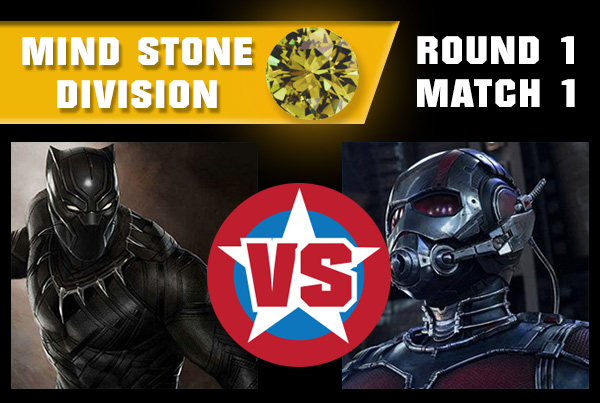
Our contest begins with our first match in the MIND STONE division! Which of these animalistic heroes will rule the day — Black Panther or Ant-Man?
[poll id=”2″]
See all the details of the Marvel Madness Infinity Gauntlet and download your bracket sheet
Hear all the Marvel Movies discussed at NowPlayingPodcast.com
Love Marvel Toys? Head to MarveliciousToys.com!
March 15, 2016 Posted by Arnie C | Comic Books, Movies | Action, Avengers, Captain America, Comic Books, Comics, Enertainment, Film, Hulk, Incredible Hulk, Iron Man, March Madness, Marvel, Marvel Cinematic Universe, Marvel Comics, Marvel Madness, Marvelicious Toys, Match-Up, Movie, Movies, My Dad can beat up your dad, Now Playing, Now Playing Podcast, Podcasts, sci-fi, Spider-Man | 3 Comments
Marvel Madness Match 2 – Drax the Destroyer vs Gamora!
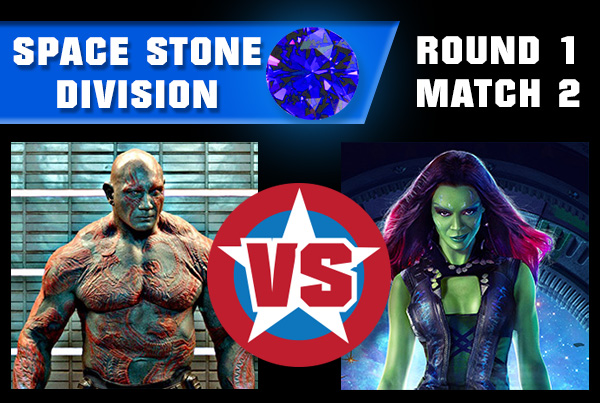
Our second challenge for today pits two Guardians against each other! Who will win the first match in the SPACE STONE division — Gamora or Drax?
[poll id=”3″]
See all the details of the Marvel Madness Infinity Gauntlet and download your bracket sheet
Hear all the Marvel Movies discussed at NowPlayingPodcast.com
Love Marvel Toys? Head to MarveliciousToys.com!
March 15, 2016 Posted by Arnie C | Comic Books, Movies | Action, Avengers, Captain America, Comic Books, Comics, Enertainment, Film, Hulk, Incredible Hulk, Iron Man, March Madness, Marvel, Marvel Cinematic Universe, Marvel Comics, Marvel Madness, Marvelicious Toys, Match-Up, Movie, Movies, My Dad can beat up your dad, Now Playing, Now Playing Podcast, Podcasts, sci-fi, Spider-Man | 4 Comments
March Marvel Madness Will Prove Which Hero is Mightiest
 Since the dawn of heroes, fans worldwide have speculated about who would win a head-to-head match…
Since the dawn of heroes, fans worldwide have speculated about who would win a head-to-head match…
“Captain America would win a fight with Daredevil!”
“Hulk would win a fight with Iron Man!”
“Howard the Duck would win a fight with Vision!”
Now, you get the final word.
It’s bigger than Civil War! It’s bigger than Secret Wars! It’s Venganza Media’s Marvel Madness!
We’re pitting the stars of Marvel’s cinematic and television universes against each other in a bracket battle for the ages, and YOU will decide the victor! Fill out your bracket, choose the winners, and vote here on the Venganza Media Gazette. As heroes fall, the field of 32 will be whittled down until the champion is crowned on April 4.
Post your bracket at the Marvelicious Toys and Now Playing Podcast Facebook pages, and tell everyone why you think Maria Hill will win it all! Really, if you’ve got Hill going No. 1 we must know why.
LET THE MADNESS BEGIN!
Today’s Matches:
March 15, 2016 Posted by Arnie C | Comic Books, Movies, News | Avengers, Captain America, Comic Books, Comics, Enertainment, Film, Hulk, Incredible Hulk, Iron Man, Marvel, Marvel Comics, Marvelicious Toys, Movie, Movies, News, Now Playing, Now Playing Podcast, Podcasts, Reviews, sci-fi, Spider-Man, X-Men | Comments Off on March Marvel Madness Will Prove Which Hero is Mightiest
Star Wars: The Force Awakens on Digital HD April 1, Blu-Ray April 5. Exclusive editions Announced!
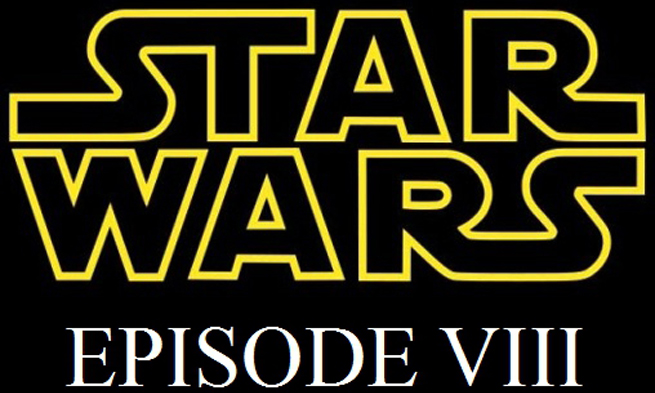
Arriving early on Digital HD April 1, 2016
Bring it home on Blu-ray™ Combo Pack and DVD on April 5, 2016
Including new in-depth bonus offering fans the chance to experience more
Star Wars: The Force Awakens is coming to Video On Demand on April 1, 2016 and Blu-Ray and DVD on April 5, 2016. It is also coming to Disney Movies Anywhere, which allows you to redeem a code and access the digital movie on iTunes, Vudu, Amazon, Google, and Microsoft Web Services.
More, there will be several retailer exclusives for The Force Awakens. Pre-orders are up now — click the store name to go to the pre-order page.
- TARGET – The Target Star Wars: The Force Awakens Blu-ray Combo Pack comes with exclusive packaging and an added 20 minutes of bonus content, including never-before-seen interviews with Daisy Ridley and John Boyega and a deeper look at the movie’s costumes and weaponry
- WALMART – The Walmart Star Wars: The Force Awakens Blu-ray Combo Pack comes with exclusive BB-8 packaging and an exclusive Star Wars Galactic Connexions trading disc
- BEST BUY – The Best Buy Star Wars: The Force Awakens Blu-ray Combo Pack features exclusive SteelBook Packaging

The full press release is below:
BURBANK, Calif. (March 3, 2016)—Star Wars: The Force Awakens shattered box office records upon its debut to become the cinematic event of a generation with over $926 million domestic and $2.05 billion worldwide. As announced this morning by Chairman and Chief Executive Officer Robert A. Iger at The Walt Disney Company’s Annual Meeting of Shareholders, the epic movie will be available to own early on Digital HD and Disney Movies Anywhere on April 1, and coming home on Blu-ray Combo Pack and DVD on April 5.
Discover the complete story behind the making of Star Wars: The Force Awakens with in-depth documentary and bonus material that will take fans on an exciting journey behind the scenes. Secrets will be revealed through extensive footage, never-before-seen deleted scenes, and exclusive interviews with the actors and filmmakers. Bonus features include*:
- Secrets of The Force Awakens: A Cinematic Journey – For the first time, discover the complete story behind the making of The Force Awakens, revealed through in-depth footage and exclusive interviews with the actors and filmmakers in this feature documentary.
- The Story Awakens: The Table Read – Cast members familiar and new reflect on the memorable day they all first came together to read the movie’s script.
- Building BB-8 – See how the filmmakers brought the newest droid to the screen, creating an instant fan favorite in the Star Wars
- Crafting Creatures – Watch movie magic as the filmmakers bring a cast of new creatures to life.
- Blueprint of a Battle: The Snow Fight – Go deeper into the epic, climactic lightsaber battle between Rey and Kylo Ren.
- John Williams: The Seventh Symphony – The legendary composer shares personal insights of his work on Star Wars and The Force Awakens.
- ILM: The Visual Magic of The Force – An insider’s look into the remarkable digital artistry of the movie’s visual effects.
- Force For Change – Heroes come in all shapes and sizes. See how the Star Wars: Force for Change initiative has united Star Wars fans all over the globe to help others.
- Plus Deleted Scenes
* Digital bonus offerings may vary by retailer
Star Wars: The Force Awakens saw the eagerly anticipated reteaming of original Star Wars stars Harrison Ford, Carrie Fisher, and Mark Hamill, along with Anthony Daniels, the only actor to have been in all seven Star Wars films, and Peter Mayhew. The returning cast was joined by newcomer Daisy Ridley, who beat out fierce competition to take the principal role of Rey; BAFTA Rising Star Award winner John Boyega (Attack the Block, Imperial Dreams) as reluctant stormtrooper Finn; Emmy® nominee Adam Driver (Lincoln, Girls) as the villainous Kylo Ren, and Golden Globe® winner Oscar Isaac (Inside Llewyn Davis, The Bourne Legacy) as Resistance pilot Poe Dameron.
Star Wars: The Force Awakens was directed by J.J. Abrams and written by Lawrence Kasdan & J.J. Abrams and Michael Arndt. Lucasfilm president and eight-time Academy Award® nominee Kathleen Kennedy and J.J. Abrams, along with his longtime producing partner Bryan Burk, are the film’s producers.
Having established a musical legacy with his iconic scores for the previous six films in the Star Wars Saga, acclaimed composer John Williams returned to score Star Wars: The Force Awakens, ultimately garnering his 50th Oscar® nomination for it.
DISC SPECIFICATIONS:
FEATURE RUN TIME: Approximately 136 min.
RATING: PG-13 in U.S.; PG in CE; G in CF
ASPECT RATIO: Blu-ray Feature Film = 2.40:1
DVD Feature Film = 2.40:1
AUDIO: Blu-ray = English 7.1 DTS-HDMA, English 2.0 Descriptive Audio, French and Spanish 5.1 Dolby Digital Language Tracks
DVD = English, French and Spanish 5.1 Dolby Digital, English 2.0 Descriptive Audio Language Tracks
LANGUAGES: English, French & Spanish
SUBTITLES: English SDH, French & Spanish
SOCIAL MEDIA:
Facebook: http://www.facebook.com/StarWarsMovies
Twitter: https://twitter.com/StarWars
Website: http://www.starwars.com/the-force-awakens/
Instagram: http://instagram.com/StarWarsMovies
ABOUT STAR WARS: THE FORCE AWAKENS:
Lucasfilm and visionary director J.J. Abrams join forces to take you back again to a galaxy far, far away as Star Wars returns to the big screen with Star Wars: The Force Awakens. The film stars Harrison Ford, Mark Hamill, Carrie Fisher, Adam Driver, Daisy Ridley, John Boyega, Oscar Isaac, Lupita Nyong’o, Andy Serkis, Domhnall Gleeson, Anthony Daniels, Peter Mayhew and Max Von Sydow. Kathleen Kennedy, J.J. Abrams and Bryan Burk are producing with Tommy Harper and Jason McGatlin serving as executive producers. The screenplay is written by Lawrence Kasdan & J.J. Abrams and Michael Arndt.
ABOUT LUCASFILM LTD.
Lucasfilm Ltd., a wholly-owned subsidiary of The Walt Disney Company, is a global leader in film, television and digital entertainment production. In addition to its motion-picture and television production, the company’s activities include visual effects and audio post-production, cutting-edge digital animation, interactive entertainment software, and the management of the global merchandising activities for its entertainment properties including the legendary STAR WARS and INDIANA JONES franchises. Lucasfilm Ltd. is headquartered in northern California.
Lucasfilm, the Lucasfilm logo, STAR WARS and related properties are trademarks and/or copyrights, in the United States and other countries, of Lucasfilm Ltd. and/or its affiliates. © & TM 2015 Lucasfilm Ltd. All rights reserved.
…/3
ABOUT DISNEY MOVIES ANYWHERE (DMA):
Disney Movies Anywhere (DMA) is an engaging and family-friendly cloud-based digital movie service that makes it simple to buy your favorite Disney, Pixar, Marvel and Star Wars movies once and watch them anywhere. With DMA you can explore Disney’s library of over 450 eligible digital movies, discover hours of new and exclusive short-form content, and watch your digital movies from the comfort of the living room or across multiple mobile devices. Using the free DMA apps and website, you can connect your DMA account with participating providers including iTunes, Amazon Video, VUDU, Microsoft Movies and TV and Google Play and unlock access to your eligible movie collections across platforms and devices – iPhone, iPad, iPod Touch, Apple TV/Airplay, Amazon’s Fire tablets, Fire TV and Fire TV Stick, Microsoft Movies and TV service on Windows and Microsoft Xbox devices, Android mobile and tablet devices and Android TV, Chromecast and the Roku® platform. In addition, you can redeem Digital Copy codes found in Disney, Pixar and Marvel Blu-rays and DVDs, as well as earn Disney Movie Rewards points with every digital purchase.
ABOUT THE WALT DISNEY STUDIOS:
For over 90 years, The Walt Disney Studios has been the foundation on which The Walt Disney Company was built. Today, the Studio brings quality movies, music and stage plays to consumers throughout the world. Feature films are released under the following banners: Disney, including Walt Disney Animation Studios and Pixar Animation Studios; Disneynature; Marvel Studios; Lucasfilm; and Touchstone Pictures, the banner under which live-action films from DreamWorks Studios are distributed. The Disney Music Group encompasses the Walt Disney Records and Hollywood Records labels, as well as Disney Music Publishing. The Disney Theatrical Group produces and licenses live events, including Disney on Broadway, Disney On Ice and Disney Live!.
# # #
STAR WARS and related properties are trademarks and/or copyrights, in the United States and other countries, of Lucasfilm Ltd. and/or its affiliates.© & TM Lucasfilm Ltd.
IN-HOME MEDIA CONTACTS:
NATIONAL: Maria Barraza REGIONAL: Gabrielle Bilicki
Maria.Barraza@Disney.com Gabrielle.Bilicki@Disney.com
818-560-4068 818-560-4069
March 3, 2016 Posted by Arnie C | Movies, News, Star Wars | Blu-ray, Disney, DVD, Movie, Movies, News, Now Playing, Pre-Order, Press Release, sci-fi, Star Wars, Star Wars Action News, The Force Awakens, VOD | Comments Off on Star Wars: The Force Awakens on Digital HD April 1, Blu-Ray April 5. Exclusive editions Announced!
Pre-Order Alert: Drax the Destroyer from Hot Toys
I like your figure. I’m keeping it.
Two years ago Hot Toys released their Guardians of the Galaxy figures. Star-Lord, Gamora, Rocket Raccoon, and Drax were put up for pre-order shortly after the film’s 2014 release…but the question remained “Where’s Drax?” He was shown at San Diego Comic-Con in 2014, but no orders were available, and questions to Hot Toys went unanswered.
People started to fear Drax would never come, put in the same category as the X-Men: First Class Magneto and Charles Xavier, and a handful of other never-released figures (Amazing Spider-Man 2’s Rhino will hopefully be added to that list).
But now Guardians fans can stop worrying! The Drax MMS Sixth Scale figure is now up for order!
The movie-accurate Drax collectible figure is specially crafted based on the image of Dave Bautista in the film, featuring the newly developed head sculpt, a newly developed muscular body with detailed sculpture of the character’s iconic tattoos, two styles of interchangeable pants, two blades, a rocket launcher, and a Guardians of the Galaxy themed figure stand.
Guardians of the Galaxy fans, don’t let the chance to own this collectible figure fly over your head.
The full specs for the piece are:
Hot Toys – MMS355 – Guardians of the Galaxy 1/6th scale Drax Collectible Figure Specification
~ Movie Masterpiece Series ~
The 1/6th scale Drax Collectible Figure specially features:
- – Newly developed head sculpt with authentic and detailed likeness of Dave Bautista as Drax the Destroyer in Guardians of the Galaxy
- – Highly detailed facial expression with wrinkles, and tattoos
- – Newly developed muscular body with over 26 points of articulations and detailed sculpture of the character’s distinctive tattoos
- – Specially applied painting on skin and tattoos
- – Approximately 32 cm tall
- – Seven (7) pieces of interchangeable hands including:
- – One (1) pair of fists
- – One (1) pair of hands for holding blades
- – One (1) pair of open hands
- – One (1) right hand for holding rocket launcher
- – Each piece of head sculpt is specially hand-painted
Costume:
- – One (1) pair of dark gray pants with detailed patterns
- – One (1) pair of interchangeable red colored Ravagers pants with detailed patterns
- – One (1) pair of black boots with blade sheath
Weapons:
- – One (1) rocket launcher
- – Two (2) blades
Accessory:
- – Specially designed figure stand with Drax nameplate and the movie logo
So what are you waiting for? You! Man who has lain with an Askervarian! Get to Sideshow’s site and order now!
March 1, 2016 Posted by arniec | Comic Books, Movies, News | Avengers, Collecting, Comic Books, Comics, Drax, Enertainment, Film, Guardians of the Galaxy, Hot Toys, Iron Man, Marvel, Marvel Comics, Marvelicious Toys, Movie, Movies, Now Playing, Pre-Order, Sideshow Collectibles, Toys | Comments Off on Pre-Order Alert: Drax the Destroyer from Hot Toys
THE HATEFUL EIGHT Arriving on Blu-ray Combo Pack, DVD and On Demand March 29, 2016
| Quentin Tarantino’s Academy Award Nominated THE HATEFUL EIGHT is now up for pre-order! Get details about this release below:
BEVERLY HILLS, CA (February 17, 2016) – Anchor Bay Entertainment and The Weinstein Company are proud to present the home entertainment release of the eighth film by two-time Academy Award® winner Quentin Tarantino (Django Unchained, Pulp Fiction). Shot entirely on 70mm and featuring a Golden Globe® and BAFTA® award-winning score by Oscar® winner Ennio Morricone (Bugsy, The Mission) THE HATEFUL EIGHT “absolutely delivers on the sheer moment-to-moment pleasures fans have come to expect — from dynamite dialogue to powder-keg confrontations,” Peter Debruge, Variety.An explosive frontier mystery about eight strangers with one deadly connection, THE HATEFUL EIGHT will be available for digital download on March15, 2016 from Starz Digital before heading to retail on Blu-ray™ Combo Pack ($39.99 SRP) and DVD ($29.98 SRP) from Anchor Bay Entertainment and On Demand March 29, 2016. Special features for THE HATEFUL EIGHT include two featurettes – “Beyond the Eight: A Behind-the-Scenes Look” and “Sam Jackson’s Guide to Glorious 70mm.”
Ultra Panavision 70 is the very rare and exceptional format that Quentin Tarantino and his team used to shoot THE HATEFUL EIGHT, the widest 70mm theatrical release in twenty years. Panavision’s unique anamorphic camera lenses capture images on film in an incredible aspect ratio of 2.76:1. Almost all films seen today are shot in ratios of either 1.85:1 or 2.39:1. Simply put, Ultra Panavision 70 provides an amazingly wide and more detailed image. THE HATEFUL EIGHT marks the triumphant return to the genre for legendary composer Morricone (The Good, The Bad and the Ugly, A Fistful of Dollars). Nominated for an Academy Award® for Best Original Score, Morricone is back in the saddle after nearly four decades since last scoring a full-length Western. Additional Academy Award® nominations include 3-time Oscar® winner Robert Richardson for Best Cinematography and Jennifer Jason Leigh for Best Actress in a Supporting Role. THE HATEFUL EIGHT’s notorious all-star cast also boasts Oscar® nominees Samuel L. Jackson (Pulp Fiction), Kurt Russell (Silkwood), Emmy® nominee Walton Goggins (TV’s Justified), Demian Bichir (A Better Life) and Tim Roth (Rob Roy). In THE HATEFUL EIGHT, set six or eight or twelve years after the Civil War, a stagecoach hurtles through the wintry Wyoming landscape. The passengers, bounty hunter John Ruth (Kurt Russell) and his fugitive Daisy Domergue (Jennifer Jason Leigh), race towards the town of Red Rock where Ruth, known in those parts as “The Hangman,” will bring Domergue to justice. Along the road, they encounter two strangers: Major Marquis Warren (Samuel L. Jackson), a black former union soldier turned infamous bounty hunter, and Chris Mannix (Walton Goggins), a southern renegade who claims to be the town’s new Sheriff. Losing their lead on the blizzard, Ruth, Domergue, Warren and Mannix seek refuge at Minnie’s Haberdashery, a stagecoach stopover on a mountain pass. When they arrive at Minnie’s, they are greeted not by the proprietor but by four unfamiliar faces. Bob (Demian Bichir), who’s taking care of Minnie’s while she’s visiting her mother, is holed up with Oswaldo Mobray (Tim Roth), the hangman of Red Rock, cow-puncher Joe Gage (Michael Madsen), and Confederate General Sanford Smithers (Bruce Dern). As the storm overtakes the mountainside stopover, our eight travelers come to learn they may not make it to Red Rock after all… |
February 18, 2016 Posted by Arnie C | Movies, News | Blu-ray, DVD, Film, Hateful Eight, Movie, Movies, News, Now Playing, Now Playing Podcast, Pre-Order, Press Release, Quentin Tarantino, Samuel L Jackson | Comments Off on THE HATEFUL EIGHT Arriving on Blu-ray Combo Pack, DVD and On Demand March 29, 2016
Star Wars Episode VIII Release Date Pushed Back
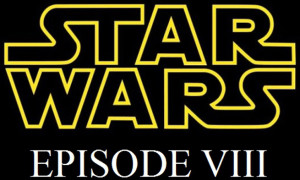 Lucasfilm has announced that Star Wars Episode VIII has been delayed.
Lucasfilm has announced that Star Wars Episode VIII has been delayed.
Originally scheduled to open May 26, 2017, the new release date is December 15, 2017.
The full press release is below.
Is this an attempt to recreate the nearly $2 billion earned by Episode VII: The Force Awakens? Does Disney not want Star Wars to compete with their other profitable space series — Guardians of the Galaxy? (Guardians of the Galaxy Vol. 2 opens May 5, 2017.) Or did director Rian Johnson need more time to finish the film?
Let us know your thoughts in the comments!
Star Wars: Episode VIII to Open December 15, 2017
The release date for the next film in the saga is confirmed.
Today, Disney and Lucasfilm announced that Star Wars: Episode VIII, originally scheduled for release in summer 2017, will now debut on December 15, 2017.
The move follows the extraordinary success of Star Wars: The Force Awakens, which was the first Star Wars movie to premiere outside the traditional summer blockbuster window and smashed numerous records, including biggest domestic and global debuts of all time as well as the biggest domestic second and third weekends, en route to becoming the highest grossing domestic release of all time with over $861.3 million and the third biggest global release ever with $1,886.7 billion.
Written and directed by Rian Johnson, Star Wars: Episode VIII is currently in preproduction and will begin principal photography in London next month. Kathleen Kennedy and Ram Bergman will produce and J.J. Abrams, Jason McGatlin, and Tom Karnowski will executive produce. Stay tuned for exciting updates in the coming weeks.
January 20, 2016 Posted by Arnie C | Movies, Star Wars | Action, Enertainment, Episode VIII, Film, George Lucas, Movie, Movies, News, Now Playing, Now Playing Podcast, Press Release, Rian Johnson, sci-fi, Star Wars, Star Wars Action News | Comments Off on Star Wars Episode VIII Release Date Pushed Back
Pre-Order Alert: Hot Toys Die Cast War Machine (from Iron Man 2)
You have a big gun. You are not “the” big gun.
Tony Stark loves upgrades, having gone through 45 suits of armor in 7 years. And Hot Toys seems to be following suit as they continue their upgrades of armored figures from the first two Iron Man movies. Next up we get a new entry in Hot Toys’ MMS Diecast Series — War Machine. And it’s up for order now!
The original War Machine in Iron Man 2 was one of the most iconic Iron Man suits of all time! Its heavily weaponized configuration and powerful militaristic design are beloved by many fans worldwide. This new movie-accurate collectible figure representing this suit is made of diecast material, and crafted with amazing details that astonish fans with its high level of authenticity!
The over 32cm tall diecast figure has a wide range of features including a newly developed helmeted head sculpt of James Rhodes featuring likeness of Don Cheadle, interchangeable LED light-up helmet, movie-accurate proportion and detailed armor design, metallic black and silver colored armor, interchangeable battle damaged armor parts on head, shoulder, chest, and back, articulated back-mounted machine gun, interchangeable battle damaged back-mounted machine gun barrel, hidden compartments on shoulders to reveal weapons, LED light-up functions, and a specially designed diorama figure stand based on the final showdown with Whiplash Mark II in Iron Man 2.
Don’t miss the chance to add this iconic and heavily armed War Machine to your Iron Man collection!
Hot Toys – MMS 331D13 – Iron Man 2 1/6th scale War Machine Collectible Figure Specification ~ Movie Masterpiece Series Diecast ~
The 1/6th scale War Machine Collectible Figure specially features:
– Authentic and detailed likeness as War Machine in Iron Man 2
– Newly developed helmeted head sculpt with authentic likeness of Don Cheadle as James Rhodes
– Interchangeable helmeted head with LED light-up function (white light with red lens, battery operated)
– Movie-accurate proportion and highly detailed armor design
– Metallic black and silver colored armor
– Approximately 32.6 cm tall
– Two styles of interchangeable face masks (normal and battle damaged)
– Two styles of interchangeable right shoulder armor (normal and battle damaged)
– Two styles of removable chest armor (normal and battle damaged)
– Two styles of interchangeable articulated back boosters (normal and battle damaged)
– Two styles of interchangeable shoulder blade armor (normal and battle damaged)
– Chest armor can be removed to reveal interior mechanical design
– Shin armor parts can be detached to reveal interior mechanical design
– Over 30 points of articulations
– Contains diecast material
– LED lighted Arc Reactor on chest (white light, battery operated)
– Six (6) pieces of interchangeable palms including:
– One (1) pair of fists
– One (1) pair of palms with articulated fingers and light-up repulsors (white light, battery operated)
– One (1) pair of repulsor firing palms (white light, battery operated)
– Improved articulations on waist armor which allow flexible movement
– Each piece of head sculpt is specially hand-painted
Weapons:
– One (1) articulated back-mounted machine gun
– One (1) interchangeable battle damaged back-mounted machine gun barrel
– Hidden compartment can reveal detachable “Ex-Wife” rocket on left shoulder
– Hidden compartment can reveal mini missiles on right shoulder
– Sub-machine guns mounted on the arms
Accessory:
– Specially-designed diorama figure base
December 9, 2015 Posted by Arnie C | Comic Books, Movies, News | Avengers, Collecting, Comic Books, Comics, Die Cast, Enertainment, Film, Hot Toys, Iron Man, Marvel, Marvel Comics, Marvelicious Toys, Movie, Movies, Now Playing, Now Playing Podcast, Pre-Order, Press Release, sci-fi, Sideshow Collectibles, Toys, War Machine | Comments Off on Pre-Order Alert: Hot Toys Die Cast War Machine (from Iron Man 2)
Star Wars Action News and Marvelicious Toys to Host Wizard World Bash in Chicago
Star Wars Action News and Marvelicious Toys are hosting a party Aug. 22 at Wizard World Chicago — and you’re invited!
A long time ago… August 30, 2005, to be specific… Venganza Media, Inc. launched Star Wars Action News, the world’s first podcast dedicated to Star Wars collecting. In 2010 Venganza then began Marvelicious Toys, focusing on the toys, statues, and games based on the characters from the Marvel comics and movies.
Over the past 10 years both shows have evolved from podcasting pioneers to a major force in the industry and the collecting community, even producing the official podcast for Master Replicas, a Star Wars and Marvel licensee.
On Saturday, Aug. 22, fans are invited to join Star Wars Action News, Marvelicious Toys, and Now Playing Podcast hosts Arnie, Marjorie, Brock, Justin, Jerry, Daryl, Andrew, and more at the Star Wars Action News 10th anniversary bash during Wizard World Chicago. The party, also celebrating Marvelicious Toys’ 5th anniversary, will be hosted by the Hyatt Regency O’Hare. The event begins at 7:30 p.m., and will feature door prizes, appetizers, cake, and a cash bar.
Tickets are priced at $15 for children 12 and under, and $25-$75 for adults. Adult tickets include bonus exclusive collectibles ranging from T-shirts to the exclusive Star Wars Action News badge and lanyard, plus a collectible coin previously only available to those who work on the show.
In addition, all adult tickets enter you in the drawing for a huge selection of door prizes. Items have been provided by DorksideToys.com, Big Bad Toy Store, Kotobukiya, Hallmark, Venganza Media, and many more. Attendees can win items ranging from a Deadpool statue to entire waves of Star Wars figures, and more!
Get your tickets now and follow coverage of these milestones at VenganzaMedia.com and its affiliated podcasts!
About Venganza Media Inc.
Based in Springfield, Ill., Venganza Media Inc. is a multimedia production facility and home to the Venganza Media Podcasting Network.
Film fans and collectors worldwide know Venganza as the producer of Books & Nachos, Star Wars Action News, Marvelicious Toys, and the iTunes Top 10 movie review podcast Now Playing.
Since its formation in 2005, Venganza has delivered thousands of hours of entertainment to listeners, while its staff and fleet of contributors have established the company as a premier source for film reviews, celebrity interviews, and collecting news for audiences of all ages.
July 30, 2015 Posted by Arnie C | Comic Books, Conventions, Movies, News, Star Wars | Big Bad Toy Store, Books & Nachos, Collecting, Comic Books, Comics, DorksideToys, Entertainment, Film, Marvelicious Toys, Movie, News, Now Playing, Party, Press Release, sci-fi, Star Wars, Star Wars Action News, Venganza Media, Wizard World Chicago, Wizard World Conventions | Comments Off on Star Wars Action News and Marvelicious Toys to Host Wizard World Bash in Chicago
Avengers: Age of Ultron coming to Blu-Ray Oct 2
MARVEL’S AVENGERS: AGE OF ULTRON
GET IT EARLY ON DIGITAL 3D, DIGITAL HD
AND DISNEY MOVIES ANYWHERE September 8, 2015
AVAILABLE ON 3D BLU-RAY™ COMBO PACK, BLU-RAY, DVD, DIGITAL SD AND
ON-DEMAND October 2, 2015
Includes Never-Before-Seen Deleted Scenes, Making-of Featurettes, Gag Reel and Audio Commentary
Marvel Studios reunites Earth’s Mightiest Heroes in the unprecedented movie event, Marvel’s Avengers: Age of Ultron. Iconic heroes are forced to reassemble and face their most intimidating enemy yet – ULTRON. Pushed to the brink of their physical and emotional limits, the team must recruit both new heroes and familiar allies to face an escalating danger that threatens the entire planet.
RELEASE DATES: September 8, 2015 for Digital 3D and Digital HD
October 2, 2015 for Digital SD, 3D Blu-ray Combo Pack (3D Blu-ray+Single Disc Blu-ray+Digital Copy), Blu-ray, DVD and On-Demand
BONUS: Digital HD*, Disney Movies Anywhere (DMA), 3D Blu-ray Combo Pack, Blu-ray
- Never-Before-Seen Deleted Scenes
- Making-of Featurettes
- Gag Reel
- Audio Commentary
*Digital bonus offerings may vary by retailer
DVD:
- Making-of Featurette
FEATURE RUN TIME: Approximately 141 min.
RATINGS: PG-13 in U.S.; PG in CE; G in CF
ASPECT RATIO: Blu-ray 3D, Blu-ray & DVD = 1080p High Definition / 2.40:1
AUDIO: Blu-ray 3D & Blu-ray 2D = English 7.1 DTS-HDMA, French-Canadian 5.1 Dolby Digital, Latin Spanish 5.1 Dolby Digital, English DVS 2.0 Dolby Digital
DVD = English/Latin Spanish/French Canadian 5.1 Dolby Digital, English DVS 2.0 Dolby Digital
LANGUAGES: U.S.: English & Spanish
Canada: English, French
SUBTITLES: English, French & Spanish
July 24, 2015 Posted by Arnie C | Comic Books, Movies, News | Action, Avengers, Captain America, Comic Books, Comics, Enertainment, Film, Hulk, Incredible Hulk, Iron Man, Marvel, Marvel Comics, Marvelicious Toys, Movie, Movies, News, Now Playing, Now Playing Podcast, Pre-Order, Press Release, sci-fi | Comments Off on Avengers: Age of Ultron coming to Blu-Ray Oct 2
Now Playing plots holiday heist with ‘Ocean’s’ crew
Now Playing Podcast is ringing in the New Year Rat Pack-style, and listeners can join the caper as hosts Jakob, Stuart, and Arnie cap 2014 with reviews of the original Ocean’s Eleven and the George Clooney-led Ocean’s Trilogy.
The lighthearted series is a shift for the heavily horror, sci-fi and superhero-focused show. You’d have to go all the way back to December 2011’s Rocky series to find a Now Playing retrospective without tights, gunfights or gore (except for this part).
The hosts, who spent the better part of 2014 laboring through adaptations of Stephen King’s Night Shift stories, took some time out from recording to chat about their expectations for this A-list franchise.
Q: These movies were hard to miss, what are your Ocean’s memories?
Stuart: I have only seen the first George Clooney movie, and my memory of it is vague but pleasant. I tend to like series’ with a long history to them.
Jakob: I’ve actually seen that first one a handful of times and I remember almost nothing of [Ocean’s] Twelve. I can only hope the sequels have that party vibe of Ocean’s Eleven. That’s why we decided to transition from 2014 to 2015 with these films. Everyone wants to ring in the New Year with a great party.
Stuart: I look forward to seeing the Rat Pack define the Vegas of 1960, before the town and the franchise become more of a theme park attraction with the contemporary films.
Q: Arnie, did your recent trip to Las Vegas stir Ocean’s memories?
Arnie: I actually stayed at the Bellagio, and while I didn’t encounter Terry Benedict, I did get to watch the fountain show — with Ocean’s well on my mind. I was itching to re-watch the series after that trip.
Strangely the best Vegas connection I had wasn’t from the Ocean’s series, but from The Stand. The crucifixion scene was filmed on Fremont Street in Vegas and some of the signage was very familiar!
Q: Jakob, has there been any talk of starting a “Rat Pack Retrospective”?
Jakob: There wasn’t any talk previous to the decision to cover the original Ocean’s Eleven. Whether we are open to it now? Well, I don’t want to spoil how we feel about the film.
Having covered Sinatra previously in The Detective to kick off our Die Hard series, listener feedback wasn’t great for going back to older films. But I never want to say we absolutely won’t do a series. Maybe we’ll have a “Rat Pack Retrospective” hosted by all of our fathers.
Q: Stuart, after sitting through Children of the Corn and Leprechaun, are you relieved to take a break from horror for the holidays?
Stuart: There were longer franchise options discussed – the four Gingerdead Man films might have fit nicely under the tree in a different year. But I’m not sure anyone was eager to unwrap anymore low-rent slasher flicks.
I like that we’re getting more into the spirit of New Year’s Eve with Ocean’s Eleven. We hope that listeners are feeling festive too, and won’t mind saving Santa’s Slay or You Better Watch Out for another time.
The 4-film Ocean’s retrospective begins December 16, following the 2-part Maniac series. At the same time, the Now Playing Podcast Fall Pledge Drive will continue on a separate feed, where donors can hear reviews of the Peter Jackson Hobbit films.
November 19, 2014 Posted by Jason Latham | Uncategorized | Frank Sinatra, George Clooney, Now Playing, Now Playing Podcast, Ocean's Eleven, Ocean's Thirteen, Ocean's Twelve, Rat Pack, Steven Soderbergh, The Detective | Comments Off on Now Playing plots holiday heist with ‘Ocean’s’ crew
Black Panther, Captain Marvel, Thor 3, Avengers 3 and 4 Announced by Marvel Studios
In a move worthy of Apple, Marvel Studios held a presentation today unveiling its third phase of films based on the characters from Marvel Comics.
While several expected titles were told, many surprises were there as well.
With this announcement, the current slate of movies from Marvel Studios are:
May 1, 2015
Avengers: Age of Ultron. Director: Joss Whedon.
Starring: Robert Downey, Jrl, Chris Evans, Chris Hemsworth, Mark Ruffalo, Scarlett Johansson, Jeremy Renner, Samuel L. Jackson, Cobie Smulders, James Spader, Elizabeth Olsen, Aaron Taylor-Johnson, Paul Bettany, Don Cheadle, Hayley Atwell, Andy Serkis
View the trailer below:
July 27, 2015
Ant-Man
Director: Peyton Reed
Starring: Paul Rudd, Michael Douglas, Evangeline Lilly
May 6, 2016
Captain America: Civil War
Director: Anthony Russo, Joe Russo
Starring: Chris Evans, Robert Downey Jr., Chadwick Boseman
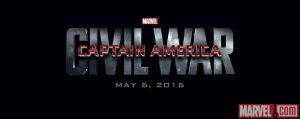
November 4, 2016
Doctor Strange
Director: Scott Derrickson
Starring: Benedict Cumberbatch (rumored)
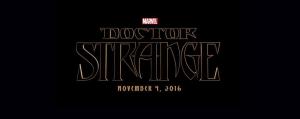
May 5, 2017
Guardians of the Galaxy
Director: James Gunn
Starring: Chris Pratt, Zoe Saldana, Dave Bautista, Vin Diesel, Bradley Cooper (all rumored)
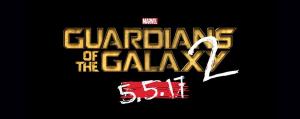
July 28, 2017
Thor: Ragnarok
Director: ???
Starring: Chris Hemsworth, Tom Hiddleston (rumored)
November 3, 2017
Black Panther
Director: ???
Starring: Chadwick Boseman
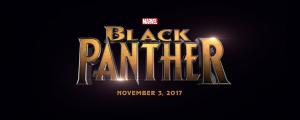
May 4, 2018
Avengers: Infinity War Part 1
Director: ???
Starring: ???

July 6, 2018
Captain Marvel
Director: ???
Starring: ???
November 2, 2018
Inhumans
Director: ???
Starring: ???
May 4, 2018
Avengers: Infinity War Part 2
Director: ???
Starring: ???

These titles bring back many established heroes while bringing in new ones and meeting the call for diversity among superhero films (a female-led film and a superhero film starring a black man). Conspicuous by their absence are any additional Iron Man films, as well as any films featuring popular Avengers heroes Hulk or Black Widow.
How do you feel about this line-up of movies over the next five years? Let us know in the comments below!
October 28, 2014 Posted by Arnie C | Comic Books, Movies, News | Action, Avengers, Black Panther, Captain America, Captain Marvel, Civil War, Comic Books, Comics, Entertainment, Film, Inhumans, Marvel Studios, Marvelicious Toys, Marvelicious Toys Podcast, Movies, News, Now Playing, Now Playing Podcast, Podcasts, sci-fi | 1 Comment
The 40 Year-Old-Critic: Before Midnight (2013)
In The 40-Year-Old Critic, Venganza Media creator and host Arnie Carvalho recalls a memorable film for each year of his life. This series appears daily on the Venganza Media Gazette.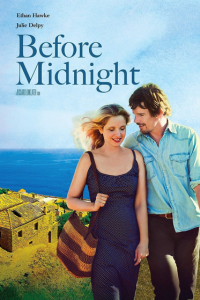
I described yesterday my fear of watching This Is 40 — fear of a movie that may make me examine my own life in uncomfortable ways. I never expected the film I really should have been nervous of was one I raced to opening weekend; Richard Linklater’s Before Midnight, the third film in his Before series.
I first saw Before Sunrise in the mid-90s. I had discovered indie director Linklater with his mainstream 1993 hit Dazed and Confused. I considered that film to be the American Graffiti for Generation X. Both films were period pieces that spoke as much to the trials of teens in the present day as they did in the times in which they were set. Both films also focused on the period rock to help advance the story and the mood. After Dazed, Linklater became a director I wanted to follow.
More than just the director, I was also drawn to Sunrise by its male lead, Ethan Hawke, an actor I enjoyed seeing in Dead Poets Society and, more recently at the time of Sunrise‘s release, Reality Bites.
Finally, the genre seemed up my alley — the romantic comedy. From the trailers Sunrise seemed like another Reality Bites or Singles — Jesse (Hawke) was an American 20-something traveling through Europe. On a train ride he meets Céline (Julie Delpy), a blonde French beauty. The two have one night together in Vienna before Jesse returns to the United States.
When I saw the film I was surprised that it was far more of a romance film than a comedy, but also a tender and moving one. Few films made me feel I was watching an honest romance. Hawke and Delpy sold their attraction and affection for each other. Though they had only one night together, the two had laughs, arguments, and an honest connection. They fell in love with each other, and I fell in love with their relationship.
It was a great film, but not one I ever expected to have a sequel. It simply wasn’t the genre of film that spawned sequels. I would revisit Before Sunrise regularly in the 90s but never expected to see the characters again. I knew that Delpy, Hawke, and Linklater always teased the thought of returning to Jesse and Céline, but I just didn’t believe it would happen. As such I was utterly stunned in 2003 when I read the trio was reteaming for Before Sunset. This time the film was written by Linklater as well as Hawke and Delphy — the actors were helping shape the story of their characters. That was a major change from the original and showed that the director and stars were creating something truly unique and special.
Before Sunset told of Jesse and Céline meeting up again for the first time in 9 years. I was excited to see the film; I felt like Linklater was giving me a mini-college reunion — my own chance to catch up with two people I fondly remembered from the 90s.
When the film came out in limited release I was concerned it wouldn’t open in Springfield. As such Marjorie and I drove 8 hours round trip to see the movie in Chicago; it meant that much to me (ironically it opened in our town about two months later). I really enjoyed the sequel, though it had a totally different vibe than the original. Now in their 30s, the two have followed different paths; Jesse is married with a son, adding a complication and moral complexity to the prospect of a rekindled romance. Like most reunions, it was good to see these friends again, but we had grown apart a bit, and I didn’t feel as strongly about them as I did in the 90s.
But the door had been opened, and when Before Sunset came out Linklater, Delpy, and Hawke said they may return to these characters every nine years and check in on them. I wouldn’t have been shocked if a third film never came, but I equally wasn’t surprised when the third film, Before Midnight, was announced.
Now it was time for the cinematic equivalent of my 20th college reunion — it was time to see Céline and Jesse again. I was a bit concerned. Trailers let me know that the two characters had been together for the past nine years. While Linklater was a director I trusted, it seemed like a totally different concept than the previous two films. It felt like we had captured the characters’ every moment together on film, but in the years between Before Sunset and Before Midnight Jesse had left his wife and moved to Europe to be with Céline; they were now married and had twin girls. Could the film carry the same emotional resonance now that we were getting a “day in the life” type of story instead of seeing their only encounter?
My concerns were secondary, though; I saw Linklater, Hawke, and Delpy again teamed to find these characters’ stories, and so Before Midnight was my only must-see film in 2013 that wasn’t reviewed for Now Playing Podcast (though we came really close; I championed it, Stuart also wanted to, but it didn’t fit the schedule). This time there was no question Before Midnight would play in Springfield, and Marjorie and I went opening weekend. I sat down and watched the best film I would see all year.
Before Midnight never feels rushed. Though Linklater needs to catch us up on the nine years of history between our characters, the movie starts with a long scene of Jesse and Hank, his son from his previous marriage. After spending time with Céline and Jesse in Greece he was returning home to his mother. Jesse’s desire to be a good father is at odds with his current marriage — he’d like to move back to the states and be closer to his son.
When we again meet Céline and their twin daughters Ella and Nina we see a happy family, at least on the surface. With Jesse back, the four are taking a road trip for a weekend vacation at a house in the country. On the way the strains start to show as Céline starts discussing her dislike for her career and desire to change jobs though it would greatly impact their family.
But once we reach the country house and are introduced to Jesse and Céline’s various friends the theme of this movie became clear: it’s an exploration of ideas about love, sex, and commitment. Long conversations are had with middle-aged Céline and Jesse seeing new passion kindled between a twenty-something couple, and an older couple discussing their many years together. These stories tell of love at different stages, but also provide interesting debate on what it means to be in love, and to be committed. Céline and Jesse are committed it seems, and in love we hope, but they now want different things in their lives. In the grand spectrum of life, where does love fall on the priority list? What compromises must be made in order to work the logistics of staying together both emotionally and geographically?
As with the film’s view of love, the movie also changes as time passes. Céline and Jesse are given a romantic night at a hotel; their hosts will watch the girls. Now the film is back on familiar footing, with Jesse and Céline visiting a European locale and having meaningful conversations. Yet the stage has been set, and this time they must address their lives and their next steps.
It doesn’t go well. As couples do, new arguments lead to the trudging up of old dirt; Jesse had an affair while on a book tour, but it was just sex, not love. Meanwhile it’s strongly suggested Céline also cheated, rekindling an old romance. The fight grows bitter, raw, and real. It ends with Julie leaving the hotel room and her husband, saying she doesn’t love him anymore.
The film is dark and brooding. This was the film that I had feared This Is 40 would be; a hard look at middle-age and differing views of marriage and love. More, it is well-balanced. Both characters have made selfish choices and transgressions. Neither character is fully right, nor fully wrong, and, as accusations are made in the midst of a bitter fight, it’s hard to tell even what is fact and what is unsubstantiated accusation. It’s likely due to both lead actors participating in the script that this delicate balance is achieved. Neither character is the “bad guy” — nor is either good. Both are operating from their own points of view, and now they’re realizing their viewpoints don’t match up as they once thought.
This film hit incredibly close to home. Marjorie and I had been together for 13 years, married 11. Those years have been full of happiness, but all lives have hardships and all couples have spats. Watching Jesse and Céline break down in Europe when they realize they each had different ideas of marriage made me reflect. First, Marjorie and I were planning a romantic European vacation just weeks after watching this film — Before Midnight certainly seemed like a cautionary tale to not pick that time to discuss major life-changing decisions.
Marjorie found herself identifying with Céline; not just for the gender but also because Marjorie had a job and employer that made her miserable. Like Céline, Marjorie was looking for a career change, and that type of major decision can have a ripple effect. It did so happen that she interviewed for a new job the day before we flew to Europe, and while it didn’t diminish the fun of our vacation one iota, the question of career choices was discussed often on the trip.
I found myself identifying with Jesse. Sure, he’d made some poor decisions, but he was trying to balance his career with his desire to be a good husband and father. While I have no children, I completely identified with his being pulled in multiple directions. I also saw in Jesse my own artistic nature, but one not as accomplished as I’d like due to compromises and other priorities. I completely felt what Jesse was going through and empathized with him.
Yet what the movie really exposes is that two people can be together and have totally different views of their relationship. While happy and playful on the surface, beneath there could be unknown angst and tension. And it’s not that both parties are sublimating — it’s completely possible one person is miserable while the other is content.
The film led to some great conversations with my wife, ensuring we were indeed on the same page with our lives and not a tangled mess of miscommunication like Jesse and Céline. It was very interesting leaving the theater and cautiously discussing the themes; especially when we each took different sides in the argument. It didn’t, but it could have easily led to an argument between us, and that is how real Before Midnight feels.
In private I continued to ruminate on this film and the ideas it put forth. What is love? How does it change over time? These aren’t just academic discussions; these are the emotions that rule our lives. I love that Linklater, Hawke, and Delpy don’t give definitive answers; they raise viewpoints and it’s up to each individual member of the audience to supply the answers that are true for them.
This film is not the tearing down of what Before Sunrise and Before Sunset — its end message seems to indicate love conquers all, and it seems Céline and Jesse are in love after all.
As am I with my wife. As I write this we are on another romantic getaway for my 40th birthday. And, no, there have not been any fights, no storming out, no near-divorce moments.
But Before Midnight is one of the greatest types of films, one that hits home emotionally. I don’t know if Linklater, Delpy, and Hawke will reteam again in 2022. If they do, I don’t know if Célene and Jesse will still be married, or a divorced couple meeting again. What I know is I’ll be there to see what these characters say about people in the next stage of their lives, and I wonder how it will mirror my own.
Arnie is a movie critic for Now Playing Podcast, a book reviewer for the Books & Nachos podcast, and co-host of the collecting podcasts Star Wars Action News and Marvelicious Toys. You can follow him on Twitter @thearniec
September 12, 2014 Posted by Arnie C | 40-Year-Old Critic, Movies, Reviews | 2010s, Before Midnight, Before Sunrise, Before Sunset, Enertainment, Ethan Hawke, Film, Julie Delpy, Movie, Movies, Now Playing, Now Playing Podcast, Podcasts, Review, Reviews, Richard Linklater | 2 Comments
The 40 Year-Old-Critic: This Is 40 (2012)
In The 40-Year-Old Critic, Venganza Media creator and host Arnie Carvalho recalls a memorable film for each year of his life. This series appears daily on the Venganza Media Gazette.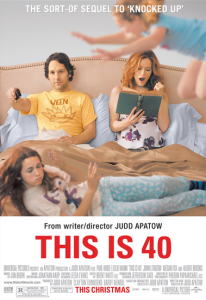
Have you ever wanted to see a movie and yet been afraid to watch it?
It’s an interesting feeling — the allure of a film that should be very good and entertaining, but the anticipation is tainted by fear that I may have an uncomfortable experience. Not that I feel the movie may be bad, but that it could be so good that it makes you a different person after watching it.
As a child I held this fear about many horror movies. From A Nightmare on Elm Street to Hellraiser II, I was scared of what the movie might contain. But as I grew up it wasn’t horror movies that scared me; it was stories about people, and movies that may hold up a mirror and force me to look deep inside myself.
In 2012 the film I feared watching most was This Is 40.
On the surface that may seem absolutely silly. After all, what is there to fear about a comedy, especially a spin off to the easy, breezy stoner sex romp Knocked Up?
The problem lies entirely in coincidence. This is 40 was released in the holiday season of 2012, a time in which those numbers — 4 – 0 — loomed large in my future. This entire review series is a retrospective of my 40 years of watching films, but it ends with me being forced to say, “So… this is 40.”
More, this movie was written and directed by Judd Apatow, best known for his 2005 comedy, The 40-Year-Old Virgin. Though I had watched a few episodes of his TV series Freaks and Geeks, it was through Virgin that I became aware of Apatow’s work.
Clearly he was a funny writer; The 40-Year-Old Virgin had me laughing out loud throughout. But despite being funny and raunchy, there was something about the film that felt real and true. Andy, the sexually-challenged obsessive toy collector played by Steve Carrell, may have been a caricature, but he was also sweet and earnest. By the end of the film he’d gone from wanting sex to wanting true love, and the audience rooted for him. More, his friends all seemed to have more realistic problems; one constantly cheats on his girlfriend, another is obsessed with his ex.
This combination of heart and humor became Apatow’s trademark, and while I didn’t feel his follow-up films Knocked Up and Funny People reached the heights of The 40-Year-Old Virgin, they both were films with a human story surrounded by comedy. Even the films Apatow produced, but didn’t direct or write, often followed that pattern, with Superbad, Forgetting Sarah Marshall, Wanderlust, and The Five-Year Engagement all being character studies as well as comedies.
It was specifically Funny People that made me fear This is 40 the most. That film featured Adam Sandler as a comedian dying of leukemia. While the movie pulled several punches and most of the jokes didn’t hit (like any 21st Century Sandler film), it showed a dramatic weight and had several moments that tugged at the heartstrings and made me contemplate my own death — what would I do if I became terminally ill at a still relatively young age?
Now Apatow was going to set his sights squarely on middle-aged suburbanites. As an Apatow fan I wanted to see the film, but as a man about to turn 40 I feared what I would see.
I have a good life. I love my wife, I have a steady job, we have a nice house, and we travel a lot. Through my podcasts I get to touch the lives of hundreds of thousands of people all over the world, and some of the doors opened by those shows allow me to have experiences many only dream of. I am not unhappy in my life, but any major milestone is a time for reflection. Should I have chased my dreams harder than I did? Should I have become comfortable in my job? Did I compromise too much?
It’s hard to start living a life where you see the clock start ticking the other way, and life starts being gauged by the things you’ll never do instead of the things you’ll do someday. That is being 40 — and I wasn’t sure I wanted to see a movie that would epitomize that experience.
The trailers showed a couple seemingly at a crossroads. The opening scene showed Paul Rudd’s character, Pete, chatting with a friend, Barry (Robert Smigel), confiding that he sometimes fantasizes about his wife’s death and the second wife he may find after.
“God, I can’t wait to meet my second wife,” Pete tells Barry. “I hope she likes me better than this one.”
Yes, it was somewhat amusing but it also was about death. I know too many remarried widows and widowers, and the thought of losing Marjorie was uncomfortable.
Lines then floated from the screen, such as, “I have responsibilities, I can’t afford to sit in my apartment getting baked,” and, “It doesn’t seem like our lives should be this much work.”
Another line that resonated with me; “We’re gonna blink and be 90. We have to make a choice to make things different.”
It then ends with a turnaround, showing Pete’s wife Debbie (Leslie Mann) admitting she also fantasizes about his death.
While the parenting situations portrayed were not ones to which I could relate, these messages of reflection on aging mirrored my inner thoughts to a frightening degree. If I was already undergoing extreme neurotic self-examination, what would I see in the mirror held up by This is 40?
I didn’t see the film in theaters. I eventually rented it on iTunes during a trip; the 30-day rental expired with me never having pushed “play.” Then I set up my Tivo to record it, where it sat for months.
Finally, one night at 3 a.m., I found myself restless and unable to sleep. Though it was a weeknight and I had to work in a few hours, I got up and went into the home theater. It was time to face my fear and watch This is 40, though it was a path I chose to walk alone, intentionally watching when Marjorie was sound asleep.
What did I find in that film? Was it an honest portrayal of 21st century middle-age? Was it a scathing look at modern marriages? Was it going to try to sell me on the trite message that children are the only thing worth living for; a path I intentionally never took?
Nope. All my fear was for nothing — all I got was an incredibly unfunny and poorly written movie.
Despite the title, Apatow didn’t focus on the issues of an aging Generation X. This was not our mid-life crisis version of The Breakfast Club; a cultural touchstone that we could all look at while sadly remembering days gone by. No, This Is 40 is not even attempting to speak to a generation; it is simply a situation comedy with a broad title.
That is fine, and actually I was relieved to not have an uncomfortable movie experience. My dislike of this film is not because it wasn’t what I expected; my dislike is that this is an ugly portrayal of unlikable people in which none of the jokes work.
Pete and Debbie are a married couple who seem to genuinely dislike each other. The death fantasies were not wanderlust; they were manifestations of extreme aggravation. And, honestly, both are right to sometimes hate the other.
Apatow films often feature a man-child in the lead role, and here that character is Pete, a man who keeps chasing his dreams, though he’s about to turn 40. That, in itself, isn’t so bad. Some of his behaviors were even slightly amusing. He sneaks food like a child. He hides out in the bathroom to play on his iPad versus talk to his family. But in this type of character there is a line where you cross from funny into pathological, and Pete crosses that line. He lies to his wife about money, taking their life savings and giving it in chunks to his deadbeat father Larry (Albert Brooks). He also hides his business troubles.
His wife Debbie is no better. If the Apatow male is irresponsible, the counter is the Apatow female — the shrew. Apatow’s real-life wife Mann is often cast in that role, and here she’s the most extreme and horrible version of that character. Vain and neurotic, she leaves her husband to his own devices while she goes out trying to recapture her youth, partying with her young employee Desi (Megan Fox). She flirts with other guys, and there’s a fine line between wanting to feel validated and cheating on your husband; Debbie skirts that line. Most, Debbie discovers she’s pregnant and hides that from Pete.
Looking at these two characters that do whatever they can to not spend time together, who lie to each other versus having hard conversations, I hoped this film ended in divorce. This was not a couple I wanted to see work it out, not even for the children.
Apatow includes scenes of the two working in unison, such as when they have to visit the school principal about an incident with another parent (played by the always one-note Melissa McCarthy). I think the director intended to show that while the couple may fight and struggle, together they are strong. Instead of that, I took away that they are lying, manipulative characters who treat the rest of the world as badly as they treat each other.
It seemed an ugly portrayal — a marriage of convenience and obligation versus love.
Still, I’m not sure this movie had a “plot” so much as it was a loose stringing together of subplots. For instance, Debbie has an employee stealing from her business. It’s a mystery at first, but eventually revealed to be Desi, who is stealing to finance a drug habit. This is supposed to be a revelation that makes Debbie realize young, sexy Desi isn’t perfect and that she should no longer yearn to be in her 20s, but that character turn doesn’t make sense. It really just shows that Debbie is a poor judge of character. More, Desi’s troubles are never examined, and she is cast aside in the film.
Another subplot involves Debbie attempting to reconnect with her wealthy physician father, Oliver (John Lithgow). I thought that subplot was there to provide an “out” for the various financial issues the couple put themselves in, but no, the film offers that solution and then refuses it.
When credits rolled I was relieved that I no longer had to spend any more time with Pete, Debbie, and their dysfunctional family and friends, and I’d have been hard-pressed to tell you the point of the film.
This is 40 is clearly Apatow’s worst directorial effort to date, on par with some of his worst-produced films, notably Wanderlust and The Five-Year Engagement. The jokes fall flat, focusing on such inane topics as an obsession with the TV show Lost. More, the story is non-existent. That could all work if I liked the characters, but the script makes that impossible. Even Rudd, who has oozed charisma in every role I’ve seen, stumbles badly. Usually his charm can make him stand out even when he’s working with sub-par material, but here the most extreme version of his lovable, immature routine comes across as whiny and spoiled.
The worst part of 40 is the length. Perhaps I made a mistake watching the even longer unrated cut, but in a movie where most of the jokes die and the characters have no appreciable arcs, the goal should be to cut as much as possible. Instead Apatow became as self-indulgent as his characters and the film ballooned to more than two hours and fifteen minutes.
I guess I was right for fearing This is 40, but for all the wrong reasons. In the end, I just spent nearly two-and-a-half hours of my last year in my 30s watching a pathetic, unfunny, and unoriginal film.
Now just days away from that milestone birthday, I’ve gotten past my fear — not only of this movie but of that age. The amount of thought given, both through this review series, watching This is 40, and private reflection has shown me that 40 may not be so bad after all. My beard may have a few gray hairs, but I have used this time to build a terrific life.
Being 40 isn’t so bad at all, but This is 40 is miserable.
Tomorrow — 2013 — the final review!
Arnie is a movie critic for Now Playing Podcast, a book reviewer for the Books & Nachos podcast, and co-host of the collecting podcasts Star Wars Action News and Marvelicious Toys. You can follow him on Twitter @thearniec
September 11, 2014 Posted by Arnie C | 40-Year-Old Critic, Movies, Reviews | 2010s, 40-Year-Old Critic, 40-Year-Old Virgin, Comedy, Dramedy, Enertainment, Film, Judd Apatow, Leslie Mann, Movie, Movies, Now Playing, Now Playing Podcast, Paul Rudd, Podcasts, Review, Reviews, This Is 40 | 1 Comment
The 40 Year-Old-Critic: X-Men: First Class (2011)
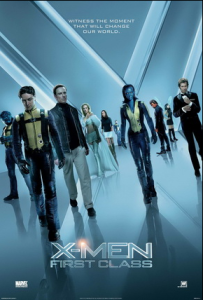 In The 40-Year-Old Critic, Venganza Media creator and host Arnie Carvalho recalls a memorable film for each year of his life. This series appears daily on the Venganza Media Gazette.
In The 40-Year-Old Critic, Venganza Media creator and host Arnie Carvalho recalls a memorable film for each year of his life. This series appears daily on the Venganza Media Gazette.
I didn’t really want to review the X-Men films for Now Playing Podcast.
Don’t get me wrong, I enjoy discussing any movie in-depth, whether it’s Leprechaun in Space or Touch of Evil. But for X-Men I had a specific hesitation.
I had, in passing, already discussed these films with longtime friend and podcast co-host Stuart. It was clear we didn’t see eye-to-eye; he expressed a preference for Bryan Singer’s earlier, dour X-films; I actually enjoyed Brett Ratner’s third X-Men movie, The Last Stand, the most — finally giving the superheroes fight sequences they’d been denied on screen.
I hadn’t seen the X-Men films in a few years by 2011, when we started our Marvel Movie Retrospective Series, but I was fully prepared to stand alone with my minority opinion.
It wasn’t that I loved X-Men: The Last Stand. I felt all the X-Men films were lacking in some areas, and expressing my preference for Ratner’s vision didn’t mean I could champion it. I loved Marvel, especially the movies, but to this franchise I held no allegiance.
That is why in 2009 we took a pass on that year’s X-Men Origins: Wolverine. After the film was released we felt doubly justified.
But, as I discussed in my Howard the Duck article, in 2011 Now Playing was beginning its most ambitious endeavor; reviewing every Marvel-based movie ever released in theaters (U.S. or overseas). That meant Stuart, Jakob, and I would have to tackle the X-films, eventually.
How we approached this retrospective was the subject of some debate. I initially pitched doing all the films intermixed, in chronological order. Perhaps because it would have seemed odd to have 2002’s Spider-Man review immediately followed by 2003’s Daredevil and Hulk (both released before Spider-Man 2) Stuart wisely suggested breaking the series into a number of smaller sub-series; do Spider-Man as a unit, Blade as another group, and the X-Men by themselves. But then how would we order them? First-to-last according to release date? Or do we start with the most recent film?
Finally, realizing the interest listeners had in our theatrical release reviews, we decided to just shuffle all the series’ around to whatever order fit; but two rules presided. First, we would arrange series’ so that if they had a theatrical release, as happened for X-Men and Ghost Rider, we would tie into that release. Second, we would do all the movies in time for the ultimate Marvel crossover movie: 2012’s The Avengers.
(Sony then threw a wrench in that plan by releasing their The Amazing Spider-Man reboot in the weeks following Avengers, making Marvel’s most popular superhero the only one we hadn’t reviewed)
This massive undertaking meant we could delay it no further; we had to review X-Men. More, while we had done three one-off Marvel movies — Howard the Duck, Man-Thing, and Kick Ass, in a loose group we called Marvel Misfits — X-Men was our first real series in the Marvel Movie Retrospective. This was demanded by the release of 20th Century Fox’s impending reboot/prequel of their X-franchise, X-Men: First Class.
I wasn’t terribly excited for First Class. It was the latest offering in a scattershot series. More, it didn’t have Wolverine. While his 2009 solo film was an over-the-top testosterone-fueled orgy of explosions, I still enjoyed the character and did wonder if his absence from First Class was a blessing, giving him a rest after Origins, or a curse, the new film lacking the series’ star.
It turns out all of this fear was for nothing. While Stuart and I did disagree over the merits of the first three X-Men films and Origins, the conversations were always fun. More, Jakob provided a great third perspective that tempered both of our points and prevented the conversations from following any preconceived pattern I’d feared. Also, revisiting the films with revised expectations allowed me to appreciate them more than I had in the past.
More importantly, though, in 2011 the X-Men got their first truly great film with First Class. I had feared not finding a film I loved in the X-series, but new director Matthew Vaughn delivered that in spades.
First, the film had a lead cast that was nothing short of amazing.
I knew James McAvoy from his earlier teen comedy Starter For Ten, a film funnier than its teen game show premise deserved. The actor was also a standout in Wanted, holding his own against Morgan Freeman and Angelina Jolie, and imbibing his character with personality that seemed lacking from the movie’s thin script.
Still, while I liked the man’s work, I had a hard time imagining him as Charles “Professor X” Xavier, the lead X-Man portrayed by Patrick Stewart in the earlier films. But with Vaughn’s direction and the script (co-written by the director) this was a young, cheeky Xavier, and McAvoy owned the part.
He was, however, overshadowed by co-star Michael Fassbender, who took the role of Erik “Magneto” Lensherr; previously occupied by Ian McKellen. X-Men: First Class took elements from a canceled X-Men Origins: Magneto script — and truthfully this film is Magneto’s. Like the original X-Men film, First Class opens in a Nazi concentration camp showing Magneto, still a child, discovering his powers. But it continues that story line and shows the Nazis grooming Lensherr and training him. Magneto’s quest for revenge is the true arc of this film, and, playing Erik as an adult, Fassbender commands the screen.
I can’t recall even hearing Fassbender’s name before First Class. I had seen him in only two films: 300 and Jonah Hex, and neither performance was memorable. From this role I knew Fassbender had amazing range. With the X-Men franchise under his belt Fassbender has picked a variety of mostly smaller films allowing him to demonstrate his range, but he was truly the best find of First Class.
That is probably a somewhat unpopular opinion, especially for any Hunger Games fans reading this review, as First Class also featured Jennifer Lawrence, starring as the shape-shifting mutant Mystique (a role previously played by Rebecca Romijn). Unlike Fassbender, I knew of Lawrence before First Class due to her role in Winter’s Bone. Strong word-of-mouth brought that movie to my attention, and Lawrence earned an Academy Award nomination for her role. Still, while already an acclaimed actress, she was just beginning her career. Few could have predicted what her future held; becoming Hollywood’s biggest actress thanks to her role of Katniss in the aforementioned Hunger Games series, plus continuing to make critically acclaimed films, as well as winning an Oscar for her role in Silver Linings Playbook.
In X-Men: First Class it was clear she was as talented as her more seasoned co-stars. While not much more than a sexy henchman in the original X-Men trilogy, here Mystique’s dilemma is the heart of the film; she can do amazing things but her true form is scaly and blue. The film shows her path of self-acceptance and, as a by-product, her allegiance shifting from the more diplomatic Professor X to the more militant Magneto.
Even the smaller roles were stacked with great performances, with Kevin Bacon, Rose Byrne, Nicholas Hoult, and Oliver Platt being stand-outs. I felt the only weak link in the film was January Jones, the Mad Men star who played “White Queen” Emma Frost.
Yet while the cast was amazing, its director was even more so. I knew Vaughn only for his 2010 superhero parody Kick-Ass, and he brought that same visual flare and fast-paced storytelling style to First Class. Also, like Kick-Ass, this film had actual character development intermixed with a healthy dose of comedy.
Out of all the X-Men films, this was the first one that had been really, truly fun while also establishing amazing rivalries and human drama. It was the first great X-Men movie.
It was a delight to watch, and I was ecstatic while recording the Now Playing review when I discovered Jakob and Stuart had seen the same film I did. The only thing better than watching an amazing film is sharing that enthusiasm with other film lovers.
The movie, and that podcast review, were my personal high points of our X-Men retrospective series, and it kicked off our Marvel Retrospective with a huge bang. There were good times ahead.
In the three years since this film’s theatrical release I’ve seen it at least a dozen more times. I went back to see it in theaters even after Now Playing’s review, just for fun. I bought it on its Blu-ray release date, and watched it immediately. It’s a staple, any time it airs on television I turn it on again. On flights it’s the movie that gets the most play on my iPad.
Yet this enthusiasm is tinged with sadness. While I did not share a dissenting opinion on the podcast, all three of us seem to be in a minority group for our love of this film. It became the lowest grossing X-Men film ever — audiences just didn’t turn out to see the movie. Perhaps they were put off by the lack of Wolverine? Maybe the 1960s period piece feel didn’t appeal to 21st Century moviegoers? Perhaps the summer was just too full of superheroes with Thor and Captain America also hitting screens? No matter the reason, the film failed to find an audience and made less money than 2000’s original X-Men, even with 11 years of ticket inflation taken into account.
More, it seems this movie didn’t catch on in home video. I thought it could have a second life in home theaters, but my anecdotal evidence suggests people simply preferred the movies with the original cast to this new vision.
If there is no greater joy than discussing a beloved film with others who share that sentiment, there are few feelings more depressing than feeling alone and wondering why everyone else can’t see in this film the great things I see.
Worse, lack of fan response ended First Class‘ run in the X-Men. Fox, knowing they have to battle Marvel (who are the creators of the X-Men characters, but don’t hold the film rights), decided a major course correction was needed for the studio’s premier superhero franchise. They had definite ideas for the next X-Men movie, and were prepared to spend more than they ever had before to ensure their mutants could stand their ground against the Avengers. Studio interference and demands, including bringing back some members of the original cast to appeal to fans, led to Vaughn abandoning development on the sequel film, and in his place Bryan Singer returned to the franchise.
The result of Fox and Singer’s work was this year’s X-Men: Days of Future Past. It was a very good movie — Singer’s best entry in the franchise by a mile. Yet it didn’t do as good a job juggling the characters, the story line wasn’t as tight, and it lacked the groovy, kinetic fun of First Class. It lacked Vaughn, who was the X-factor the franchise needed most.
But again I may stand alone in that opinion, as Days of Future Past became the highest-grossing X-film to date; besting X-Men: The Last Stand’s take in 2006.
I have no doubt that with the upcoming X-Men: Age of Apocalypse, the X-films will continue to get grander and mix in more cast members new and old. I just hold out hope that at some point they look back and see all that First Class did right, and bring some of that lighthearted humanity back to the X-Men.
Tomorrow — 2011!
Arnie is a movie critic for Now Playing Podcast, a book reviewer for the Books & Nachos podcast, and co-host of the collecting podcasts Star Wars Action News and Marvelicious Toys. You can follow him on Twitter @thearniec
September 10, 2014 Posted by Arnie C | 40-Year-Old Critic, Comic Books, Movies, Reviews | 2010s, 40-Year-Old Critic, Avengers, Comic Books, Comics, Enertainment, Hasbro, Jennifer Lawrence, Marvel, Marvel Comics, Marvelicious Toys, Matthew Vaughn, Movie, Movies, Now Playing, Podcasts, Review, Reviews, Spider-Man, X-Men, X-Men First Class | 3 Comments
The 40 Year-Old-Critic: Scott Pilgrim vs. the World (2010)
In The 40-Year-Old Critic, Venganza Media creator and host Arnie Carvalho recalls a memorable film for each year of his life. This series appears daily on the Venganza Media Gazette.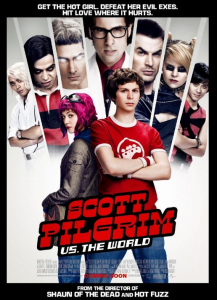
On the surface this may look like I’m again revisiting a movie reviewed on Now Playing Podcast. But that’s not the case. This is actually the first time I’m getting to share my views on Edgar Wright’s 2010 romantic comedy Scott Pilgrim vs. the World.
Looking back, I recall 2010 was a very busy summer for me. I was approaching my 5th anniversary of podcasting with Star Wars Action News, which was, at the time, our most-downloaded show. However, Now Playing was on the rise in the iTunes ranks, and while 2009 saw the show go several weeks without a new episode, by 2010 we were putting out a new show almost every week. We even decided to experiment with fundraising to help cover our costs by doing two shows a week in October: The Texas Chainsaw Massacre Retrospective Series on our main feed and the Child’s Play Retrospective Series for those who donated money to the show.
Doing so many podcasts at once was becoming a heavy load for me to carry, and I hit a bit of a breaking point by late summer. Not only were we doing two Now Playing shows per week and Star Wars Action News, but we also were covering San Diego Comic-Con in July (which had us producing an SDCC-exclusive bonus podcast review of I Know Who Killed Me), and the Star Wars Celebration V convention in mid-August. There Marjorie and I, as part of Star Wars Action News, were throwing a party that was to be attended by hundreds of people, hosting several panels on Star Wars Collecting and the Star Wars Radio Dramas, and, of course, trying to put together our reports on the convention.
I felt I needed a break; priorities had to shift. SWAN was Venganza Media’s flagship podcast, so it and Star Wars Celebration V demanded my attention. I needed time off from Now Playing.
Until that point I had been Now Playing’s constant. I was the producer and — for most of the run — editor of the show. The other hosts rotated, but I was always there facilitating the show and making sure it went smoothly. Yet I still made plans, communicating with Brock, Stuart, and Jakob to do the Philip K. Dick Retrospective Series without me. It seemed perfectly timed, as The Adjustment Bureau was coming out in July. The guys would record the shows, and our first editor, Jay, would cut them. I could finally be “hands off.”
It wasn’t that I didn’t want to be on the series; Blade Runner is a long-time favorite that I’ve seen more often than I can count. Total Recall is another favorite. With Minority Report also in the series, I would have liked to be there to express the minority opinion that the film isn’t very good.
Still working the schedule, I could see we needed one more show for August, specifically for the weekend of Star Wars Celebration. I suggested the guys do Scott Pilgrim vs. the World. I knew nothing about the movie beyond having seen some trailers, but to me it seemed in line with Now Playing’s usual fare. First, it looked like a film full of comedic action and special effects. Second, it was coming from Edgar Wright, the director of the awesome and quirky Shaun of the Dead and Hot Fuzz. Third, Jakob was a huge fan of the comic books and hyped for the film.
It seemed all set and ready to go.
Then it all fell apart.
Right after the July 4 weekend Universal Pictures announced it was moving The Adjustment Bureau’s release to February 2011. These Hollywood schedule shifts always cause headaches for us, but none had been worse than this one; most of the Dick series had already been recorded and we had to scramble to get other shows ready and released to fill that gap — not what I wanted to be doing in an already jam-packed July.
Then came Scott Pilgrim vs. the World. I was in Orlando for Celebration when the show was released, which made it the first (and only) time in Now Playing history I was hearing the show as a listener. I had complete faith in the guys to do a great job, but it was odd to be so out of the loop on my own show. Yet I listened, even without having seen the film, and it was a solid episode. Still, it was hard for me to judge — I was too busy to see the movie.
Finally, after returning from Celebration in late August, Marjorie and I made it to the theater to see Scott Pilgrim. It was a chore — the movie had quickly vanished from our local theaters, so we had to drive two hours each way to see it. Yet it was completely worth it. I sat there enraptured as Wright delivered what, to this day, remains his best film.
Part of the thrill came from the fact I didn’t really know what the film was about. The trailers suggested that the characters were living in a video game world, collecting coins and getting 1-Up extra lives. It was quirky, but what was it about? I expected the movie to offer some explanation; perhaps, Tron-like, Scott had fallen into a video game world, or maybe he had an overactive imagination like The Secret Life of Walter Mitty?
No, it turned out Wright was a confident enough filmmaker to just make a fantasy film in which this was the world. It wasn’t strange to any character that mortal combat would break out in the streets, that two-headed dragons would emerge from speaker systems, or that coins magically appear when people die. All taking place in the magical land of… Canada. It was a vision that Wright completely committed to, and the result is a phenomenally immersive experience. I usually don’t like fantastical scenarios (going to Tolkien’s Middle Earth holds little appeal) but I would love to visit Wright’s Canada.
The editing and music on the film were honestly the best I’d seen in a film that year. Wright’s kinetic montage-style of filmmaking had been a high point of his previous two movies, but here was the first time he seemed totally at ease with his own storytelling ability. It was the same effective, short-hand repetition Darren Aronofsky had used in Requiem for a Dream, but here it was fun and it worked. More, it hit me in a sweet spot: its video game references were all of the late 80s and early 90s 8-bit and 16-bit systems like Super Mario Bros., games I spent thousands of hours playing in my youth.
The film’s saturated color palette, the comic book-style words that filled the frame, the soundtrack and score, every element came together in Scott Pilgrim to create an incredibly fun movie experience.
But there was more to this movie than just a good time — it was also a romantic comedy. The primary plot surrounds Scott Pilgrim (Michael Cera), his crush on Ramona Flowers (Mary Elizabeth Winstead) and their courtship. In order for them to date, though, Scott had to engage Ramona’s “Seven Evil Exes” in battle.
The trailers told me that was the setup for the film, but the focus had been on the fights and the comedy. I had no idea that the movie would be so deep on the romance.
The film is virtually a love quadrangle: Scott starts the film dating underage Knives Chau (Ellen Wong), a girl so infatuated with him that she practically seems like a groupie for Scott’s band, Sex Bob-omb. Scott is a very passive character so he can’t bring himself to break up with Knives until he is certain things are going well with Ramona.
Then, in the background, is Sex Bob-omb drummer Kim Pine (Alison Pill), Scott’s ex-girlfriend who seems fed-up with her bandmate’s immature relationships.
This wasn’t your standard rom-com where everything is clean-cut and neat — there were messy relationships at work. In this magical land of Canada real emotions and moral dilemmas were being had. Were Scott’s actions right, or was he wrong for dating Ramona while still going with Knives? Did I want to see Scott with Ramona?
Yes, Scott was infatuated with Ramona; she was the princess in the castle and Scott was the video-game hero who had to rescue her. He didn’t just have to court her; he had to fight for her. Literally. Ramona has had seven romances in her life and Scott must defeat each one.
First, this is an awesomely delivered metaphor for any new romantic relationship. When two adults start to date each brings with them the wounds of heartbreak and the baggage of previous boyfriends and girlfriends. New love often is accompanied by hesitation and a degree of paranoia; will this person try to control me like my last girlfriend did? Will he cheat on me like my previous boyfriend?
In real life those “evil exes” are simply previous loves lost, and a new suitor must battle it by earning trust and proving themselves better than those who came before. But that’s the real world; in Wright’s fantasy-land of Canada these evil exes have to be fought Mortal Kombat-style… to the death. It’s a storytelling conceit that is fun but also drives home that Ramona carries some serious baggage.
Wright has perfect casting in the film, with Cera a particular highlight. I first encountered the actor in Superbad and then caught up on his breakthrough television role of George Michael Bluth on Arrested Development. He carries with him a shy niceness that makes him seem sweet even when making bad decisions. More, he’s thin and wiry, and doesn’t look well-equipped to engage anyone in combat. When Matthew Patel, the first evil ex, appears, it’s easy to think Scott’s ass will be handily kicked.
Yet this is Canada, normal rules of fighting don’t apply. Scott pulls out fighting moves that astound Patel and the audience. While Patel and Scott fight in hand-to-hand combat, no two battles follow the same video game convention. From Rock Band to Tony Hawk Pro Skater, each fight has its own video game analog.
But as Scott battled I started to wonder if he and Ramona really should be together. Ramona was non-committal; she couldn’t even go a few days without changing her hair color, let alone her boyfriend. Even as Scott battles ex after ex, Ramona is not forthcoming about her past — Scott’s every day is a surprise of what’s coming next. More, as each ex arrives Ramona finally reveals to Scott her relationship with that person, and how she broke up with them. It turns out Ramona was always the one to initiate the break-up, she’d never been dumped.
Scott was fighting for Ramona, but I wondered if Ramona would fight equally for Scott. Winstead’s performance is wonderfully reserved, giving me that hesitation. We know Knives would, and does, fight for Scott’s love, but is Ramona the one Scott should end up with? Or will she dump him as she has all seven of her exes?
More, it turned out Scott himself had a history, having been dumped by Natalie “Envy” Adams (Brie Larson) when she became famous with her band The Clash at Demonhead. Scott is as evasive about Envy as Ramona is about any of her exes.
For a movie that was sold as an 8-bit video game fight, I was just as enthralled with the emotional resonance and depth of characterization occurring on-screen.
The actors, from large roles to small, also delivered great performances. Kieran Culkin almost stole the film as Scott’s gay roommate Wallace Wells. Every scene with Culkin is full of quotable dialogue and unexpected humor. Minor roles in the film are stocked with familiar faces, including Rushmore’s Jason Schwartzman as seventh evil ex Gideon Gordon Graves, Brandon Routh (Superman Returns) as a psychic vegan Scott must fight, and Captain America Chris Evans as a skateboarding action movie star. The latter two had both done superhero films I disliked (Routh in Superman, Evans in Fantastic Four), but their performances here won me over and I left the film actually liking both of them. Plus cameos by Thomas Jane (The Punisher) and others always had me going, “I can’t believe he’s in this film too!”
I don’t wish to sound trite, but everyone in this movie was perfect — and that’s a term I don’t use lightly.
That this film didn’t find its audience at the box-office was disappointing. This was a movie I thought everyone should see, and most would enjoy. It had come out of nowhere and became my favorite film of 2010 (with Kick-Ass a very close second).
More, though, I was heartbroken. This was such a great movie and I couldn’t talk about it. That spot on the show had been given up, through my own action. I had said, “You guys go ahead, take this one without me.” Now I can never spend two hours debating the various romantic entanglements, and relishing in the great performances delivered in Scott Pilgrim. Despite putting more than 2,000 words of praise into this article, it will never be as widely disseminated a review as the one you’ll hear on Now Playing Podcast.
I have very few regrets in my podcasting history. Not being on the panel reviewing Scott Pilgrim vs. the World is one of the biggest.
That day I made a vow — I wouldn’t make that mistake again. After Scott Pilgrim there would never again be a Now Playing review I did not co-host. Barring massive illness or injury, I will remain Now Playing’s constant. It is in my blood to discuss film. I love the conversations, even if I don’t always love the film.
Another host approached me when Jakob, Stuart, and I were doing our Steven Spielberg donation retrospective series covering Close Encounters of the Third Kind, E.T., and War of the Worlds, asking for a turn on the panel. His argument was, “You don’t even like Close Encounters,” so why would I want to be on the review. The answer was pure and simple — I wanted to be there to say why I didn’t like Close Encounters. I wanted to have that debate with two fans of the film. It’s not just about the movie; it’s about the analysis, the debate, and the conversation. There’s no fun if everyone agrees on everything, having a minority opinion is vital to good debate.
I will always regret not being able to be on a podcast review of Scott Pilgrim vs. the World, but I came out of that knowing how important Now Playing truly is to me. And that is a happy ending.
Tomorrow — 2010!
Arnie is a movie critic for Now Playing Podcast, a book reviewer for the Books & Nachos podcast, and co-host of the collecting podcasts Star Wars Action News and Marvelicious Toys. You can follow him on Twitter @thearniec
September 9, 2014 Posted by Arnie C | 40-Year-Old Critic, Comic Books, Movies, Reviews | 2010s, Comic Books, Comics, Edgar Wright, Enertainment, Film, Michael Cera, Movie, Movies, Now Playing, Now Playing Podcast, Podcasts, Review, Reviews, Scott Pilgrim, Star Wars Celebration | 1 Comment
The 40 Year-Old-Critic: Avatar (2009)
In The 40-Year-Old Critic, Venganza Media creator and host Arnie Carvalho recalls a memorable film for each year of his life. This series appears daily on the Venganza Media Gazette.![]()
Avatar is the highest grossing film of all time. Audiences loved the film, as did most critics. Yet in 2009 the film failed to excite me, my review was controversial, and to this day Avatar continues to give me a headache. To this day I also remember the buildup to that film’s release… and the aftermath.
I had heard rumblings about Avatar for years. James Cameron’s last theatrical film had been Titanic in 1997 — then the top-grossing film of all time — and after that massive success the director dropped out of the spotlight, focusing his time on a few IMAX documentaries. It seemed quite possible in my mind that Cameron might not ever make a film again, and with each passing year I paid less attention to the rumors that swirled about his next project.
It wasn’t until San Diego Comic-Con in 2009 that Avatar truly grabbed my attention. Signs showcasing the blue Na’vi aliens were everywhere, and all the buzz at the convention was about 20th Century Fox’s panel and the Avatar footage they would show.
My curiosity was piqued. I was a fan of Cameron’s films in the 80s and early 90s; the two Terminator films and Aliens are among some of my favorite movies. I was less thrilled with The Abyss and True Lies, and Titanic was the breaking point. The film was way too long in all respects, and while I thought it was competently made I never cared for it. As such, I wanted to see what the man who made Terminator 2 would do, but his later works prevented me from being excited.
As I wasn’t passionate for Avatar I never even thought it should be reviewed on Now Playing Podcast. That idea came from my co-host Stuart.
My memory is slightly fuzzy, but as I recall Avatar was the first film Stuart ever championed to review on the show.
Before 2009 Stuart had reviewed two only two movies for Now Playing. In 2008 I asked him to review Star Wars: The Clone Wars. I knew that compilation of episodes that Warner Bros. laughingly called a “film” was an atrocity that made The Phantom Menace look like The Maltese Falcon by comparison. Yet due to my primary podcast, Star Wars Action News, I didn’t want to eviscerate the film myself for fear of alienating any Star Wars fans excited for Clone Wars. Stuart had been writing reviews for another website for some time, and as he was one of my few friends who was not a fan of Star Wars, I felt he’d be perfect for the job.
Later that same year Stuart came to visit and we ended up seeing the Clive Barker film The Midnight Meat Train. Marjorie suggested we record a Now Playing review and I was shocked how much fun I had. Stuart’s knowledge of film plus my own horror fandom made that easily one of my favorite “early episodes” we recorded. But it was a one-off recording; there were no plans for there ever to be another. Still, I wanted to talk more horror with Stuart.
But Now Playing was not a priority for me in 2007 or 2008. During those years the show had languished; lack of regular content caused downloads to drop from the thousands to the tens. Several efforts to reignite the show had not caught on with listeners, but I enjoyed having an outlet to discuss movies when so inclined.
Things started to turn around in January 2009 when I was inspired to return to Now Playing to review the rebooted Friday the 13th, and it wasn’t enough to just do that one movie — I wanted to review the entire Friday the 13th series. And I wanted Stuart to join us.
He was hesitant. He didn’t love the franchise and wasn’t entirely sure what would be involved. Still, he agreed. Even with the lower caliber Friday entries, the recording sessions were fun. More, the audience was responding, and we started getting thousands of listeners again. As such, near the end of the Friday the 13th Retrospective we decided to continue going with Star Trek.
Things snowballed, and by late 2009 Stuart had been on dozens of shows discussing The Terminator, Halloween and more. Yet it seemed he was going along with the group. Even though there were series where he strongly liked early installments, the new releases didn’t excite him. The theatrical weekend-of-release recordings left him cold.
Until Avatar. After a long series of Halloween movie reviews Stuart wanted to do a one-off review for Cameron’s newest film.
Now it was my turn to resist.
I was hesitant for a number of reasons. First, Now Playing had tried for years to do weekend-of-release reviews, but it was the retrospective series’ that really clicked with listeners. Even in 2009 Marjorie and I had done a couple one-off reviews, but they didn’t reach a wide audience.
More, I was the editor for weekend-of-release recordings. Those shows take a bigger time commitment than any other. It’s easy to be a host on a series that doesn’t excite you — two hours of watching, two hours of recording, and you’re done. As the editor I’d have to spend another dozen hours, or more, editing and polishing the show. It’s hard to commit that amount of time for a film in which I had only mild interest.
But Stuart had been agreeable, reviewing some schlocky horror along the way. And he had already signed on for 2010’s Nightmare on Elm Street retrospective, a series I was ecstatic about. Now Playing scheduling is all about negotiation, so I agreed not only to Avatar but also to his idea of a Martin Scorsese/Leonardo DiCaprio team-up retrospective that would kick off 2010.
Plus Stuart followed film development and studio tracking far more than I did, and he knew how big Avatar would be.
Not to say I was totally resistant. More than wanting to be a team player and “give one up” for Stuart, as the film’s marketing started to hit I was curious. As I recall though, that curiosity was more muted, and it never reached a Spider-Man 3 level where I’d have been moved to podcast about the movie. But I did get swept up in the hype enough to give Avatar the “full Now Playing treatment” — special opening and closing credits.
In many ways Stuart was right. I never would have predicted Avatar would be the biggest film ever. That Cameron’s work could best even Titanic seemed unreal to me, yet it happened. And Stuart was also right that our review would get a lot of downloads; there was interest in the movie, and so it followed that our downloads were the highest we’d gotten for a one-off review at that time.
But I had to be honest in my review of the film, and I didn’t like it very much. Avatar was made by the James Cameron who directed Titanic, not the Cameron who directed The Terminator. The story was unoriginal and propagated the story trope of an indigenous people needing a white, male savior. The movie wasn’t terrible, but it was overly long and I never found myself enthralled with the world of Pandora. It seemed Cameron had spent too much time making documentaries and forgot how to tell a story.
But the technology impressed the living hell out of me. Cameron, at his best, is a filmmaker of tight, exciting action movies, but even when he’s not at his best he pushes the envelope of filmmaking. The Abyss, Terminator 2, and Titanic all represented giant leaps in computer-generated effects. With Avatar, Cameron not only used computer imagery, but he also advanced 3-D technology to a level I’d not seen outside of theme parks.
In 2009, 3-D films were still a novelty to me. Growing up after the boom of 3-D in the 50s I only got to see two films in that format: Jaws 3-D and Freddy’s Dead: The Final Nightmare (which only had the climax in 3-D). Yet the idea of being immersed in a film was exciting, so I went to see the Terminator show at Universal Studios with its amazing 3-D effects, I went to a museum to see the IMAX 3-D documentary Space Station, and I even went to see Spy Kids 3-D: Game Over in 2003 despite never having seen the first two Spy Kids films.
Slowly, 3-D films were returning, propelled by digital projection technologies. I had to travel hours to digital theaters to see such films as My Bloody Valentine 3D and The Final Destination just for the effects. They were good; gimmicky, but fun.
Yet none could hold a candle to Avatar, which not only had eye-popping effects but added depth to the frame. The 3-D was at times attention-grabbing, but at other times subtle. For the first time I saw how this new technique could really aid films in drawing viewers into the story.
That was what I thought leaving the theater in 2009. For this article I revisited Avatar on video (albeit in 2-D), and listened to the archived Now Playing Podcast review. I stand by everything I say; the movie was really impressive to look at, but also horribly dull.
The film ended up with one “Recommend” from Stuart. Marjorie — who had also co-hosted the Terminator reviews and thus was the natural choice to co-host more Cameron reviews — sided with me, and we gave two “Not Recommends.”
Reviews are a funny thing, no matter what you say, it pisses someone off. Every Now Playing host has received vitriol-filled e-mails, tweets, reviews, and more from listeners who disagree with their opinions. Rarely is this feedback constructive, filled with counter-arguments that support an opposing view. Usually the e-mails feel like notes from a kindergarten student, tantamount to saying, “You are a doodie-head,” though with many more four-letter words and, in some special cases, threats of physical violence.
Sometimes liking a film can be cause for this type of reaction, but it’s more common with negative reviews. No matter what title is being discussed, somewhere that film has an ardent fan whose feelings are hurt by having their film criticized. Superman IV, Halloween III, even Star Trek V, they all have their supporters.
While we received a few nasty-grams for our negative reviews of the Friday the 13th reboot, Rob Zombie’s Halloween II, and even 2009’s Star Trek, nothing prepared me for the backlash I would receive for giving Avatar a mild “Not Recommend.” The attacks came from all sources, but primarily nasty e-mails. Listeners not only said they were never listening to our show again, they wanted to be sure I knew it, and not just from watching server traffic. They wanted to make noise as they (supposedly) walked out the door.
Our audience only continued to increase throughout 2010, but the scathing, often personal, attacks let me realize that by putting myself out there and expressing my thoughts I was really opening myself up for a lot of negativity.
While that trend has continued — each host speaking unpopular truths — I’m happy to report the positive feedback from listeners far outweighs the negative, but in the midst of Avatar-gate there were times it didn’t feel that way.
Yet, for all the attacks I received in 2009 for giving Avatar a red arrow, I have to wonder; is there still the love for this film? It truthfully feels like that movie was a flash in a pan. I see the disc on Walmart movie racks, but I know of no one who regularly re-watches the movie. It’s not in rotation on cable, network, or pay television. I see no Na’vi cosplay at conventions, and rarely does Avatar show up on lists I read of favorite or best films.
If you still love, or even strongly like, Avatar, please let me know in the comments below. For while the studio talks of two, and now three, sequels in concurrent production, I simply don’t see the demand from the fan base. Actually, I don’t even see the fan base existing at all.
So in that regard I feel vindicated. Unlike Titanic, which was inescapable for many years after its release, Avatar seems forgotten.
But I am not above issuing a correction when due, and I did say something in our 2009 review that history has proven untrue. I stated Avatar was the best looking film I’d ever seen, with the greatest 3-D effects to date, and I stand by those thoughts. I continued, though, that the next year we’d see films with even better CGI visuals, and even greater 3-D, and in that I was dead wrong. Cameron is more than an artist, he’s a technician. He has both the will, and (thanks to his track record) the studio support, to linger in development and ensure the films he makes always reach new heights. Yet here we are, five years later, and no film has bested Avatar‘s use of 3-D in film. Cameron’s work is still my high watermark against which I measure all other 3-D.
More, it seems no filmmaker is even trying to achieve that result. Technical difficulties have kept many directors away from filming in 3-D. Joss Whedon had intended to shoot 2012’s The Avengers in 3-D, but while filming the Thor stinger scene he encountered numerous production delays caused by the cameras. As such, he abandoned the medium and chose to shoot in 2-D.
Disney then post-converted The Avengers to 3-D for theaters.
And that may be Avatar’s longest lasting, and worst, outgrowth — the 3-D cash grab. It was not just by popularity that Avatar became the world’s top-grossing film, much of that was due to inflated ticket prices. The general cost of movie tickets has been steadily rising for decades, but premium surcharges put on IMAX presentations and 3-D films boosted Avatar to even greater heights. Studios wanted to continue to reap those rewards. It took a year for studios to implement the change, but by 2011 almost every major motion picture released was in 3-D — the majority post-converted in order to make more money through higher ticket prices.
Recently it seems that audiences are wising up to this gimmick and realizing that, especially with post-conversion 3-D films, the effects are not worth the extra cost. Many articles I’ve read point to a decline in 3-D film popularity. But to this day, every time I go to theaters and pay a 3-D surcharge, and every time I leave the theater with an eye-strain headache due to a piss-poor 3-D post-conversion job, I know that is truly Avatar‘s legacy.
Perhaps Cameron will succeed in bringing Avatar back to the screens. Hopefully the story will be more original, and tighter. More importantly, maybe they will change Avatar‘s place in film history from “the film that popularized 3-D” to “the sci-fi fantasy saga of the 21st Century.”
Or perhaps I’ll give more negative reviews to dull films.
Time will tell.
But then again, perhaps the true, best legacy of Avatar was expanding Now Playing’s boundaries. It’s not often that we do one-off reviews, but Stuart’s correct insistence that we review Cameron’s 2009 epic exposed our show to new listeners and helped expand even the type of film we review. For that, I am grateful.
Tomorrow — 2010!
Arnie is a movie critic for Now Playing Podcast, a book reviewer for the Books & Nachos podcast, and co-host of the collecting podcasts Star Wars Action News and Marvelicious Toys. You can follow him on Twitter @thearniec
September 8, 2014 Posted by Arnie C | 40-Year-Old Critic, Movies, Reviews | 2000s, 3-D Film, 3D, 40-Year-Old Critic, Avatar, Enertainment, Film, James Cameron, Movie, Movies, Now Playing, Now Playing Podcast, Podcasts, Review, Reviews, sci-fi | 5 Comments
The 40 Year-Old-Critic: Iron Man (2008)
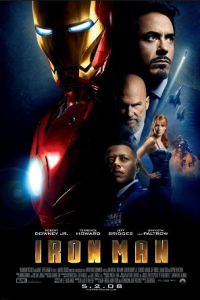 In The 40-Year-Old Critic, Venganza Media creator and host Arnie Carvalho recalls a memorable film for each year of his life. This series appears daily on the Venganza Media Gazette.
In The 40-Year-Old Critic, Venganza Media creator and host Arnie Carvalho recalls a memorable film for each year of his life. This series appears daily on the Venganza Media Gazette.
We truly live in the golden age of Marvel movies. In the past six years Marvel Studios (and now Disney) have set the standard for comic-based films, and racked up some of the highest-grossing hits of all time.
This year, the company proved how golden it really is with Guardians of the Galaxy, a film featuring a talking raccoon and his friend, the tree. On paper, that’s laughable. This movie shouldn’t have worked; the concept is so far removed from The Avengers that it conjures up memories of Howard the Duck (who even made a cameo).
But as I sit here typing this, Guardians has the designation of being 2014’s top grossing picture in the U.S.
It’s a wild success story that no one could have predicted — certainly I didn’t — back in 2008 when Marvel Studios released its first film: Iron Man.
As I detailed in my reviews of Superman and Spider-Man 3, I was a Marvel Comics fan in my teen years. At my peak I had several thousand comic books; long boxes stuffed with popular titles like Spider-Man, X-Men, and The Incredible Hulk, as well as Darkhawk, Ravage 2099, and Fantastic Four. Conspicuous perhaps by his absence, I didn’t own a single issue of Iron Man.
The character did make appearances in many comics I owned. Massive crossovers such as Secret Wars prominently featured the Armored Avenger. Yet none of those appearances made me feel like picking up an Iron Man comic. A businessman who pretends to be his own bodyguard in a suit of armor? The concept sounded pretty cheesy. The suit’s design, a garish red and yellow, also was a turnoff. He could fly. He could shoot lasers from his hands. And? Why would I want to read about that?
More, why would I want to see a movie about that?
The arm-chair studio moguls online and in magazines like Entertainment Weekly seemed to agree with me. Phrases like “B-list superhero (at best)” were used to describe Iron Man. It is hard to believe now, but just seven short years ago Iron Man had virtually no name recognition among the common public. Marvel had sold the movie rights to many its most well-known superheroes, including Spider-Man, Hulk, Wolverine and the X-Men, and those characters had gone on to star in their own pictures. Even other B-listers like Daredevil, Blade, and Ghost Rider had been picked up by other studios. What did Marvel have left?
They had Captain America, a man out-of-time goody-two-shoes. They had Thor, a Norse god that may have been even less well-known in his comic incarnation than Iron Man. They had The Incredible Hulk, who had a good history but a recent box-office disappointment thanks to Ang Lee’s Hulk. And they had Iron Man.
Yet Marvel had a vision. More, they had a plan. They didn’t release one film in 2008, they released two. They let it be known immediately that they were going to do on screen what they had done in their comics: create a shared universe where characters would cross over. The end game was announced before Iron Man was in theaters, Marvel wanted to assemble The Avengers.
I thought it was crazy talk. While, thanks to Harry Potter and Lord of the Rings it had become more common to have sequels in production, or even entirely filmed, before the first film was released. Even those seemed risky though, with pundits noting Lord of the Rings could have bankrupted New Line Cinema. Yet here Marvel Studios was going this route for its first features.
Iron Man didn’t excite me, but Marvel’s strategy sure got my attention. It was audacious, it was bold, and it was risky. I admired them before I ever saw a frame of the film.
Even crazier — they hired Robert Downey, Jr. to play Iron Man/Tony Stark. If you’ll recall, in the late 90s and early 2000s, Downey had a fairly toxic reputation in Hollywood. His well-publicized battle with addiction and his prison stints had branded him as unreliable. Worse, he was uninsurable — no company would put up a bond for the actor lest he again be arrested and his filmed scenes became unusable.
Despite his off-screen troubles, I had always been a fan of Downey. While I’d seen him in Weird Science and Back to School he first really caught my eye as someone to watch in The Pick-Up Artist, a film in which Downey is the only redeeming quality. I followed him for many years with Less Than Zero, Chances Are, Air America, hell I even watched Soapdish because he was in it. But two roles really defined Downey for me: his 1992 Oscar-nominated lead in Chaplin, and his role as a tabloid TV reporter in Natural Born Killers. But the more public his personal troubles became the more I felt he was an actor on the decline. I was really saddened by this — the man could act! From Two Girls and a Guy to U.S. Marshals to Kiss Kiss Bang Bang, I’d always been captivated by him.
That he was the star of Iron Man had me both worried and excited. On the one hand it seemed like on-the-nose casting — if I knew one thing about the Tony Stark character in comics it was that he was an alcoholic; if most people knew Downey for only one thing it was for his substance abuse problems.
The trailers with the rocking Black Sabbath track, Downey’s quick quips, the great action, and the effects — the film looked better than I expected; better than it deserved to look. Plus, rumors spread like wildfire that the film would include a cameo by Samuel L. Jackson as S.H.I.E.L.D. boss Nick Fury. By the time Iron Man was released, my curiosity was piqued.
Still, I was more interested in the second of Marvel’s one-two summer punch: The Incredible Hulk. I was a Hulk fan, he was the hero with name recognition; plus it had Edward Norton, an actor I believed was every bit as talented as Downey. But until Hulk came out I thought Iron Man could help me pass the time.
My expectations were low, but I was still there opening night to see Iron Man. I even drove 90 minutes to the closest new-fangled digital projector in the area.
The film, in short, rocked. I never expected to have so much fun in a superhero film. Movies like Blade, X-Men, and Batman Begins had seemed to say there was only one way to make a comic book movie, and that’s deadly serious. Iron Man eschewed that attitude with the flippant irreverence I’d expect from its main character. The movie did have its serious scenes, but the majority of the picture was filled with a kinetic energy and a constant sense of fun. I walked into the theater not getting Iron Man’s appeal; I walked out an Iron Man fan.
This was bolstered by Downey’s now-iconic performance. I couldn’t take my eyes off him. His jokes, his charisma, he owned this film. His line, “I am Iron Man,” was 100 percent accurate, for I couldn’t imagine this movie without him. Given the wide range of roles I’ve seen Downey portray I am hesitant to call this his best performance ever, but it is my favorite (with his 2008 follow-up Tropic Thunder a very close second).
Iron Man even brought Now Playing Podcast out of a brief retirement in 2008, and we followed up that short review with an even more extensive breakdown of the film for our Avengers Retrospective Series in 2012.
Yet, despite my love of the movie, I still thought Marvel’s overall strategy was ill-formed. Iron Man did well, Hulk did not. More, the only superhero film people seemed to remember from 2008 was Christopher Nolan’s The Dark Knight — a film that was more than a blockbuster, it was a cultural touchstone.
In 2008 it really seemed Marvel had lost the battle. More, they had no movies planned for 2009. Iron Man was a big enough hit to keep the wheels turning for Iron Man 2 in 2010 but I never thought Marvel could go the distance. Avengers seemed like a pipe dream.
Again, I bet wrong. Iron Man 2 built on the brand in 2010, and the following year saw two more Marvel films, Thor and Captain America: The First Avenger. Both did respectable business, but neither broke the $200 million domestic mark to be qualified as a blockbuster. They didn’t need to; Marvel was playing the long game, they were building a brand.
It paid off — big time. The Avengers took the world by storm. It almost seemed a rematch of Marvel versus DC as, that same year, Nolan returned with The Dark Knight Rises. Iron Man once again faced Batman, but this time Stark brought his friends and when 2012 ended it was The Avengers that had become the benchmark for comic book movies. Sorry, Batman.
Marvel Studios’ brazen gambit paid off in spades. Not only has the company become an unstoppable movie juggernaut, they have expanded their cinematic universe to weekly network television, to four different Netflix series’, and even drawn plans for up to three movies per year in the future.
Other studios now desperately try to ape Marvel’s success. After trying for 20 years to get Batman and Superman on screen together, next year finally brings us Batman v Superman: Dawn of Justice, with a list of superheroes that include Wonder Woman, Cyborg, and — according to rumor — Aquaman, the Flash, and others. DC is now playing catch-up to Marvel.
Even other studios with Marvel properties have tried to follow this formula, though to less success. The same year The Avengers was released Sony tried to build its own multi-chapter story with The Amazing Spider-Man. This year they announced that a Spidey universe of films is coming, including two spin-offs featuring villains — Sony is now grasping for whatever characters to which they hold rights. At 20th Century Fox, studio executives also bet big-time on their X-Men franchise, bringing back original director Bryan Singer to revitalize the series. The Marvel Studios tactic of ending each film with a “stinger” to tease the next picture is now so commonplace, audience members are afraid to leave the theater before the end credits are finished.
Yes, for the past 6 years movies have been following Marvel Studios’ formula. It all started with a big gamble that paid off: Iron Man.
As for me, Iron Man opened a door that had been cracked the year before with Spider-Man 3. The Marvel movies were really an exciting property to follow. My dormant comic fandom was back with a vengeance. Marjorie, knowing my love of Iron Man, bought me my first high-end Marvel collectibles: a Hot Toys “Mech Test” Tony Stark figure, as well as a Kotobukiya Iron Man statue. The door was opened and before long the podcast Marvelicious Toys was launched as a companion piece to Star Wars Action News, focusing specifically on Marvel collecting.
More, Marvel Studios’ films had me wanting to build up to The Avengers. Now Playing Podcast had been following, almost exclusively, the retrospective format in 2009 and 2010, but after seeing Iron Man 2 I pitched to co-hosts Stuart and Jakob the craziest, biggest retrospective yet: every Marvel movie ever. Up until then our series’ had all been of manageable length of a dozen films or less. It took a year of discussion. First, Stuart thought we should only do the six Marvel Studios films. Then he thought we should do the major franchises. Finally he agreed to all theatrical films, and we had started Now Playing’s Complete Marvel Movie Retrospective. Over time I was even able to find a back door — several 1970s TV movies had aired in theaters in foreign countries.
It put Now Playing on a path to greater success, as described in my review of Howard the Duck — our first review in that very long series.
Yet while I still ride the high Iron Man gave me in 2008, bolstered regularly by a new “fix” from Marvel Studios, I do wonder how long this will last. Movies are defined by trends; after Star Wars every studio fast-tracked their space films, but by the mid-80’s those had become passé; after Gremlins any script with tiny attackers, from Ghoulies to Critters was given the green light. The cases of Hollywood me-too-ism are legion, but they all have one thing in common: they end when the next big thing comes along.
I often ruminate on what that next trend will be, and when audiences will tire of the serialized cinema storytelling and prefer movies that provide a singular experience with no “to be continued…” at the end. I have no doubt that day will come, but I think we’re in for many more years of the Marvel Age of cinema before we get there.
Tomorrow — 2009!
Arnie is a movie critic for Now Playing Podcast, a book reviewer for the Books & Nachos podcast, and co-host of the collecting podcasts Star Wars Action News and Marvelicious Toys. You can follow him on Twitter @thearniec
September 7, 2014 Posted by Arnie C | 40-Year-Old Critic, Comic Books, Movies, Reviews | 2000s, 40-Year-Old Critic, Avengers, Batman, Captain America, Collecting, Comic Books, Comics, Enertainment, Film, Hot Toys, Iron Man, Marvel, Marvel Comics, Marvelicious Toys, Movie, Movies, Now Playing, Now Playing Podcast, Podcasts, Review, Reviews, Robert Downey Jr, sci-fi, Sideshow Collectibles, Spider-Man, Statues, Tony Stark, Toys, X-Men | Comments Off on The 40 Year-Old-Critic: Iron Man (2008)
The 40 Year-Old-Critic: Spider-Man 3 (2007)
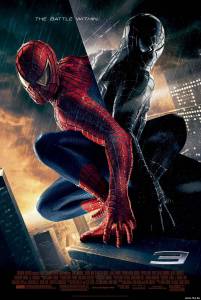 In The 40-Year-Old Critic, Venganza Media creator and host Arnie Carvalho recalls a memorable film for each year of his life. This series appears daily on the Venganza Media Gazette.
In The 40-Year-Old Critic, Venganza Media creator and host Arnie Carvalho recalls a memorable film for each year of his life. This series appears daily on the Venganza Media Gazette.
See a list of all reviews
Earlier this week, when I discussed Star Wars Episode III: Revenge of the Sith, I described how I tend to channel my excitement into creative venues. I’ve been doing it my whole life, whether that meant writing fan fiction, building model kits, customizing action figures — the point is, I like to build upon my imagination. In 2005 that drive led to the creation of the Star Wars Action News podcast.
Two years later, a near-equal level of excitement gave birth to an even larger idea that became Now Playing Podcast. The excitement was for Sam Raimi’s Spider-Man 3; the first film Now Playing ever reviewed.
I had been a longtime Spider-Man fan, from the 1970s Spidey Super Stories on The Electric Company to Spider-Man and His Amazing Friends and even Stan Lee’s daily The Amazing Spider-Man newspaper strips, but even I didn’t anticipate my own hype for this sequel. I barely caught the first Spider-Man film in theaters (its release in 2002, directly against Star Wars Episode II: Attack of the Clones, and my wedding, was much of the reason). I was more excited for 2004’s Spider-Man 2, but I wouldn’t say I was “hyped.”
But the bug bit me in 2007 — Venom had gotten into my system.
I started reading comics in 1990. I never got into them as a child; I simply wasn’t exposed to comics through friends or media. My Star Trek fandom drew me into the comics culture, because I wanted to read the “official” stories taking place after the events of Star Trek V: The Final Frontier. The first time I stepped into a comics shop the clerk tried to sell me Spider-Man No. 1, from the highly-acclaimed Todd McFarlane series.
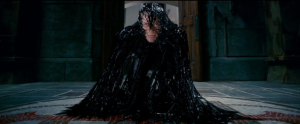
This tease ignited the fanboy in me.
I passed. I always thought the comics were just color reprints of the daily newspaper strip, until my longtime friend and Now Playing co-host Stuart started telling me stories about how Spider-Man changed his costume to one that was black-and-white. Incredulous, I didn’t believe him, especially when he told me the suit turned out to be an evil alien. In response, and to prove his point, he pointed me to a comic book store. I went back to read many of McFarlane’s Amazing Spider-Man back issues. Of specific interest were the stories that involved Venom, a muscle-bound baddie named Eddie Brock with whom the alien suit had bonded. Venom had all of Spider-Man’s powers, but none of his responsibility.
For years I read every Spider-Man comic, but I anticipated none as much as those that starred Venom. When Brock went from villain to anti-hero in his own series, Venom: Lethal Protector, I was even happier; I could now read about him every month!
I honestly wonder if I liked Venom even more than Spider-Man himself.
As a fan I read rumors about a big-screen adaptation of Spider-Man, but it languished in development hell for more than a decade. I remember reading a Wizard Magazine in 1992 that teased a James Cameron directed Spider-Man film starring Charlie Sheen as Peter Parker and using Terminator 2 special effects for the villain — Venom! I couldn’t have been more excited but, alas, that film never materialized. When Spider-Man did hit theaters in 2002 Sheen, Cameron, and Venom weren’t even under consideration.
Finally, after enjoying two Spider-Man films in theaters (as you can hear in the Now Playing Podcast Spider-Man Retrospective Series), word came that Raimi was finally getting to my favorite Spidey nemesis.
Venom was first teased at the 2006 San Diego Comic-Con. I wasn’t in the Sony panel, but friends excitedly described the scene of alien ooze landing on Eddie Brock (Topher Grace). That the scene took place in a church really upped my expectations — Raimi had been pretty loyal to the Spider-Man mythos thus far, and despite casting the wiry Grace as the muscle-bound Brock, it seemed he was continuing that trend with Venom.
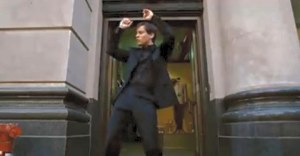
I’d seen the black outfit take Peter Parker to dark places in the comic…but never as dark as Maguire’s uncomfortable dance scene.
Venom, Raimi, and Spider-Man created a perfect storm of hype.
I am a collector by nature, and often I express my fandom through displays of movie memorabilia. It all started with my Star Wars toys in 1977, but from Superman to Gremlins to Ghostbusters to Star Trek, I’d always buy the trading cards, toys, and books for films I loved. Of course, Star Wars remained my primary focus — I bought every figure, vehicle, book, and game released.
By the year 2000 my townhouse was a crowded toy box, full of Star Wars toys, but also X-Men movie figures, Spider-Man toys, McFarlane Toys’ Movie Maniacs series’ Leatherface, Freddy, and many more. But in 2001 I quit my job and became a full-time student, and with that drastic reduction in income came a drastic reduction in collecting. I actually sold most of my toys and narrowed my focus down to my first love — Star Wars. Even as my career started to take off, my income increasing, I was never tempted to return to collecting anything but Star Wars until Spider-Man 3.
By 2007, Star Wars Action News was heard by tens of thousands of listeners every month, and hundreds congregated on our forums to discuss the toys. Surprisingly, many of those fans were also swept up in the excitement to see Raimi’s next Spider-Man film. When I mentioned on the podcast that I was drawn to — but couldn’t allow myself to buy — a particularly cool Venom figure sold by Sideshow Collectibles, these listeners came to the forums en masse to encourage my spending! Some even tried to take up a collection to buy the $80 figure for me; an act of generosity I could not possibly accept.
The flames of my Spider-Man 3 excitement were fanned by Star Wars Action News listeners, and that combination caused me to move on an idea I’d had for some time: a movie review podcast. The first movie we’d review would be Spider-Man 3, obviously.
It wouldn’t be a stretch, my wife (and co-host) Marjorie and I had already reviewed one movie together, Snakes on a Plane, the year before.
Coincidentally, another Marvel character first planted the seeds in my head that I should launch this show. Coming out of 2007’s Ghost Rider Marjorie had me almost doubled over with laughter as she lambasted the Nicolas Cage film. Not only were her observations on point, they were quite amusing. I knew many of our listeners loved Marjorie’s color commentary, and I thought that if I’d had a microphone on us walking out of Ghost Rider we’d break download records.

Despite the film’s numerous flaws, the CGI work on Sandman was impressive, and moving.
But I was daunted. Movie review podcasts were a dime a dozen. Anyone with a microphone seemed to be reviewing movies. With Star Wars Action News we’d made a big splash in the Star Wars community — a big fish in a tiny pond. Yet, even with that success I knew that we’d be out of our comfortable pond and thrust into an ocean of movie podcasts. I wasn’t sure how to make us stand out, and so I never acted on it.
More, SWAN had gone from a one-day-per-week hobby to a very time-consuming new career. Two hours of recording became 10 hours of editing, and then toy photography and travel — suddenly I was spending more time on podcasting than I was on teaching my college courses. Plus, teaching was my second job; I also had a full-time day job. With all of these commitments the thought of doing another podcast regularly was overwhelming.
Still, the seed had been planted, and my excitement for Spider-Man 3 turned it into action. Marjorie came up with the name, taken directly from the screen of her iPod that always said at the top, Now Playing.
It’s laughable now as I spend 30 or more hours per week on the show, but I originally thought Now Playing Podcast wouldn’t take much time. I figured we’d stick to my first idea and take the portable recorder (the one I’d purchased for the Samuel L. Jackson interview) to the theater and when the movie was over I’d have a microphone to capture our initial reaction. Marjorie and I went to the movies nearly every week, so we could have a spoiler-free review with just a few minutes of recording. I’d release it unedited, just add music, and be done.
As for the way to differentiate ourselves from the thousands of other podcasts? That would take me a couple more years to really figure out. In the meantime we had Marjorie and a built in audience for Star Wars Action News.
Deciding to launch Now Playing on the same day as Spider-Man 3’s release had two profound effects. First, my excitement for the next Spidey film had an outlet that didn’t involve buying collectibles. I was preparing our own launch of a podcast, so my time and money was spent getting domain names and setting up web pages (Though I was visiting Burger King more than usual to get their Spider-Man 3 kid’s meal toys — the Venom still eluded me).
Second, the anticipation for May 4, 2007 increased 50-fold — that was the day I’d get to watch Spider-Man and we’d launch our newest podcast!
My excitement level was so high we actually took that afternoon off work. There were no midnight shows, but we were there for the first matinee of the day. It was time to see Venom fight Spider-Man, and classic Spider-Man bad guy Sandman (Thomas Hayden Church) would be in there somewhere as well.
In my mind I felt I knew how the movie would be paced. The trailers had shown Spider-Man fighting Sandman while wearing his black suit. I thought for certain it would follow the structure of the original film, with the first half largely about the origin story, only this time it would be the origin of the black suit (again with Sandman in there somewhere). Then, I assumed the second half of the picture would be about our hero battling his arch-nemesis, only this time instead of Green Goblin it would be Venom.
The more I heard about Sandman being the main baddie in this film, though, I started to form a back-up theory. The trailers never showed Venom outside of the church, so I thought this entire film could be a setup for Venom, who would return as the main bad guy in Spider-Man 4.
No matter what, in Raimi I trusted. From Evil Dead to Army of Darkness, Darkman, and more, he had proven time and again to be a director with style and vision (that late 90s period including For the Love of the Game notwithstanding).
We got to theater early, after an obligatory trip to Burger King to try and get that damn Venom toy. No luck.
I can still remember being so excited I was practically vibrating in my seat. The film started, the score played over an opening credits montage reminding us of the first two films. Little did I know this would be the high point of the movie for me — thinking of the earlier, better films.
The introduction of the alien symbiote that became Spider-Man’s black suit was the opening scene, and completely convenient. It just happened to land near Peter Parker and take him over. No reason why, it just happened.
Faith was restored with the introduction of Sandman, Church having bulked up for the role and really looking like the comic book character come to life. The CGI effects during his transformation marked a new standard for humanity conveyed by computer animation.
But that was quickly lost by the contrived retcon tying Sandman to the death of Spider-Man’s Uncle Ben, and a subplot involving Peter Parker’s love life.
I won’t rehash the entire review again. You can hear our full, detailed, scene by scene review in the Now Playing Podcast archives. The disappointment you’ll hear in my voice mirrors my thoughts sitting in that theater. During that theatrical experience I realized not only was I watching a movie that was not very good, but that Now Playing’s first review would not be very positive. I had hoped for the show to be a celebration of Raimi’s film — the orgasmic climax after five years of build-up. Instead, we would have to be honest and discuss how everything — from the plot to the acting to the score — was not only far below my expectations, but also not very good at all.
No matter the quality of the movie, Now Playing Podcast had arrived. Star Wars Action News listeners and forum members were anxiously awaiting the review. So we went to the car and, raw from the experience, recorded our thoughts. We sat in the car, Spider-Man toys from BK in the back seat, and gave our initial reactions. I tried to temper my disappointment, but when I listen to that show I can hear the sound of a heart breaking.
In the years since I’ve come to focus on some of the better parts of the movie. The effects are mostly top notch, Topher Grace adds needed energy to the cast, and some of the jokes are winners. With the dour nature of The Amazing Spider-Man reboots, I even sometimes finding myself actually wishing for some of the spirit Raimi put in all of his films… even Spider-Man 3.
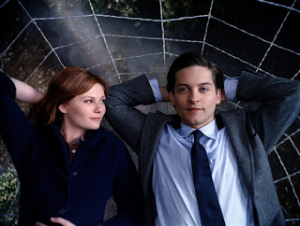
The tangled web that is Peter Parker’s love life would never straighten out; after Spider-Man 3 Sony decided to reboot without Raimi at the helm.
Yet from that bad movie experience something good did come — Now Playing. It would take years for me to realize that. Despite my best intentions, the show went from being recorded on the run to being done in the studio; it went from unedited to lightly edited to full edits. The time commitment was growing, and the listenership wasn’t. We were now one very tiny fish in an ocean so overpopulated that most shows suffered from listener famine. Without listener involvement the show became neglected, and the fewer shows we did the fewer listeners we had when we would put out new reviews. For a while we even gave up hosting altogether.
It wasn’t until 2009 when another movie, another hype machine, got me going: the Platinum Dunes remake of Friday the 13th. Then I had the idea of the Retrospective Series and a three-person rotating cast of hosts. The hype for that movie also ended in disappointment, but we had finally found the format that made our show stand out.
Today Now Playing is a regular show in iTunes’ Top 10. I’ve met hundreds of listeners in person and talked to thousands through social media. Each person with whom I interact is an experience I cherish, and it’s stunning to think none of this would have happened if it weren’t for Spider-Man 3.
And as for my resistance to collecting Marvel, Spider-Man 3 helped me stave that off… for a couple more years at least. As anyone who’s heard my Marvel collecting podcast, Marvelicious Toys, knows, I have now fully embraced it and enjoy it as a smaller side-collection to my primary Star Wars collecting.
Tomorrow — 2008!
Arnie is a movie critic for Now Playing Podcast, a book reviewer for the Books & Nachos podcast, and co-host of the collecting podcasts Star Wars Action News and Marvelicious Toys. You can follow him on Twitter @thearniec
September 6, 2014 Posted by Arnie C | 40-Year-Old Critic, Amazing Spider-Man TV Series, Comic Books, Movies, Reviews, Television | 2000s, 40-Year-Old Critic, Collecting, Comic Books, Comics, Enertainment, Film, Marvel, Marvel Comics, Marvelicious Toys, Movie, Movies, Now Playing, Now Playing Podcast, Podcasts, Review, Reviews, Sam Raimi, Sideshow Collectibles, Spider-Man, Spider-Man 3, Star Wars, Star Wars Action News, Toys | Comments Off on The 40 Year-Old-Critic: Spider-Man 3 (2007)
The 40 Year-Old-Critic: Snakes on a Plane (2006)
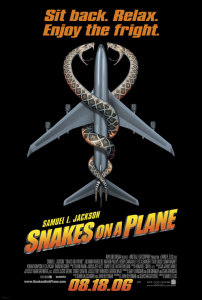 In The 40-Year-Old Critic, Venganza Media creator and host Arnie Carvalho recalls a memorable film for each year of his life. This series appears daily on the Venganza Media Gazette.
In The 40-Year-Old Critic, Venganza Media creator and host Arnie Carvalho recalls a memorable film for each year of his life. This series appears daily on the Venganza Media Gazette.
As I discussed in yesterday’s The 40-Year-Old Critic entry, I began my podcasting career in 2005 with the Star Wars collecting show Star Wars Action News; launched shortly after the release of Star Wars Episode III: Revenge of the Sith.
It had seemed like an easy enough hobby, we just record for 30 minutes each week.
However, the reach exceeded our every expectation, and in February 2006, we realized that recording from home wasn’t enough. All of the new Star Wars action figures and statues that would be released in 2005 had been revealed at Toy Fair International in New York City — and we weren’t there. We had our friends Pete and Chuck from the website Jedi Temple Archives call the show and share the news, but we knew we had missed out.
Pete and Chuck also told about the huge Lucasfilm and Hasbro presence at San Diego Comic-Con. New toys would again be revealed at the summer convention, and we felt Star Wars Action News should be there to cover it.
Marjorie and I had become more experienced con-goers since our first trip to Star Wars Celebration II for the release of Attack of the Clones, but we had never flown to an event. Airline tickets were expensive. Still, we had a show, and we needed the toys. Soon tickets were purchased, press passes obtained, and we were going to SDCC.
Then things got interesting.
As registered press for the convention, Marjorie and I started getting numerous e-mails from various companies seeking exposure. From toymakers to authors to movie studios, we were invited to exclusive events and given opportunities to interview total strangers.
Then came the e-mail that gave us the opportunity to interview Samuel L. Jackson and others for the upcoming film Snakes on a Plane.
I had heard about Snakes on a Plane but paid it little attention. Entertainment Weekly had written several articles about the silly movie with the overly-literal title. From the name alone hundreds of fan websites had sprung up. Despite its premise, the film had a groundswell of good buzz and the film’s producers wanted to capitalize on press coverage at the convention. With Jackson being a vital presence in the Star Wars prequels I thought an interview would certainly be of interest to Star Wars Action News listeners.
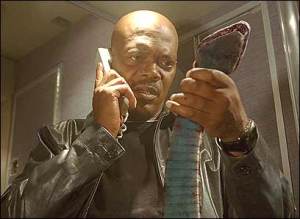
I like to imagine this is Jackson calling his agent wondering how he got on this Plane.
It seemed too good to be true. Jackson was an A-list star; I’d been podcasting for 9 months. I couldn’t believe it would actually happen. I told absolutely no one — after all, if it fell through I didn’t want to be mocked or thought of as a lying braggart. But I prepared: I bought a high-end digital audio recorder and I researched the film to be as informed as possible going in.
Yet the entire event could have been called San Diego Snakes-on-a-Plane Con. On the exhibit floor was a giant booth that was shaped like a snake, yet inside the mouth it had the feeling of a cramped airliner. The music video for Cobra Starship’s “Snakes on a Plane (Bring It)” was omnipresent (and I strained my eye every time it played for a glimpse of Maja Ivarsson’s nipple). We had gone to the convention with some friends who had just discovered the Badger Mushroom song, and so throughout the convention we’d regale each other with the refrain, “Snaaake! It’s a snaaake!” Our friends even brought rubber snakes to the convention as practical jokes.
I was swept up in the utter hype for Snakes on a Plane. I couldn’t wait for them to “Bring it.”
Sure enough, the next thing I knew I was in my first press roundtable interview. Jackson was the biggest star at the event, but it turned out there were four interviews in play. First, we interviewed director David R. Ellis, who I knew from his work on Final Destination 2. The other reporters at the table seemed disinterested and I got to ask a few questions.
Then we talked to the film’s snake wrangler Jules Sylvester. He wore an amazing serpent as he talked about the challenges of dealing with more than 450 snakes on set.
Finally, Sam Jackson visited our table.
Now the other reporters had perked up, and because I was still unaccustomed to the rhythm of the roundtable, I had to work hard to get questions in. I wasn’t entirely new to interviews; I had done many for journalism classes, and interviewed Star Wars collectors and authors on the show. But this was an A-list star. Jackson was there and actually joked with me a bit. It was surreal. He even gave me an autograph on a Star Wars book.
Finally the last interviewee came, Keenan Thompson, who Marjorie knew primarily for his work on Saturday Night Live. I got a couple of questions in there as well.
Leaving the interviews I realized I had far more content than I had thought. While the Jackson interview would be of some interest to Star Wars fans, the rest of the interviews were full of good information, though I knew they had no place on Star Wars Action News. Early feedback from Star Wars listeners was that they did not care for bad language, and so I figured the audience crossover between an R-rated reptile disaster film and Star Wars Action News was minimal.
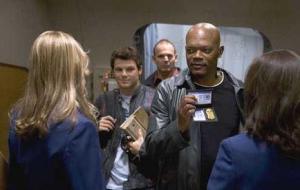
I’m not sure if a movie titled Snakes on a Plane needs more plot than, well, snakes on a plane. Yet this film also gives us a crime story to explain…sort of…how the snakes, and Sam Jackson, got on that plane.
But with four great interviews in the can I decided to start our second podcast, Snakes on a Podcast. It was a limited show, with only five episodes. The first four would lead up to the release of the movie and each would contain one interview. Then, for the fifth show, Marjorie and I would review the movie.
We publicized the show heavily on Star Wars Action News and it got a decent number of downloads. More, anticipation was high for our review; people wanted to know if we thought Snakes on a Plane was worth seeing.
Marjorie and I went to see Snakes opening night in August 2006. We had pre-purchased tickets, the Internet and Comic-Con hype convincing us it would be a sold-out show. It wasn’t.
More, the movie itself wasn’t very good, and we knew it in the theater. It wasn’t terrible, we had seen far worse that year, yet we had hoped for a pulpy B-movie full of laughs and fun. This was long before there was a Sharknado or Piranha 3D, but it was those films’ campy vibe that we hoped Snakes on a Plane would capture. There were moments of that in the film, but they were few and far between. The studio had initially made a PG-13 movie, then went back and added in scenes for the R-rating based off Internet fan demand for the line, “I want these motherfucking snakes off this motherfucking plane.” Those added scenes were what we wanted, that line was legendary, but in between moments of fun were long stretches of stupidity.
You can hear our thoughts, recorded minutes after leaving the theater, in the archived Snakes on a Podcast show. It is the first movie Marjorie and I ever reviewed in podcast form, and is the precursor to Now Playing Podcast, a show we started nine months later.
While the movie failed to meet our expectations, the theatrical viewing didn’t. It was an experience akin to The Rocky Horror Picture Show. While the theater wasn’t packed, everyone there was a built-in fan and the energy of the audience made for a good time. I have watched Snakes once since that theatrical viewing and it is clear that without the fans surrounding us there was little fun to be had.
Snakes on a Plane will always hold a special place in my heart. Not only was it the first time I ever felt like a real reporter for a podcast, it also is one of the last movies to consume San Diego Comic-Con. In the 2000s the complaints were that SDCC was no longer about comics; the fans had come for the movies. That was certainly true in my case. Hollywood studios saw SDCC as an opportunity to push genre movies to greater success, and spent hundreds of thousands, sometimes millions, of dollars at the convention trying to do so.
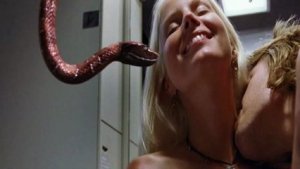
One of the films better, funnier scenes–added later to ensure an R-rating.
Despite the impressive imprint the movie had on the convention floor, Snakes on a Plane fizzled at the box office. Since 2006 a single film has always been pushed at the convention, from Hamlet 2 to Balls of Fury to Scott Pilgrim vs. the World, and they all failed to meet heightened studio expectations. Now it seems film studios have all but abandoned Comic-Con. The giant, custom booths that used to grace the floor are mostly gone. While stars still fly in to host one-hour panels, the convention has morphed into a showcase of genre television shows like Doctor Who, Game of Thrones and Arrow.
Yet each year I hope for another Snakes on a Plane-type experience, another extreme booth attempting to immerse fans in the world of their movie. It may not happen again, but at least I got these motherfucking snakes on this motherfucking Plane.
Tomorrow — 2007!
Arnie is a movie critic for Now Playing Podcast, a book reviewer for the Books & Nachos podcast, and co-host of the collecting podcasts Star Wars Action News and Marvelicious Toys. You can follow him on Twitter @thearniec
September 5, 2014 Posted by Arnie C | 40-Year-Old Critic, Conventions, Movies, Now Playing Podcast, Podcasts, Reviews | 2000s, Cobra Starship, Comedy, Enertainment, Film, horror, Movie, Movies, Now Playing, Now Playing Podcast, Podcasts, Review, Reviews, Samuel L Jackson, San Diego Comic-Con, SDCC, Snakes on a Plane | 1 Comment
The 40 Year-Old-Critic: Revenge of the Sith (2005)
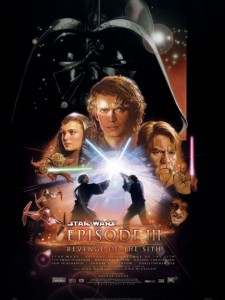 In The 40-Year-Old Critic, Venganza Media creator and host Arnie Carvalho recalls a memorable film for each year of his life. This series appears daily on the Venganza Media Gazette.
In The 40-Year-Old Critic, Venganza Media creator and host Arnie Carvalho recalls a memorable film for each year of his life. This series appears daily on the Venganza Media Gazette.
Star Wars’ greatest legacy may not be the (now endless) sequels, or the billions of dollars in box office revenue, or even the tens of billions of ancillary revenue the franchise has generated for Lucasfilm (now Disney). No, the longest lasting impact of Star Wars may be the people inspired by that film saga to go on and create themselves.
Filmmakers as varied as Jon Favreau, Damon Lindelof, and Eli Roth have all cited Star Wars as an important inspiration to their works, as have numerous authors, artists, game designers, and more.
In 2005 Star Wars inspired me as well… to become a podcaster.
By the time Star Wars Episode III: Revenge of the Sith was released I was pretty far-gone in terms of my fandom. Any lull I had experienced from 2000 to 2002 was long gone. My 2-bedroom townhouse had become a virtual Star Wars shrine with toys, prop replicas, and other various bric-a-brac on display in every room. As much due to my collection as it was a desire to build equity, Marjorie and I eventually left the rental property behind and moved into a home specifically selected for its ability to handle and display my Star Wars collection.
I had gotten three Star Wars tattoos since Attack of the Clones was released, including a Yoda that was based on the art in Genndy Tartakovsky’s Clone Wars micro TV series that bridged the story between Episode II and III. I was the ultimate Star Wars consumer — if it had a Star Wars logo I either bought it or put it on a long list to buy. I even, much to the amusement of the Target clerk and the embarrassment of my wife, bought a pair of Star Wars underwear intended for small children. To outsiders it was an undergarment, but to me it was a collectible.
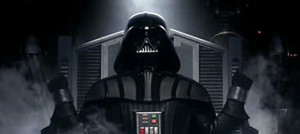
The birth of Darth Vader was the moment fans had waited 28 years for.
The excitement grew as we drew close to Revenge of the Sith’s May 2005 release date. The premiere was May 19 at 12 a.m., and I took the day off of work to sit outside the theater trying to get the best seats. Though I arrived at 10 a.m., I was not the first in line.
Coming off the high of the Star Wars Celebration III convention we attended in April, Marjorie and I had prepared line party events, including trivia, prizes, and music. I rolled up in my convertible with two 12-inch subwoofers in the trunk and blasted dance mixes of Star Wars themes. It was a party, and a blast.
I did have to leave the party for a couple hours to teach class — which I did wearing a Darth Maul tie.
What about the movie? It was far from an afterthought in all the festivities, it was the main event. The conventions, the toys, the party, they were all ways to express our fandom and excitement for the upcoming release. But when I sat in that theater the early morning hours of May 19 I was enthralled. Instantly I knew this was the best of the Star Wars prequels, by a long shot. It was the first of the new trilogy to have emotional weight. Plus it had great action, exciting new characters, and even succeeded in besting The Phantom Menace by having the best lightsaber fight of the entire series. I had high expectations for Episode III and the film lived up to them.
I lived on a euphoric high for weeks after seeing Revenge of the Sith. I went several times in local theaters, not out of a sense of obligation as I did with Phantom Menace but because I wanted to enjoy the film again. Then Marjorie and I drove to Chicago to see the film digitally with Stuart, my Now Playing Podcast co-host and longtime friend.
My Star Wars collecting went to even greater heights. Every day during our lunch hour Marjorie and I would go on a toy run, visiting one or more stores looking for new Star Wars toys.
Weeks passed, though, and while my fandom never wavered the anticipation turned into a feeling of melancholia. I had been looking forward to the Star Wars prequels since they were first officially announced in 1993 (in, of all things, a Star Wars screensaver). For twelve years I’d always had the next Star Wars film to which I could look forward. With the prequels done I wondered if I would ever again experience that level of anticipation.
To continue to experience fandom in new ways I read more Star Wars novels and comics, and visited websites and online forums. There I saw repeated mentions of something called a “podcast.”
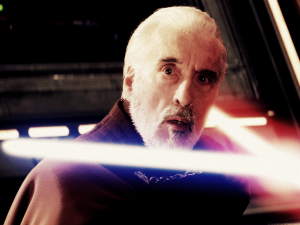
Still a better ending than Christopher Lee got in the Lord of the Rings series.
Being a tech head and, at that time, a college professor of Computer Science, I had heard of podcasting. I never understood the appeal; I was no fan of talk radio. More, I didn’t have an iPod, preferring the Creative Labs Nomad player. Yet now I saw there were podcasts discussing Star Wars, so I listened, and was excited. In my daily life I knew no Star Wars fans other than Marjorie, but on these shows were fans just like me, and they spent hours each week talking about nothing except Star Wars! Even more impressive, the Canadian podcast Star Wars En Direct even had Star Wars authors on the show to discuss their books.
I not only listened to the new podcasts, I went back and consumed the archives of many of these shows. Yet one thing frustrated me; while there were podcasts about Star Wars books, movies, and comics, none existed to talk about Star Wars collecting. Slowly the idea dawned on me… I should do my own.
I had a background in audio production. My desire to entertain, inspired by Pump Up the Volume, had sent me to study Mass Media Communications as an undergraduate. I was a radio DJ, and in my spare time experimented with digital audio, including rudimentary audio editing. As time went on I experimented in other computer multimedia, including video editing. I had the basic skills to do it, and just a few hours of research showed me all the technologies I would need to make it happen.
I also had my own website. My career goal had been to become a video game designer, and to build my resume I created a site reviewing PC games new and old.
So on Sunday, August 28, 2005, a little more than three months since Revenge of the Sith had visited theaters, I was inspired to create my own Star Wars podcast. I will never forget the conversation I had with Marjorie that Sunday morning.
“What plans do we have today?” I asked.
“Nothing,” she replied. It was a rare day that we had no obligations.
“Do you want to help me make a podcast?”
“Sure.” Then, after a moment, she asked “What’s a podcast?”
Within a few hours I had dug some old microphones out of a tote in my closet, installed the necessary audio editing software, and we were off. I didn’t know if anyone would listen, though I hoped they would. No matter what, though, I knew we’d always have the designation of having done it first.
That day Star Wars Action News was born.
I eventually learned that people did listen. I had reached out to several of the Star Wars websites and podcasts I’d read as a fan, and they actually posted about our show. I received immediate feedback, and that first week we had more than 50 downloads. The very next weekend I was at Best Buy to purchase better microphones and take some of that feedback to improve the show.
Tens of listeners became hundreds. Hundreds became thousands. Our show was a success. And while it was not earning money, I had finally found an outlet for my dream of entertaining people. Sure, I worked days at a bank, nights at a college, but on weekends I was a Star Wars commentator and collector.
That one podcast led to another… and another… and another. Marjorie and I have since traveled the country as invited Star Wars experts to speak at conventions. We have taken the mentality of throwing a Star Wars line party and grown it — at the last Star Wars Celebration we threw a party for almost 500 listeners and friends. Plus every year at San Diego Comic-Con we host the Star Wars Fan Breakfast for a sold-out crowd.
Most importantly, though, new friendships were formed. Marjorie and I met people near and far thanks to the reach of our Star Wars podcast. Now I had friends with whom I could chat about the saga, in addition to the regular show discussing my collecting.
And, of course, you’re probably reading this specifically because of Star Wars Action News. After all, without Star Wars Action News there’d be no Now Playing Podcast, the movie review show Marjorie and I started in 2007 and, with years of nurturing and attention, has grown to have an audience that even exceeds that of our cardinal show.

Darth Maul take note: lightsaber fights mean more when there’s a background between the characters.
These days it’s common for me to say “My life is weird.” I think this when I attend press events to interview the stars and directors of Leprechaun: Origins. The thought crosses my mind when I’m having a normal day at work and a piece of fan mail appears on my phone. I say it out loud when I see lines of people anxiously waiting to get into an event I’m hosting, just as I was anxious to see Star Wars in theaters. I’ve had the tremendous fortune to do things, meet people, and go places that many only dream of. I don’t take any of that for granted, but I always acknowledge that it’s a path I was inspired to take because of Star Wars Episode III: Revenge of the Sith.
Tomorrow — 2006!
Arnie is a movie critic for Now Playing Podcast, a book reviewer for the Books & Nachos podcast, and co-host of the collecting podcasts Star Wars Action News and Marvelicious Toys. You can follow him on Twitter @thearniec
September 4, 2014 Posted by Arnie C | 40-Year-Old Critic, Movies, Now Playing Podcast, Podcasts, Reviews, Star Wars, Star Wars Action News | 2000s, 2005, 40-Year-Old Critic, Anakin Skywalker, Collecting, Enertainment, Film, George Lucas, Movie, Movies, Now Playing, Now Playing Podcast, Obi-Wan Kenobi, Podcasting, Podcasts, Revenge of the Sith, Review, Reviews, sci-fi, Star Wars, Star Wars Action News, Star Wars Celebration, Toys, Yoda | 1 Comment
The 40 Year-Old-Critic: Saw (2004)
![saw-poster[1]](https://venganzamedia.com/Gazette/wp-content/uploads/2014/09/saw-poster1-210x300.jpg) In The 40-Year-Old Critic, Venganza Media creator and host Arnie Carvalho recalls a memorable film for each year of his life. This series appears daily on the Venganza Media Gazette.
In The 40-Year-Old Critic, Venganza Media creator and host Arnie Carvalho recalls a memorable film for each year of his life. This series appears daily on the Venganza Media Gazette.
During the last decade, much of our national conversation was centered on torture, both in current events and entertainment.
We’d read headlines about waterboarding and rectally-inserted broom handles, leaving us questioning the purpose and moral justification for torturing prisoners of war. Then, when we turned the page to the Entertainment section we’d read about reality show contestants undergoing some form of painful humiliation for fame; while at the multiplex, a new sub-genre of film was emerging: torture porn.
The term was coined by New York Magazine writer David Edelstein in 2007, but his christening of the brand name came after the release of Saw, the film that put torture porn in front of the masses and defined the horror experience of the first decade of the 21st century.
With torture surrounding us in real life why would audiences pay money to see make-believe torment on screen? I think Americans are comfortable taking horrible scenarios and making them “safe” through fiction. During the September 11 attacks we heard stories about people so panicked by the oncoming fire that they jumped from the high windows of the Twin Towers. Their terrible choice was a nightmare for our nation, that thought of having to either burn or leap to your death. Yet with films like Saw writers and directors took that same life-or-death choice and, because it was a movie, made it safe.
With these films we in the audience could both sympathize with the tortured, while also desensitizing ourselves to the acts on screen.
Perhaps we needed fictional torture to help us accept what the nation was experiencing?
Or perhaps we just wanted to push the boundaries of experience a little further through film?
I know I was looking for something new in horror. After 1999’s successful The Blair Witch Project it seemed Hollywood was smitten with low-budget ghost stories. Recycled J-Horror found success, praised by audiences and critics. I saw those films, but I continued to seek something more; something that was more dangerous than a PG-13 rating would allow, a movie that would push my boundaries the way Hellbound: Hellraiser II had in the 1980s. I wanted more than a bit of spooky suspense found in films like The Ring and The Grudge. I wanted a visceral feeling of life stretched to its most extreme limit.
I had no idea that’s what I would find when I watched Saw.
The film was low-budget — barely more than $1 million — and made by filmmakers who were inspired by the scares Blair Witch delivered, despite that film’s smaller cast and even smaller cost. Saw creators James Wan and Leigh Whannell started by making a 30 minute proof-of-concept film. Its effectiveness helped them raise the money they needed to hire a cast of accomplished actors, including Danny Glover and Cary Elwes.
The story seems simple enough — two men are chained up together in a room, and a dead body separates them. They must uncover clues, or saw off their own feet, to escape. Yet, while keeping a small scope, Whannell’s script created the first iconic horror villain of the 21st Century: “Jigsaw” John Kramer. Played by Tobin Bell, Kramer was a man dying of cancer. With little time remaining he begins to set intricate traps for people to help them live the rest of their life to the fullest — or die trying to escape.
As Jakob, Marjorie, and I mentioned in our 2009 Saw Retrospective Series, the concept of Jigsaw was not terribly original. This mastermind is merely an iteration of John Doe from Seven, but with a dash of the self-fulfillment agenda of Fight Club’s Tyler Durden. After all, Jigsaw’s trap of making a suicidal man cut himself is not that different than John Doe’s punishment for “Lust”; death by intercourse with a bladed phallus.
Yet, despite the similarities, there is one key difference: in Seven we found almost all of John Doe’s victims after the fact. When Seven‘s main characters, two police detectives, discover “Sloth” he’s already wasted away, and “Pride” is already dead. In Saw the cast has expanded; our main characters are the victims of the trap and we get to watch them faced with their tests.
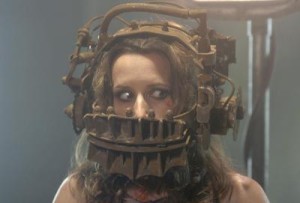
Shawnee Smith’s character Amanda escaped this trap to appear in five more Saw films.
More than just the two men in the room, the story grows to include more victims. Even for those introduced after an encounter with Jigsaw we still get to witness their torment in flashback. These scenes are myriad, from a woman in an iron collar that will tear her skull apart to a man, covered in napalm, having to hold a candle to read writing on a wall.
It’s not just that these victims were going to die in brutal ways (that was de rigueur for horror films since The Texas Chain Saw Massacre), but Saw upped the stakes by combining the suspense of impending horror. It was no longer just a killer behind the door, now there is a ticking clock and when it reaches zero someone will die, and in their last seconds they will harm themselves or others trying to escape.
These types of torment made waterboarding actually seem safe!
Though the creators of Saw would later claim the film was not torture porn, it was clearly the template for the dominant horror movement of the mid-2000s. Saw progressed through the scenes with characters put in increasingly more complex and convoluted traps, and I had the visceral reaction I’d sought. This movie did not scare me as Blair Witch did, but it repulsed me. I would flinch every time the next test came, knowing that the pain inflicted on the characters was fictional, but yet it hit home just the same.
The best part of it was that I was repeatedly asking the question: what would I do in those situations? Would I be able to cut off my own foot to escape a room? Could I kill a man in cold blood if the result was saving my own life? Could I take the pain of the razor cuts and escape the other side? And the absolute worst: could I shove both my hands in a shit-filled toilet to try and find a key?
Yet, a decade later I look back and wonder if subconsciously I made the connection between Elwes’ character, chained in a dirty shit-filled room, with those held in Guantanamo Bay. Neither the fictional character nor the real prisoner know if they will ever see daylight again, and both undergo horrible experiences before it ends… however it ends.
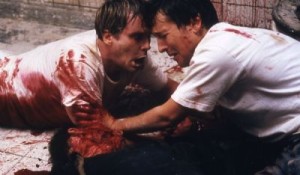
Dr. Lawrence Gordon (Elwes) and Adam Stanheight (Whannell) become brothers in blood on Saw’s dingy bathroom floor.
I can understand why Wan and Whannell would blanch at their hit being called torture porn. Porn usually indicates gratuitous sex (or sometimes action or gore) with no plot. Indeed, Saw has a plot as convoluted and twisted as any of Jigsaw’s traps. It’s clear to me that the two went through a lot of effort to create an involving story. Yet the fact remains that on my first watching I had trouble paying attention to the story for all that was thrown at me. It was a story that would become even more stretched and tangled as sequel after sequel followed, and for its labyrinthine complexity I actually grew to appreciate the franchise more.
Leaving that theater in 2004 I thought Saw wasn’t actually very good, but that’s because I was focusing on the plot (and the various holes it contained). Yet the images of the people in their torment stuck with me for quite some time.
More, as I previously stated, this film’s success created a new horror sub-genre, combining elements of the classic splatter film with the tropes of the slasher horror, yet drawing out the kill scenes in new and inventive ways. From the six Saw sequels to the Hostel films to The Collector to Turistas; each provided a new type of terrible vicarious experience. Truly the most extreme example in this sub-genre must be The Human Centipede — a film that I rejected in concept, but once its torture porn roots came through in the trailer I knew I was in for a treat.
But the genre burned out quickly. By 2009 Saw was clearly over, the sixth installment in the franchise losing a box office battle with the micro-budget found footage film Paranormal Activity. While a few more films, such as Saw: The Final Chapter and Human Centipede II were still to come, the election of President Barack Obama brought with it a shift in media attention away from Guantanamo Bay. That could be coincidence, but it seems more a causation — by the end of the decade humans were tired of facing torture, real or imagined, and preferred supernatural scares on screen. Their votes for political office matched their dollars spent at the box office.
As such, it seems torture porn will remain a symbol of early 21st century American movie-making. Yet out of that sprung some wildly inventive and visceral pictures that may yet inspire a future generation of filmmakers.
Tomorrow — 2005!
Arnie is a movie critic for Now Playing Podcast, a book reviewer for the Books & Nachos podcast, and co-host of the collecting podcasts Star Wars Action News and Marvelicious Toys. You can follow him on Twitter @thearniec
September 3, 2014 Posted by Arnie C | 40-Year-Old Critic, Movies, Now Playing Podcast, Podcasts, Reviews | 2000s, 40-Year-Old Critic, 9/11, Bush, Carey Elwes, Danny Glover, Enertainment, Film, horror, Jigsaw, Movie, Movies, News, Now Playing, Now Playing Podcast, Obama, Podcasts, Review, Reviews, Saw, Shawnee Smith, Terrorist, Tobin Bell, Torture, Torture Porn | Comments Off on The 40 Year-Old-Critic: Saw (2004)
The 40 Year-Old-Critic: Freddy vs. Jason (2003)
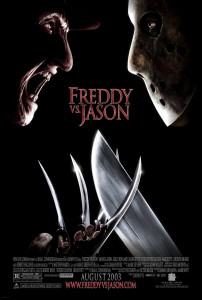 In The 40-Year-Old Critic, Venganza Media creator and host Arnie Carvalho recalls a memorable film for each year of his life. This series appears daily on the Venganza Media Gazette.
In The 40-Year-Old Critic, Venganza Media creator and host Arnie Carvalho recalls a memorable film for each year of his life. This series appears daily on the Venganza Media Gazette.
How many times will I review Freddy vs. Jason? It was one of Now Playing Podcast’s earliest reviews as part of our first retrospective series covering the Friday the 13th franchise leading up to the 2009 remake. Even then we planned to revisit the film and look at it from Freddy’s point of view, which we did the following year during the review series leading up to 2010’s A Nightmare on Elm Street.
By now this should be well-trod ground, and what more could I have to say?
Yet the fact that this is the only movie to be covered twice in Now Playing Podcast retrospectives is indicative of its importance — to film in general and to me personally.
Since our 2010 review I’ve spent a lot more time thinking about the crossover. What is it about two franchises coming together that creates such excitement, especially in the “geek” community? I don’t ask this hypothetically. I personally get swept up in the frenzy when two franchises come together, and it doesn’t even matter necessarily if I like them both! The thought of two universes colliding seems to have a geometric, not additive, increase in interest.
I think to some degree it is fan rivalry at its best. For reasons I don’t understand it seems some fans feel the only way to feel good about their fandom is by putting down others. For example, when Firefly was at its zenith a parade of “Joss Whedon Is My Master Now” shirts filled Star Wars conventions, as if to say, “Star Wars used to be cool.” As such, the “my dad can beat up your dad” mentality started to apply to fan groups; “My stormtrooper can beat up your browncoat.”
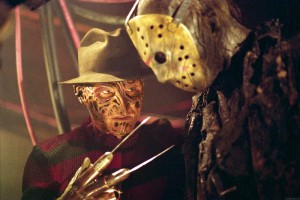
Freddy vs. Jason — whoever loses, the fans win.
That question of who would win in a fight certainly applies to superheroes. In real life, on screen, and online I’ve heard endless debates about which hero is faster, The Flash or Superman. Who would win in a fight, Superman or The Hulk? It is a curiosity, but the chosen winner usually aligns with the speaker’s fan allegiances.
Certainly, speaking of superheroes, comic books have benefited greatly from the crossover. DC Comics had a major hit with its Justice League in 1961, prompting Marvel Comics to respond with its own super team, The Fantastic Four, a move that inadvertently launched the entire Marvel Universe.
Yet, to me, the crossover seemed relegated to just that medium — the comic book. It seemed comics were pulp enough that you could do anything.
Aliens vs. Predator? Sure.
Robocop vs. Terminator? Why not.
Star Trek and X-Men together, you say? Absolutely.
Even rivals Marvel and DC had several crossover series’ that, for instance, led to Superman meeting Spider-Man or Batman fighting the Hulk.
Despite the success and excitement generated by these crossover comics, the concept was rarely conceptualized on film. Universal Studios had done it in the 1940s, when horror icons Dracula, Frankenstein and the Wolf Man came together for the studio’s “Monster Mash” pictures. But Universal owned each property, and when that series ended, crossovers on screen were scarce.
I can recall two that made an impact on me.
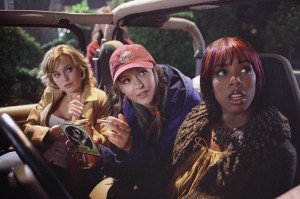
Freddy and Jason aren’t the only names in this cast. Monica Keena (Dawson’s Creek), Katharine Isabelle (Ginger Snaps), and Destiny Child’s Kelly Rowland play teens caught in the middle of the battle royale.
I remember being a young child on vacation with my parents when I saw a trailer for King Kong vs. Godzilla. I had seen numerous Godzilla films, and the 1976 King Kong several times. So the thought of them fighting broke my fragile little mind. I demanded we stay in the hotel room that night so I could watch.
Then, in 1988, Who Framed Roger Rabbit brought together animated characters from Warner Bros., Disney, Turner Entertainment, and more. As I was a teenager, and never really into these characters at my youngest age, the impact was totally lost on me. I saw the film in theaters, thought it was mediocre, and haven’t seen it since.
Beyond those two I can’t think of any groundbreaking crossovers. Some minor ones occurred; such as Star Trek: Generations bringing together cast members from two Trek television series’ (something that had already been done numerous times on Star Trek: The Next Generation, thus lessening the film’s impact). Also, The Monster Squad reassembled the classic Universal Monsters for a kiddie comedy.
But fans wanted more.
So many ideas were teased. Studios knew what we liked, so 1997’s Batman and Robin made sly references to Superman, and 20th Century Fox put an Alien xenomorph skull on a Predator ship in Predator 2. The latter seemed most likely to happen again on film — both franchises were Fox properties in need of a boost. Yet, outside of the Dark Horse comics, nothing materialized for years.
For me, though, more than Aliens and Predators, more than Superman and Batman, Freddy and Jason were the two I wanted to see. Long had the rumor brewed about Hollywood’s (then) top-grossing slashers, Jason Voorhees and Freddy Krueger, going toe-to-toe. I read about it in multiple Fangoria articles in the late 80s and early 90s.
I first saw A Nightmare on Elm Street during a party in 1987, around the time of A Nightmare on Elm Street 3: The Dream Warriors’ release. I found the films so inventive and fun that I rewatched them endlessly, and anxiously awaited each new installment in the series. As detailed during the Now Playing Podcast review, I even cosplayed for the release of Freddy’s Dead: The Final Nightmare. By 2003 I was happy for any new Nightmare, let alone one that pitted villain Freddy against Friday the 13th icon Jason.
I was never as big a fan of the Crystal Lake zombie as I was Freddy, but I did also enjoy the Friday the 13th series. Some of the first R-rated horror I ever saw was Friday the 13th when I came home to find older kids in my house watching it. I tried to join them but the carnage, specifically the decapitation at the end of the 1980 original film, had me fleeing the room. When I finally became a full-fledged horror hound in my early teen years I returned to the franchise when Jason Takes Manhattan was released. While the films lacked the visual panache of the Nightmare series I still enjoyed the films as a guilty pleasure. Over time the series grew in my esteem to be another favorite.

Freddy was killed by fire, but flames don’t slow down Jason.
As such, having both serialized slashers come together would be a dream come true. Or, if done wrong, perhaps a nightmare.
Yet despite the rumors in the horror press and the anticipation by fans such as myself, the killer crossover took 15 years to materialize. Full credit for finally bringing the crossover to screen in the 21st Century must be given to New Line Cinema.
The biggest problem in the 1980s and 1990s was the rights: Jason was owned by Paramount, Freddy was New Line Cinema’s cash cow. The studios tried to work together during the slasher heyday but each wanted to earn 100 percent of the profits by licensing the other’s character. Obviously, that never happened.
Eventually, though, profits started to dry up. Paramount had run Friday the 13th into the ground with crazy concepts like Jason fighting a telekinetic or taking Manhattan. When original Friday creator Sean S. Cunningham wanted to see the franchise continue, specifically with a Freddy crossover, Paramount had no interest. This gave New Line an opportunity. They licensed Jason from Paramount and went to work on Freddy vs. Jason.
While Jason’s creator wanted the crossover, Freddy creator Wes Craven had other ideas. The Springwood Slasher had been given what New Line considered a proper sendoff with 1991’s Freddy’s Dead: The Final Nightmare. But the sequel proved profitable and Craven started planning a return to his iconic franchise. As such, Freddy vs. Jason was put on hold and, instead, Wes Craven’s New Nightmare was made.
Cunningham bided his time, though. In 1993 Jason Goes to Hell: The Final Friday was released and ended with a fan-baiting stinger; Freddy’s glove comes out of the ground and pulls down Jason’s mask. The game was afoot!
We would still have to wait more than a decade for Freddy and Jason to properly share the screen. New Line executives knew the importance of finding the perfect balance between the two famous killers, and so more than a dozen pitches were drafted and subsequently rejected.
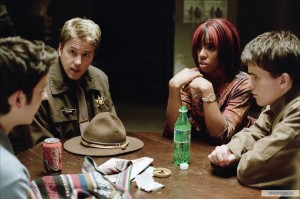
More victims caught in the middle of the killer clash.
Eventually I gave up all hope on Freddy vs. Jason. Nightmare star Robert Englund had not put on the makeup in almost 10 years and I thought Freddy would never grace the screen again. Jason, meanwhile, had gone to space with Jason X (which sat on a shelf for 2 years before its release). Finally, in the early part of the last decade, news — real news — started to come out that the movie was being made.
I honestly believe my excitement for Freddy vs. Jason was on par with my feelings about 1999’s Star Wars Episode I. A countdown clock sat on my computer desktop for 4 months, and when the day finally came I took an afternoon off work to see the first showing.
It met my every expectation.
Directed by Bride of Chucky’s Ronny Yu, the film was outrageous, gory, and over-the-top fun. Both characters got their due (even if Jason inexplicably was suddenly afraid of water) and I couldn’t have asked for more. You can hear a blow-by-blow analysis and both of my reviews at the Now Playing Podcast website, but in short I gave it a strong recommend both times.
Yet loving a movie isn’t enough to garner inclusion in this 40-Year-Old Critic series, there has to be a long-lasting impact. For Freddy vs. Jason, there were two.
First, this film gave Robert Englund a proper Freddy sendoff. It was the best film starring the dream stalker since 1988’s The Dream Master. It cemented a positive feeling for the Nightmare franchise that remains unsullied to this day. Just two weeks ago I had my photo taken with Englund, who was dressed in the full Freddy make-up. I even have ideas for a Nightmare inspired tattoo–the dream killer’s glove slicing into my skin.
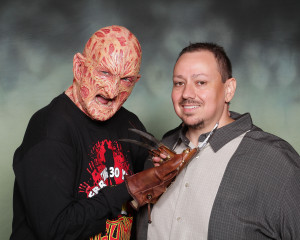
Freddy vs. Arnie — Robert Englund and Arnie pose for a photo at Flashback Weekends in Aug. 2014
Second, though, Freddy vs. Jason’s success launched more than a decade of franchise crossovers. The next year finally saw the release of Alien vs. Predator, which I anticipated every bit as much as Freddy vs. Jason — and which was an utter letdown.
Other pictures released that year include the low-rent, made-for-television crossover Puppet Master vs. Demonic Toys (co-written by Blade and The Dark Knight scribe David Goyer), as well as a return to the “Monster Mash” formula with Universal’s Van Helsing.
Yes, the track record for crossovers wasn’t stellar, but that was honestly my secondary concern — the primary concern was that they were happening. Finally, after decades of teasing, universes were being shared and the world of movies suddenly felt as open as the page of a comic book. But, after 2007’s Aliens vs. Predator: Requiem a shot of adrenaline was needed. I do think the crossover was starting to be seen as desperate, until Marvel Studios took it to the next level.
In 2008 Marvel released its first movie produced in-house: Iron Man. The film stood alone, introducing wide audiences to a superhero that was considered B-list at best. Yet Marvel took a page from New Line Cinema’s book: at the very end Nick Fury showed up to discuss “The Avengers Initiative.” This was the comic book equivalent of Freddy’s hand bursting up from the ground, and Marvel kept its momentum building toward the third-highest-grossing film of all time: The Avengers.
There is a direct lineage from Jason Goes to Hell to Iron Man, from Freddy vs. Jason to The Avengers.
So next spring when you buy your ticket for The Avengers: Age of Ultron (and then download the Now Playing Podcast review) think about the trailblazer that pioneered the modern crossover film: Freddy vs. Jason.
Tomorrow — 2004!
Arnie is a movie critic for Now Playing Podcast, a book reviewer for the Books & Nachos podcast, and co-host of the collecting podcasts Star Wars Action News and Marvelicious Toys. You can follow him on Twitter @thearniec
September 2, 2014 Posted by Arnie C | 40-Year-Old Critic, Comic Books, Conventions, Movies, Now Playing Podcast, Podcasts, Reviews | 1980s, 1990s, 2000s, 40-Year-Old Critic, Avengers, Comic Books, Comics, Crossover, Enertainment, Film, Freddy, Friday the 13th, horror, Iron Man, Jason, Movie, Movies, Nightmare on Elm Street, Now Playing, Now Playing Podcast, Podcasts, Review, Reviews, Ronnie Yu, Sean S. Cunningham, Slasher, Wes Craven | Comments Off on The 40 Year-Old-Critic: Freddy vs. Jason (2003)
The 40 Year-Old-Critic: Attack of the Clones (2002)
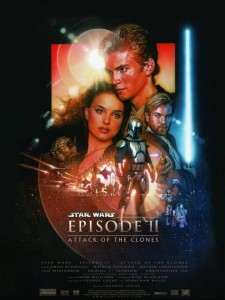 In The 40-Year-Old Critic, Venganza Media creator and host Arnie Carvalho recalls a memorable film for each year of his life. This series appears daily on the Venganza Media Gazette.
In The 40-Year-Old Critic, Venganza Media creator and host Arnie Carvalho recalls a memorable film for each year of his life. This series appears daily on the Venganza Media Gazette.
A week ago, while attending Wizard World Chicago, I had a debate with a Now Playing Podcast listener who claimed Star Wars Episode II: Attack of the Clones was the worst movie in the Star Wars saga. I strongly disagreed.
Not to say I think any of the Star Wars films are bad, per se. I have three tattoos taken from the series. I host Star Wars Action News, a biweekly podcast about Star Wars collecting. I am a devoted Star Wars fan — but I’m also a discerning Star Wars fan that can recognize that those Ewok TV movies are horrible and also distinguish differences in quality among the six films in the saga.
To me, Attack of the Clones was a much needed course correction for the Star Wars prequel trilogy.
To say Episode I: The Phantom Menace left me cold would be a literal truth, as I sat out one night in the freezing rain to get tickets. But it’s also metaphorically true. Perhaps it was how I binged on that first prequel film, seeing it seven times in three days. More, though, I think it was the movie itself. While it boasted the most exciting lightsaber fight in the series, the overall story was somewhat incomprehensible — I had to read various “expanded universe” novels to understand what the Trade Federation was trying to do, and I still think it was stretching. More, the film was completely devoid of humor. The first three Star Wars films had all been fun, with the cocky attitude of Han Solo (Harrison Ford) a centerpiece. Here that sardonic fun was replaced with a walking CGI fish creature stepping in crap.
After The Phantom Menace I slowly found myself drifting away from Star Wars — a major lifestyle change. I had been reading Star Wars novels since 1993, played the video games constantly on my PC, and collected the toys obsessively since 1995. That all peaked with Phantom Menace’s release, when the Toys ‘R’ Us employees informed me that I’d spent the most money of anyone during their midnight toy release, and when I traveled 60 miles every Thursday to get the latest Kentucky Fried Chicken basket topper.
But in the summer of 1999 the glut of Episode I toys clogged shelves. With no new figures found, just the same ones that had been available for months, the thrill of collecting waned and I stopped bothering to look for the next wave of toys. More, I was let down by The Phantom Menace and didn’t wish to dwell on it. I pursued other interests, and stopped buying Star Wars books, toys, and games altogether. It was not a conscious break; when Phantom Menace was re-released in theaters in November of that same year — this time with proceeds going to charity — I saw it again. But that viewing solidified my feeling that my childhood was dead, it was time to move past Star Wars.
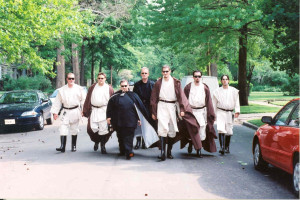
Reservoir Jedi
That stance lasted for a couple years. I even tried to sell my Star Wars collection, only to find that I wasn’t alone. A toy store in Chicago offered me 5 cents for brand new, mint figures — 1 percent of the retail price. He told me no one wanted Star Wars toys, new or old, and that he had a warehouse full of them that he couldn’t sell.
Also during that time my life changed a lot. I met Marjorie, we dated, and eventually moved in together. I also quit my low-paying job and returned to school full-time. We were living off her income and what savings I had put together. Times were tough, bills went unpaid, and there was no extra income to spend on toys. What movies we saw were mostly from the $1 rental bin, not full price theatrical fare.
Despite all this, when the first teaser trailer for Attack of the Clones was released I started to get excited. The trailer was attached to Harry Potter, and so Marjorie and I bought tickets just to see it in the theater. When it played… I was not thrilled. It looked like more of the same that we got in 1999 with Phantom Menace. We were so disappointed we actually left the theater without staying for Potter.
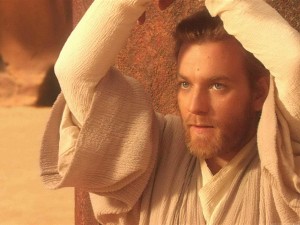
McGregor showed us Star Wars could be fun again.
For me, Star Wars was in a nosedive. But it did pull out, and I remember the moment perfectly. A secret trailer for Attack of the Clones named “Mystery” was released online. A friend came over and he, Marjorie, and I all gathered around my laptop to watch. Another tease, this one focused on an assassin out to get Padme Amidala (Natalie Portman). It showed action, it showed suspense, but best of all it showed humor! It seemed Lucas had realized how dull every character in Phantom Menace had been, and now the sarcastic wit was back courtesy of Obi-Wan Kenobi (Ewan McGregor).
I watched that trailer repeatedly. By the time the third trailer came, my break from Star Wars was over.
But there’s more than that — this film changed my entire life forever.
As mentioned, Marjorie and I were engaged. We knew we were going to get married, but I was hesitating because I was an unemployed graduate student. I had no money, and neither of our parents’ would pay for a wedding. As such, the engagement had no end date, and I hadn’t even scraped the money together for a proper ring. Instead I gave her a placeholder ring that took the last of my cash: $25.
Our excitement for Attack of the Clones grew together; she was as excited for the film as I (and she was nowhere near as hard on Phantom Menace). As such, Marjorie suggested, “What if we have a Star Wars wedding?”
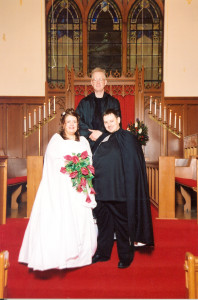
Marjorie, Arnie, and their minister pose for a photo at the wedding.
The thought had occurred to me; I’m not very traditional to begin with, and I considered all weddings to be pomp and circumstance. A tuxedo means nothing to me, nor does a wedding dress to Marjorie. All wedding garb is a costume, so why not make it a Star Wars costume? Plus there was no better time to do it than surrounding the release of a new movie, so a date was set and the Carvalho Star Wars wedding was on.
Her parents were excited. My parents were mortified. We kept certain things traditional — we were married in a church and there were no full-on costumes (I had never heard of the 501st costuming club, if I had I surely would have invited them). As I was the unemployed one I did much of the planning, and I did borrow some money — since repaid — from my godparents to get Marjorie a proper diamond engagement ring; smaller than she deserved but what I could give.
But she had another crazy idea.
The Star Wars Celebration II convention was the weekend before our wedding. As planning had left us stressed, we decided to max out our last credit card and go. I was hesitant; I had gone to a couple conventions in the past but didn’t see the appeal. That said, I had gone only for a couple hours, never an entire weekend. This was a totally new experience, and when we arrived we were immersed in Star Wars. Men in realistic-looking Stormtrooper armor worked security, triggering a latent fear of the men in white. On top of that, celebrities were everywhere; we even had Carrie Fisher (Princess Leia), Billy Dee Williams (Lando Calrissian) and other stars sign our wedding invitation!
Plus, there was new Attack of the Clones footage screened exclusively for convention attendees. We got to see a trailer that parodied Sam Raimi’s Spider-Man, ending with Yoda, lightsaber lit, jumping around like a crazy frog.
I had been excited for Episode II, but now I was practically vibrating with anticipation. I wanted to see Yoda kick ass!
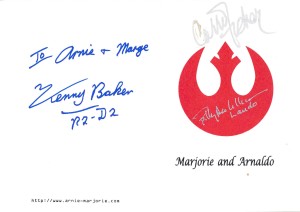
Marjorie and Arnie’s wedding invitation, signed by Star Wars celebrities.
Star Wars Celebration II was a magical weekend bested only by the next one, when Marjorie and I were married. Because of the Star Wars connection local media showed up, and once it hit the AP wire we were known around the country. Our honeymoon in New Orleans felt like a press tour as we woke up every morning at 5 a.m. to talk about our wedding on radio shows, and we were even taken to the local NBC affiliate to appear on MSNBC.
On that honeymoon we went to a midnight screening of Attack of the Clones, which turned out to be one of the worst theatrical experiences in my life. As it was told to me, the theater was showing the film on 16 screens, but had only 4 prints. They were trying to daisy chain the prints from projector to projector, and it didn’t work; the film simply ripped. They had to show the prints to 4 theaters, and the other 12 waited. Finally at 2:30 a.m. the movie started.
I was nervous, what if it was terrible? We were booked to go on MSNBC the next morning, and Marjorie and I had already rehearsed saying, “Loved it!” in unison — lest we look like fools, going on national television about a wedding to tie into a sucky film. The trailers looked good, but after The Phantom Menace I knew there was a risk.
I needn’t have worried. That next morning, when asked by Natalie Morales what we thought of the film, we were honest in expressing excitement. It truly was a return to the Star Wars I’d loved as a child.

The sheer enormity of the clone army excited me.
I’ve seen the movie dozens of times since 2002. Removed from the excitement of the release and the sentiment of our wedding I can clearly see it’s not a perfect film. If ranking the 6 live-action theatrical releases it would be second to last, Phantom Menace at the bottom. I felt the inclusion of Boba Fett as a child was unnecessary to the plot and some of the mysteries never made sense (though at the time I trusted, falsely, that Episode III would answer these questions). Still, the acting was far improved — Portman decided to use her skill this time, and McGregor was a joy throughout. The CGI effects were also better, with the huge battle at the end truly impressing and enthralling me. The lightsaber fight was exciting, and Yoda lived up to my expectations. It has flaws, but was certainly a step in the right direction.
Best of all, it ended with a wedding. Marjorie and I had both gone in spoiler-free and had no idea that we would be married only four days before Anakin Skywalker (Hayden Christensen) and Padme would also tie the knot. To have a Star Wars wedding tying into a new Star Wars film release was one thing, but to be that close to one that also involved a wedding seemed like kismet.

The wedding in Star Wars seemed perfectly timed for our Star Wars wedding.
Though I couldn’t buy Marjorie the ring she deserved, and though the wedding had to be done on a very tight budget, marrying her was the best decision in my life. We have not only shared a life, but we share Star Wars, both through our wedding and now through our podcasts. It would have happened anyway but, to quote Billy Crystal in When Harry Met Sally, “When you realize you want to spend the rest of your life with somebody, you want the rest of your life to start as soon as possible.” Thanks to this movie, it started earlier and has given me more great days than I’d have had otherwise.
More, Attack of the Clones brought me back into the Star Wars fold. I saw it multiple times in theaters, including a trip to Chicago to see it on IMAX — my first IMAX viewing experience. It righted much of what The Phantom Menace wronged.
It brought me back into collecting, as well. New figures were on shelves, but I couldn’t afford them. I finally gave up looking for a dream job and, to pay the bills (and buy a few figures), I took another low-paying temp job. In another unexpected twist, that temp job grew quickly into the career I have today.
And, yes, for our 10th anniversary I finally gave her the ring I wish I could have given her in 2002.
My wife, my work, and my continued love of Star Wars can all be traced back to Attack of the Clones. For that I can forgive its few cinematic flaws and appreciate it for the fun space fantasy that it is.
Tomorrow — 2003!
Arnie is a movie critic for Now Playing Podcast, a book reviewer for the Books & Nachos podcast, and co-host of the collecting podcasts Star Wars Action News and Marvelicious Toys. You can follow him on Twitter @thearniec
September 1, 2014 Posted by Arnie C | 40-Year-Old Critic, Conventions, Now Playing Podcast, Podcasts, Reviews, Star Wars, Star Wars Action News | 2000s, 40-Year-Old Critic, Action, Arnie, Attack of the Clones, Clones, Enertainment, Film, George Lucas, Hasbro, Marjorie, Marriage, Movie, Movies, Natalie Portman, Now Playing, Now Playing Podcast, Podcasts, Prequels, Review, Reviews, sci-fi, Space Fantasy, Space Opera, Star Wars, Star Wars Action News, Toys, Yoda | Comments Off on The 40 Year-Old-Critic: Attack of the Clones (2002)
The 40 Year-Old-Critic: Donnie Darko (2001)
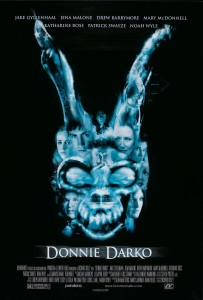 In The 40-Year-Old Critic, Venganza Media creator and host Arnie Carvalho recalls a memorable film for each year of his life. This series appears daily on the Venganza Media Gazette.
In The 40-Year-Old Critic, Venganza Media creator and host Arnie Carvalho recalls a memorable film for each year of his life. This series appears daily on the Venganza Media Gazette.
“You have to watch this movie!” Marjorie exclaimed.
I had just returned home from a very late night at work. I was exhausted and had no idea what she was talking about.
“Donnie Darko. You have to see it,” she told me. “It was on TV tonight. It’s great, but I have no idea what the hell it’s about.”
That, in 2003, was my introduction to Richard Kelly’s directorial debut, Donnie Darko.
I had heard about Donnie, but only in passing. I never knew of its release in 2001; a movie that featured a plane engine crashing into a house was a tough sell just a few weeks after the September 11 attacks on New York City.
The film did catch my eye the following year after it was released on DVD. The title repeatedly popped up at Bloody-Disgusting.com, one of my favorite horror movie websites. Wedged between news articles about Jason X and Bubba Ho-Tep, films for which I had built-in interest, it took several mentions of Darko for me to click the links and read the articles. When I finally did I was confused and slightly put off by the descriptions of a man in a giant bunny suit — I envisioned very low budget, low rent horror from a film with a ghostly bunny.
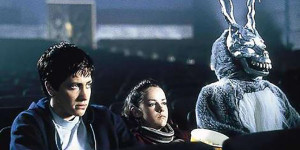
Three’s a crowd when Frank the Bunny comes on your date.
Marjorie’s enthusiasm that night and the online buzz I continued to read convinced me to rent the DVD immediately. I expected straight-up horror, perhaps with a guy in a rabbit suit killing random people.
That was not what I got. Not by a long shot.
First, I wasn’t sure why a website devoted to slasher and horror features spent so much time covering Donnie Darko, which I view as a dramatic sci-fi film. The story invokes concepts of time travel, parallel universes, and psychic phenomena; all delivered in an oblique, theoretical fashion.
When credits rolled I shared my wife’s enthusiastic reaction, but I understood it no better than she did. We talked for hours that night, debating the possible meanings of what we just saw.
What I knew, I knew for a solid fact, was that Donnie Darko was a period-piece teen film. Set in 1988 the story revolves around troubled teen Donnie Darko (Jake Gyllenhaal). On the surface his life looked perfect; he lived in a big house in Virginia, his parents were still together, his older sister was about to enroll in Harvard, and his younger sister was part of the successful dance troupe Sparkle Motion. Yet Donnie is a misfit, full of angst and despair, fighting with all of his family members. He also has weekly therapy sessions where he discusses his sexual fantasies and his fear of being alone.
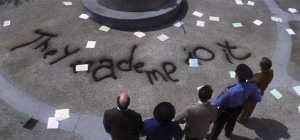
…but who are “they”?
Donnie is smart, his test scores are described as “intimidating”, but at school he has only a small group of friends that discuss nothing more important than the sexual preferences of Smurfs. Early in the film Donnie starts dating the new girl in school, Gretchen Ross (Jena Malone), his first real connection with anyone.
There are some teachers with whom Donnie gets along very well, including science teacher Dr. Monnitoff (Noah Wyle) and English Literature teacher Miss Pomeroy (Drew Barrymore, who also served as executive producer). Both are younger and freer to have open dialogue with their students.
Then there is older health teacher Mrs. Farmer (Beth Grant), an activist who rails against Pomeroy’s teaching of Graham Greene’s short story “The Destructors.” Farmer pushes the school to teach morality based upon the works of motivational speaker Jim Cunningham (Patrick Swayze), who believes everything in life is a choice between love and fear.
Donnie rails against this reductive philosophy, increasing his parents’ view of him as a troubled child.
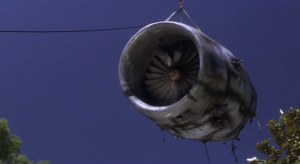
Deus ex machina…a literal God machine.
Taken just as the above, this movie feels like a throwback to classic John Hughes teen fare like The Breakfast Club or Pretty In Pink. It’s the standard tale of a high school student on the precipice of adulthood struggling for free thought in an environment that doesn’t foster such expression. The period-piece setting augments this feeling; the Bush/Dukakis election is referenced, Donnie’s mother reads Stephen King’s It, and the soundtrack features music by Tears for Fears and Duran Duran. There is a large aspect of Donnie Darko that plays just like one of those teen films, and could be taken as such.
But then there’s the jet engine, and Frank the Bunny.
Donnie is a sleepwalker; in the first scene in the film we find him waking up on a hill and riding his bike home. He appears to have been crying.
The next night he is called from his bed by a strange voice. Following it, he finds a man in a strange, dirty rabbit costume, wearing a twisted, frightening, metal bunny mask. This man is Frank, and he tells Donnie that the world will end in 28 days, six hours, 42 minutes, and 12 seconds. We’re not sure if Frank is real or a vision, but it saved Donnie’s life, as that was the night a jet engine crashed into the boy’s bedroom. Had Donnie been there he’d have been killed.
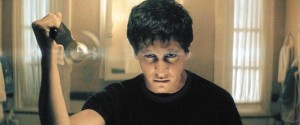
He has a knife in the bathroom. Is Donnie going Psycho?
Every time the film starts to settle into a predictable teen movie routine, something strange happens; Frank appears and gives Donnie destructive orders such as to flood the school or to burn down Cunningham’s house.
Donnie follows the orders, but the audience is left wondering what’s truly happening. Is Donnie a bad kid? Is he having a psychotic break? Is Frank a manifestation of Donnie’s insanity? If the latter is true, then what is with all the talk of time travel and parallel dimensions?
More, each of these bad acts lead to good ends. Flooding the school causes class to be cancelled, and in that free time Donnie first asks out Gretchen. Then, in the ashes of Cunningham’s home, a dungeon full of child pornography is discovered. It’s implied that Swayze’s character may be the head of a kiddie porn distribution ring, and Donnie’s arson helped put an end to it.
Slowly, Donnie becomes convinced that Frank is from the future and that Donnie himself can see future events. He discusses this with Dr. Monnitoff and is given a book, The Philosophy of Time Travel, which precisely details the strange things occurring in Donnie’s life.
Is this the case? Is Donnie insane? Is this all a dream in the character’s head? Is Donnie a stand-in for Jesus?
Simply put, the movie was a mind-fuck. When credits rolled I had no idea what I’d seen, but I knew I enjoyed it.
On Now Playing Podcast I’m often referred to as the critic who places the most importance on story, so it may be unexpected that many of my favorite movies are ones with incomprehensible plots. But I’ve also made it clear on the show that I often love to discuss films more than I love the films themselves. To me, the best movies are conversation starters — films that, as mentioned in True Romance, after watching you can go talk about over a slice of pie.
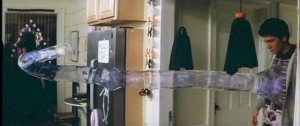
Is this telling Donnie where he will go, or determining his path? If Donnie hadn’t seen this vision would he still have walked this way?
The films need to have a hook; I don’t enjoy every overly dense, incomprehensible, artsy films. There must be some semblance of story, even if the story is not entirely clear. The film also needs relatable characters and circumstances. Having an awesome soundtrack or score, a fun vibe, helps as well.
More often than not this type of film just pisses me off and I never think of it again. But on the rare occasion, when the aforementioned elements come together, the result can be magic. Some other films that embody this include David Lynch’s Lost Highway, Oliver Stone’s Natural Born Killers, and Adrian Lyne’s Jacob’s Ladder. These are movies that stick with me long after the credits roll.
One key to make this type of film come together is the cast. Talented actors, especially familiar faces, can help me feel comfortable when undertaking a strange journey.
I only knew Gyllenhaal as the lead character in the horrible 2001 “comedy” Bubble Boy, and I wrote him off as someone who would never work again. After seeing Donnie Darko, his second lead role, I knew this was an actor with talent and range. This entire film rides on Gyllenhaal’s performance; the character is not only the focus of almost every scene, he’s also going to do illegal and destructive acts. Gyllenhaal gives Donnie a sweetness and vulnerability that makes him sympathetic and genuine. He may be dangerous, to himself or to others, but we want to see him happy.
While I barely knew Gyllenhaal, I was very familiar with his impressive supporting cast. When reading about the film’s low budget, I never expected to see actors I recognized. Yet this cast is full of them. Swayze’s inclusion really helped with the late 80’s vibe, as he was a star at that time with Red Dawn and Dirty Dancing. Mary McDonnell had two Oscar nominations in the 1990s, and soon after Donnie Darko she would rise to prominence again in the rebooted Battlestar Galactica series.
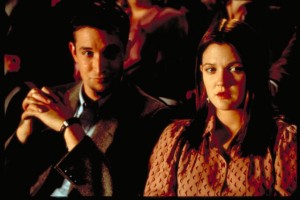
An impressive roster of known stars take bit parts in Donnie Darko.
While those supporting actors were having a lull in their careers at the time Darko was filmed, two stars were at their zenith. Noah Wyle was an actor hot on TV’s ER, and Drew Barrymore was riding high off her career resurgence in Scream.
Credit for this cast, and the film’s own creation, must be given more to Barrymore than Kelly. After Scream, Barrymore had begun a successful producing career with back-to-back hits Never Been Kissed and Charlie’s Angels. Kelly had no luck getting his film produced until Barrymore took on the project, and her involvement helped raise the $4.5 million budget and draw named talent to the project.
All of these elements combined to create an enjoyable movie viewing experience. But what was it about? I felt like I almost got it on my first viewing. Hours of reflection with Marjorie made us each realize a point, a line, which the other had missed.
We watched the film again the very next day, and I got a little more. My impression upon second viewing was that Donnie, a depressed and lonely boy, got to experience one month of happiness and reconnect with his family before he was destined to travel through time and die. I believe it was his destiny to die, but, thanks to unexpected time travel, his death is less tragic than it might have been.
I then spent the entire following day on the computer visiting the Donnie Darko website (no longer online but partially available via archive). Following the example set two years earlier by The Blair Witch Project; the Donnie Darko site was completely in-universe. I could read police reports about Donnie’s 1986 arrest for arson (briefly mentioned in the film), or the newspaper article about pedophile Cunningham’s suicide in the days after the film ends.
The site itself was as dense as the picture, with no obvious navigation. Animations played out on the screen and strange phrases appeared. As a gamer and web designer, the site sucked me in as much as the movie. It was designed perfectly from a psychological standpoint — I would click enough obscure links to get just a drip of information. Like a rat awaiting a treat I repeatedly pushed buttons. I sat at that computer all day, and I remember it well. I didn’t eat, I didn’t move, I just looked for more and more meaning.
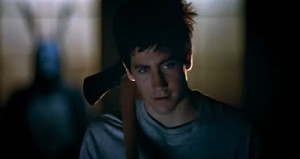
Donnie getting ready for school…
The site was filled with excerpts from the fictional book The Philosophy of Time Travel, written years ago by an old lady Donnie and his friends call “Grandma Death” (Patience Cleveland). The text talked about tangent universes, living receivers, the manipulated living, the manipulated dead, ensurance traps, and more dense terms. No, the site wasn’t here to give me clear answers, but it did aid in my interpretation.
Obsessed, I watched the movie again and this time I thought I had it. I could map the information in the site to the characters on screen. I had an explanation. I didn’t waver from my thought about Donnie experiencing happiness in his final days, but I did start to understand a little more about the mechanics of time travel in this movie, and how Frank the Bunny came to be.
Some may be right to say that films shouldn’t require hours of research to understand. To that I say it wasn’t required, it was desired. The film hooked me enough that I wanted to know more; I had my theories but for me it’s often more interesting to know the director’s vision and intent. Sometimes the intent is ambiguity, but other times they have many ideas but one “truth.”
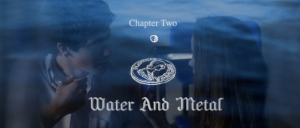
This is not a DVD menu or bonus feature. In the Donnie Darko director’s cut text is put on the screen to try and explain the film to the audience.
Finally, in 2004 I had the chance I missed in 2001 — to see Donnie Darko in theaters. Marjorie and I both drove to Chicago to see the limited release, joined by my Now Playing co-host Stuart, who had not yet seen the film.
The movie had been heavily edited between its Sundance premiere and its wide release. The director’s cut restored 20 minutes of footage, but made even more changes. In what I’m guessing was an attempt to be more accessible for mainstream audiences, Kelly added text to the screen — text taken straight from the Donnie Darko website.
There were other changes, including dialogue and music, but I felt adding the text was going a bit too far. In an effort to be less dense the director had created a weird movie experience that was akin to looking at an appendix while watching. I was happy with some of the scenes put back in the film, ecstatic to see it on the big screen, but in the end I prefer the original cut without the text. I liked the mental challenge of trying to piece this movie together on my own (Similarly, Lost Highway lost some of its appeal when the director went on record stating that film’s “truth”).
Having said that, I’m not certain that even with the text Donnie Darko is so clear-cut. For this review I re-watched the film for the first time in several years. I am a different person in 2014 than I was in 2012; as this review series indicates, I’m becoming more reflective about issues of life and mortality. In this viewing I saw a totally new interpretation of Donnie Darko, one that does involve time travel but also fate, destiny, and the will of God. When I took this as solely a sci-fi drama I missed the spiritual themes that permeate the movie.
In my original thesis, I believed that Donnie needed to connect and feel happiness before his death. But now I see the subtext about “God’s channel” — that Donnie had free will, he didn’t have to die, but to do so was to deny God. Donnie was having an existential crisis; his loneliness came in part because he didn’t want to die and he found no way to believe in anything more than this world. Through the experiences of this movie Donnie not only realizes his role is to die, but he knows it’s his choice to die. He could deny his fate, but in doing so he would deny God’s will. If God has will then there must be a God, and so, reassured and finally finding proof in divinity, Donnie laughs as he takes that next step into the afterlife.
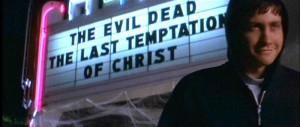
The viewer gets to pick which movie they see through various interpretations of Donnie Darko.
Yet, the more I ruminate on this movie, I would not say my interpretation is the only one. While I think it is what Kelly was going for, so many other interpretations are possible. I would be hard pressed to argue against a reading that Donnie is schizophrenic and having a psychotic episode, as his psychiatrist suggests. I read a theory online that Frank is like The Ghost of Christmas Future and no time travel actually happens, Frank just shows Donnie a vision of what could be. You could say this film is just a take on the theme of the Final Destination films — Donnie was supposed to die and, since he didn’t, Death surrounds him.
The alternate theory, though, that I think Kelly teases most is that there is no such thing as time travel, and this entire move is Donnie’s dream in the moments before his death, in the spirit of An Occurrence at Owl Creek Bridge. This is very clearly given as an option when Donnie and Gretchen go to a two-screen movie house. Do they choose The Evil Dead or The Last Temptation of Christ (which depicts such a dream-in-the-moment-before-death scenario)?
The film’s very final scenes, though, seem to indicate that others in town have a lingering memory, like an almost-forgotten dream in the night, of what Donnie experienced. That realization, that something happened to people other than Donnie, always returns me to my original theory: Donnie had to die, but he got to die after experiencing joy.
Even with this seemingly uplifting message, the movie is horribly sad. I well up every time during the film’s denouement. It’s set to a slow, somber cover of Tears for Fears’ “Mad World” sung by Gary Jules. I had never given that song’s bubble-gum pop lyrics much thought, but this version, mournful and soft, gave the words meaning I’d never considered. It’s the rare cover that makes all earlier versions of the song obsolete (though never, ever listen to the second version on the soundtrack where they added drums and other instrumentation. It is virtually ruinous to the perfect, minimalist recording).
A sequel to this film was released, S. Darko, telling an equally strange and surreal story about Donnie’s younger sister Samantha (Daveigh Chase). That film may contain more answers, but I refuse to see it. It was a studio made product with original creator Kelly having absolutely no involvement, insight, or approval. The director even took to social media to clarify that this was done without him. As such, I will never, ever watch this sequel, for my fear is that S. Darko won’t merely be terrible but, like the previously mentioned remix of “Mad World,” it will permeate my thoughts when I return to the original and ruin my enjoyment.
Donnie Darko changes every time I see it, or perhaps I change every time it sees me. It’s a film that has long moments of Donnie looking into a mirror, and perhaps that’s what I’m doing. In a film this impenetrable it’s easy to project your own thoughts and desires. What I do know is this is an absolute masterpiece of a film that everyone should watch.
When you do, share with me your theories. I’d love to hear them.
Tomorrow — 2002!
Arnie is a movie critic for Now Playing Podcast, a book reviewer for the Books & Nachos podcast, and co-host of the collecting podcasts Star Wars Action News and Marvelicious Toys. You can follow him on Twitter @thearniec
August 31, 2014 Posted by Arnie C | 40-Year-Old Critic, Movies, Now Playing Podcast, Podcasts, Reviews | 1980s, 2000s, 40-Year-Old Critic, Donnie Darko, Enertainment, Film, Mad World, Movie, Movies, Now Playing, Now Playing Podcast, Podcasts, Review, Reviews | 2 Comments
The 40 Year-Old-Critic: Requiem for a Dream (2000)
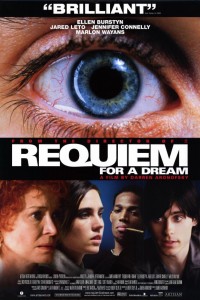 In The 40-Year-Old Critic, Venganza Media creator and host Arnie Carvalho recalls a memorable film for each year of his life. This series appears daily on the Venganza Media Gazette.
In The 40-Year-Old Critic, Venganza Media creator and host Arnie Carvalho recalls a memorable film for each year of his life. This series appears daily on the Venganza Media Gazette.
Have you ever seen a film that you instantly loved, but never wanted to see again? That was my reaction to seeing Requiem for a Dream in 2000.
I was drawn in by director Darren Aronofsky. I had seen his first film, the black-and-white techno thriller Pi, and was enthralled. The use of music, the sophisticated themes, the weird camera angles, the ideas of patterns in everything in life, the repeated sequences that formed a pattern in a movie itself about patterns; all of it left me entranced. I instantly knew Aronofsky was a talent to watch.
I anxiously awaited Requiem’s release, my excitement growing as I read high praise coming out of its screening at the Cannes Film Festival. Being a small film ($4.5M budget) with a very non-commercial NC-17 rating, I knew Requiem would not get a wide release. Sure enough, the picture opened on just 93 screens.
Like a character in an Aronofsky film, I was obsessed with seeing this movie. As such I made plans to visit my Now Playing Podcast co-host Stuart in Chicago, and there we would go see Requiem together.
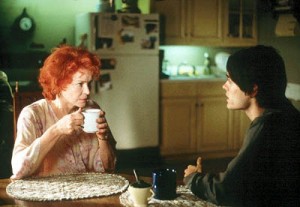
Burstyn and Leto share a rare scene together in Requiem for a Dream.
Based on the novel of the same name by Hubert Selby, Jr., the film follows nine months in the lives of Harry Goldfarb (Jared Leto) and his mother Sara (Ellen Burstyn). Despite the familial relation, the two characters rarely interact; their stories run parallel as we follow their hopes and falls. Starting in “Summer” and ending in “Winter”, the falling temperatures also represent the decline in the characters’ fortunes.
Harry is a heroin addict. He and his friend Tyrone (Marlon Wayans) have hit bottom so many times that stealing Sara’s television to pawn for drug money has become routine. After one theft, followed by a good high at the beginning of the film, Tyrone starts to show ambition –rather than just shooting up, the friends decide to resell some of their drugs to double their money. They have career aspirations of someday dealing a full pound of pure heroin that would set them up for a long time and allow Tyrone to move out of his bad neighborhood.
They start their plan — taking regular pauses to shoot up — and things start to go well. Harry even earns enough money to try to make amends with his mother, and buys her a new, modern television.
In addition to Harry’s burgeoning career as a drug dealer, he is madly in love with girlfriend and fellow junkie, Marion (Jennifer Connelly). The two dream of using their drug money to open a clothing store, allowing Marion to escape her controlling parents. With his money and his girl, things look great for Harry.
Sara, meanwhile, is also finding success. When the film begins she is an elderly widow living alone in an apartment, with little to do but watch self-help television shows. One day her fortune changes with a single phone call: she has been selected to be on her favorite game show. Sara is beyond excited, but also nervous about appearing on national television. A neighbor helps her dye her hair, with unfortunate results. She’s even more distressed after finding out the red dress she wants to wear on the show — one her late husband loved — no longer fits.

Sara starts popping the pills faster and faster to fit in that red dress.
After attempts at crash dieting prove unsuccessful, Sara visits a doctor and begins taking a heavy dose of diet pills. The amphetamines have severe side effects — Sara starts to grind her teeth and can’t sit still — but she loses 25 pounds and feels great. Her looming television appearance has made her the superstar among the retirees in her apartment building and she’s soaking it up.
When Harry brings his mother the new television he instantly knows Sara is tweaking on uppers. He tries to get her to stop, but she is too excited for the game show; even though her obsessive checking the mail for information about her appearance has yielded no results.
If you haven’t seen Requiem for a Dream, if you’ve only read the description above, you might think this is an ugly movie about despicable people. A heroin addict who steals from his own mother? A lonely old woman obsessed with television? A junkie aspiring to become a dealer? In so many movies these characters would be the villains, or at least the antagonists. But Aronofsky is a deft storyteller, and slowly he makes us care for each person on the screen.
Every character is given a touching moment. For Harry and Marion, it’s them lying in bed expressing their affection for each other. They don’t just say “I love you” — rather Harry uses the trite expression, “You’re the most beautiful girl I’ve ever seen.” She responds, telling him she’s heard that a lot, but adds that when Harry tells her it truly has meaning.
More than words, we see that scene through the points of view of both characters via split-screen, allowing for close-ups of Leto and Connelly. This unique approach drives home multiple points: a) they’re together, yet not, b) it’s the first sign that something will come between them, and c) the close-up shots convey intimacy, not isolation.
Then the shots get more inventive. We see Harry talk on one side of the screen, and on the other we see his hand caressing Marion, his thumb brushing over her lips, her palm. Then we see her close-up, and her hands on him. It’s not a sex scene, but this communion between two characters shows their relationship in a much more intimate setting. After only two minutes you want these kids to make it, yet their addiction hangs like a storm cloud.
The same goes for Harry and his mother. While he starts by stealing her television, causing Sara to lock herself in a closet away from her son, he still tries to assure her that everything will be okay. Later in “Summer” we see Harry and Marion on the beach, the man verbalizing how much he loves and cares for his mother and how, now that he has money, he wants to make right every wrong he’s done. It’s a deft turn, but thanks to Leto’s performance and earnest language, Aronofsky has made this thieving drug abuser actually seem noble and good.
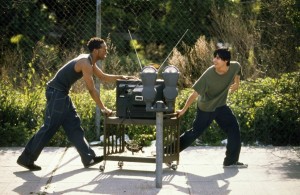
Harry and Tyrone take in some TV.
Tyrone is given the least background of the four, an odd choice considering he is the lead drug dealer. His girlfriend is never named, and his backstory is limited to a bit about honoring his dead mother. Still, Wayans gives a career-best performance in a rare, non-comedic role for the Scary Movie actor. Much of this is due to Aronofsky’s editing — one needs only to watch the deleted scenes on the DVD to realize Wayans tried multiple approaches to Tyrone, including a full-on Jar Jar Binks impersonation.
As shown on screen, Tyrone is the least developed character, yet still a likable personality thanks to the heart Wayans puts into the role.
It’s actually astounding that Requiem makes drug dealing seem like a bright, hopeful career path.
As for Sara, this character may not be one you hate, but one you pity. A virtual shut-in with a television obsession, it is again the script and the actress that makes Sara sympathetic instead of just pathetic. When Harry comes to tell his mother about the new television he asks why she cares so much about the game show appearance.
She responds at first by pointing out to Harry the reverential treatment she has been getting from the other biddies in her building:
“I’m somebody now, Harry. Everybody likes me. Soon, millions of people will see me and they’ll all like me. I’ll tell them about you, and your father, how good he was to us. Remember?”
Then after a pause, an even sadder truth comes out — this television show is all she has to live for.
“It’s a reason to get up in the morning. It’s a reason to lose weight, to fit in the red dress. It’s a reason to smile. It makes tomorrow all right. What have I got, Harry? Why should I even make the bed or wash the dishes? I do them, but why should I? I’m alone. Your father’s gone. You’re gone. I’ve got no one to care for. What have I got, Harry? I’m lonely. I’m old.”
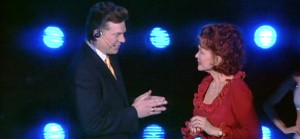
Sara hallucinates a visit to her favorite TV show, hosted by Tappy Tibbons (Christopher McDonald in a memorable minor role).
The obvious answer is right there: Harry could pay more attention to his mother. What she really needs isn’t another television, it’s human connection. But while Harry is desperately trying to be a good son he’s exacerbating his mother’s issue by allowing her to submerge deeper into television, versus helping her to escape it. Despite seeing his mother’s obvious bad reaction to the uppers, this is the last time Harry sees her.
Even with the obvious, unspoken truth of the scene, the monologue could have fallen flat if not for Burstyn’s amazing performance. She jitters while she plays the scene, expressing her agitation from the pills, with a nervousness at being so honest with anyone. She says the lines with a smile, but the sadness comes through in the delivery. Burstyn deserves every accolade she was given for this performance.
Finally, the mood is lightened with humor. When Harry and Tyrone steal the television it’s a joy watching them wheel it past all of Sara’s neighbors, who are more concerned with soaking up the afternoon sun than they are the obvious and strange theft. The characters laugh, joke, and keep the film from becoming too morose.
The combination of the amazing director, actors, and screenplay prevent this story from feeling trite or ugly. When “Summer” ends I was rooting for all four characters to achieve their dreams.
But if that was the summer, soon must come the fall, literally and metaphorically.
For Sara, this comes from her body building up a resistance to the amphetamines. She no longer gets her high from the pills, and though her red dress nearly fits, she needs to continue losing weight. When the doctor won’t up the dosage she self-medicates, taking multiple pills at once.
For Harry, Marion, and Tyrone, their downfall begins when a drug war breaks out in the city. Supplies of heroin have dried up — they can’t get any more to sell, and they can’t get any more to take. Their relationships are stressed, especially by Marion, who seems to suffer the worst withdrawal and blames Harry for her inability to shoot up.
By the time the film gets to “Winter” the movie is no longer a dark comedy. Each character becomes more desperate, and their ends are each so awful that Requiem for a Dream practically becomes a horror film. Yet none of it would work had we not cared for the characters — we would have applauded horrible people getting their just desserts. That I love these people and don’t want to see their ruination is the result of successful, manipulative storytelling of the best possible sort. Aronofsky made me like them, then pulled the rug out from under them — he did the same to us in the audience.

When I left the theater I was shaken and sad. The ending was depressing, but it was just; and I realized that. I felt as mournful as I would for a friend who’d gone down a bad road. This movie was hard — hard to watch, hard on its characters, and hard on the audience. I left the theater knowing I loved every frame of this film but also thinking it was such an emotional trial that I never wanted to watch it again.
I did though, many times. Beyond just great storytelling, Requiem for a Dream is a visual masterpiece that I — after some time passed — wanted to revisit to fully take in.
Aronofsky’s second feature brought back so many of the things I’d enjoyed in Pi, especially the inventive, experimental camerawork. Now, more than a decade later in a time when GoPro cameras are strapped to everyone’s heads, you see the genius in Aronofsky’s self-proclamed “Schnoz cam” — strapping the camera to an actor so the person always stays in the center of the frame while the background and scenery move around them. First used in Pi and then in Requiem, this gave the feeling of a character surrounded by a world out of control — a sign of madness, or a visual representation of vertigo. When sped up film footage is added to the effect, you see that Aronofsky created an entirely new way to deliver the same emotion as the old Hitchcockian “push and pull” change of depth.

Sara finally fit in her red dress, but at what cost?
One of the things that impressed me about Pi was its unique visual style. Despite being very low budget, the use of superimposed images, quick cutting, and repetition was hypnotic. That is also on full display in Requiem. Every time the characters get high, be it by snorting, shooting up, or popping pills, a ritual is performed. The film cuts to a montage that lasts only seconds but shows the actions, and the characters. A lighter is lit, drugs boil, a syringe fills, blood courses through veins, pupils dilate. It all happens so fast that it’s virtually subliminal, yet it tells us everything we need to know. As the film becomes more desperate the montages are even faster, showing us people stuck in a cycle of self-destruction.
Aronofsky also isn’t afraid to get surreal. In the depths of psychosis Sara sees cupcakes floating in the air, her favorite self-help TV personality appears in her living room, interlaced at her television’s 480 lines of resolution. At one point her refrigerator even opens a gaping maw to eat her. These types of shots could undermine the mood but, as done here, they just enhance it.
In addition to the camerawork, enough credit simply cannot be given to composer Clint Mansell. I had the CD from Pi, his first film score, on an endless loop in my car; the electronic techno score was perfect for that film about a computer programmer, but I never would have thought the composer could hit the emotional resonance he did when he reteamed with Aronofsky for Requiem.
As this was a low-budget film, the score was performed by just four people: The Kronos Quartet. Still, with just violins, a viola, and a cello this score permeates nearly every frame of the movie. The low, sonorous tones of the cello dominate and make even the happy scenes foreboding. It’s a gorgeous composition that feels so classical it’s impossible to believe it was written in the 21st century; it feels like the work of Edvard Grieg, or one of Beethoven’s darker works.
The score has such an emotional resonance that it has been the breakout star of Requiem for a Dream; even if you’ve not seen this film I guarantee you’ve heard the score’s climactic movement, “Lux Aeterna.” Just two years later, in 2002, my jaw hit the floor when the trailer for Peter Jackson’s The Lord of the Rings: The Two Towers was scored to an orchestral version of “Lux Aeterna” — the assemblage of instruments and a faster tempo giving the song a more epic feel than the Quartet did alone (This orchestral version is available for digital purchase at Amazon).
In the years since, “Lux Aeterna” has been a go-to track for movie trailers, including Zathura, I Am Legend, Sunshine, The Da Vinci Code and, unlikely as it may seem, it was even used in Barbie doll ads!
Combined, every element of this film comes together as smoothly as one of Harry’s heroin montages. More, the performances, cinematography, and soundtrack all underscore the film’s thesis — summed up in the title — about the lengths to which people go to try and achieve their dreams. No matter what your dream, be it to be a TV star, a clothing shop owner, a screenwriter, or a podcaster, it’s a plight to which everyone can relate.
Aronofsky finally achieved mainstream success and acclaim with 2008’s The Wrestler, and then went on to even greater success with 2010’s Black Swan. I consider that unfortunate. While I like both of those films, the director has never achieved a more perfect theatrical representation of obsession than he did with Requiem for a Dream. And though I’ve yet to see this year’s Noah, my feeling is Requiem is Aronofsky’s best film to date.
Even if I do have to steel myself every time I rewatch it.
Tomorrow — 2001!
Arnie is a movie critic for Now Playing Podcast, a book reviewer for the Books & Nachos podcast, and co-host of the collecting podcasts Star Wars Action News and Marvelicious Toys. You can follow him on Twitter @thearniec
August 30, 2014 Posted by Arnie C | 40-Year-Old Critic, Movies, Music, Now Playing Podcast, Podcasts, Reviews | 2000s, 40-Year-Old Critic, addiction, Barbie, Darren Aronofsky, dealing, Drama, drugs, Ellen Burstyn, Enertainment, Film, Heroin, horror, Jared Leto, Jennifer Connelly, Lord of the Rings, Lux Aeterna, Marlon Wayans, Movie, Movies, NC-17, Now Playing, Now Playing Podcast, Podcasts, Requiem for a Dream, Review, Reviews, The Two Towers | 2 Comments
The 40 Year-Old-Critic: Armageddon (1998)
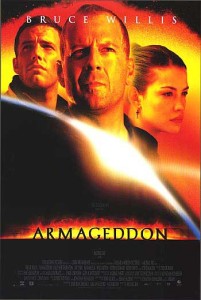 In The 40-Year-Old Critic, Venganza Media creator and host Arnie Carvalho recalls a memorable film for each year of his life. This series appears daily on the Venganza Media Gazette.
In The 40-Year-Old Critic, Venganza Media creator and host Arnie Carvalho recalls a memorable film for each year of his life. This series appears daily on the Venganza Media Gazette.
How Arnie Learned to Stop Worrying and Love the Asteroid
I’ve often referenced Armageddon on Now Playing Podcast, and, shockingly, those comparisons are usually favorable. This has led to many a raised eyebrow and gentle mocking — even from co-hosts who have never seen Michael Bay’s 1998 blockbuster (you know who you are).
So, though 1998 contained many movies that influenced me, from Bride of Chucky to Pi to Your Friends and Neighbors to Very Bad Things, I think I must take the opportunity to discuss Armageddon and explain how Bay changed my perception of action films.
If it helps you to relate to my position at all, I’ll admit that I was skeptical about the movie going in.
First, it was the second giant-rock-destroys-Earth movie of 1998 (it was a comet in Deep Impact). Believe it or not, this idea had been one that petrified me for nearly a decade.
In 1990 I read an article in the newspaper entitled “The Doomsday Rock” which described the likelihood that, eventually, a giant asteroid would collide with Earth and cause the extinction of the human race.
I had grown up with the fear of nuclear Armageddon ending our species, but by 1990 the Cold War was over and I could finally stop worrying. Now came an even bigger fear — at least nuclear war required two human beings to consciously kill everyone, but no one could control or stop a giant asteroid.
I kid you not; I didn’t sleep for days after reading that article. It became my biggest fear: death by asteroid. It’s a terror I’ve learned to live with, but every day I hope that NASA receives the funding it needs to track more of these objects in space; as even NASA’s chief Charles Bolden has said our only current hope is to “pray.”
While the concept was one that scared me, seeing two similar movies came out in the summer of 1998 seemed excessive. Deep Impact beat Armageddon to theaters by more than two months, and it was a deeply moving and touching film. By the time of Armageddon’s debut I thought we’d already seen all the giant rock movies we needed.
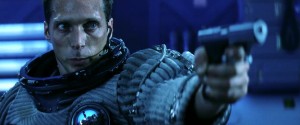
Before seeing Armageddon I could not imagine why an astronaut would need a gun. It’s one of the many improbable plot twists that I ended up going with.
Even more than that, Armageddon‘s pre-release press made the film sound absurd. While ostensibly a disaster film about a big asteroid, I read articles which mentioned scenes showcasing astronauts with handguns. In what world would a gun become instrumental when a giant rock is about to kill all life on Earth? Despite having Bruce Willis as the star, this wasn’t Die Hard; what role would guns play? The astronauts in Deep Impact didn’t need them.
Despite those reservations I still found myself in a packed theater during the film’s Fourth of July opening weekend.
I was drawn in by several factors, starting with director Michael Bay.
Bay had impressed me with Bad Boys, which I thought was the best buddy-cop film since Lethal Weapon, and it marked the first time I saw Will Smith as a movie star. Bay’s follow-up, The Rock, was loud and heavy on explosions, but had some great action scenes for Sean Connery and Nicolas Cage.
And, for the longest time, I thought Bay also directed Cage in Con Air, which was dumb fun. I was likely confused by the fact that Jerry Bruckheimer produced both films. So, despite Bay having no involvement in Con Air, it was still a factor in my seeing Armageddon.
A larger factor pulling me to the theater was the cast. I had been a devout fan of Willis since Moonlighting. I loved seeing him in film; it didn’t matter if it was Color of Night, North, Pulp Fiction, Nobody’s Fool, or even Hudson Hawk.
Next was Ben Affleck, an actor I knew from his work with Kevin Smith, plus his Oscar-winning screenplay for Good Will Hunting. This was his first big-budget epic, and as he was a friend of Smith’s I was rooting for his success.
The rest of the cast — the ragtag group of asteroid drillers — was made up of some of Hollywood’s best 90s character actors, including Billy Bob Thornton, Steve Buscemi, Michael Clarke Duncan, Owen Wilson, and Keith David. I was even happy to see Ken Hudson Campbell, an actor I fondly remembered from his role as the “Animal” emotion in Herman’s Head.
While many of those stars would be launched to greater fame by Armageddon, even in 1998 I thought of this as a “dream team” of performers.
It was very lucky that I did know this cast, as I quickly realized that in Armageddon they were not characters, they were “types.” Affleck was the young hotshot, Buscemi the sardonic genius, Wilson the funny one, Duncan was the big guy who was soft on the inside, and Willis was the tough-as-nails, no-nonsense leader of the pack.
The baggage I brought with me from previous films helped me tremendously, as Armageddon wasn’t going to spend a lot of time developing new relationships or exploring character emotions. This movie was going to put the pedal to the metal and go, go, go.
It opens with a meteor shower demolishing New York City, and from that moment NASA is racing the clock to save humanity. The pace is so fast, Bay never stops the film to let the audience catch its collective breath.
Initially I was put-off by this; here was a movie exploring my deepest fear, yet the characters on screen never worried. They’re laughing, drinking, going to strip clubs and spending money like there’s no tomorrow — because there might not be. What a tonal shift from the dour Deep Impact. Even when we weren’t dealing with the asteroid directly, there were few scenes that didn’t involve a fight or a chase.
When we are introduced to Willis’ Harry Stamper he’s chasing Affleck through an oil-drilling platform, the older man shooting at the younger one. The reason for this homicidal rage? Affleck’s character, A.J., was caught sleeping with Harry’s daughter, Grace (Liv Tyler), and Harry hoped she would do better than a roughneck like her father.
It’s silly. It’s outrageous. It’s over-the-top. I wasn’t sure if I was going with it at all. My consternation only increased as the movie continued through the training montage and other silliness.
It wasn’t the concept of “only the best oil drillers in the world can save us” that put me off. That was standard fish-out-of-water storytelling. Think back to The Last Starfighter, where only a teenage video game player can win an interstellar war. Or in 48 Hours, where a cop needs a convict to catch a killer. Even in The Terminator a waitress had to fight alongside a warrior. This “you’re the only one, even though you’re unqualified” trope was one I’d grown up with, though never witnessed to this extreme.
My problem was I had no idea who these characters were. In a rare slow scene A.J. and Grace enjoy a final picnic, and some erotic animal cracker play, before his spaceflight. When asked if he thinks anyone else is doing that same thing at that time, A.J. responds, “I hope so. Otherwise, what the hell are we trying to save?”
It was a question that resonated with me — in a film full of cardboard characters, why did I care if everyone died?
It started to click, though, in another pre-spaceflight scene. Driller Chick (Will Patton) goes to see his ex and their son. The son doesn’t know his daddy, and a dropped line about a court order implies Chick hasn’t been the best father. But in this moment, at the end of the world, Chick wants to give his son a toy space shuttle. This was a character with very little screen time and no distinguishing characteristics, yet, out of the blue, suddenly he has a backstory: a son, and his own regret.
This is when I had my “eureka” moment. How many times have I seen this story of the estranged father who, just before a moment of heroism, reconnects with his child? Or vice versa? It’s a moment intended to endear us to the character and show an emotional connection, a reason for them to live, or motivation for them to sacrifice themselves.
Be it Nancy saying goodnight to her mother in A Nightmare on Elm Street, Arnold Schwarzenegger’s tender reconnection with Alyssa Milano in Commando, or even Willis’ own Die Hard where he leaves a message of regret for his wife and children, we’ve seen this time and time again. (We’d see an echo of it later in Armageddon between Harry and Grace as well).
The difference is that in those other films the moment is the climax of an emotional relationship, recognition of clarity and regret. But for Chick this is the first sign of characterization he’s given. Did we know he was a bad dad before this second? Did we care?
Through Chick’s sudden storyline I realized this wasn’t a film in the classic sense, it was a two-and-a-half hour music video. The vibe is the same — rollicking rock music (mostly classic rock by ZZ Top and Aerosmith) blared through the theater’s sound system while the characters underwent mental health evaluations and simulated spacewalks.
There were so many Aerosmith songs I wondered if the band (fronted by Liv Tyler’s father Steven) was chosen because Liv was in the movie, or if Liv was in the movie in exchange for Bay being able to raid Aerosmith’s catalog.
Even when the characters go to space and the rock music stops, the bombastic score takes over and keeps the vibe going. But more than just being driven by music, the storytelling methods in a short video and Armageddon are identical.![]()
In a five-minute song there is little time to create a unique character, so tropes and types must be utilized to tell a story.
In Michael Jackson’s “Beat It” I don’t need to know the gang members have families and loved ones, I can bring that to the story myself. In Aerosmith’s “Cryin’” video I don’t need to hear a word to understand Alicia Silverstone is a rebellious teen. I didn’t need to see the kid picked on in school to know he’s a geek in the video for The Offspring’s “Pretty Fly for a White Guy.”
Bay came from music videos, and he trusts the audience to be used to this shorthand storytelling and rapid cutting. This movie was aimed directly at those weaned on MTV. If we have already seen scads of movies that embody a trope, why recreate it?
That’s when it hit me; Bay wasn’t lazy, he was efficient! He trusts his audience to have seen movies with these characters in them before, and thus he can actually get away with just putting tropes in a scene and letting them have their action. Characters can be types instead of people, in a movie that isn’t really about the people anyway.
I already hear, in my own head, the counter of that — that movies should be about people, and that if we don’t care about the characters how can we be excited by the action. It’s an argument I’ve used myself when discussing some of Bay’s later Transformers films.
Yet, I do believe that there should be balance. If all movies were the same, a cinema would be a mighty dull place to visit. There should be room for different types of stories. While two 1998 films told the story of a calamitous collision that ends life on Earth, the way the stories were told make those films as different as night and day.
But, and I cannot stress this enough, what Bay is doing is a tightrope walk. It is a dangerous game to rely solely on hackneyed plots and character tropes. Here, he pulls it off, in large part due to an extraordinarily likable, talented cast that brings more to the screen than they were given on the page.
The director must be given credit here as well. The editing, camerawork, and special effects were all top-notch. Bay knew how to film a scene for maximum adrenaline, and the music made it feel like a party.
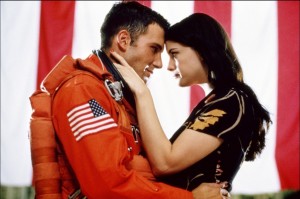
Bay’s go-to image for pride is a giant American flag. It’s not subtle, but there’s no denying it plays in the heartland.
Who knew the end of the world could be so fun?
The film does overstay its welcome, especially in the longer Criterion Collection Director’s Cut where Chick’s same story beat is repeated with Harry visiting his father in a nursing home. Yet, for all the crazy twists and turns the plot takes — and the obvious heartstring-tugging climax — Armageddon is a fun ride. I walked out of it knowing I enjoyed the movie, though I didn’t respect it very much.
As Bay has continued to make movies Armageddon has become harder to defend. With three abysmal Transformers films, plus Pearl Harbor, he’s too easy a target for us critics to hit. Transformers especially took the storytelling methods of Armageddon to their worst extreme, invoking tropes in ways that I didn’t give a damn about.
You can hear my detailed thoughts on those three awful films, plus the fourth not-too-bad one, in the Now Playing Podcast archives.
I may be mostly drawn to films that do provide insights into characters and comment on everyday life though on-screen events. But sometimes I just want escapist entertainment. Armageddon delivers that in spades.
Tomorrow — 1999!
Arnie is a movie critic for Now Playing Podcast, a book reviewer for the Books & Nachos podcast, and co-host of the collecting podcasts Star Wars Action News and Marvelicious Toys. You can follow him on Twitter @thearniec
August 28, 2014 Posted by Arnie C | 40-Year-Old Critic, Movies, Now Playing Podcast, Podcasts, Reviews | 1990s, Action, adventure, Aerosmith, Armageddon, Ben Affleck, Bruce Willis, Enertainment, Film, Michael Bay, Movie, Movies, Now Playing, Now Playing Podcast, Podcasts, Review, Reviews, sci-fi | Comments Off on The 40 Year-Old-Critic: Armageddon (1998)
40 Year-Old-Critic: Chasing Amy (1997)
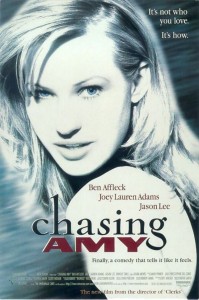 In The 40-Year-Old Critic, Venganza Media creator and host Arnie Carvalho recalls a memorable film for each year of his life. This series appears daily on the Venganza Media Gazette.
In The 40-Year-Old Critic, Venganza Media creator and host Arnie Carvalho recalls a memorable film for each year of his life. This series appears daily on the Venganza Media Gazette.
Kevin Smith is a polarizing figure in cinema. The director certainly has his legion of fans, and having attended several conventions with Smith as a featured guest, it seems those fans are mostly male, mostly under 30, and very willing to connect with his characters; lovable losers such as Clerks’ Randall and Dante (Brian O’Halloran and Jeff Anderson, respectively).
I am not in Smith’s camp, and on Now Playing Podcast I have repeatedly expressed my disdain for his body of work.
Yet allow me in this entry of The 40-Year-Old Critic to praise Smith’s best film, 1997’s Chasing Amy.
Amy (as some fans refer to it) was Smith’s third picture. The director was a Sundance phenom with his black-and-white debut (the aforementioned Clerks) in 1994. It did well in theaters and truly found its audience on video — an audience that included me. Thanks to Quentin Tarantino and Reservoir Dogs, I was paying more attention to indie films, especially those heavily promoted by Miramax. As such, I saw Clerks on VHS and enjoyed it.
As I mentioned in my review of Leaving Las Vegas, around this time in my life I was underemployed and frustrated with my lack of career options, so I related heavily to Dante in Clerks. Plus, I was enraptured by the raunchy jokes. Smith raised the bar on profanity with language that originally earned his film an NC-17 rating. As I did with Beverly Hills Cop before it, I laughed loud and hard at Clerks’ envelope-pushing comedy.
Smith parlayed that success into a studio picture, 1995’s Mallrats. The director spent $6 million of Universal Studios’ money on a movie that barely made one-third that amount. Even as a fan of Clerks I thought Mallrats was too cartoonish, too broad. With new lead duo Brodie Bruce and T.S. Quint (Jason Lee and Jeremy London, respectively), Mallrats tried to replicate the bromance of Clerks in a way that felt forced. More, it seemed Smith’s signature characters of Jay (Jason Mewes) and Silent Bob (Smith himself) would not work in color.
Mallrats would not be Smith’s last failure, but it may be his most fortuitous. First, it established his relationship with Ben Affleck, who had a minor role. Second, after Mallrats Smith returned to his “comfort zone” of small, indie filmmaking. On a $250,000 budget — extraordinarily low but still 10 times that of Clerks — Smith wrote and directed Chasing Amy.
By 1997 I was fully indoctrinated into the Cult of Kevin — as rabid a fanboy as any he’s had. I participated in his online message boards and I watched his first two films regularly (and convinced myself Mallrats wasn’t that bad… it is). Whatever Smith made next I would see. Yet the plot of Chasing Amy I found particularly interesting.

Alyssa (Adams) literally comes between Holden and Banky in this scene.
The film centers around two young independent comic book creators, Holden McNeil (Affleck) and Banky Edwards (Mallrats’ Jason Lee). The best friends find their relationship strained when Holden begins a romance with lesbian comic creator Alyssa Jones (Joey Lauren Adams; Smith’s then-girlfriend), spurring jealousy in Banky.
To me, the film seemed to be jumping on the bandwagon of “queer cinema” which had started to gain steam in the mid 90s. While mainstream Hollywood acknowledged gay characters in movies like Philadelphia and The Birdcage, it was really indie films that brought them to the fore, with such groundbreaking fare as My Own Private Idaho, The Crying Game, and Kiss Me, Guido.
Specifically, I saw in Chasing Amy echoes of Guinevere Turner’s Go Fish — a film Smith acknowledges as inspiration. Sexual preference felt like an exciting new frontier for films to tackle and, having seen all the ones I just mentioned, I likely would have seen Amy even with a complete unknown behind the camera.
I was actually a bit nervous to see Smith tackling LGBT topics. This was a straight man with a penchant for raunchy humor. In Clerks, for example, lead character Dante slut-shamed and dumped his girlfriend after finding out her sexual history. I wondered if Smith would use Alyssa’s sexuality as a source of humor, or to titillate his built-in male audience.
I was happily wrong. Chasing Amy is an exquisite balance of comedy and drama. The start of the film is right in line with Clerks’ humor, as militant black comic creator Hooper X (Dwight Ewell) dissects the racist undertones of the Star Wars trilogy. It was great fun, like a geeky twist on Tarantino’s Like a Virgin deconstruction in Reservoir Dogs. But the humor is nuanced. It’s quickly revealed that not only is Hooper’s rage an act to sell his comics, but he is also a closeted gay male and close friend of Banky and Holden.
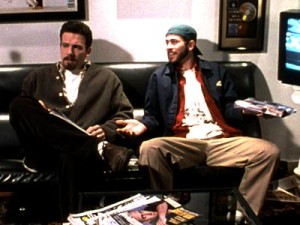
As Holden and Banky, Affleck and Lee created a genuine on-screen friendship. It was one my friends and I related to…until the final twist.
The latter two characters would be familiar to Smith, and not just because both Affleck and Lee appeared in Mallrats. In Clerks, Mallrats, and again here, Smith features the same central duo: immature twenty-something white males with potty mouths. The primary character is more serious, contemplative, semi-neurotic, and dealing with relationship issues. The sidekick is wacky, always given the movie’s funniest lines, but given short shrift in the plot. Here, Holden was our Dante/Quint, and Banky was our Randall/Brodie. The jokes were raunchy and familiar, and the laughs hit hard.
More, Smith seems to know his audience. Any homophobes in the theater get their say through Lee, who spouts gay slurs and stereotypes throughout the film. Featuring gay characters in a positive light, and having Banky spout ignorance, was a subtle way of Smith attempting to educate a more narrow-minded contingent of fans.
Chasing Amy slowly changes tone, though. While all of Smith’s films had dealt with romantic relationships, none had been a romance film. Amy becomes that as Holden befriends unobtainable Alyssa. Their friendship is tinged with longing, and not just on Holden’s side — Alyssa’s feelings for a man make her question her own sexual identity. The scene where Holden confesses his feelings, followed by a rain-soaked argument, is moving and engrossing. There is barely a laugh to be had, and shows a maturity not before seen in a Kevin Smith film.
The film takes continued twists and turns, and jokes keep coming, but Smith had sharpened his humor into a blade, using it to cut the tension of many tense, dramatic scenes. The audience, engrossed in this tumultuous relationship full of self-doubt, would find their laughter a welcome release — the film allowing us to breathe again.
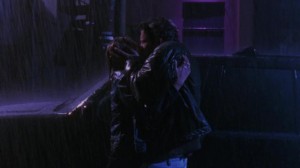
This kiss in the rain was Alyssa finally giving into her feelings for Holden. In most films that would be the end, but here it’s only the beginning of a journey full of self-doubt and jealousy.
While the romantic comedy fan in me was enjoying the Holden/Alyssa relationship, I was also empathizing greatly with Lee’s Banky. I was in my mid-20s and I had lost many friends to their girlfriends. I was all-too-familiar with the pattern of friends who hang out when they’re single, and then don’t return your calls when in a relationship. I saw Banky losing his lifelong friend to a new relationship, and, for the first time ever in a Smith film, I felt bad for the sidekick. Smith had finally created a supporting character with his own arc.
Holden and Alyssa’s relationship eventually hits the rocks when Holden finds out Alyssa was not always gay. The climax (so to speak) comes when Holden, desperate to save his friendship and his relationship, proposes a three-way to both Alyssa and Banky.
That was where the film took things too far. Until that point I felt Smith’s film had portrayed characters acting in ways that felt honest. This twist seemed to be the writer/director choosing to go with a wacky ending over a heartfelt one, or maybe he just wrote himself into a corner and couldn’t find a more earnest resolution.
The group sex idea felt totally outside the realm of Holden’s character. More, that Banky agreed, seemed to me a full character betrayal. I had completely understood Banky’s disappointment with a friend ditching him for a new relationship — it’s a real, common occurrence among single male friends. That Smith chose to write that entire emotion as based in latent homosexuality felt like a missed opportunity — an honest look at friendship was undermined by turning one character into a stereotypical gay male predator.
The film does recover from that moment, with an ambiguous ending that reminded me of The Graduate. Despite my disappointment with the final twist, the movie overall remained an on-screen romance that came across as honest and real. I left the theater entertained and believing Smith would be the next great voice of cinema.
He tried. His follow-up film, Dogma, attempted to analyze religion the way Amy deconstructed relationships, but to lesser effect. While amusing, the picture is scattered and scatological.
But it was with his next effort, Jay and Silent Bob Strike Back, that I realized Smith was not an auteur with things to say, but a writer of increasingly insipid comedy. I first saw Smith speak at a convention in 2001, followed by a preview screening of Strike Back, and I realized he was a more amusing speaker than filmmaker.
History would prove that assumption true, as Smith is now an accomplished podcaster, while the best thing I can say about his post-Strike Back films is that there aren’t many of them.
I have seen all of Smith’s directorial efforts, always hoping to see even a hint of the filmmaker that made Chasing Amy. But from Jersey Girl to Zack and Miri Make a Porno to Cop Out and even Red State, Smith has become a serviceable, but completely unexceptional, director of (mostly unfunny) comedies. I would characterize Smith’s later directing work as on par with Tom Shadyac or Steve Carr. If you don’t know those names, you can look them up, but had Smith not been an indie darling in the mid 90s I don’t think you’d know his name either.
I don’t mean that to say Smith is a one-film-wonder, still coasting on Clerks, because I have gone back and watched his directorial debut — it doesn’t hold up. Jokes that pushed the envelope in 1994 now seem almost tame. More, Clerks is less a film than it is a series of sketches loosely tied together. I loved it when I was the characters’ age and related to their Generation X angst, but it is a movie with limited appeal that is quickly outgrown.
I had hoped that after Cop Out’s critical drubbing Smith might — as he did after Mallrats’ failure — return to his roots and make more personal films. That hasn’t happened. While he has done more low-budget films, such as Red State, it appears the filmmaker who made Chasing Amy is gone forever.
It is a shame. With Chasing Amy Smith showed himself to be a talented writer who could balance both comedy and drama with equal measure. It remains a go-to film when I want to laugh, one of the most honest romances caught on screen, and a progressive view of LGBT characters in cinema. Yet it’s the only Kevin Smith film I can recommend.
Tomorrow — 1998!
Arnie is a movie critic for Now Playing Podcast, a book reviewer for the Books & Nachos podcast, and co-host of the collecting podcasts Star Wars Action News and Marvelicious Toys. You can follow him on Twitter @thearniec
August 27, 2014 Posted by Arnie C | 40-Year-Old Critic, Movies, Now Playing Podcast, Podcasts, Reviews | 1990s, 40-Year-Old Critic, Ben Affleck, Chasing Amy, Comedy, Comic Books, Comics, Drama, Enertainment, Film, GLBT, Jason Lee, Kevin Smith, Lesbian, Movie, Movies, Now Playing, Now Playing Podcast, Podcasts, Review, Reviews, Romance, Romcom | 2 Comments
The 40 Year-Old-Critic: Scream (1996)
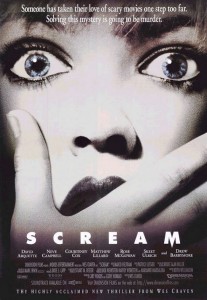 In The 40-Year-Old Critic, Venganza Media creator and host Arnie Carvalho recalls a memorable film for each year of his life. This series appears daily on the Venganza Media Gazette.
In The 40-Year-Old Critic, Venganza Media creator and host Arnie Carvalho recalls a memorable film for each year of his life. This series appears daily on the Venganza Media Gazette.
What’s your favorite scary movie?
As I mentioned in previous reviews of Love at First Bite and Hellbound: Hellraiser II, I have always been a horror fan.
As a very young child I loved the fear I felt toward forbidden cinema, and as I aged I came to see the humor, thrills, and scares in the genre. In my 20s, though, my love of horror changed. I had grown up and no longer had exciting nightmares starring Freddy Krueger. To me, there were no more mysteries in the world, and no more scares to be had on screen.
This problem was exacerbated by a lack of exciting horror in theaters. The slasher craze of the 80s had waned with Friday the 13th Part VIII: Jason Takes Manhattan and Freddy’s Dead: The Final Nightmare. By the early 90s the genre seemed to be gasping its last breaths; Jason Goes to Hell: The Final Friday was the 1993’s top-grossing horror film with only $15 million — nearly tying Manhattan’s $14 million for a series low. A year later the only notable horror release in theaters was Wes Craven’s New Nightmare. By the time The Mangler and Halloween: The Curse of Michael Myers came and (quickly) went, it seemed the bloody fun of the cinema was gone.
At the same time Hollywood was failing to launch new horror stars on screen. The first Leprechaun was released to little fanfare, and audiences simply laughed off Dr. Giggles.
I still enjoyed horror where I could find it, but that was mostly on direct-to-VHS releases. There was the occasional gem, such as Return of the Living Dead 3, or Tales from the Crypt Presents Bordello of Blood, but it was largely a parade of dreck.
I thought horror was dead.
But like any good villain, horror came back from the dead in the holiday season of 1996. The best gift I received that Christmas was an unexpected revival! Suddenly horror was cool again, and the film that made it happen was Scream.
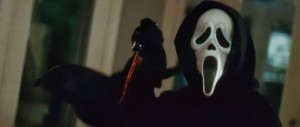
If Ghostface had narrowed the scope to “What’s your favorite scary movie from 1990 to 1995” I think his victims would still be trying to find one.
Even though I’d let my Fangoria subscription lapse, I’d kept up with horror film production in the 90s. I knew that Wes Craven, creator of the A Nightmare on Elm Street franchise, was working on a new slasher film… and I wanted nothing to do with it.
Though I idolized Craven growing up, due exclusively to the Nightmare series, the director’s later works were crap.
I was unimpressed and felt betrayed by Craven’s incoherent and bloodless 1989 slasher Shocker — though I have since come to love the film for the over-the-top “schlocker” that it is. Then in 1991 I raced opening weekend to see The People Under the Stairs, and was simply bored.
I still didn’t learn. I became ecstatic when I heard Craven’s next film would be a return to the Elm Street series, the director promising to make Freddy frightening once again. When I walked out of Wes Craven’s New Nightmare I felt I had seen my last Craven film. You can hear my full New Nightmare review in the Now Playing Podcast archives, but I truthfully wondered how I ever idolized this man who seemed able to only make terrible movies.
That line of thought was cemented with 1995’s Eddie Murphy horror comedy Vampire in Brooklyn, a film I saw out of devotion to Murphy, not Craven.
So in 1996, hearing Craven was going to make a new horror film was actually a turn-off. In ‘96 I would have rather gone to theaters to see Lawnmower Man 2: Beyond Cyberspace than Craven’s Scream.
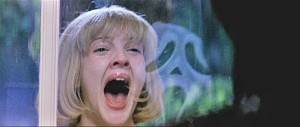
Scream turned Barrymore into an A-list star once again.
The cast did nothing to change this impression. Press materials touted Drew Barrymore’s role, and that seemed a bad sign. Back then she was still the little girl from E.T. who, like so many child stars, had developed a dependency problem. While I had seen her work in Boys on the Side and Mad Love I thought her heyday was behind her; the only roles she had in major releases were bit parts in Wayne’s World 2 and Batman Forever. She seemed “over” in Hollywood. I would never have guessed that, thanks to Scream, Barrymore was poised for a return to superstardom.
The rest of the cast — actors I’d not heard of or knew only from television shows — also failed to grab my attention. The only cast member that caught my interest was Matthew Lillard, whose zany performance I’d loved in Hackers, yet that was not near enough for me to want to see this movie in theaters.
Most of all, the film’s trailers didn’t hook me. I thought the killer’s mask was silly — had Michael Myers and Jason Voorhees taken all the good killer masks? I admit I was intrigued by the thought of characters that knew horror movie tropes; I mean, this was a horror movie where the characters were people like me. Still, with Craven’s name on the poster I wanted nothing to do with it.
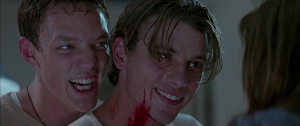
Lillard would go on to the Scooby Doo films after himself being unmasked as the bad guy in Scream.
I saw Scream in theaters only because I was invited by a group of friends and my options were to go to this movie or stay home alone. I wasn’t happy about going, and I anticipated a wholly miserable People Under the Stairs type of experience.
To say I was won over is an understatement. The film did have a good deal of true horror, with the opening murder scene a suspenseful highlight. With the scares firmly established, the movie achieved a near-perfect balance between self-referential humor and legitimate tension. While, due to my age, I was not afraid, the film did succeed in making me jump a couple of times.
In 2011 I gave my full review of Scream as part of our retrospective series leading up to Scream 4, so I will not repeat myself here. You can listen to that full review for a blow-by-blow analysis by Stuart, Marjorie and myself.
In short, not only did Scream win me over; I feel it is Craven’s best film — even better than my beloved A Nightmare on Elm Street.
I believe Craven was greatly assisted by the script from first-time screenwriter Kevin Williamson. Having seen many films made from Craven-penned scripts, none come near Scream in terms of plot twists, fleshed-out characterizations, and careful plotting. The movie was a whodunit, something I didn’t expect in a slasher. After all, in most slashers I knew the killer was Freddy or Michael or Jason or Chucky. That the killer was one of the kids was a fun experience — me trying to outwit the characters and peg the killer. When the mask is removed and the full story revealed, even I was taken aback by some of the twists. This is all Williamson, and I give him full credit for the film’s quality.
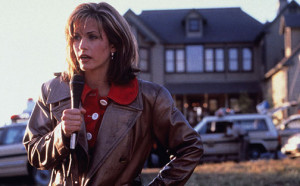
I watched Friends, but never saw Cox as a good fit for horror. Again, I was wrong.
Yet I cannot overlook Craven in the director’s chair. While the script was great, Craven brought two decades of horror experience to Scream. He knew how long to hold a moment, how to reveal a body, and how to build tension that would climax with a jump scare.
My heart was racing as I left the theater. This was the first great original horror film I’d seen in many years, yet had I known the long-lasting impact Scream would have, my exuberance would have been even greater.
The movie went on to make nearly $175 million on a $15 million budget, reminding Hollywood that a good horror movie can provide substantial returns.
Scream single-handedly revived the entire horror genre. The next year gave us not only Scream 2, but also — thanks to Williamson’s success — the enjoyable, but forgettable, I Know What You Did Last Summer.
We also got the Wes Craven-produced Wishmaster, which I saw in theaters and found a weirdly awful throwback to the days of Leprechaun.
By 1998, other studios had caught on and the post-modern, self-aware horror film had its heyday with Bride of Chucky, Halloween H20, Urban Legend and The Faculty. The quality was mixed, but all were far better films than Lawnmower Man 2 or The Curse of Michael Myers.
Scream made me appreciate Craven’s ability, but even more its success spawned dozens of films I’ve enjoyed over the past 20 years. For that reason alone, if not just for the movie itself, Scream might just be my favorite scary movie.
Tomorrow — 1997!
Arnie is a movie critic for Now Playing Podcast, a book reviewer for the Books & Nachos podcast, and co-host of the collecting podcasts Star Wars Action News and Marvelicious Toys. You can follow him on Twitter @thearniec
August 26, 2014 Posted by Arnie C | 40-Year-Old Critic, Movies, Now Playing Podcast, Podcasts, Reviews | 1990s, 40-Year-Old Critic, A Nightmare on Elm Street, Enertainment, Film, horror, Kevin Williamson, Movie, Movies, Now Playing, Now Playing Podcast, Podcasts, Review, Reviews, Scream, Slasher, Wes Craven | Comments Off on The 40 Year-Old-Critic: Scream (1996)
40 Year-Old-Critic: Leaving Las Vegas (1995)
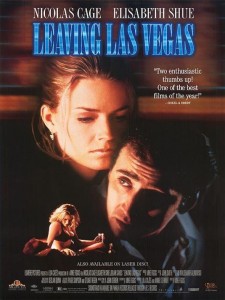 In The 40-Year-Old Critic, Venganza Media creator and host Arnie Carvalho recalls a memorable film for each year of his life. This series appears daily on the Venganza Media Gazette.
In The 40-Year-Old Critic, Venganza Media creator and host Arnie Carvalho recalls a memorable film for each year of his life. This series appears daily on the Venganza Media Gazette.
Have you ever had the feeling that the world’s gone and left you behind….
More than any other form of art, films have a soul. Moviegoers can experience a picture on more than an intellectual level; sometimes there is a base, emotional connection. Watching a great film can be akin to falling in love.
This is a view I first articulated while reviewing Gus Van Sant’s 1998 remake of Alfred Hitchcock’s Psycho for Now Playing Podcast (part of our Fall 2012 donation drive, that review is no longer available). That film showed two talented directors could take the same script, sometimes even the same camera shots, and produce different results. One filmmaker created art that engrossed and thrilled audiences, while the other produced a rote, mechanical and generic film.
Tens, hundreds, or even thousands of people — depending on the scope of the production — come together to create a single experience for a viewer. Even I sometimes forget this; the auteur theory takes hold and I focus on the director as sole creator of a vision. While the director usually maintains creative control, sometimes even through the editing stages, the movie itself is the result of millions of little decisions made by every actor, set dresser, composer, editor, and cameraman on the production. With the right people involved even the most mundane script can become a memorable experience.
One prime example of such a script elevated by those working on it is Leaving Las Vegas, the 1995 drama directed by Mike Figgis, starring Nicolas Cage and Elisabeth Shue. On paper, this movie seemed like the most trite of stories — depressed drunk Ben Sanderson (Cage) is a Hollywood screenwriter whose penchant for drink has ruined his every personal and professional relationship. When he is finally fired from his job he is ready to die, so he takes the last of his cash to Las Vegas where Ben plans to drink himself literally to death. In Vegas Ben hires a prostitute Sera (Shue), the damaged hooker with a heart of gold. The two lost souls fall in love, yet neither is willing or able to change their self-destructive habits.
These character tropes are so hackneyed that I would expect this to be a film made in the 1930s, when stories and characters were broader, and not the 1990s.
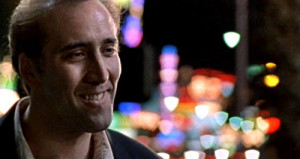
Cage in one of his more charming scenes, back-lit by the lights of the Vegas strip.
The film is based on a novel by John O’Brien. I have not read that book, but I have no doubt of O’Brien’s commitment to the material. Two weeks after discovering Leaving Las Vegas was to become a film, O’Brien used his gun to commit suicide. Clearly this was a man who understood the struggle with depression and the impulse to kill yourself. Yet, despite the insight his prose may offer, I have no interest in reading a book about two stereotypical characters going through a depressing endeavor. It may be very well written and I may be missing out, but the story itself sounds uninteresting.
Yet, despite cliched characters and a tired plot, in the hands of these filmmakers the result is a dramatically moving experience. Few movies I’ve seen in my life parallel the emotions stirred in me by Leaving Las Vegas, for what this team did, through filming and editing, was craft a film where the plot matters less and the characters matter more.
The tale is about a drunk, and the editing and filming often give the film a fugue-like ambiance. Sometimes the dialogue is crystal-clear, loud and in full focus. Other times the music mix raises. Sometimes you hear nothing as the actors’ lips move, other times there are words but you cannot make them out. It’s a dream-like experience that reminds me of techniques used by David Lynch.
The impact of the music cannot be overstated. The score, composed by Figgis himself, sounds like music played around 2 a.m. at an upscale bar. Heavy with piano and saxaphone, the music has a slow jazz feel that underlines the emotions of the moment. More, in an unusual move, some of the score is lyricized and sung by Sting. It blurs the line between soundtrack and score, but in the process creates sorrowful ballads of love and loss. Those original compositions intermix with covers of classic songs, such as “Lonely Teardrops” sung by Michael McDonald.
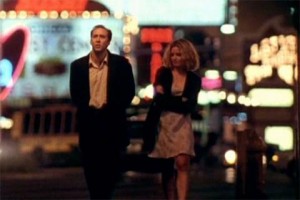
The sounds of the street often drown out character dialogue, to great effect.
The result sometimes feels like a depressing music video or an “in memoriam” montage, played while the characters still live. That Figgis is so willing to part with dialogue and just convey mood shows that in Las Vegas plot doesn’t matter. This is a character-driven story and we don’t need to hear their words to feel their pain.
This type of disregard for traditional narrative is used at the micro and macro scale. Sometimes the film cuts to the future suddenly, and we return to the present when Ben comes out of his stupor. We learn about the missing moments when Ben asks what happened. This is a movie told primarily from Ben’s shaky, out-of-focus point of view, and the camerawork and editing embody that mindset.
More than the cinematography, this film hops in and out of Ben’s own head. Sometimes we see Cage saying outrageous things, but then we discover it was only a fantasy in the character’s mind. In contrast, sometimes Ben makes equally offensive statements out loud and faces the very real consequence. As his blood alcohol content rises Ben cannot distinguish reality from fantasy, and, like Ben, the audience never knows exactly what is happening and what we can believe.
Of course, Figgis could not accomplish this alone. In the hands of a lesser actor than Cage Leaving Las Vegas could become an unintentional comedy quickly forgotten. Now, 20 years later, Cage is often disregarded, written off due to a long string of bad movies in which the actor makes unfortunate character choices.
Cage is an actor who gets off on playing characters in unconventional ways and giving them strange mannerisms. Often that will alienate the audience, but in Leaving Las Vegas Cage commits totally to the role. His body language exudes desperation. In one of the movie’s first scenes Ben is unintentionally sober, craving drink, and hitting up some colleagues for cash. He comes off sweaty, clumsy, and off-putting. One scene later, after a few drinks, Ben has an undeserved, over-inflated sense of self-confidence and makes improper advances on an attractive woman at the bar. It’s a wild swing of character, and is played perfectly through Cage’s intonation, eye work, and mannerisms.
This type of character could alienate audiences. Had viewers seen Ben as more creepy than sympathetic the result could be quite different. It’s little moments Cage plays, such as sobbing “I’m sorry” when being fired, that show humanity in this sad soul. It makes him someone we feel for, rather than pity.
I was a fan of Cage’s coming into Leaving Las Vegas, with Guarding Tess, Trapped in Paradise and Wild at Heart as highlights (though I’d also suffered through Kiss of Death, It Could Happen to You, and Amos & Andrew). Cage often gave captivating performances, but none I’ve seen before or since match his Oscar-winning performance here.
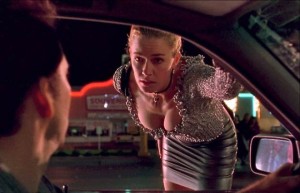
Despite how they meet, the relationship between Ben and Sera is about love, not sex.
Matching Cage’s portrayal is co-star Shue. In her roles in Back to the Future 2, Adventures in Babysitting, and even Cocktail I’d found the actress to be capable, but unexceptional. As Sera, Shue shows a range I’d never seen before. Early in the film Sera is a hooker, and very good at her job — she instinctively knows what the John wants, and becomes it. With Ben we see Sera start to open up. She lets down her guard, takes off her make-up, and becomes a real person. The transformation is startling, as is Shue’s lack of vanity in several unflattering scenes.
But Sera is not your normal streetwalker — she also has regular visits to a therapist. In these scenes we get to see inside Sera’s thoughts through monologues, confessions taken from her therapy session. As edited, these moments play like scenes from the confessional booth in MTV’s The Real World, but without them we would never be able to trust Sera. We never see the therapist; Shue is giving brief one-woman performances, but conveying pure emotion. This is a challenge for any actor, and she pulls it off. Shue fully deserved her Academy Award nomination for this performance.
Together Cage and Shue create a wholly believable, wholly dysfunctional, couple. Both broken characters are instantly drawn to the other. Though Sera knows Ben may be trouble, she puts that aside and chooses to follow her heart. The film avoids making their relationship too gross or base by actually, and believably, removing sex from the equation–while Ben hired Sera for physical gratification the liquor prevented him from performing. He becomes the only character not sleeping with Sera, even choosing to sleep on the sofa at night despite Sera’s repeated offers of more.
These two share a chemistry and a spark on screen that few romantic films can match. Though it’s a futile hope, it’s easy to root for these two to overcome their hardships through their new-found love.
Those two actors are the primary cast but even the minor roles are perfectly played by actors you’ll recognize; from Steven Weber (Wings, Stephen King’s The Shining), to comedian Richard Lewis, to Laurie Metcalf (Scream 2, Roseanne). It could almost be a drinking game — take a shot when you see an actor you know. With French Stewart, Shawnee Smith, R. Lee Ermey, Mariska Hargitay, and even, in the thankless role of bank teller, License to Kill’s Carey Lowell, you would be as drunk as Ben when credits roll.
No one on screen breaks the mood. Figgis has created his own Vegas, sometimes romanticized, sometimes demonized, but always real.
 Leaving Las Vegas is a film with layers. On the surface, taken literally, the plot is about a terminal man and the woman who loves him as he dies. In such a bland interpretation, Sera is nothing but a fantasy, a female who serves a man’s needs. Sera describes herself as being instinctively able to become what her clients want, and she does that for Ben. Early in the film the drunk fantasizes of a woman pouring liquor on herself so he can drink off her, and she would have purpose. Ben never tells that to Sera, but she does that for him — alcohol and sex, Ben’s fantasy realized. Ben calls Sera, “my Angel”, and you could see her as nothing but.
Leaving Las Vegas is a film with layers. On the surface, taken literally, the plot is about a terminal man and the woman who loves him as he dies. In such a bland interpretation, Sera is nothing but a fantasy, a female who serves a man’s needs. Sera describes herself as being instinctively able to become what her clients want, and she does that for Ben. Early in the film the drunk fantasizes of a woman pouring liquor on herself so he can drink off her, and she would have purpose. Ben never tells that to Sera, but she does that for him — alcohol and sex, Ben’s fantasy realized. Ben calls Sera, “my Angel”, and you could see her as nothing but.
Yet to take that interpretation is to miss several important details. Sera is, in many ways, a mirror of Ben. Both came to Vegas from Los Angeles. Both are recently unemployed (Sera finding herself without purpose when Yuri, her lover and pimp played by Julian Sands, is murdered by Russian mobsters). Both characters are deeply wounded and on dangerous paths. And both accept each other unconditionally; Ben’s condition of being with Sera is that she never ask him to stop drinking. Likewise, Ben is accepting of Sera’s profession, knowing that she will continue to hook while he lives with her.
 Finally, Ben’s course is a straight one. He starts and ends the film a drunk and he never waivers from his path of self-destruction. It would be nihilistic if his story was the only one in the film. Yet through loving Ben, Sera softens. The relationship forces Sera to mature, and she evolves from accepting her doomed relationship to trying to fix it, finally asking Ben to see a doctor. When Ben responds by bringing another woman home to her bed, she instantly kicks him out — she was not that strong when the movie began and she was working for Yuri.
Finally, Ben’s course is a straight one. He starts and ends the film a drunk and he never waivers from his path of self-destruction. It would be nihilistic if his story was the only one in the film. Yet through loving Ben, Sera softens. The relationship forces Sera to mature, and she evolves from accepting her doomed relationship to trying to fix it, finally asking Ben to see a doctor. When Ben responds by bringing another woman home to her bed, she instantly kicks him out — she was not that strong when the movie began and she was working for Yuri.
The star of the movie is clearly Cage as Ben, but every time I watch this film I become more convinced the true main character is Shue’s Sera. And it is through Sera that I found my own redemption in 1996.
That summer I had graduated college. My Communications degree and B-average in were not opening any doors. I had a small apartment in a boring town. Most of my friends had left for bigger cities and greater opportunities. My full-time job was working nights as tech support for an Internet company. It didn’t demand much; I sat alone in an abandoned building for eight hours a day, answering the phone on the rare occasion that it rang. It also didn’t pay much; I was living on $8.25 per hour.
Not that I had career aspirations. In college I spent my time doing my coursework and never got to the other things I wanted to do — write some screenplays or even publish some short stories. I had nothing to build my resume, and no idea what career path I should take. I still wanted to entertain people — that drive instilled since seeing Pump Up the Volume — but come fall, even my gig as a DJ would be taken away.
Despite having family living in my same town, we were never close. I preferred being alone in my dark apartment to spending time with them (and I loathed being alone). I was so desperate for friendly contact that, despite having graduated, I asked my college radio station if I could continue to work (for free) as a DJ through the summer.
Mostly, I was lonely. While friends would have alleviated this problem, to me the solution was a girlfriend. Many of my college friends had married soon after graduation. It is very easy for a lonely straight man to envision a woman as the answer to his troubles, and I certainly fell into that mindset. Yet with few friends, no social events to attend, and Internet dating not yet commonplace, I had no way to even meet a woman unless she happened to be delivering my pizza one Friday night.
With all these troubles, no money, few friends, bad job, no prospects, I was suffering from a deep depression.
I was never suicidal, but my overriding emotion was one of apathy, with a side of hopeless despair. My only pleasure in life came from movies. I couldn’t afford to see many in theaters, but I spent what little surplus income I had at the rental store week after week.
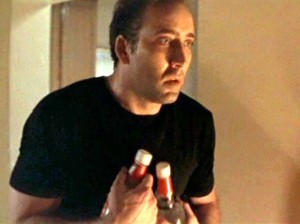
Ben’s constant fight against DTs show alcoholism isn’t a glamorous way to die.
That was when I found a kindred spirit in Ben Sanderson. Despite having recently turned 21, I was never much of a drinker. Still, there was something romantic in the very notion of going to Sin City and dying through copious consumption.
Yet through this act of destruction, Ben found his “angel” in Sera. And despite connecting with Ben’s depression, in Sera I saw strength and hope. Sera was in an equally bad situation — her “career” was short-term and dangerous. She was a smart, attractive woman, and even the Vegas cabbies were telling her she could do better than her station in life. When the movie ends Sera loses her love but gains hope for a brighter future.
Through Leaving Las Vegas’ trippy mood, moving characters, and tale of redemption I found my own. I was inspired out of my funk. Nothing happened quickly, but over the next four years my ambition redoubled, I went back to school to get a more employable degree, and I met my wife. But when my future seemed nearly as bleak as Ben’s, Leaving Las Vegas showed me the neon light at the end of a tunnel.
I believe that connection is partially because of the tragic, sad story presented, but the experience is heightened by Figgis’ choice to drop out dialogue and scenes. Figgis’ music created an emotional call-and-response; when the film’s dialogue was drowned out my own struggles filled in the blanks. When the dialogue faded out I would project my pain into the film, mixing with Ben and Sera’s until we were indivisible.
Even today, as I live a much happier, optimistic, and realized life, the film still moves me. You don’t have to be in pain to empathize with those in pain; you don’t have to hear their words to know their struggles.
This is where Leaving Las Vegas transcends being a movie and becomes a full, engrossing experience. This is the soul of a film.
Tomorrow — 1996!
Arnie is a movie critic for Now Playing Podcast, a book reviewer for the Books & Nachos podcast, and co-host of the collecting podcasts Star Wars Action News and Marvelicious Toys. You can follow him on Twitter @thearniec
August 25, 2014 Posted by Arnie C | 40-Year-Old Critic, Movies, Now Playing Podcast, Podcasts, Reviews | 1990s, 1995, 40-Year-Old Critic, Alcohol, Alcoholic, Drama, Elisabeth Shue, Enertainment, Film, Las Vegas, Leaving Las Vegas, Mike Figgis, Movie, Movies, Nicholas Cage, Now Playing, Now Playing Podcast, Podcasts, Review, Reviews, Romance | 1 Comment
40 Year-Old-Critic: Natural Born Killers (1994)
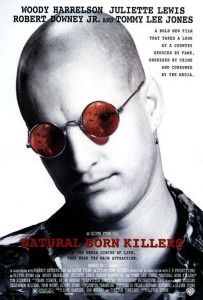 In The 40-Year-Old Critic, Venganza Media creator and host Arnie Carvalho recalls a memorable film for each year of his life. This series appears daily on the Venganza Media Gazette.
In The 40-Year-Old Critic, Venganza Media creator and host Arnie Carvalho recalls a memorable film for each year of his life. This series appears daily on the Venganza Media Gazette.
Mister rabbit says, “A movie review is worth a thousand prayers.”
In 1994 I was in college with aspirations of filmmaking. While my university did not have a dedicated film curriculum, my Mass Media Communications major with a Creative Writing minor afforded me classes in screenwriting, film criticism, editing, camerawork, and more.
But as the major was not simply film, there were numerous other classes I had to take for my degree. The list included Communication Ethics, First Amendment rights, studies of media impacts on the audience, and journalism, to name a few. As a college junior, I lived and breathed my major. Every form of entertainment I enjoyed, from video games to television to books to film, was a subject for my college studies. I wrote papers and gave multimedia presentations on violence in film, with a special focus on the Friday the 13th and Nightmare on Elm Street franchises.
But that year produced something unexpected from Oliver Stone and Quentin Tarantino. I was used to films factoring into my curriculum, but I never expected a major motion picture to be studying the same topic.
Natural Born Killers did just that.
The story is pure Tarantino. Having rewatched both True Romance and Reservoir Dogs multiple times I instantly saw a familiar trope in Mickey and Mallory Knox — the killers/anti-heroes of this film. Seeing two young outlaws in love and on a crime spree seemed right out of True Romance. That they are also merciless murderers felt like an extension of some of the characters from Reservoir Dogs — Mickey and Mallory could be Mr. and Mrs. Blonde. Finally, the film has a non-linear narrative that ends in a Mexican standoff. Despite Tarantino distancing himself from the production I saw his fingerprint on the negative.
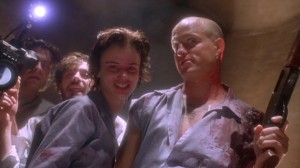
Despite the carnage, there was something pure and romantic about Mickey and Mallory’s love affair. It was sick and twisted, but also sweet.
I did later read the original script, which was published in book form. That draft was far more Tarantino, but still a reach for the director. More than a crime film, Tarantino’s Natural Born Killers had a pointed critique on American tabloid journalism.
Yet, in the hands of Oliver Stone, the film’s focus on the media grew exponentially. Stone, along with screenwriters David Veloz and Richard Rutowski, rewrote the script to the point that Tarantino ended up only receiving story credit. In the hands of Stone’s team, Natural Born Killers became a scathing commentary on American media.
It could not have hit at a more appropriate time. Rush Limbaugh was scoring big on radioand television with his daily indictment of the Clinton administration. Meanwhile the country was transfixed by the O.J. Simpson case. While this movie was released a few months before the trial began, the Ford Bronco chase and Simpson’s arrest were constant news.
The media focus seemed to go from one real-life drama to the next, be it Amy Fisher, Tonya Harding, Heidi Fleiss, the Menendez brothers, or even Woody Allen’s divorce from Mia Farrow — all were fodder for the newspapers and 24-hour news channels. What had once been the domain of the National Enquirer was suddenly considered “real news.” It seemed everyone was being given a talk show, and those who couldn’t host a show tried to get their 15 minutes of fame by appearing on one.
It’s ironic that Stone undertook this film as a chance to make a simple action picture, but he doesn’t do “simple.” As such, the result is an indictment not only of the media companies that propagate such coverage, but also the populace that consumes it.
Mickey and Mallory Knox, as brought to life by Woody Harrelson and Juliette Lewis, are products of the media. Despite Harrelson being in his early 30s when this film was made, Mickey and Mallory feel like members of the “MTV Generation.” These two realize they will never be TV stars, so they’ll be the next best thing: headline-makers. They guarantee it, always leaving one person alive to tell the media about Mickey and Mallory.
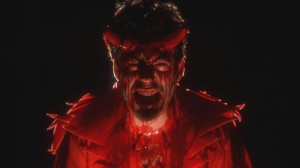
Stone has never been accused of being too subtle.
The journalists are not left untouched, though. The second half of the movie gets a shot of adrenaline in the form of Robert Downey, Jr., turning in a tremendous performance as tabloid TV reporter Wayne Gale. With an affected Aussie accent and an equally affected sympathetic persona, Gale convinces Mickey to do his first TV interview. As the film’s madness grows Gale starts to believe his own press, and eventually realizes the time comes when the audience wants to turn the TV off.
From the first frame to the last, Natural Born Killers is a film about the superficiality of personas, examining the concept of who a person is versus how he/she wants to be seen. While that difference is often greatest in the cases of public figures who must act a certain way in public but may be very different behind closed doors, the script shows that everyone has that secret face. The insight to that is Detective Jack Scagnetti (Tom Sizemore), who appears to be the heroic cop who brings down Mickey and Mallory. Yet the audience sees that he is a mirror image to Mickey. While Mickey kidnaps, rapes, and murders an innocent woman, Scagnetti hires, screws, and strangles a hooker.
Every character in the film is disgusting and immoral–save one Navajo Indian from whom Mickey and Mallory seek shelter. This character calls out blatantly that the two killers watch “too much TV.” While the mystical, magical medicine man is a blatant stereotype, he is the only character in the film who doesn’t deserve a bullet (but he gets one anyway). The police, the media, Mallory’s parents, even the random stranger Mallory seduces at a gas station, are all contemptible and repugnant.
In other words, they’re the product, creators, and consumers, of tabloid journalism.
Yet, for all of the high-minded idealism of the movie, Natural Born Killers avoids the usual “message movie” pitfall of heavy-handedness, which I discussed in my review of Philadelphia.
Stone’s filmmaking is too frenetic, too fast-paced, to ever linger. The film’s style changes with the scene; one moment we are seeing Mallory’s family portrayed as a sitcom, complete with laugh track, the next we have grainy black-and-white footage. There are even animated sequences inserted into the film that visualize the emotion of a scene. There is no way for the film to linger, there is too much going on.
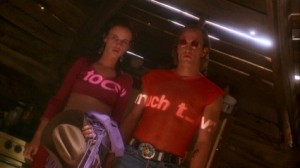
Something as simple as projecting a slide on actors felt fresh among the ever-shifting styles in Natural Born Killers.
In that regard, the picture is a critique of its audience. Stone knew that moviegoers in the 1990s had short attention spans, so he created a film perfectly suited to the mindset of an ADD-addled channel-flipper. The story and characters remain the same, but the tone, even the film stock, continually change. Stone also inserts bits of real commercials, as if he holds the remote we’re watching him scan to see what else is on.
The result is a trippy, psychedelic movie that truly feels like a tonal companion piece to his 1991 film The Doors. Mickey and Mallory are also rock stars of the media, and they even seek guidance from the spiritual Native American.
Like that earlier Stone film, Natural Born Killers is an experience more than a narrative. The color pallette, the transition to animation, the first-person camera shots years before found footage films were en vogue, the result is less narrative and more emotional.
And like The Doors, Natural Born Killers is propelled by a strong soundtrack. While the former film was almost exclusively set to Jim Morrison’s music, it was limited by the subject matter. Natural Born Killers doesn’t have that limitation, and the styles of music represented are as scattered as the film techniques.
Stone collaborated with Nine Inch Nails’ Trent Reznor to produce the soundtrack, and the result is a thumping, yet moody, symphony of discord. Music from Patsy Cline is interwoven with Patti Smith, Bob Dylan, L7, Dr. Dre, and much more — with a healthy dose of Leonard Cohen at the beginning and end.
Listening to the soundtrack is almost as involving an experience as watching the film. Reznor did not simply follow the Reservoir Dogs formula of putting film clips on the CD, he actually mixed it with the music, creating an aural cinematic experience.
(Though for those of us who are musical purists, it also ensured I bought many of the bands’ original albums to have versions of the songs without added effects and dialogue. It was this album that set me on the road to Leonard Cohen super-fandom.)
This entire tone could have been undercut by the lead actors, but Stone directed his cast expertly. All the leads, and key supporting characters, have left realism at the door. Exaggeration is the name of the game, so lines are screamed or drawled, movements emphasized, and facial expressions broad. Alone, that type of acting could undermine a film, but with the crazed visuals that accompany the scenes anything more natural would be lost.
The standout of the cast is Harrelson. Much like Tom Hanks with Philadelphia, I knew Harrelson from his comedies — not just Cheers, but Doc Hollywood, White Men Can’t Jump and even The Cowboy Way. I worried he could not pull off a performance as a homicidal maniac. More, as Harrelson was the son of a hit man who may have been involved in the John F. Kennedy assassination, it felt like stunt casting of the worst type.
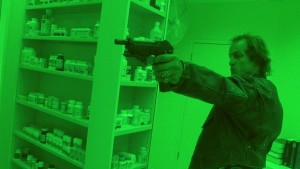
Harrelson left behind his good-ol-boy persona and fully inhabited the homicidal persona of Mickey Knox.
I was again wrong as I watched Harrelson, head shaved, fall into the character. By the film’s climax — when he has to break the fourth wall and deliver the line “I’m just a natural born killer” — all thoughts of comedy were gone. He was just a bad-ass, homicidal, rock star.
His performance is clearly aided by those of his co-stars. Lewis, a quirky actress I first noticed with 1993’s Cape Fear, is perfectly cast as a psychotic who becomes empowered and emancipated by following Mickey’s murderous examples. Sizemore carries a sleazy menace that follows him to every frame. Even Tommy Lee Jones overacts to the heavens as the spiteful prison warden. The result is a cast in perfect harmony, complimenting each other and their movie.
When I saw this film in theaters opening weekend I was mesmerized. I walked out, my head full of new viewpoints that I could incorporate into my coursework. I went back the very next day to try and catch more of the film, and to again experience the weird acid trip it offered.
Natural Born Killers spoke to me at a time in my life where I was already receptive to its message. I walked in expecting a road movie featuring mass murderers. I left thinking about media, and my own role in its creation.
But like Stone’s earlier film Wall Street, I feel the message of Natural Born Killers has been lost at best, or perverted at worst. Several instances of “copycat crimes” have appeared in the media, killers completely missing the point and, instead, are seemingly inspired by Mickey and Mallory Knox. It’s impossible to say if those acts would have been done without this film, but it’s a sad irony that a movie about the dangers of media violence then creates its own.
Yet every day when I look at the news, I feel that Natural Born Killers did not succeed in warning the media, or its consumers, about the impact of tabloid journalism. From Britney Spears’ head-shaving incident to Charlie Sheen’s “winning” display to even Robin Williams’ tragic suicide, the media is there to try and grab big ratings under the guise of informing the public.
On TV, audiences laughed at the obviously drugged antics of Anna Nicole Smith, until she died from her drugs. Audiences insist on Keeping Up with the Kardashians and watching Honey Boo Boo, The Bachelor or Catfish. Producers and editors sculpt clips from those shows, take sound bites out of context, and spend thousands of hours creating an audience-pleasing narrative of good versus bad that may have little bearing on reality.
I don’t know if fans of these shows a) don’t realize they manipulate the stars and their audience, or b) don’t care. Either way, we continue down the spiral to Stone’s original vision.
But if Natural Born Killers’ message didn’t last, the film didn’t stick with me either. Through my college years Stone’s film was in heavy rotation on my VCR. When the VHS release of the Director’s Cut came in 1997 (so long it had to be on two tapes) I rented it the first day. That was when I felt the trippy effect had finally worn off and I was no longer under the movie’s spell.
The scenes cut from Natural Born Killers — available on the second VHS tape — had every reason to be cut. I watched the extra hour Stone filmed for this movie and realized that, truly, this was a film made in the editing bay and not on the set. Assembling all the footage, including the cut trial scene and Mickey and Mallory’s attack on wrestling brothers Simon and Norman Hun, I realize Stone had a production out of control. The behind-the-scenes knowledge soiled this film for me, and for a decade I had trouble watching it at all. Now I can credit the final product, knowing how bad this movie almost was.
But in the fall of 1994 two Tarantino scripts were in theaters simultaneously: Natural Born Killers and Pulp Fiction. The masses crowded around Fiction, and Tarantino took home Oscar gold.
I greatly enjoy that second Tarantino-directed film, but if you asked me in the mid-90s to name my favorite of those two works, it had to be Natural Born Killers.
Tomorrow — 1995!
Arnie is a movie critic for Now Playing Podcast, a book reviewer for the Books & Nachos podcast, and co-host of the collecting podcasts Star Wars Action News and Marvelicious Toys. You can follow him on Twitter @thearniec
August 24, 2014 Posted by Arnie C | 40-Year-Old Critic, Movies, Now Playing Podcast, Podcasts, Reviews | 1990s, 40-Year-Old Critic, Juliette Lewis, Mallory, Mickey, Movie, Movies, Natural Born Killers, Nine Inch Nails, Now Playing, Now Playing Podcast, Oliver Stone, Podcasts, Review, Reviews, Robert Downey Jr, Trent Reznor, TV series, Woody Harrelson | 2 Comments
40 Year-Old-Critic: Philadelphia (1993)
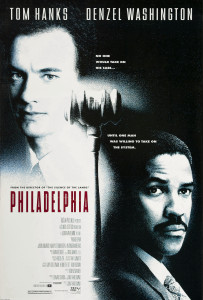 In The 40-Year-Old Critic, Venganza Media creator and host Arnie Carvalho recalls a memorable film for each year of his life. This series appears daily on the Venganza Media Gazette.
In The 40-Year-Old Critic, Venganza Media creator and host Arnie Carvalho recalls a memorable film for each year of his life. This series appears daily on the Venganza Media Gazette.
In many of these reviews I have observed how film can be an experience that takes you to other places and vicariously allow you to have extraordinary adventures. That was my childhood focus for films — escapist entertainment. As I aged, though, I came to discover film could also educate and open a window into the world of people totally different than myself.
The film that drove that point home more than any that came before was Jonathan Demme’s Philadelphia — a film I initially had no interest in seeing.
The picture had good people involved. Demme was not a favorite director of mine, but I had enjoyed Married to the Mob and fell in love with The Silence of the Lambs; the latter preceding Philadelphia by a couple of years. Likewise, co-star Denzel Washington had impressed me in his Oscar-winning role in 1989’s Glory. Both of these talents I liked, but neither did I love.
That affinity was thwarted by two large barriers.
My biggest problem with the film, before I even saw it, was star Tom Hanks. I had loved Hanks in the 80s. I had seen every episode of Bosom Buddies at least three times each; along with most of his films — Splash, Big, and Turner & Hooch are favorites. But by 1993 I felt Hanks was washed-up; a product of the 80s. The turn of the decade came and Hanks was starring in two of the worst films I had ever seen: Joe Versus the Volcano and The Bonfire of the Vanities. Sleepless in Seattle had also put me to sleep in theaters, and despite his acclaimed supporting role in A League of Their Own, I felt done with Hanks entirely.
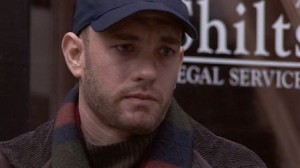
Despite having been a fan of Hanks in the 80s, he was a barrier to my seeing Philadelphia.
More, I pigeonholed him as a comedian. The thought of this guy doing a dramatic performance as a gay man dying of AIDS seemed funny for all the wrong reasons. I thought it was miscasting of the worst possible kind and that the film would be a train wreck.
But no matter who starred in the film, I still wouldn’t have rushed to see this it. From the trailers, from the interviews I read, from the film’s very premise, Philadelphia seemed like a movie with an agenda.
I had seen similar films by this point, from Born on the Fourth of July, to 1987’s Project X, to Gorillas in the Mist. I found them to be self-important slogs that would often have an effect opposite of what was intended. I was so put off by the picture I would feel kinship with the opposition. I had started to avoid “message movies” altogether.
Additionally, I was untouched by the AIDS epidemic. I had seen it covered on television shows like L.A. Law and St. Elsewhere and some “very special” sitcom episodes. I had watched the explosion of news coverage in the 80s. I was in the safe-sex ed classes in high school. I felt I knew all I needed to know, and I didn’t need to pay $7 for a movie to try and drive that point home again.
Further still, I wasn’t gay and, despite being a college student, had no gay friends (at least none that I knew of). Again, I had seen gay characters on television and in other films, but it was not a lifestyle, or even a cause to which I felt connected. My suburban, middle-class lifestyle made it all very unrelatable.
A combination of factors changed my mind, and I ended up seeing Philadelphia in theaters its opening week. First was the buzz surrounding the film. Critics I respected, and those who had lambasted Bonfire, heaped praise upon the film. It had started to become a topic of conversation among my friends.
Then there was the Bruce Springsteen song “Streets of Philadelphia”, a haunting piece that got heavy radio airplay. Never underestimate the power of a hit song to bring audiences into a movie — it worked for me. I wanted to see the film that could get The Boss to perform this song in a broken voice that made it sound as if he were on the verge of tears during the recording session.
Finally, my Now Playing Podcast co-host Stuart was in town for the holidays, and we would often see movies together on Christmas Day. We had already gone to see What’s Eating Gilbert Grape and were struggling to agree on a second film to watch. He suggested Philadelphia. By that point my curiosity was piqued, so we went.
It is a fine film. Not phenomenal, not outstanding, but very well done. I felt that way then, and now upon revisiting this film. The court case, which is ostensibly the film’s plot, is engaging. It clicked with me as a long-time fan of courtroom dramas. Still, the movie wasn’t only about the plot. This is a “message movie” and the point is to start conversation about homophobia in the workplace, and a true understanding of people not only dying from, but living with AIDS.
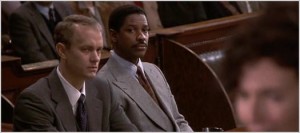
If what you want is a good courtroom drama, there are better out there. This plot is secondary to the human message of the film.
As such the plot does feel incidental.
As do any characters other than Hanks’ Andrew Beckett. The whole film is structured to engender audience sympathy for this man who lost his job, and eventually his life, due to his lifestyle and disease. Demme’s attempt to make the viewer connect with Beckett is obvious to me on a recent viewing.
More, Beckett is a character without much of an arc. He remains put-upon and in the right for most of the film. A late revelation on how he contracted the disease is a strange turn of events, but it doesn’t change Beckett for me. By that point in the film you were either on his side or walking out of the theater.
The true character arc is that of Washington’s Joe Miller. He plays Beckett’s lawyer and, over the course of the film, changes from a homophobe ignorant of AIDS and how it is transmitted, to understanding and accepting of Beckett’s lifestyle. Still, due to the script and the director, Washington’s performance and character is lost in Hanks’ shadow.
As for Hanks, who I expected to hate in his first highly dramatic screen role, Demme’s filmmaking was a success — I became fond of Beckett. The affinity I had for the actor helped me feel very comfortable with the dying lawyer he portrayed on screen. Perhaps it even created a feeling of closeness I wouldn’t have had if Beckett had been portrayed by someone unknown. Hanks physically transformed himself, losing a lot of weight to physically appear ill, and it did help both his performance and my sympathy for Beckett.
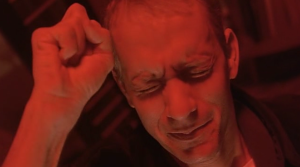
Did audiences really fall for this blatant manipulation? The film was moving, but this scene was too obvious in its pulling of the heart strings.
All that praise aside I do roll my eyes, unmoved by Hanks’ speech while playing an opera for Miller. The dramatic, high camera angle, Hanks’ closed-eye monologue with his hands raised to his head, it was the one scene of the film that felt unauthentic and overly manipulative. I imagined Hanks, after the take, grinning and telling his assistant “that is my Oscar moment.” Not only did the scene feel fake, I don’t think Hanks “sold” it to me. It was the one time I stopped seeing Andrew Beckett, and instead saw Tom Hanks. I also thought voters for the Academy Awards would be smarter than to fall for such chicanery… shows what I know about awards. They fell for it, and Hanks took home a gold statue, probably because of this very scene. With Forrest Gump the following year Hanks’ career hit new highs, and he keeps climbing to this day.
Yet I did feel moved at the end when Beckett lay in the hospital bed dying. Over the course of two hours I came to care for this man, and though his end was a foregone conclusion it still held impact.
I went into the film understanding how AIDS worked. When Miller goes to his doctor to see if he contracted AIDS from a handshake, that to me — even in 1993 — felt like an antiquated notion. More, I felt no bigotry towards homosexuals. I was a minority student at a liberal arts college and in my mind I held no judgement for anyone based on race, creed, gender, or orientation.
Still, this film opened my eyes. I may not have been discriminatory towards homosexuals, but that doesn’t negate that gays are discriminated against. I had thought that if I wasn’t a bigot than bigotry wasn’t my problem. This film helped me see another side. My views on AIDS and homosexuality were about me, this film helped me think about others. Philadelphia allowed me to experience the day-to-day life and struggles of homosexuals. No matter if I was bigoted, they must face and overcome bigotry. Just because I knew from classes how AIDS was transmitted, the film told me that even educated adults were sometimes ignorant about this disease. I may have had no gay friends, but this film made me feel as if, for two hours, I did. And I didn’t fear them or hate Andrew Beckett. I felt compassion.
More, this was one of the first homosexual characters I’d seen on screen that did not feel stereotypical. I didn’t think I knew any gay people because, in my teenaged mind, gays did not act the same as straight men. The epitome of this is Meshach Taylor’s Hollywood in Mannequin, but also George Hamilton’s Zorro, The Gay Blade, and Damon Wayans and David Alan Grier’s “Men on Film” sketch from In Living Color follow this pattern. Even the more toned down homosexual characters I knew, such as Billy Crystal’s Jodie Dallas on Soap, had affected mannerisms.
Hanks’ performance as Beckett was not a parody or a caricature — in most ways he acted like Hanks. Plus all those characters I listed were played for comedy; their homosexuality was cause for laughter. Here I was seeing homosexuality as cause for… nothing. He was just like everyone else.
This film was the first true step in my life toward a greater understanding, not just of gays but all people different from me. It helped me fully realize that a person cannot be judged by any single aspect of their character, but their whole being and the sum of their life experience.

Hanks’ commitment to the role was admirable. By the end of the film he was unrecognizable.
And I wasn’t alone. Philadelphia helped break down many walls. It seemed, after this film, gay characters became more accepted by mainstream America. On television, from My So-Called Life to Pedro Zamora on the 1994 season of MTV’s The Real World, I started to see more representation of gays.
Yet they all paled compared to the 1996 ER episode which revealed Gloria Ruben’s character Jeanie Boulet to be HIV positive — the first instance I saw of someone not dying from AIDS, but living with HIV. From films like My Best Friend’s Wedding and The Next Best Thing to Ellen Degeneres’ coming out on Ellen, Philadelphia made it okay for these stories to be told.
Given the weaknesses I see in the film itself, I’m not sure that it would hold up for new viewers. For more than 20 years this film has been in the public consciousness, and American culture has changed as a result. As such, in an era of Queer as Folk, Will and Grace, and even a gay married couple on Modern Family, the film just wouldn’t seem as groundbreaking as it truly was.
But I cannot rewatch this film and not think of the world in which I lived in 1993, and how Philadelphia changed that world forever.
Tomorrow — 1994!
Arnie is a movie critic for Now Playing Podcast, a book reviewer for the Books & Nachos podcast, and co-host of the collecting podcasts Star Wars Action News and Marvelicious Toys. You can follow him on Twitter @thearniec
August 23, 2014 Posted by Arnie C | 40-Year-Old Critic, Movies, Now Playing Podcast, Podcasts, Reviews | 1990s, 1993, 40-Year-Old Critic, AIDS, Antonio Banderas, Denzel Washington, Enertainment, Film, HIV, Jonathan Demme, Message Movie, Movie, Movies, Now Playing, Philadelphia, Podcasts, Review, Reviews, Tom Hanks | Comments Off on 40 Year-Old-Critic: Philadelphia (1993)
40 Year-Old-Critic: Reservoir Dogs (1992)
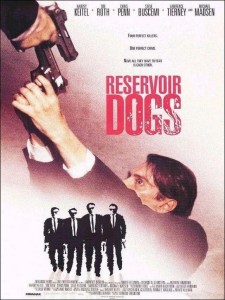 In The 40-Year-Old Critic, Venganza Media creator and host Arnie Carvalho recalls a memorable film for each year of his life. This series appears daily on the Venganza Media Gazette.
In The 40-Year-Old Critic, Venganza Media creator and host Arnie Carvalho recalls a memorable film for each year of his life. This series appears daily on the Venganza Media Gazette.
Are you gonna bark all day, little doggie, or are you gonna review a movie?
Throughout the 1980s American cinemas were dominated by blockbuster, event movies. They rose to prominence in the 70s, starting with Jaws and then Star Wars. By the “Big 80s” big films were the ticket, and the modern movie marketing machine began to form.
By the end of that decade, though, a counterculture of film had started to gain prominence — the indie picture. While this type of low-budget filmmaking was as old as movies themselves, the indies rarely received the publicity and the press afforded to large, studio films. That tide started to turn, in part due to the rise of the Sundance Film Festival in the mid-to-late 80s. Steven Soderbergh achieved critical mass with Sex, Lies, and Videotape in 1989. That same year Jim Sheriden’s My Left Foot was nominated for several Academy Awards, pushing star Daniel Day Lewis into the spotlight.
Both films were distributed by Miramax Films, a studio whose name would be at the center of the 90s indie movement. Studio heads Bob and Harvey Weinstein focused on distribution of smaller independent and foreign films. and the success of those aforementioned 1989 gave the Weinsteins a bully pulpit and legitimacy as they expanded their empire.
While I spent my senior year of high school watching big-budget fare like Lethal Weapon 3, Batman Returns, and Basic Instinct, even at age 17 I could see the shift was happening. I was regularly reading movie and entertainment magazines and following the careers of many actors and directors. I was aware of these low-budget films. Being the teen I was, I tried Sex, Lies, and Videotape, and found it to be much more dull than the titillating title had teased.
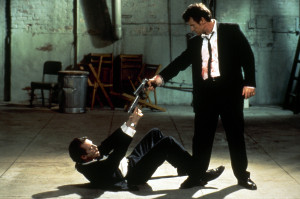
The image that sums up the movie perfectly–men ready to shoot each other.
Although I’d been consuming all of this media, I don’t remember ever hearing about a little film called Reservoir Dogs or its director, Quentin Tarantino. It wasn’t until 1993 — a year after its release — when my lifelong friend and Now Playing Podcast co-host Stuart turned me onto the film.
I had wanted to see True Romance, the 1993 Christian Slater crime film from Top Gun director Tony Scott. I missed it due to friends not wanting to see any film starring Slater post-Kuffs. Thinking I knew Stuart’s taste in film — he certainly was no fan of Slater — I didn’t even ask him, so I was surprised when he later told me he had already seen it and gave it a positive review. He even went out of his way to compliment Bronson Pinchot, of all people, while discussing the movie.
He told me the film was written by the guy who made his directorial debut with the film Reservoir Dogs. As I missed seeing True Romance in theaters (it was only in our town for one week) I immediately went out and rented Dogs with no idea what to expect. I’m not sure I even knew it was an indie film.
I was immediately drawn in. The opening scene had me laughing as the characters sat around deconstructing the lyrics of Madonna’s “Like a Virgin.” The slo-mo opening credits sequence, set to George Baker Selection’s “Little Green Bag”, had me grooving to a song that I hadn’t heard in almost 20 years. These guys were already so cool in their black suits, narrow ties, and sunglasses, and the movie hadn’t even really started.
Reservoir Dogs is really a whodunnit, only we aren’t looking for the identity of a killer, but a rat. Somewhere in this group of cool criminals was an undercover cop. When their jewel heist went bad some members of the gang were killed. The survivors gathered at the designated meeting point, but all are on edge wondering who was the turncoat.
The mystery is revealed through a series of flashbacks. Each of the main villains gets their own sequence showing how they came to be part of the group. As we find out about each member they are ruled out as a cop — until we get to the flashback that makes it explicit.
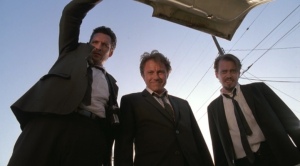
The camerawork in Reservoir Dogs was fresh and exciting. The steadicam following these dogs out of the building–the music fading behind them–was a technique I’d not noticed before watching this movie.
It wouldn’t be until years later that I would realize that through this structure Tarantino had revolutionized cinematic storytelling. Flashbacks were nothing new, but his copious use to unfold a story was uncommon and felt fresh. Today Reservoir Dogs has been copied endlessly — its structure was the template for every episode of Lost, plus hundreds more. Now I consider the flashback story a gimmick. Even Tarantino’s follow-up film Pulp Fiction continued this use, though, while the timeline of that latter film is not chronological, it is also not as scattered as this earlier work.
Watching this film I didn’t realize I was seeing a new storytelling structure that would permeate the mainstream. Through expert editing and story structure I was just drawn into Reservoir Dogs, without excess attention paid to the narrative. The dialogue, the characters, the mystery, it all had me.
Despite being a movie featuring murderous thieves, Tarantino found a way to make them likable characters. The opening scene in the diner, which helped establish a pecking order and general relationships, was a large part of that.
The flashback scenes also built upon this, showing a sense of family among many of the characters and their boss, Joe Cabot. Mr. Blonde (Michael Madsen, in his finest performance to date) is fresh out of prison having refused to rat on his employer. Still on parole, Blonde is afraid of going back. Joe, and his son “Nice Guy Eddie” (Chris Penn) set Blonde up with a fake job and a sense of security, before they do the job.
Likewise Mr. White (Harvey Keitel) is a longtime associate of Joe’s and flashbacks firmly establish their friendship and camaraderie.
The linchpin of the film, however, is Mr. Orange (Tim Roth). He gets the most flashback scenes, and here we get to connect with him outside of the crime family. Tarantino gets much praise for dialogue, and it comes through in these moments.
The sense of pop culture Tarantino put into the film is uncanny. Referencing songs of the 80s while bringing in music from the 70s, Reservoir Dogs clicked with a multitude of audiences. Yet, in a decade before Marvel films were popular, Tarantino referenced Fantastic Four as well — letting this teenage comic fan know a kindred spirit was behind the camera.
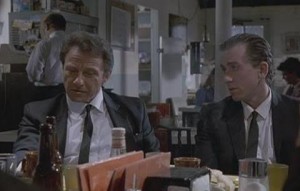
You give me a bad review in a dream you better wake up and apologize.
I also loved the way the soundtrack compiled these songs but, in between, included dialogue from the film. It was rare in 1992 to include anything other than music on a soundtrack. After Reservoir Dogs it became expected, until it — like flashback storytelling — became a tiresome and overused gimmick. With Reservoir Dogs, and then Pulp Fiction, Tarantino’s albums remain my gold standard for this trick.
Beyond all of that came my personal favorite character, the weasely, greedy Mr. Pink (Steve Buscemi). His instinctive sense of self-preservation plus his sardonic sense of humor was all established in his very first scene–he doesn’t tip waitresses. He cares more about his own finances than having compassion for the waitress, and tells this in a highly amusing way. Pink was always my favorite of the Dogs, and for years I thought he, the least trustworthy of all the criminals on screen, was the only survivor. Not only that, it seemed he got away with the diamonds! It wasn’t until 1996 when I saw a limited-run theatrical rerelease that I heard the audio and Pink ended up like the rest of the gang–shot to death.
I can continue to heap praise on this film, and over its 22 year history many have. Yet much of what I appreciated came in retrospect. Watching this film the first time, I was just taken in, and perhaps a bit shocked. Reservoir Dogs is bloody, foul-mouthed, and raw. The casual amorality that Mr. Blonde exhibits when he pulls his captive police officer from the trunk, where the cop had been stored for quite some time, brings the blackest of humor. It is a moment beaten only moments later by Blonde’s torture of the man, set to the jaunty Stealers Wheel’s song “Stuck in the Middle With You.”
This film was my intro to Tarantino, and I was instantly a fan. True Romance solidified that. The next year my dorm room was a practical shrine to the director, with giant Mr. Blonde and Mr. White posters dominating my walls. These films entered heavy rotation, and greatly influenced my creative view. I started tooling with my own crime stories that, at the time, I considered original. Now I realize they were blatant Tarantino rip-offs.
Through my love of Reservoir Dogs I also discovered new directors who followed Tarantino’s path and broke into Hollywood with gritty, genre-bending crime films. From Bryan Singer with The Usual Suspects to Guy Ritchie with Lock, Stock, and Two Smoking Barrels, and even Reservoir Dogs co-writer Roger Avary’s directorial debut Killing Zoe.
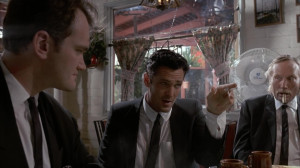
Tarantino pulled off the minor role of Mr. Brown, but he was not as fortunate in future acting gigs.
(I also followed Tarantino’s “acting” career to films like Sleep With Me and Destiny Turns On the Radio. Don’t make the same mistake I did. Never, ever watch Destiny Turns On the Radio)
Tarantino opened the door for indie filmmakers to be taken seriously in the 90s. He also shifted my focus for the rest of the decade, causing me to seek out small films as well as blockbusters, and to sample new directors as well as return to those I already enjoyed.
In the two decades since Reservoir Dogs Tarantino has gone on to win multiple academy awards and put together a very respectable resume of films. There is no doubt the man is a talented director, and an even better wordsmith. Still, to me, his earliest work remains his finest. Even Pulp Fiction, his directorial follow-up to Dogs, became more complex and bloated.
Here, with only the bare essentials and a meager budget, he created a work of genius, and an inspiration to aspiring writers and filmmakers across the country. Including me.
Tomorrow — 1993!
Arnie is a movie critic for Now Playing Podcast, a book reviewer for the Books & Nachos podcast, and co-host of the collecting podcasts Star Wars Action News and Marvelicious Toys. You can follow him on Twitter @thearniec
August 22, 2014 Posted by Arnie C | 40-Year-Old Critic, Movies, Now Playing Podcast, Podcasts, Reviews | 40-Year-Old Critic, Enertainment, Film, Harvey Keitel, Indie, Michael Madsen, Mirimax, Movie, Movies, Now Playing, Now Playing Podcast, Podcasts, Quentin Tarantino, Reservoir Dogs, Review, Reviews, Steve Buscemi, Tarantino, Tim Roth | 3 Comments
40 Year-Old-Critic: The Doors (1991)
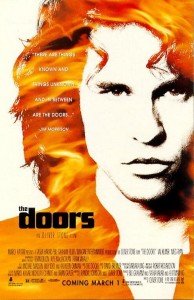 In The 40-Year-Old Critic, Venganza Media creator and host Arnie Carvalho recalls a memorable film for each year of his life. This series appears daily on the Venganza Media Gazette.
In The 40-Year-Old Critic, Venganza Media creator and host Arnie Carvalho recalls a memorable film for each year of his life. This series appears daily on the Venganza Media Gazette.
The critic awoke before dawn. He put his boots on. He chose a film from the ancient gallery and he walked on down the hall…
Believe it or not, I love the concept of film biographies, or biopics as they’re sometimes called. The world is full of colorful people with stories more strange and interesting than any fiction a Hollywood scribe can concoct. To learn a bit about a popular or historical figure, while also hopefully being entertained, seems like a win-win.
I realize this may be a shock to those who have heard my comments on the Now Playing Podcast review of The Aviator where I heaped my disdain on the overwrought, self-important Martin Scorsese-directed Howard Hughes biopic.
Therein lies the dichotomy: while I like the idea of a biopic, the execution is often lacking. A life cannot be compressed into a single film, so shortcuts are made to improve the narrative; and often the films come with this feeling that the director was saddled with the burden of making something to honor the subject.
Still, while they are the exception and not the rule, there are some biopics I completely love. Examples include: The Social Network’s profile of Facebook founder Mark Zuckerberg, Fire in Silicon Valley (the TNT TV movie about the rise of Microsoft and Apple), and Dragon: The Bruce Lee Story, which feels like a martial arts film while profiling the star of that genre.
Of all of those, though, no biopic has had the impact on me that came with Oliver Stone’s The Doors.
It was by chance that I saw The Doors. My interest in a biography film is directly proportional to my interest in the subject. I don’t care about Peter Pan author J.M. Barrie, so I didn’t see Finding Neverland; I’m not a fan of Liberace so I didn’t seek out Behind the Candelabra.
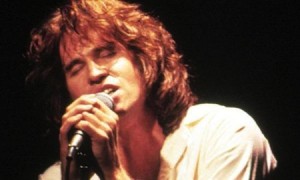
From movement to posture to body shape, Kilmer became Morrison for The Doors.
In my teen years, not only wasn’t I a fan of The Doors, I barely knew them. I was more familiar with the Echo and the Bunnymen cover of People are Strange featured in The Lost Boys than I was any given Doors song.
Nor was I especially a fan of Stone’s (though this review series may give the opposite impression, as I already profiled Wall Street, and one more Stone film will appear before this series ends). After Wall Street I had seen Born on the Fourth of July and found it interesting, and I actually saw JFK before The Doors due to more interest in the subject. But JFK ended up becoming one of those biopics — like The Aviator — for which I have no tolerance.
I saw The Doors due to utter boredom. I was home from college for a weekend with no plans, so, as I was wont to do, I went to the video store with no agenda. A Saturday night, the new releases gone, I eventually came upon this film’s VHS box and saw Val Kilmer staring out at me, his hair and shirt aflame.
Kilmer was an actor I’d greatly enjoyed. Real Genius remains, to this day, one of my favorite 80s comedies, in large part due to the actor’s fun, yet emotional role as young laser scientist Chris Knight. In addition, Kilmer had given strong performances in Top Gun, Top Secret!, and Willow. I wanted to see what the actor could do if given a more serious role, and I had read nothing but praise for his portrayal of singer Jim Morrison.
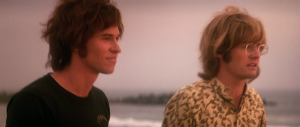
I mostly knew co-star Kyle MacLachlan from Twin Peaks when I first saw The Doors. His character of Ray Manzarek, Doors’ keyboardist, is lost in this film; despite the title this movie is all about Morrison.
I took the videocassette home, with no clue what to expect. I knew nothing of Morrison’s life or his band. I certainly didn’t expect to see visions of Native American spirit guides, trippy sexual satanic rituals, and Morrison receiving oral sex in the recording studio while singing. While there were silent parts, it felt like Morrison’s life was completely scored to his own music — and it fit perfectly.
I had never done acid or eaten hallucinogenic mushrooms, but after watching The Doors I felt as if I had done both. Even on my small television I lost myself in this story. The editing, the score, the dreamlike quality that inhabits almost every frame, made me feel I had experienced the film, not watched it. The Doors took their name from Aldous Huxley’s book The Doors of Perception, and I felt mine had been opened through this biopic.
I ejected the tape feeling as if I had communed with Morrison, as he had on screen with the Native American.
Much of the credit for that must be given to Kilmer. Everything I had read, all the accolades heaped upon the actor, did not begin to do justice to this transformative performance. Despite watching the movie for him, by twenty minutes into the film I recognized that the actor had become lost to the role.
Part of it was a physical transformation — Kilmer losing weight to make himself as wiry as Morrison was in classic photos. More than just adjusting his body mass, though, Kilmer moved with a swagger I’ve not seen him have before or since. When he sang the songs he wasn’t just passable but exceptional. Somehow he captured the mystical authority that was Morrison’s trademark.
On my first watching of The Doors I didn’t realize how accurate Kilmer’s portrayal was; I knew nothing of Morrison and thus had no basis to which I could compare. What I did know, though, was that Kilmer had transcended the performances I had seen before and transformed into someone else for two-and-a-half hours.
Kilmer’s Morrison was sexy, cool, confident, cruel, drunk, stoned… he was magical. He was The Lizard King, he could do anything.
I had never desired to own a Doors record before this movie, but after delighting in this film I became obsessed. The very next day I went to the used music shop (where I was a regular) and bought some Doors CD’s that I listened to hundreds of times.
More, I wanted to find out the rest of Morrison’s story. The film showcased the high points but I needed to know more; about his supposed bastard child, about the satanic rituals he undertook, about his tumultuous relationship with girlfriend Pamela Courson (Meg Ryan, lost in Kilmer’s shadow). This being the pre-Internet era, I had to go to a bookstore, and within a week I had bought Jerry Hopkins and Danny Sugerman’s biography No One Here Gets Out Alive.
This was not a short-term obsession. In the years since I’ve reread that book several times, as well as the autobiographies Riders on the Storm: My Life with Jim Morrison and The Doors by drummer John Densmore and Light My Fire: My Life with The Doors by keyboardist Ray Manzarek, and several other books along the way. I even bought a CD of a strange audio interview Morrison gave in his later years, and have listened to it religiously, looking for more insight into the man who hooked me on screen.
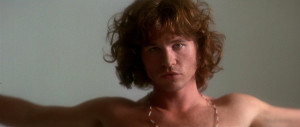
Kilmer perfectly recreates an iconic photo of Morrison.
Through those years of research I came to admire Stone’s work even more. It is impossible to sum up one man’s life in a single film, but Stone had come damn close. Though the surviving Doors disagree, my own readings show that Stone was mostly factual. With any real-life scenario there are different accounts of what happened, and even among the band there are disagreements about what in the film is fiction.
In the end, as with all biographies, some characters were combined or cut out, but it seems that Stone’s film did not indulge in the over-fictionalization and emotional shortcuts that are the hallmark of the genre. Even good biopics, like Dragon, rely on this crutch more than The Doors appears to have.
But beyond facts, Stone created a film that wasn’t about Jim Morrison, it was about being Jim Morrison. You didn’t need to see his every aspect so much as understand his point of view, and that is captured perfectly on film. Despite the seriousness of the subject, and contracts with Courson’s family and the remaining Doors, Stone kept the film light, fun, and trippy. He even avoided his JFK downfall — he never indulged a conspiracy theory over Morrison’s mysterious death in a bathtub. Several books propagate urban legend that Morrison’s death was faked, that Mr. Mojo Risin’ (an anagram of Morrison’s name) was living somewhere in Africa, and some day the world would witness the return of The Lizard King. That is subject material that seems tailor-made for Stone, but he does not follow the impulse. The result is a biopic that works as a movie, and a film that entertains as it educates.
Yes, while I only see most biopics due to an interest in the subject matter, this one was the total opposite — the biography film made me an uber-fan of the subject!
To this day The Doors is a film I watch regularly. It has stood the test of time better than its lead actor or its director. It has become iconic in my own mind, and when I envision Morrison in my head I’m never sure if I’m seeing Kilmer or Jim.
In the end, it doesn’t matter — for in this film they were one in the same.
Tomorrow — 1992!
Arnie is a movie critic for Now Playing Podcast, a book reviewer for the Books & Nachos podcast, and co-host of the collecting podcasts Star Wars Action News and Marvelicious Toys. You can follow him on Twitter @thearniec
August 21, 2014 Posted by Arnie C | 40-Year-Old Critic, Movies, Music, Now Playing Podcast, Podcasts, Reviews | 40-Year-Old Critic, Biography, Biopic, Documentary, Drama, Movie, Movies, Now Playing, Now Playing Podcast, Oliver Stone, Podcasts, Review, Reviews, Rock, The Doors, Val Kilmer | 4 Comments
40 Year-Old-Critic: Pump Up The Volume (1990)
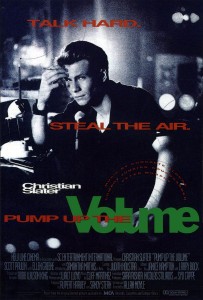 In The 40-Year-Old Critic, Venganza Media creator and host Arnie Carvalho recalls a memorable film for each year of his life. This series appears daily on the Venganza Media Gazette.
In The 40-Year-Old Critic, Venganza Media creator and host Arnie Carvalho recalls a memorable film for each year of his life. This series appears daily on the Venganza Media Gazette.
Okay, down to business. I got my Wild Cherry Diet Pepsi, and I got my Blackjack gum here, and I got that feeling… mmmm… yeah, that familiar feeling, that it’s time to write another movie review.
I think every generation of teenagers has a movie that speaks to them directly. Maybe it’s Rebel Without a Cause or The Breakfast Club or Mean Girls or High School Confidential; there is always a movie that can perfectly capture on screen a snapshot of your fears and concerns, along with the overall attitude of American youth.
For many people my age — the younger members of Generation X — that film is 1990’s Pump Up the Volume, and it is in a large part the reason that I’m writing this entire review series.
The film stars Christian Slater as Mark Hunter, a high school student recently transplanted from New York to Arizona. At school he is an introverted kid who stumbles over his words and mumbles when called on in class. But by night Mark rocks out as Happy Harry Hard-On, a pirate radio DJ — his name stolen from the initials of the Hubert H. Humphrey High School he attends.
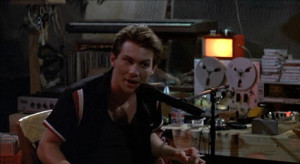
This looks like my studio. Only I have more toys, less records, and no reel-to-reel tape…but that would add atmosphere.
The show becomes a cult phenomenon at the school, with kids gathering nightly to listen in the remote locales that afford the best reception for Hard Harry’s low-powered FM transmission. Their communal experience stretches across class lines and cliques; and while Harry is simulating masturbation and playing banned Beastie Boys songs, he’s unaware that kids are looking up to him. As the audience grows Harry becomes an over-the-air Dear Abby for these pimple-popping pubescents. Unfortunately, one teen reaches out to Harry for help, and, when not satisfied with the response, commits suicide.
This leads to a contrived plot involving police and the FCC tracking down Mark on charges of criminal mischief. The film takes some Goonies-like kids-know-more-than-adults turns that stretch suspension of disbelief, and the last 30 minutes kind of fall flat as Mark tries to outsmart his pursuers. But the first hour truly succeeds in capturing the feeling of teen angst and insecurity shared by many high school students.
I know this film spoke to me in 1990. Like Mark, I had just moved to a new city, changing high schools in my junior year. That was my second move in three years, and I would live in five different cities over the span of four years. I always managed to make a small group of friends, but I understood Mark’s frustration. Also, like Mark, I avoided much of the situation by throwing myself into entertainment, be it books or films.
Each time I moved and lost contact with friends I’d have more free time to fill. Mark might as well have been speaking for me when he said, “I just arrived in this stupid suburb. I have no friends, no money, no car, no license. And even if I did have a license all I can do is drive out to some stupid mall, maybe if I’m lucky play some fucking video games, smoke a joint and get stupid. You see, there’s nothing to do anymore. Everything decent’s been done. All the great themes have been used up, turned into theme parks. So I don’t really find it exactly cheerful to be living in the middle of a totally exhausted decade where there’s nothing to look forward to and no one to look up to.”
Mark provided verbalization of my first post-modern early-life crisis.
My connection to this character was strengthened by Slater’s previous role as angsty, homicidal high school student J.D. in the dark comedy Heathers.
That film introduced me to the actor and his Jack Nicholson-esque delivery, and that’s why I was drawn to Pump Up the Volume. I have to say up front that Heathers is the better of the two films; both smarter and funnier.
In both films Slater’s character is an angry high school loner who seduces a brunette co-star while revealing the social hypocrisies that surround him. In many ways I saw Pump Up the Volume as a softer, less violent imitation of Heathers. I connected to Mark far more than J.D., the latter character’s mad bomber twist taking it a step too far.
As Mark, Slater took that angst and destroyed the school with words instead of dynamite. Through his one-man show he brought down a corrupt administration, got the girl, and made dozens of teens feel good about themselves.
It is the last point that gives Pump Up the Volume its power. Students call Harry’s hotline with problems so varied that everyone can find something to which they can relate. One pretty blonde girl is tired of pretending to be perfect. A gay teen is frustrated at the bullying he suffers. Another girl is kicked out of school after finding out she’s pregnant.
Gay or straight, male or female, fat or thin, Harry has self-affirming words of wisdom for you: “Feeling screwed up at a screwed up time in a screwed up place does not mean you are screwed up.”
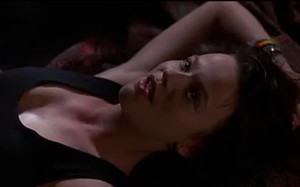
All my listeners have this look of orgasmic rapture on their faces when listening to my podcasts, right? No??
Don’t destroy my fantasy!
In that way Harry becomes a horny radio version of Robin Williams’ John Keating from Dead Poets Society. He realizes that teenage years bring pain, but he’s wise enough to know it’s temporary and won’t matter in five years. (That Mark espoused this so convincingly while also lamenting his own station in life is a dichotomy the script never cares to rectify.)
Mark lives a Superman-like lifestyle. He is a geek by day, and even wears glasses to hide his identity. By night he takes the glasses off and is a microphone superhero. To the teens in his audience, and this teen watching the film, he was an inspiration.
I mentioned in my review of Wall Street that, after seeing that movie, I had no career ambition. Turning 16 years old but having no concept of career goals was frightening. Soon I would have to pick a college, a major, a career, and I had nothing. Yet Happy Harry Hard-On sparked something inside me. He made me realize the true power of words, and how few things are more insidious than a whisper in your ear; few things more important than entertainment that can lift your spirits after a terrible day. Pump Up the Volume made me want to be an entertainer, and, while I would experiment with several avenues, that goal of bringing light to peoples’ day never changed.
In fact, I took a fairly direct path from Pump Up the Volume. Three years after seeing this movie I became a DJ at my college radio station. I never found corruption in the school administration, but I did smoke my share of cigarettes while lamenting into a microphone and wondering if anyone was out there listening. I do know I remotely deejayed a number of parties on and off campus.
And I played more than my share of Leonard Cohen songs. I also must credit Pump Up the Volume for broadening my musical tastes. Cohen’s song “Everybody Knows” launched Harry’s every broadcast and its cynical lyrics resonated with me:
Everybody knows that the war is over
Everybody knows the good guys lost
Everybody knows the fight was fixed
The poor stay poor, the rich get rich
That’s how it goes
Everybody knows
Cohen’s sonorous voice sounded like a funeral march, and this became my anthem. I bought the Pump Up the Volume soundtrack immediately. Though I was disappointed that Cohen’s version of “Everybody Knows” was absent, replaced by Concrete Blonde’s cover, that CD introduced me to the Pixies and Henry Rollins, along with Soundgarden and Sonic Youth years before they broke into the mainstream.
I finally rediscovered Cohen a few years later, but that will be discussed in time.
I still live with Pump Up the Volume as an influence on my life, though as an adult I find few of the characters relatable; my own teenage angst and awkwardness are now, fortunately, long buried in the past. Yet, as I mention this film — which I long considered an obscurity — to people around my age I find we, like Harry’s on-screen audience, had a shared communal experience. Pump Up the Volume became a film that, despite its faults, resonated with us.
Rewatching this film to prepare for this review I found myself connecting with Hard Harry in a new way. When he finally tells the story of how he got started with his pirate radio, it was a familiar one. He started broadcasting thinking no one, or perhaps one special person, was listening. Slowly he realized his show was picking up steam. It was an incredible dream, and one I think nearly every podcaster shares.
Every podcast begins the same way: someone picks up a microphone and starts talking with no clue if anyone will listen. Some shows may have better odds than others, being featured on other podcast feeds and the like, but I know when I recorded my first episode of Star Wars Action News I wondered if anyone would ever hear it. That it got 50 downloads in the first week floored me, that was a number far greater than I’d ever dreamed. I continued to record, and people continued to listen. Like Harry experienced in this movie, my audience grew.
Podcasting is the new pirate radio, and we operate outside the purview of the FCC. And as Harry does at the end of the film I urge each of you to, “seize the air. Steal it! It belongs to you! Speak out! They can’t stop you. Find your voice and use it! Keep this going! Pick a name, go on air. It’s your life, take charge of it. Do it, try it, try anything. Spill your guts out, say shit and fuck a million times if you want to, but you decide. Just fill the air! Steal it! Keep the air alive!”
Until tomorrow’s entry, talk hard!
Tomorrow: 1991
Arnie is a movie critic for Now Playing Podcast, a book reviewer for the Books & Nachos podcast, and co-host of the collecting podcasts Star Wars Action News and Marvelicious Toys. You can follow him on Twitter @thearniec
August 20, 2014 Posted by Arnie C | 40-Year-Old Critic, Movies, Now Playing Podcast, Podcasts, Reviews | 1990s, 40-Year-Old Critic, Christian Slater, Drama, Enertainment, Leonard Cohen, Movie, Movies, Now Playing, Now Playing Podcast, Podcasts, Pump Up the Volume, Review, Reviews, Samantha Mathis | 1 Comment
40 Year-Old-Critic: When Harry Met Sally (1989)
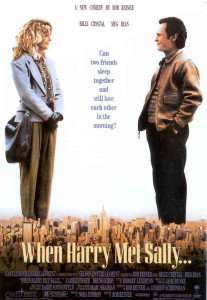
In The 40-Year-Old Critic, Venganza Media creator and host Arnie Carvalho recalls a memorable film for each year of his life. This series appears daily on the Venganza Media Gazette.
On Now Playing Podcast my co-hosts Stuart and Jakob often joke about my affinity for romantic comedies, or “RomComs.” I don’t mind the jokes. After all, it does seem that I tend to go to this lighthearted genre whenever discussing works of actors and filmmakers.
A History of Violence star Maria Bello? First saw her in Coyote Ugly and loved her in The Cooler.
I researched the work of The Wolverine director James Mangold by watching the atrocious Kate & Leopold.
Even mo-cap pioneer Andy Serkis — we actually see his face in 13 Going on 30.
The list goes on and on. I never analyzed my proclivity for these films, but the repeated jesting had me reflect a bit on why I spent time watching them in the first place. It quickly became clear that I chose to see those movies and more because of When Harry Met Sally.
When Harry Met Sally was released in the summer of 1989, which, at that point, might have been the biggest moviegoing summer in Hollywood history. Films like Star Trek V, Indiana Jones and the Last Crusade, Batman, Ghostbusters II, and Back to the Future Part II were all unleashed within weeks of each other.
With these blockbuster heavy-hitters on the calendar, Rob Reiner’s romantic comedy was not the No. 1 film on my “must see” list, but it was up there.
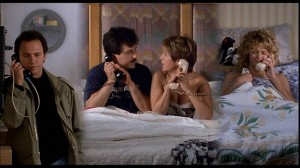
Crystal, Kirby, Fisher, and Ryan engage in 4-way split-screen action.
Part of the draw was the talent involved. I had liked Meg Ryan in Innerspace, and, although I was too young to appreciate the genius of Soap, Billy Crystal had really impressed me with Throw Momma from the Train.
But the biggest draw was Reiner. While I grew up watching “Meathead” on All in the Family, I’d already come to respect him as a director after seeing Stand by Me, The Princess Bride, and even the John Cusack comedy The Sure Thing.
Also, if I’m going to be completely honest, there was another big draw: Sex.
I was in my early teens and dating was a frustrating, confusing experience. I was also learning about sex through government-mandated public school health class as well as… extracurricular materials. As a boy desperately wanting to gain insight into the female brain, this film seemed like a wealth of knowledge.
The trailers teased wise phrases such as “Men and women can’t be friends, the sex part always gets in the way.” Was that true? It boggled my adolescent mind to ponder.
And there was the clip of Meg Ryan performing Sally’s fake orgasm in Katz’s Delicatessen. Yeah, I really wanted to know more about that!
Getting into the theater was a tricky proposition for someone three years shy of the 17-year-old threshold for R-rated films. I eventually convinced my prudish 21-year-old sister Michelle and her husband to take me.
I know that at 13 I didn’t get all the jokes or understand the subtle nature of some of the humor (I also totally didn’t recognize “Princess Leia” Carrie Fisher as Sally’s best friend Marie). Still, I was taken by this film and its world.
Crystal was funny and salacious as Harry. I was won over by this libidinous lothario early on, during the car ride when Harry propositions Sally despite the fact that he’s dating her best friend. Crystal’s timing is spot-on. In the hands of another actor this type of introduction could have alienated the audience, but Crystal’s light hearted delivery, his sparkling eyes, and his disarming smile made Harry the type of character men could root for and women could come to love.
As Sally, Ryan gave the performance of her life. I developed a major crush on Sally and, due to this, I saw most of Ryan’s work. The success of this film made her a hot property, but from Flesh and Bone to I.Q. to The Doors, no performance she has ever given comes close to matching the one she gives here.
I believe part of this is because of the way Ryan threw herself into the role, right down to the deli orgasm scene. While some actresses may have shied away from such an extreme moment, this scene was actually Ryan’s idea. With physical comedy, self-effacing stumbles, and great delivery, she gave her all to When Harry Met Sally.
More, I think her co-stars, primarily Crystal and Bruno Kirby, were so amazing that Ryan’s game was elevated.
Thanks to the performances from the two leads and a script by Nora Ephron, Reiner created the perfect romantic comedy; one that appeals equally to men and women. The movie delicately balanced the two points-of-view and at no point while watching When Harry Met Sally did I feel I was watching a “chick flick.” To me it was just a comedy film.
Not only did this film make me fall in love with Sally; I fell in love with New York City. This was the first time I’d seen New York truly romanticized on screen. Sure, Ghostbusters, Splash, and Short Circuit 2 were among the many movies set in the Big Apple, but this film truly drove home to me the differences between New York and other cities where I’d spent considerable time, such as Chicago or Fort Myers, Florida. The use of cabs for transportation, the unlikely experience of running into old acquaintances in a city with 8 million residents, the difficulty of taking home a Christmas tree in a town that relies on public transportation — I saw it all for the first time in When Harry Met Sally. This was the first movie that I realized to be as much about a place as the people.
Reiner deserves so much praise for the way he structured the film; using holidays to show the passing of time, the split-screens during the four-way phone call, the rapid-fire quips — honestly, I could gush about this film for pages. It is one of those movies that just came together and made on-screen magic.
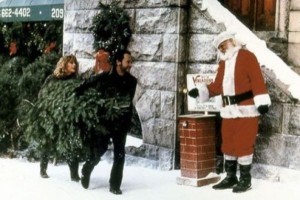
When Harry Met Sally is the perfect movie to watch between Christmas and New Year’s–a perennial holiday favorite.
This was my first foray into truly adult comedy, as compared to the Eddie Murphy comedy that just used adult language. When Harry Met Sally has adults dealing with issues of age, marriage, and commitment; and doing so in a funny way.
I left the theater still pondering the question of whether men and women can be friends; but I was certain that, through Sally, I’d gotten a glimpse into the workings of the fairer gender. I certainly didn’t know all I needed to know, but I felt that I’d been educated (through the film’s female perspective) as well as entertained (by the film’s male point of view).
I wanted to know more, and I wanted to laugh as hard as I did in that theater. Because When Harry Met Sally was such a success, the comedies of the 1990s and 2000s kept copying Reiner’s formula, and I watched dozens of them hoping to feel the same as I did in 1989.
I followed Ryan to French Kiss, Sleepless in Seattle, Addicted to Love, and many more hoping to see, but never finding, the magic she possessed as Sally. Only You’ve Got Mail came close.
I also followed Billy Crystal to the forgettable Forget Paris, but enjoyed his comedy more in City Slickers and Analyze This.
When neither Crystal nor Ryan repeated their success I tried to find this type of on-screen chemistry with other known actors. From Sandra Bullock and Bill Pullman in While You Were Sleeping, to Nicholas Cage and Bridget Fonda in It Could Happen to You, to several Friends stars in films best forgotten, I watched them all.
Most of them were terrible.
Not only did these movies lack the insight and wit of When Harry Met Sally, the genre itself slowly degenerated before my eyes. Initially the films would try to replicate Reiner’s delicate balance of romance and comedy, but in time they changed to focus far more on the romance, less on the comedy, becoming base female wish fulfillment. By the mid-90s the vast majority were, indeed, the “chick flick RomComs” that Jakob taunts me for watching. There were a few gems in the bunch, such as The Wedding Singer, There’s Something About Mary, Bridget Jones’ Diary and The 40-Year-Old Virgin, but, by and large, they were junk that left me bored.
But if I was not entertained, was I educated? Did this deep dive into the world of female-targeted cinema give me insights into women? Well, in the past 25 years I’ve learned a lot, and mostly it’s that everyone is a unique individual. My quest to learn some magic secret about “all women” was doomed to fail because each woman is her own person. I learned that not through film, but through dating and, eventually, marriage.
I also learned the answer to Reiner and Ephron’s main question — yes, men and women can be friends. The best marriages are those where the two are friends. I feel lucky to have that where my best friend is my wife.
So maybe When Harry Met Sally taught me something after all.
Tomorrow: 1990!
Arnie is a movie critic for Now Playing Podcast, a book reviewer for the Books & Nachos podcast, and co-host of the collecting podcasts Star Wars Action News and Marvelicious Toys. You can follow him on Twitter @thearniec
August 19, 2014 Posted by Arnie C | 40-Year-Old Critic, Movies, Now Playing Podcast, Podcasts, Reviews | 1980s, 40-Year-Old Critic, Billy Crystal, Bruno Kirby, Carrie Fisher, Comedy, Meg Ryan, Movie, Movies, Now Playing, Now Playing Podcast, Orgasm, Podcasts, Review, Reviews, Rob Reiner, Romance, Romantic Comedy, Romcom, When Harry Met Sally | Comments Off on 40 Year-Old-Critic: When Harry Met Sally (1989)
40 Year-Old-Critic: Hellbound – Hellraiser II (1988)
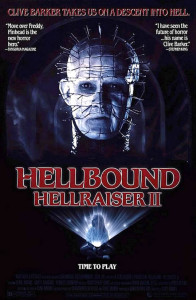 In The 40-Year-Old Critic, Venganza Media creator and host Arnie Carvalho recalls a memorable film for each year of his life. This series appears daily on the Venganza Media Gazette.
In The 40-Year-Old Critic, Venganza Media creator and host Arnie Carvalho recalls a memorable film for each year of his life. This series appears daily on the Venganza Media Gazette.
When I was young I was scared of horror. Not horror films, mind you, but the actual concept of horror petrified me. I mentioned in my earlier article discussing 1979’s Love at First Bite that even watching Dracula on television required an adult be home to protect me.
Yet, I was curious… I wanted to see it while I was frightened of what I might find.
The best analogy I can use for my view of horror is, indeed, the Lament Configuration puzzle box featured in the Hellraiser movies. I was a voyager seeking forbidden knowledge, but once the box was opened the pleasures, and terrors, inside would forever be unleashed. If I watched a horror film the hooks would be in my flesh, and what I would see were images relegated to the domain of nightmare.
I wanted to go there, but I took tentative steps over several years. As a very young child I stuck mostly to the safe horrors of Scooby-Doo ghosts and the seemingly supernatural mysteries in The Three Investigators young adult novels. At age 7 I tried to stretch my own limits by leaving the safety nets of kiddie fare behind and attempting to endure adult horror.
I saw The Shining on television in the early 1980s and was petrified by the decaying woman in the bathtub. I watched Frank Langella in Dracula around the same time. I would see ads for horror films like Return of the Living Dead, Friday the 13th, and Psycho III, read the reviews, and talk endlessly about them with classmates.
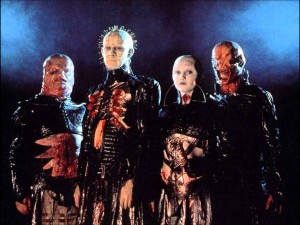
Like the cenobites I too wanted to explore the further regions of horror.
Finally, when I was 8 years old, I tried to face horror. I came home from school one day to find our hosted teenage exchange students were watching Friday the 13th on the VCR. My afterschool ritual was to watch a movie, often Star Wars or Grease, but these Brazilians had monopolized the machine. I was not going to change my routine, so if I could not pick the movie then I would just watch theirs. Not five minutes passed before I saw Mrs. Voorhees decapitated and I fled the room.
That image haunted me for years.
But as I grew into adolescence I wanted to stretch my boundaries further, and I did, starting with horror novels. I found the page safer than the screen, as the written word was always limited by the boundaries of my own imagination. I went further at age 12 and had my first horror movie marathon with the A Nightmare on Elm Street 1 and 2. While I did have a few nightmares of my own I loved every minute of it. I immediately started to consume all the horror I could, reading Fangoria magazine and watching more Stephen King films, the Friday the 13th series, Child’s Play, The Lost Boys, and more.
Within a year I was still captivated, but also starting to bore of the same routine. The vast majority of horror films I watched were slashers, each starring a new group of stereotypical teen characters taken to the slaughter. I had entered the realm of horror to stretch my boundaries, but I just found the same stories again and again. I had faced those fears and I wanted more. I wanted to be tested anew.
Then came Hellbound: Hellraiser II. I had known about the original Hellraiser from the ads. Stephen King’s words were put on the movie screen in a giant font: “I have seen the future of horror and his name is Clive Barker.” Trailers for the first Hellraiser raised my curiosity but the film never came to my town. In 1988, before I’d even had a chance to see Hellraiser on video, its sequel Hellbound came to theaters. The monstrous-looking Cenobites graced the poster. In the movie these creatures described themselves as, “Explorers in the further regions of experience. Demons to some, angels to others.” They were just what I wanted.
Being only 13, I couldn’t find any adult foolish enough to take me to see Hellbound. My parents were lax and would buy me tickets to A Nightmare on Elm Street films, but something about the Hellraiser series made them nervous. I had to wait for video, but the day Hellbound hit VHS I rented it and its predecessor.
I don’t know what I expected the movie to be, but my memory was of fevered excitement. I was going to see something forbidden; I expected something akin to a snuff film. I expected to be changed.
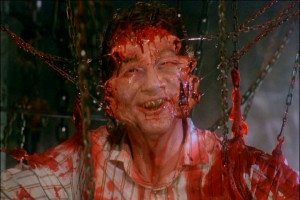
I wanted extreme…I got it. This was one of the first frames I saw of Hellraiser.
By complete accident I put Hellbound in the VCR first and it opened with a montage of the goriest, scariest scenes from the first film. I saw Larry (Andrew Robinson), his flesh stretched by hooks on chains. His distended face leaked more than just blood, and he slurred a blasphemous “Jesus… wept” before exploding into chunks of flesh.
Just these opening frames of Hellbound were an orgy of death and carnage. I was scared. I was nauseated. I was excited. I couldn’t bear to watch, yet I couldn’t turn away.
I had found exactly what I wanted in that damned puzzle box.
Eventually the opening credits started and I hit “stop” so I could watch the films in the correct order. I realized that this was not a Faces of Death-type snuff film but rather a mostly conventional horror film with a crazy woman seducing men and then killing them. Still, I had found a horror more pure, and more imaginative, than even Freddy. Pinhead and his varied demonic cohorts were immortal evil incarnate.
The first film had the better gore, but the second expanded the world further. In Hellbound we got to see the creation of a cenobite and travel to their labyrinthine realm; all taking place in an insane asylum — the heart of madness.
Yet the entire mad experience was accompanied by an amazing orchestral score by Christopher Young. From the disarming lullaby that played when the box was opened to the crescendos that sound like the soundtrack for the end of days, Young’s score stuck with me every bit as much as the latex work. I was no fan of Young’s given his “whale song” music for A Nightmare on Elm Street 2: Freddy’s Revenge but he redeemed by Hellraiser. I’ve still not heard a score he’s done better.
In the years since seeing Hellbound I have encountered many horror fans who claim the original Hellraiser is the only one worth watching. I disagree. Perhaps it was because I experienced them as a double-feature, prompted by the marketing for Hellbound, but I see the first two Hellraiser films as parts of a whole.

The matte work may not be cutting edge but Hellbound expanded the mythology of the Hellraiser franchise.
Yes, the first movie had a more visceral feel, but it also had long scenes of Kirsty Cotton (Ashley Lawrence) walking the streets of London. The sequel truly fulfilled Kirsty’s character arc and allowed her to escape the madness forever, or at least until the direct-to-video Hellraiser VI.
After seeing Hellraiser and Hellbound I felt I had gone to the limits of horror. I tried to explore further by reading Clive Barker’s books and seeing his follow-up films Nightbreed and Lord of Illusions. They couldn’t live up to the horrors of Hellraiser.
Repeatedly I’ve felt that Barker is the man who comes closest to taking the terror of nightmares and putting it on the page or screen, but he always falls just short.
For more than a decade the Hellraiser duology would be my bar for terror and horror, and they are both films I appreciate to this day.
I continue to try and find new boundaries to push in every aspect of life. I find contentment to be equal to death and I want to be pushed further. In the 25 years since first seeing Hellbound I’ve discovered films that grossed me out more (Human Centipede comes to mind), but none that felt as forbidden as the first two Hellraiser films.
I will continue to find the next cinematic puzzle box, and when I find it I’ll open it without hesitation.
Tomorrow: 1989!
Arnie is a movie critic for Now Playing Podcast, a book reviewer for the Books & Nachos podcast, and co-host of the collecting podcasts Star Wars Action News and Marvelicious Toys. You can follow him on Twitter @thearniec
August 18, 2014 Posted by Arnie C | 40-Year-Old Critic, Movies, Now Playing Podcast, Podcasts, Reviews | 1980s, 40-Year-Old Critic, Barker, Books, Books & Nachos, Cenobite, Clive, Clive Barker, Enertainment, Film, Hellbound, Hellraiser, horror, Movie, Movies, Now Playing, Now Playing Podcast, Pinhead, Podcasts, Review, Reviews, Sequel | 1 Comment
40 Year-Old-Critic: Wall Street (1987)
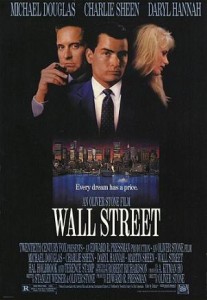
In The 40-Year-Old Critic, Venganza Media creator and host Arnie Carvalho recalls a memorable film for each year of his life. This series appears daily on the Venganza Media Gazette.
Growing up I wanted to be a stockbroker. Other kids said they wanted to be astronauts, movie stars, or firemen; I said stockbroker. In my preteen years I upgraded that to investment banker.
Why wouldn’t I want to go into that world? I grew up in the big 80s, the era of Reaganomics. Money was being flashed everywhere, and it wasn’t just the musicians and actors who had rich and famous lifestyles; there were also names like Ivan Boesky, Carl Icahn, Jordan Belfort, and Donald Trump.
My godfather, who rode the stock market to a healthy retirement, told me that the brokers had the best gig — no matter if their clients won or lost, the broker got the commission.
What did I really want to be when I grew up? I wanted to be rich. I saw the stock market as the avenue to that lifestyle. When I turned 13 I even became a stock owner, my godfather buying me some shares of Ohio-Edison.
That dream crashed in 1987, starting with Black Monday, when the Dow Jones Industrial Average dropped 508 points (which would still make headlines today, but back then it was almost 25 percent of the Dow’s value). I heard stories of broker suicides and rich people in ruin. My faith in the avarice of the economy was shaken.
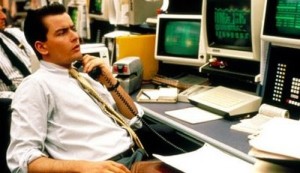
As a child this wasn’t how I envisioned the job of a stock broker.
It was broken entirely two months later when I saw Oliver Stone’s Wall Street. I had looked forward to that film for months. I didn’t know much about Stone (I hadn’t yet seen Platoon), but I knew his name and his Oscar-winning reputation.
Had I researched the man further I would have known that Wall Street wasn’t going to be what I expected, which was a more realistic version of The Secret of My Success.
Instead I saw a film to which I could relate a bit too well. Charlie Sheen played Bud Fox, an up-and-coming broker barely making ends meet. The early scenes that give you a glimpse into the life of the average, front-line broker did not depict the glamorous lifestyle I’d seen on television — it actually looked like Bud might have earned less than a talented bartender.
The high-pressure nature of the business and the cold-call sales techniques combined to make Bud hungry and bitter. Even as a kid I could relate to him; his drive to get out of the phone pool and make a name for himself.
But then we were introduced to Michael Douglas as Gordon Gekko. I had seen Douglas a few months earlier in Fatal Attraction and thought of him as a good guy. In Wall Street he’s a ruthless, wealthy businessman, but I envisioned him almost as a guardian angel that would show Bud the road to riches.
Instead Gekko turned out to be a greedy, deceitful, vengeful criminal. He corrupted Bud with promises of women and riches until the young businessman betrayed his own father in service of his mentor.
Bud redeemed himself — he came up with a plot to save his father’s company — and served time for his misdeeds, but as Sheen’s character was taken to prison I found myself finally questioning this lifestyle I had coveted for years.
Stone told the story exactly how it should have been told in 1987; show the flash, the cash, the allure of riches in the big 80s. Then show the cost, including the broken relationships, the drug hangovers, and the realization that Bud’s “friends” (and even his girlfriend) all disappeared when the money was gone.
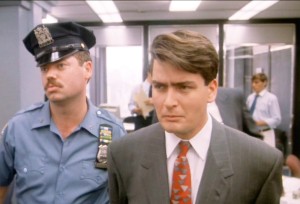
This was the image that struck me hardest from the film. Not the penthouse, not the girl, but the consequences.
This was a movie with a social commentary, and one that should have been made louder and more often in the 80s. The “Greed is Good” mentality prevailed as the economy boomed, but while the success stories got the press, little attention was paid to the illegal and immoral activities undertaken by so many to achieve those ends.
More, the film could not have had a luckier release schedule, if you can ever call Black Monday “lucky.” The stock market was on everyone’s minds and tongues, questioning this ethereal concept of non-liquid assets in a grand trading scheme. Stone’s message rang true, for a period.
I now feel the message of Wall Street has been lost. The stock market is more vital to the lives of Americans than ever thanks to 401(k) plans and other reliances. Despite the crash of the NASDAQ at the turn of the century (when several of my close friends lost everything) and the crash of the Dow in 2007, it seems Americans still like to play the market like a Blackjack table.
More, Gordon Gekko and his “Greed is Good” speech have become lionized by today’s hungry, young businessmen. Even this year’s The Wolf of Wall Street seemed to play up the glamour of Jordan Belfort’s illegally-funded lifestyle rather than focus on the victims he snookered.
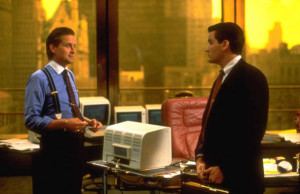
“Please allow me to introduce myself. I’m a man of wealth and taste.”
Had Stone been a different filmmaker and Wall Street a more Wolf-ish tale perhaps my ambitions would have redoubled. I might be a very wealthy man today, or I might be in prison. Fortunately I saw the right movie at the right time. In 1987 and now, Stone’s message rang true. I went in wanting it all, and I left the theater a boy without a goal, perhaps slightly more normal for that.
For that life-changing course — setting me on a path where I would end up helping people by day and entertaining people by night — Stone’s film will always remain a profound symbol of how art can change the direction of your life.
Not all films are pure entertainment, the best ones raise questions as well.
Tomorrow — 1988!
Arnie is a movie critic for Now Playing Podcast, a book reviewer for the Books & Nachos podcast, and co-host of the collecting podcasts Star Wars Action News and Marvelicious Toys. You can follow him on Twitter @thearniec
August 17, 2014 Posted by Arnie C | 40-Year-Old Critic, Movies, Now Playing Podcast, Podcasts, Reviews | 1980s, 1987, 40-Year-Old Critic, Bud Fox, Charlie Sheen, Enertainment, Film, Gordon Gekko, Michael Douglas, Movie, Movies, News, Now Playing, Now Playing Podcast, Oliver Stone, Podcasts, Review, Reviews, Stock Market, Wall Street | 2 Comments
40 Year-Old-Critic: Howard the Duck (1986)

In The 40-Year-Old Critic, Venganza Media creator and host Arnie Carvalho recalls a memorable film for each year of his life. This series appears daily on the Venganza Media Gazette.
In 1986 I was obsessed with, and repulsed by, one film.
It starred a creature not entirely human, nor entirely animal.
The creature wanted to mate with its frizzy-haired, yet attractive, female co-star.
The film also featured a teleportation plot and a once-gentle scientist that slowly transforms into a beast.
That film was David Cronenberg’s remake of The Fly, and even its trailers scared the bejesus out of me. Those trailers ran before nearly every movie I watched. I was 11 years old, but still needed to leave the theater when I’d see The Fly approaching.
I was afraid. I was very afraid.
If I was writing this retrospective before 2011, this article would have focused on that film and how it pushed my adolescent boundaries into new territories.
But now I am going to write about Howard the Duck.
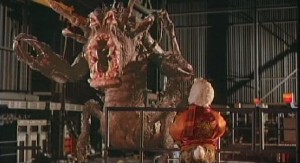
This is what I see in the ink blot…
Or, more accurately, I’m going to write about talking about Howard the Duck. I think I’ve said everything I needed to say about the notorious 1986 bomb three years ago when I reviewed it — alongside co-hosts Stuart and Jakob — for Now Playing Podcast. I discussed seeing the film in theaters, reading the novelization (which I reviewed as well, on the Marvelicious Toys podcast), and even seeing the Dark Overlord in a Rorschach Test. After more than two hours discussing Howard the Duck, what more could I have to say?
Plenty, it turns out. It was a complete accident, but Howard the Duck changed my life.
As I discussed on that show, I’d always had a kitschy fascination with George Lucas’ follow-up to Return of the Jedi. I knew people hated it, but didn’t understand why. It followed the Ghostbusters formula to a T: creatures from another plane come to Earth, wacky scientists try to determine the cause, and hilarity ensues. It even ends with one of the main characters transforming into an evil beast and the fate of the world determined by an animated laser battle between the heroes and giant, evil creatures.
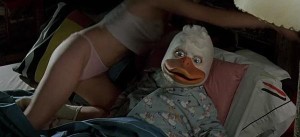
“They let kids watch this film????”
I loved Ghostbusters, and I loved Howard the Duck even more — as Sigourney Weaver’s Dana never wore anything close to the slinky, sexy outfit that perfectly framed Lea Thompson’s Beverly.
Though it had been 25 years, I was excited by the chance to review Howard the Duck for Now Playing Podcast. Our movie review show was coming up on its 4th anniversary and it had always been a way for me to discuss films for which I had passion. Whether I loved a film or hated it, if I felt something then I wanted to talk about it.
Around this time the show was also finally starting to find some success. Our early, short-form reviews had downloads that measured in the teens. With our Friday the 13th Retrospective Series — something I envisioned as a quick one-off — downloads jumped from the teens to the thousands.
We continued to work hard and over the years our audience started to find us. We were still a small fish in a large sea, but we had grown from a dwarf puffer to at least a catfish.
The success of our 2010 A Nightmare on Elm Street series emboldened me, and, that same year, Iron Man 2 inspired me. After seeing Iron Man, War Machine, Nick Fury, and Black Widow share the screen I could not contain my excitement for The Avengers. So I pitched to Stuart and Jakob the biggest retrospective series ever: all of the Marvel movies, in order, starting with Howard the Duck.
There was quite a bit of negotiation, wrangling, and reordering of movies; but between May 2010 and March 2011 we came to an accord and the Now Playing Marvel Movie Retrospective began.
It was our biggest series, or biggest gamble, and it all hinged on Howard.
Perhaps it was the buildup, but that show always seemed special. We were coming off the Philip K Dick Retrospective Series, which had been pushed to Spring 2011 after The Adjustment Bureau’s release date changed. Downloads were low on the Dick series and there were some production issues. By the time we hit The Adjustment Bureau morale behind-the-scenes was low.
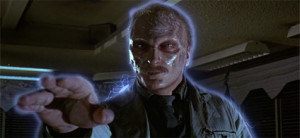 All of that changed with Howard. To my memory, that was the first Now Playing review that, in its raw audio, went more than three hours. Over the course of two years I had allowed Now Playing’s runtime to grow, but only one show had ever gone more than 2 hours: the 2010 review of the A Nightmare on Elm Street remake.
All of that changed with Howard. To my memory, that was the first Now Playing review that, in its raw audio, went more than three hours. Over the course of two years I had allowed Now Playing’s runtime to grow, but only one show had ever gone more than 2 hours: the 2010 review of the A Nightmare on Elm Street remake.
I spent about 80 hours editing our Howard the Duck review, trying to hold to the editor’s axiom of “kill your darlings.” But I just couldn’t do it.
Even during my 11th pass on the Howard the Duck review I was still laughing out loud at the jokes.
Before I even finished the edit I knew that show was something special. I just prayed it would find an audience.
It did.
Maybe it was the press releases I had sent, maybe it was the social media promotion, but for the first time, Now Playing Podcast broke through iTunes’ Top 10 TV/Film audio podcast rankings. It took a few days after the show was released, but we had done it!
That spot increased our visibility, and the downloads multiplied exponentially. To go from the unsuccessful Dick series to the top of the iTunes charts was just incredible. Howard the Duck became iTunes’ 5th most downloaded episode in the aforementioned category.
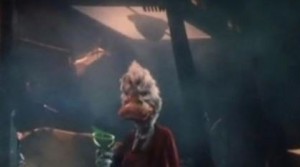
Howard had a theatrical come-back this year, but this mangy fowl is NOT my Howard! The costume in 1986 looked better than this.
The success was so astounding I actually hesitated before releasing the next show. I knew our Man-Thing podcast was also pretty funny, but the newest show is always the most downloaded. Downloads of Howard were sure to decrease.
Still, we had a schedule, and so Man-Thing went out on time, and became iTunes’ No. 1 most downloaded TV/Film audio podcast. The following week we reviewed Kick-Ass and it grabbed the No. 1 slot, pushing Man-Thing into second place.
Stuart, Jakob, and I were stunned. It was unbelievable to look at the iTunes rankings and see Man-Thing at the top. I have since joked that more people listened to our review of Man-Thing than actually saw that damn film.
One thing we all agreed on — it was Howard the Duck that launched those shows to the top. Howard was a special show, combining serious film criticism with a terrific dose of humor, making fun of ourselves as well as the film, and we knew that was why listeners kept coming back to our show.
Now Playing has had its ups and downs since then. Some shows and retrospectives click more with audiences than others, and some shows I am more proud of than others. Still, it was with Howard the Duck that all the pieces fell into place and listeners responded.
For those reasons I will always love that duck.
I have stated at least twice on the podcast that I wish I could turn that “Red Arrow” grade for Howard into a “Green Arrow” on our site. I realize the film has its flaws — I still believe the second act drags — but I enjoy it anyway. I gave Howard the review I did not because I didn’t like the movie, but because I didn’t think others would find the same enjoyment. After all, our end rating is always a “recommendation” and not a “thumbs up.” When I give the “Green Arrow” I’m not saying, “I like this movie,” I’m saying, “I think you will like this movie.”
Well, I knew back then that I liked Howard the Duck in spite of the flaws.
That fondness has grown as, through Now Playing, I’ve become closely associated with that “fowl” creature. Stuart and Jakob were with me in the review, but I was Howard’s champion (and the one that saw the Dark Overlord in a Rorschach test). Over the past three years that special relationship with this childhood guilty pleasure has grown.
I started collecting a few trinkets from the Howard the Duck film — the old trading cards, a candy cigar, a mini duck head that once held sugar treats. Then I got the Bowen statue, the Toy Biz figure. Finally, this year, I took the plunge — one of the Industrial Light and Magic creature shop workers was selling several Howard the Duck production pieces.
On my desk, a foot from me as I write, is a glass egg that Lucasfilm gave to crew and press back in 1986. Inside that egg is a single duck feather. The Howard the Duck logo on the front makes me smile, not because of that 1986 film about a duck trapped in a world he never made, but because of the podcast that I made that found its place in the world.
Tomorrow — 1987!
Arnie is a movie critic for Now Playing Podcast, a book reviewer for the Books & Nachos podcast, and co-host of the collecting podcasts Star Wars Action News and Marvelicious Toys. You can follow him on Twitter @thearniec
August 16, 2014 Posted by Arnie C | 40-Year-Old Critic, Comic Books, Marvelicious Toys, Movies, Music, Now Playing Podcast, Podcasts, Reviews | 1980s, 40-Year-Old Critic, Action, Collecting, Comic Books, Comics, Enertainment, Film, George Lucas, Marvel, Marvel Comics, Marvelicious Toys, Movie, Movies, News, Now Playing, Now Playing Podcast, Podcasts, Review, Reviews, sci-fi, Toys | Comments Off on 40 Year-Old-Critic: Howard the Duck (1986)
‘Turtles’ Power Now Playing on iTunes, ‘Children’ lurking
Now Playing Podcast is leaving the sewers and venturing into the cornfields.
Venganza Media’s flagship podcast capped its Teenage Mutant Ninja Turtles Retrospective Series this week with its review of the Michael Bay-produced franchise reboot. The film marked the Turtles’ return to the big screen after a 7-year layoff and captured the box office crown on opening weekend.
Now Playing Podcast marked its own triumph on Thursday, when its Teenage Mutant Ninja Turtles (2014) episode debuted at No. 5 on iTunes’ TV & Film audio podcast rankings.
The achievement extends Now Playing’s summer winning streak, highlighted by the Teenage Mutant Ninja Turtles II episode, which peaked at No. 2 on iTunes in late July.
Throughout the TMNT series, hosts Arnie Carvalho, Stuart Atkinson and Jakob Brewster have guided listeners through the highs and lows of Ninja Turtles lore, and ventured outside of the feature films to discuss long-forgotten turns in the franchise’s history, including the infamous Coming Out Of Their Shells concert tour.
“Turtle Power is a real thing, it cannot be underestimated,” Atkinson joked. “I give all the credit to those green guys. They’ve been through hell at the movies and they deserve a little Top 10 love.”
With the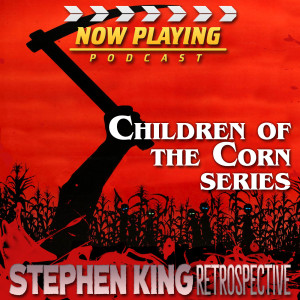 Turtles franchise now in their rear view, the hosts are set to begin the next chapter in Now Playing’s massive Stephen King retrospective. The series, which began last fall, picks up again Aug. 19 with Children of the Corn, a nine-episode arc that will complete Now Playing’s coverage of King’s Night Shift collection.
Turtles franchise now in their rear view, the hosts are set to begin the next chapter in Now Playing’s massive Stephen King retrospective. The series, which began last fall, picks up again Aug. 19 with Children of the Corn, a nine-episode arc that will complete Now Playing’s coverage of King’s Night Shift collection.
The first Corn adaptation hit theaters in 1984 and was followed by seven poorly-received sequels, as well as a television remake. Fans of Now Playing’s earliest horror retrospective series’ can look forward to the hosts continuing their discussion of Hollywood’s sequel addiction as they try their best to remain composed in the face of mediocre filmmaking.
“Reviewing Night Shift has been a long haul, and I say that as the King fan!” Carvalho said. “I haven’t watched most of these Corn films, but they made nine of them — there has to be something there, right?”
“Nine films? Most direct-to-video?” Brewster added. “I just hope I can come up with enough corn puns to bring a kernel of humor to our listeners’ ears. Sigh.”
The Children of the Corn series will carry Now Playing Podcast into early October, before the hosts embark on a journey through the films of director Christopher Nolan, leading up to the release of November’s Interstellar.
August 14, 2014 Posted by Arnie C | News, Now Playing Podcast, Podcasts | Arnie, Children of the Corn, iTunes, Jakob, News, Now Playing, Now Playing Podcast, Podcast, Podcasts, Stephen King, Stuart, Stuart in LA, Teenage Mutant Ninja Turtles | Comments Off on ‘Turtles’ Power Now Playing on iTunes, ‘Children’ lurking
40 Year-Old-Critic: Beverly Hills Cop (1984)
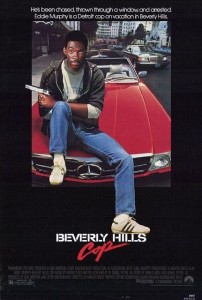 In The 40-Year-Old Critic, Venganza Media creator and host Arnie Carvalho recalls a memorable film for each year of his life. This series appears daily on the Venganza Media Gazette.
In The 40-Year-Old Critic, Venganza Media creator and host Arnie Carvalho recalls a memorable film for each year of his life. This series appears daily on the Venganza Media Gazette.
For as long as there have been movies, there have been movie stars.
As early as the 1910s film studios realized familiar faces could bring in audiences. From Florence Lawrence to Humphrey Bogart, Marilyn Monroe to Charlton Heston, Tom Cruise to Will Smith, the right movie star can trump story, script, and even production value and turn terrible films into box office gold.
As a child, though, I didn’t understand the concept of following actors; instead, I followed characters. I wanted to see the next film with Kermit the Frog, Luke Skywalker, or God. I wasn’t thinking about Jim Henson, Mark Hamill, or George Burns.
That changed in 1984 when I found my first cinema idol, the man I wished I’d grow up to be.
Much to my parents chagrin, that man was Eddie Murphy.
I was not much of a Saturday Night Live fan when I was young. While I didn’t have a set bedtime, midnight was a bit later than I usually stayed up. I’d seen the show a few times but I was neither a fan, nor did I even know the comedians in the cast.
But in 1984 I had become a cinephile, seeing dozens of films in theaters and countless more on VHS. In addition to the standard kids fare, like Ghostbusters and The Neverending Story, my tastes were starting to evolve. Thanks to Siskel & Ebert I was asking my parents to take me to see some movies where I was clearly not the target audience, such as Amadeus, as well as the fairly risque Johnny Dangerously (I saw it in theaters once… once).
My older sister Susan, home from college for Christmas break, witnessed my maturing interest in film and felt there was one movie phenomenon I was totally missing: Beverly Hills Cop. It had been out a few weeks and had started to build amazing buzz. Critics loved it, and it was topping the box-office.
 But it had a hard-R rating, with nudity, intense gun violence, and more curse words than I could count. My parents were fairly lax about what media I consumed (a year later they’d let me rent Revenge of the Nerds knowing full-well what I was about to see), and Susan decided it’s better to beg forgiveness than to ask permission. So she took me to the mall, ostensibly to Christmas shop, but, in fact, to see my first R-rated film: Beverly Hills Cop.
But it had a hard-R rating, with nudity, intense gun violence, and more curse words than I could count. My parents were fairly lax about what media I consumed (a year later they’d let me rent Revenge of the Nerds knowing full-well what I was about to see), and Susan decided it’s better to beg forgiveness than to ask permission. So she took me to the mall, ostensibly to Christmas shop, but, in fact, to see my first R-rated film: Beverly Hills Cop.
I was absolutely awestruck. I had never seen a movie as extreme as this.
The story, originally intended to star Sylvester Stallone, followed fast-talking Detroit police detective Axel Foley’s trip to Los Angeles investigating the murder of his childhood friend. But the cop becomes the criminal when clues point to wealthy art dealer Victor Maitland, and police actually authorized to act in the Beverly Hills jurisdiction try to reign in Foley’s unorthodox inquest. The result is quite a bit of 80’s action, as well as the usual fish-out-of-water jokes, as Foley works both with and against the Beverly Hills Police Department in trying to bring his friend’s killer to justice.
The violence excited and frightened me. I’d seen guns on the big (and small) screen, but before Beverly Hills Cop I’d never seen a man shot twice in the head; chunks of the victim’s skull falling to the carpet. I’d seen car chases on Dukes of Hazzard and other shows, but none had the metal carnage like the truck chase in the film’s opening minutes. I’d seen machine gun shootouts on The A-Team, but those didn’t actually have people falling dead from the wounds.
Then there was the language. My parents had been known to use a few choice words but never had I heard expletives used in this way. Murphy had gone beyond just cursing, he turned his Beverly Hills Cop dialogue into a virtual tone poem of profanity. So shocked was I that I completely misunderstood the main character’s name — in my mind Murphy starred as “Asshole Foley”, with every single character referring to him by that descriptive term. Given the way he acted, who could blame them?
Yet, the entire picture was set to a light, pop score. The synth tones of Harold Faltermeyer ran throughout, interrupted only by chart-topping hits by The Pointer Sisters, Glenn Frey, and Vanity. I was never afraid or scared, I was enthralled. My adrenaline was pumping, I was rocking, and, most importantly, laughing. I had never before experienced a film that felt subversive, like I was seeing a peek into the adult world, hearing how they talked with no kids around.
I loved it.
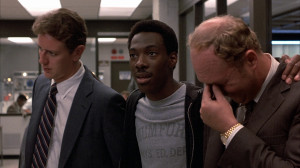 More, I loved Eddie Murphy. The comedian is in nearly every frame of Beverly Hills Cop and his energy is infectious. Here the actor perfected the con-artist persona he previously used on the small screen, as well as in 48 Hours and Trading Places. No matter how dangerous the situation, I knew Murphy would be able to talk, joke, or shoot his way out of it. I don’t recall ever laughing quite as hard as I did in that theater watching Axel Foley stick a banana up the tailpipe of that car staked outside his hotel.
More, I loved Eddie Murphy. The comedian is in nearly every frame of Beverly Hills Cop and his energy is infectious. Here the actor perfected the con-artist persona he previously used on the small screen, as well as in 48 Hours and Trading Places. No matter how dangerous the situation, I knew Murphy would be able to talk, joke, or shoot his way out of it. I don’t recall ever laughing quite as hard as I did in that theater watching Axel Foley stick a banana up the tailpipe of that car staked outside his hotel.
I walked out of the theater ecstatic. I wanted to see more. For the first time in my life I was starstruck and wanted to see everything Eddie Murphy had done or would do.
I made it a point to stay up late that week and watch Murphy host Saturday Night Live (his “White Like Me” sketch still makes me laugh). Quickly I went to the video store to rent his previous two hits. And I went opening weekend, again with Susan, to see The Golden Child.
Yes, I even bought the novelization to try and quell my excitement two years later for Beverly Hills Cop II.
I started buying Eddie Murphy comedy albums and watching Raw and Delirious. Through those specials I connected with Murphy, because I realized I idolized him as Murphy in his youth idolized Richard Pryor. I even found myself trying to tell Eddie Murphy-style jokes, and, for a time, flirted with the idea of doing stand-up comedy. I didn’t have much of a sense of humor as a child; I developed it in my teen years and Murphy was my teacher.
My parents were not overly fond of their son’s new hero. The string of profanity that emitted from our family room television would prompt my mother to use a few choice words of her own.
I didn’t see it the way she did. Murphy’s complete ownership of his vocabulary allowed me to see the power words have without fear. As a young kid I would curse for the wrongness of it, but Murphy helped me see that cursing punctuates language with an emphasis that nothing else can emulate.
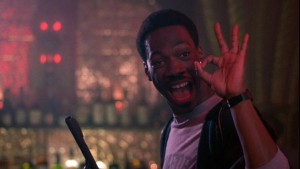 Older generations would state that swearing was for the dumb; Murphy showed me the truly intelligent know-how to wield every word for maximum impact. Some listeners have complained about the language we sometimes use on Now Playing Podcast, but I would not change a syllable. I believe the complete use of the English language allows me to express myself uniquely and clearly. I learned that from Murphy’s ad-libs and stand-up routines.
Older generations would state that swearing was for the dumb; Murphy showed me the truly intelligent know-how to wield every word for maximum impact. Some listeners have complained about the language we sometimes use on Now Playing Podcast, but I would not change a syllable. I believe the complete use of the English language allows me to express myself uniquely and clearly. I learned that from Murphy’s ad-libs and stand-up routines.
I wasn’t the only one to fall under Axel Foley’s influence. Beverly Hills Cop became the first R-Rated film — and the first comedy — to gross more than $200 million at the box office. That was a very exclusive group well into the 1990s.
Murphy even beat fellow Saturday Night Live alums Bill Murray and Dan Aykroyd, with Cop making more money in 1984 than Ghostbusters.
I must admit that Ghostbusters, with its lighthearted comedy, special effects, and giant Marshmallow Man, left a cinematic legacy that may be greater than Beverly Hills Cop. The Ghostbusters formula is aped to this day with films like R.I.P.D., Men in Black, and Evolution. There’s even a director signed for Ghostbusters III.
On the other hand, I don’t feel Murphy has aged as well. While his box-office mojo reigned for many years, even as a child I knew his follow-up films, The Golden Child and Beverly Hills Cop 2, didn’t measure up to his first star vehicle. While Coming to America was a brief return to form, it was also the last time I loved an Eddie Murphy film.
After The Distinguished Gentleman I realized his films had dropped significantly in quality, but due to my childhood devotion, I saw every film Murphy released through the 1980s and 1990s (yes, even Holy Man and Life). I watched every new Murphy movie hoping to laugh as hard as I did in Beverly Hills Cop and Coming to America. I finally gave up in 2001, I could not abide Pluto Nash.
But Murphy was the first movie star to impact my viewing habits. For that reason, even though I should know better, I continue to cross my fingers and hope the “Asshole Foley” I know and love will be back in Beverly Hills Cop IV.
Arnie is a movie critic for Now Playing Podcast, a book reviewer for the Books & Nachos podcast, and co-host of the collecting podcasts Star Wars Action News and Marvelicious Toys. You can follow him on Twitter @thearniec
August 14, 2014 Posted by Arnie C | 40-Year-Old Critic, Movies, Now Playing Podcast, Podcasts, Reviews | 1980s, 40-Year-Old Critic, Action, Beverly Hills Cop, Comedy, Eddie Murphy, Enertainment, Film, Ghostbusters, Movie, Movies, Now Playing, Now Playing Podcast, Podcasts, Review, Reviews | 6 Comments
40 Year-Old-Critic: Return of the Jedi (1983)
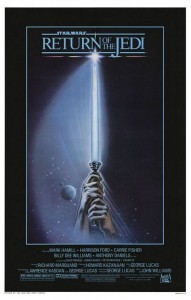 In The 40-Year-Old Critic, Venganza Media creator and host Arnie Carvalho recalls a memorable film for each year of his life. This series appears daily on the Venganza Media Gazette.
In The 40-Year-Old Critic, Venganza Media creator and host Arnie Carvalho recalls a memorable film for each year of his life. This series appears daily on the Venganza Media Gazette.
Anticipation for a film can be like great sex.
The foreplay starts when the film is announced, giving fans a hint that something great is to come. The slow build of anticipation can be excitingly agonizing. News bits are teased like a nibble on your earlobe, pictures are released from the set — the brief flashes making moviegoers anxious for the full reveal — and quotes tease the mind with plot threads as vague as an erect nipple through a cotton blouse. Finally, it all climaxes on the opening weekend; and that first viewing can sometimes be even better than the build up, or it can be a frustrating experience as the film exposes itself as something lesser than the fantasy built up in your mind.
To properly hype a film is a delicate dance. Studio marketing teams must be careful not to show too much too quickly, while still ensuring the filmgoer remains not only interested, but almost intoxicated by the perfume of previews.
I learned all of this as an 8-year-old. The film that taught me this lesson was Return of the Jedi.
Up until the spring of 1983 moviegoing was always spurred by an adult in my life. Even when I picked the film we attended I chose by simply looking at the newspaper listings, with no knowledge of release dates or whether the film was leaving theaters soon.
I usually became aware of a film upon its release. As mentioned in yesterday’s E.T. article, I watched Siskel & Ebert At The Movies weekly to learn about new films, but until their review aired I knew nothing about new movies being made. I may have seen an ad or two on television or trailers before other movies started, but I was too young for any of that to grab my attention.
I was too young to plan.
But that started to change after The Empire Strikes Back, with its unresolved cliffhanger of an ending. Being only 5 years old when I first saw Empire, I couldn’t fathom waiting three years for a conclusion to a story. After all, that was more than half my lifetime!
Primarily due to the toys, Star Wars was a constant topic of playground conversation, and throughout first, second, and third grade rumors about the next Star Wars film spread through the grapevine like urban legend.
“George Lucas was going to make Return of the Jedi three years after Empire, just as Empire was three years after Star Wars!”
“Then he’s planning to take a break for a few years, and release the next movie — Episode I — in 1989!”
To this day I don’t know how much of the “news” I heard about future Star Wars films was made up, how much came from news and magazines — passed down from parent to child — or how much I’ve learned since that has retroactively mingled in my imaginings.
What I do remember is the anticipation — for years — of that next Star Wars film.
I was not a child who dealt well with suspense. Commercial breaks were often agonizing torture, and season-finale cliffhangers would cause me physical pain — the need to know. But for three years I battled, wanting so badly to see what happened in the final Star Wars film.
Yet, despite all the anguish and all the talk about that third film it never felt real until late 1982 — six months before Return of the Jedi‘s release. When the trailers and magazine articles started, when toys started to hit shelves bearing the new, red Return of the Jedi logo, when bookstores had entire displays of Star Wars books promoting the upcoming film… that was when 8-year-old Arnie went insane.
Toys, books, and magazines were all purchased in anticipation of this film — surrogates I used to try and satiate my desires until the Jedi’s release. My godparents would placate me with a deal: If I did good in school that week, then on Saturday they would take me to buy one action figure.
ONE!?!?! But there were dozens on the store shelves, and so many more to come! I would watch Saturday morning cartoons and make lists of all the figures being released. I took a cardback and would X off each figure I owned as a way of marking time until I could have them all.
My parents, however, were not as indulgent regarding toys. They did however encourage me to read, and so I remember one Sunday going to the (now closed) local bookshop, The Book Emporium. There I saw a massive display of Star Wars novels, and a poster promoting the upcoming release of a Return of the Jedi novelization! That image of two hands clasping the blue lightsaber was burned into my brain, and to this day it is my iconic image of that film. I couldn’t bear it so I badgered my father to buy me all the Star Wars books, and I took my pleasures where I could — reading the novelizations of Star Wars and The Empire Strikes Back to fully re-experience those stories before seeing Return of the Jedi.
Finally, two weeks before the film was out, the novelization by James Kahn was in stores. I bought it the Saturday after it was released and tore into it. I couldn’t wait any longer for Return of the Jedi — the thirteen days until the film would be in theaters was agonizing. I had to have it now. I read like I’d never read before, page after page, excited for every new reveal.
It was a feeling like I was doing something naughty. There was forbidden knowledge in this book! I knew things no one else on the playground knew!
So excited was I about my insight into this upcoming movie that I would regale my sister Susan with anecdotes from the novel. Perhaps wanting me to have a pure movie experience (perhaps just wanting to shut me up), she introduced me to the concept of what we now call a “spoiler.”
She asked me if I was ruining the movie by knowing all about it before I saw it. Now, I wanted to see this movie more than I wanted air to breathe, so I promised her I would not read the last 50 pages. The film’s ending I would save for the screen.
But the waiting was killing me. Never before had I paid careful attention to a film’s opening date, but that year I knew Return of the Jedi would open on May 25. I had never been to an evening movie before — my parents always saved money by taking me to matinees — but Susan promised to take me opening night. My childhood best friend Stuart, now my co-host on Now Playing Podcast, also joined us.
We went early; Susan knowing that her brother wasn’t the only one anxious for Jedi. Still, the line was long at the Fox Theater in Springfield. It ran the full length of the strip mall, and for a half-hour we stood right outside the toy store where I practically drooled over the giant Star Wars toy display in the window.
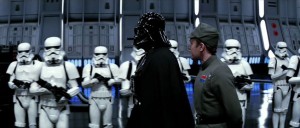
Vader walked the line at our Return of the Jedi screening.
Walking down the line, working the crowd, was Darth Vader. I’d seen costumed characters before on stage shows, and sometimes superheroes would appear at that very same toy store. But those were scheduled appearances. I had no concept of cosplay, and I was somewhat frightened by this tall man carrying the Kenner lightsaber. Part of me knew he wasn’t the real Darth Vader, and part of me hoped he was indeed the Sith Lord come to terrorize my town.
When we got to the box office we were told there were only 3 tickets left for the film — all of us could get in, but we couldn’t sit together. My sister was flummoxed by this, as we were two children in her care for the night.
But I didn’t care who I sat by, or didn’t sit by, just get me in that theater! Sorry Stuart. Sorry Susan. I cared more about seeing Return of the Jedi than spending time with either of you!
That was another radical shift. Up until that point in my life, movies were always a social event. I couldn’t imagine watching a movie alone, and going to a cinema was always as much about time with friends and family as it was the film itself.
Not this time. This time Return of the Jedi and I had to be together. Now.
So in we went. I had an end-of-the-aisle seat next to a stranger. Before the lights dimmed I tried to look around and see where Stuart and Susan were seated, but the theater was large and soon I ceased to care. They never once entered my thoughts as I was transported at 0.5-past-lightspeed to a galaxy far, far away.
The film moved so fast and had so many vivid creature designs that I instantly forgot everything I had read in the book. On the page I had only my own imaginings, and a few photos in the middle of the novel, to aid in the visualization of the story. Now, with dancing Twi’leks, organ-playing muppets, and slithering Hutts the film consumed me whole — as the Rancor would to the Gamorrean guard. The Emperor, the red-robed Royal Guards, the speeder bikes, they enthralled me. But my favorite were the Ewoks. Some have claimed the fierce teddy bears were Lucas’ crass marketing attempt to appeal to children. It worked. I was hooked by these furry, man-eating creatures, and immediately every Ewok figure was at the top of my toy-buying list.
When the Death Star exploded, I didn’t care that it was a retread of the same climax Lucas had done six years earlier, the one I’d watched on VHS nearly every day after school. Evil was defeated. That was what mattered.
This film lived up to what I wanted at that age. It was love-at-first-viewing, and like any new romance the euphoria made me proclaim it the best movie I’d ever seen. I knew I had seen E.T. 12 times in theaters the year before, so I would not be satisfied until I’d seen Jedi 13 times and it could claim my record.
(At 17 viewings, counting the ‘97 rerelease and a convention screening, Jedi is to this day the movie I’ve seen most often theatrically.)
As an adult I feel Return of the Jedi, while still very good, is by far the weakest of the three original Star Wars films. The pacing is downright odd, with too much time spent rescuing Han Solo in a subplot far removed from the main action of the saga. Lucas had painted himself into a corner and it took a long side-trip to the Pit of Carkoon to fix it. Yoda’s death was convenient, Luke and Leia’s sibling relationship was contrived, and Han Solo was neutered.
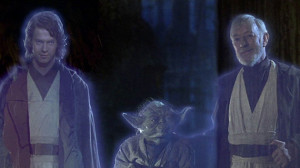
“Obi-Wan, invite the creepy guy to join us, did you?”
Jedi was also the first Star Wars film where I felt Lucas was too ambitious and the technology was not able to realize his vision. From Imperial Walkers to Tauntauns to Landspeeders to Yoda, the effects wizards in Lucas’ employ had made it all work in his previous films. But in Jedi the seams were showing — quite literally in the case of the puppets in Jabba’s palace. From the shoddy matting of the Rancor to the poor articulation in the Ewok faces, this is the Star Wars film that looks the most fake.
Lucas would try to fix some of these technical issues in myriad re-releases, starting with the Special Edition in 1997. Each time Jedi got a little worse, right down to the creepy insertion of Hayden Christensen at the end, and Darth Vader’s lame battle cry of “Noooooo.”
Still, despite these issues, the core storyline of Vader’s redemption, a son’s determination to save his father, and the final battle between good and evil makes this a worthy entry in the Star Wars franchise.
But this experience — anticipating a film so hotly that I was near-obsessed — was euphoric. To this day few experiences in my life are as pleasurable as the anticipation for a great, exciting movie.
It was this level of hype I had for the remake of Friday the 13th that launched Now Playing Podcast’s first retrospective series. That same hype for The Avengers, more than one year before its release, instigated Now Playing’s Marvel Movie Retrospective.
As for future hype, I look at Star Wars Episode VII. I believed for 30 years that the Star Wars story ended with Return of the Jedi, but Lucas’ decision to retire — combined with Disney shareholders’ lust for profit — mean the story will continue. Part of me feels like this is a spinoff, a story based on characters created by George Lucas. Episode VII is in completely unnecessary, save for the Disney folks who watch it with dollar signs in their eyes.
But… it could be good. The recent reveal of an X-Wing is pulling at my nostalgic love for the original trilogy. Certainly all the marketers at Disney will try to seduce me. The images revealed, the first trailers, will all be Episode VII courting me, teasing me, trying to gain my interest and make me excited. Time will tell if Star Wars can still get me hot and bothered 32 years later.
But I’ll never forget my first, and as such Return of the Jedi will always be special.
Arnie is a movie critic for Now Playing Podcast, a book reviewer for the Books & Nachos podcast, and co-host of the collecting podcasts Star Wars Action News and Marvelicious Toys. You can follow him on Twitter @thearniec
August 13, 2014 Posted by Arnie C | 40-Year-Old Critic, Marvelicious Toys, Movies, Podcasts, Reviews, Star Wars, Star Wars Action News | 40-Year-Old Critic, Arnie, Books, Collecting, Enertainment, Ewok, Film, George Lucas, Hasbro, Kenner, Now Playing, Now Playing Podcast, Podcasts, Return of the Jedi, Review, Reviews, sci-fi, Star Wars, Star Wars Action News, Toys | 3 Comments
40 Year-Old-Critic: Raiders of the Lost Ark (1981)
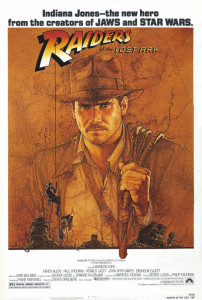 In The 40-Year-Old Critic, Venganza Media creator and host Arnie Carvalho recalls a memorable film for each year of his life. This series appears daily on the Venganza Media Gazette.
In The 40-Year-Old Critic, Venganza Media creator and host Arnie Carvalho recalls a memorable film for each year of his life. This series appears daily on the Venganza Media Gazette.
I wrote at length about the summer blockbuster in the 1975 installment of this retrospective series discussing Jaws. I recalled how it seemed each year had one movie that everyone was talking about. Hollywood now gives its tentpole pictures one or two weeks to make an impact, but when I was a kid the biggest films ran for months and would remain in the public conversation for years.
In 1981 I learned what it was like to be on the outside of that conversation.
I spent a lot of time at the movies as a kid. I remember a summer program in our town that screened older, child-friendly films each week for just $1 — a small price for my mother to pay to have me sit quietly for two hours. My mother, my godmother, and my sister would coordinate schedules to take me to see those summer films and, being the completist that I am, I refused to miss a single installment.
Not content with the preprogrammed children’s fare, I started to make my own decisions about which new releases I would see. I remember begging my mother to take me to Clash of the Titans, The Great Muppet Caper, Superman II, and The Fox and the Hound. But one film that totally escaped my attention was Raiders of the Lost Ark.
By the summer of ‘81 Steven Spielberg was already a name-brand director with blockbusters Jaws and Close Encounters of the Third Kind under his belt. He’d survived a rare misstep with the ill-conceived 1979 comedy 1941 and returned to form two years later with the first installment in the Indiana Jones franchise.
This film carried more than just Spielberg’s golden name. The poster boasted “From the creators of Jaws and Star Wars.” It was Spielberg’s collaboration with the man who had made the most successful film of all time… George Lucas.
With those names on the poster it is no shock that moviegoers turned out in droves to see the film, with no misgivings about its period setting — a far cry from the filmmakers’ recent science-fiction fare. Plus Raiders wisely featured a strong supernatural bent for those who appreciated the fantastical elements of Close Encounters and Star Wars.
Raiders of the Lost Ark went on to become the top-grossing film of 1981. It was a cultural smash, a critical darling, and nominated for several Academy Awards.
I totally missed it.
The first Indiana Jones movie opened in our town on June 12 — the same day as Clash of the Titans. I didn’t just choose to see Greek gods over Indiana Jones, I have no memory of knowing Raiders of the Lost Ark was out there. Soon after, Superman II opened, and that was the movie I’d been waiting to see.
Raiders was totally lost on me.
When school resumed that fall it didn’t take long for me to realize I’d missed something huge. Now a second-grader, I returned to classrooms ready to reunite with schoolyard friends and talk about Clash of the Titans and Superman II, but the only movie on their minds starred some guy with a whip. Playground chums regaled me with tales of the swordsman who performed deft moves only to be quickly shot dead, and that magical box that made Nazi faces melt. I had nothing to add to these conversations, I could only nod and say it sounded fun.
 This feeling of isolation continued for years, and I felt Raiders of the Lost Ark would taunt me forever. For Christmas in 1982 my sister Susan bought me the Raiders of the Lost Ark Atari 2600 game. She was now a college student and assumed I’d seen the film and loved it. I played that game for days, trying to use it as a surrogate for the movies I’d missed. I created a story in my mind featuring snakes and whips and anchs and black markets.
This feeling of isolation continued for years, and I felt Raiders of the Lost Ark would taunt me forever. For Christmas in 1982 my sister Susan bought me the Raiders of the Lost Ark Atari 2600 game. She was now a college student and assumed I’d seen the film and loved it. I played that game for days, trying to use it as a surrogate for the movies I’d missed. I created a story in my mind featuring snakes and whips and anchs and black markets.
Finally, the next year, my long nightmare ended.
In late 1982 my family bought our first VCR and, a few months later, we rented Raiders of the Lost Ark on VHS. Of course, I loved the film (and was surprisingly happy to see how little it resembled its Atari counterpart). It was exciting and funny, and also a bit scary. I had nightmares for months about those melting faces. Though I would rewatch Raiders regularly on video, for the first year or more I would cover my own eyes during the bloody climax.
Then, in 1984, when Indiana Jones and the Temple of Doom was released, I ensured I didn’t make the same mistake — I saw the sequel twice on opening weekend and read the novelization.
I still watch Raiders of the Lost Ark regularly to this day (though I now laugh at the effects that made me wince as a child). Just this past summer I went on a fishing trip with friends and we gathered around the cabin’s small television to watch Harrison Ford in his second-best role. We applauded its genius, debated the importance of Indy in the movie’s plot, and lamented the franchise’s abysmal fourth installment.
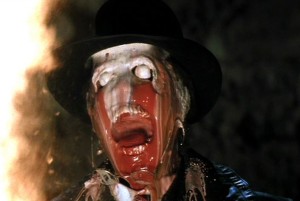 Raiders of the Lost Ark was the best film of 1981, but it also taught me the importance of cinema as part of a cultural conversation. Shared experience creates a community, and in the 1980s part of our nationwide identity was defined by blockbuster films. National defense programs were named after sci-fi flicks, presidential candidates quoted hit movies, and playground friendships were made and broken by what you saw over summer vacation.
Raiders of the Lost Ark was the best film of 1981, but it also taught me the importance of cinema as part of a cultural conversation. Shared experience creates a community, and in the 1980s part of our nationwide identity was defined by blockbuster films. National defense programs were named after sci-fi flicks, presidential candidates quoted hit movies, and playground friendships were made and broken by what you saw over summer vacation.
I do feel that today some of the magic is lost when there is a new “must see” movie every weekend. It waters down the experience. Now there are more fractured groups of fans, and rarely is there a film like Titanic, Star Wars, E.T., or Raiders of the Lost Ark that can transcend age, race, and gender and become a cultural phenomenon.
At 6 years old I learned how important that was, thanks to Raiders, and it’s a belief I hold today.
Next — 1982!
Arnie is a movie critic for Now Playing Podcast, a book reviewer for the Books & Nachos podcast, and co-host of the collecting podcasts Star Wars Action News and Marvelicious Toys. You can follow him on Twitter @thearniec
August 11, 2014 Posted by Arnie C | 40-Year-Old Critic, Movies, Now Playing Podcast, Podcasts, Reviews | 1981, 40-Year-Old Critic, Clash of the Titans, George Lucas, Harrison Ford, Indiana Jones, Now Playing, Now Playing Podcast, Podcasts, Raiders of the Lost Ark, Review, Reviews, Steven Spielberg, Superman | 4 Comments
40 Year-Old-Critic: Popeye (1980)
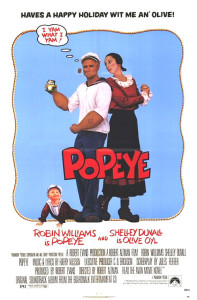 In The 40-Year-Old Critic, Venganza Media creator and host Arnie Carvalho recalls a memorable film for each year of his life. This series appears daily on the Venganza Media Gazette.
In The 40-Year-Old Critic, Venganza Media creator and host Arnie Carvalho recalls a memorable film for each year of his life. This series appears daily on the Venganza Media Gazette.
What, you thought The Empire Strikes Back was a given for 1980? Absolutely not! Let me explain.
1980 is a special year for me because it is the first year I can actually remember seeing movies in theaters. I have vivid recollections of my mother taking me to see The Empire Strikes Back on a hot summer day while weekending in Chicago, and I remember going to see Superman II when it opened at our local mall. And I remember later that year my sister Susan taking me to see the Robin Williams “comedy” Popeye, and sadly this is the moviegoing experience I remember best of all.
As a child I loved cartoons. Mostly, I was interested in superheroes like Superman, but I watched the Bozo show religiously and it featured a variety of cartoons, including Tom and Jerry, Mighty Mouse, and Popeye. I consumed this animated fare as part of a daily television diet.
My TV viewing was not confined to mornings, I was also starting to watch prime time shows. Being the youngest child in the house I rarely choose what shows were on our one television. Occasionally, when I was alone, I’d get to see Dukes of Hazzard or The Incredible Hulk. But most nights I watched whatever my older sisters wanted to see.
Their tastes ran to sitcoms of the day: Happy Days, The Jeffersons, Three’s Company,The Facts of Life, and my absolute favorite, Mork & Mindy. Robin Williams’ character, along with his colorful costumes, kept my attention for the full half-hour every Thursday night.
So, Williams as Popeye? It had to be a no-brainer for Susan to take her kid brother to that movie. To this day, the experience of seeing that film is burned into my brain.
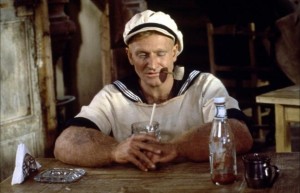
I yam what I yam…a bad movie.
My first reaction to this dirty, ugly picture was, “This isn’t my Popeye!” I wasn’t sure what had happened to the character I loved from The Bozo Show, but as shown on-screen “our hero” Popeye was beaten down and disavowed. His every scene seemed to be a boring exercise in humiliation. Worst, this Popeye hated spinach! A recent rewatch made it clear that the ingestion of that canned plant is the character’s arc — his origin story — but to a 6-year-old it seemed this movie didn’t know the first thing about the cartoon I loved. It lacked the crazy, fast-paced antics of the animated show and replaced it with warbled songs sung by Shelley Duvall and Robin Williams, neither of whom should ever be allowed to sing again (Aladdin aside). It seems even Williams was embarrassed during the making of the movie–he looks depressed in nearly every scene.
And it wasn’t just Williams, it was everyone. As Pappy, Ray Walston was a frightening character who denied Popeye’s parentage. Bluto was a bully that seemed comical in animation, but when personified in the flesh his hairy bulk repulsed me.
At 6 years old I did not yet possess the vocabulary to express how this movie made me feel. I did not know the meaning of words like “abrasive” or “grimy.” I couldn’t properly express that Popeye lacked the fun, spirited tone of the cartoon, and that its rundown river-town setting made me feel like I needed a hot bath. I didn’t just experience disappointment, I had a feeling of utter betrayal — and not just by Popeye. I wasn’t that big of a fan where an inaccurate on-screen portrayal would scar me.
No, I felt betrayed by cinema.
Up until this point in my life I’d had a magical experience every time I had gone to the movies. I’d seen Yoda teach Luke Skywalker about good and evil. I’d listened to Muppets sing and loved it. I’d seen God in the guise of George Burns. I’d been enthralled as Mickey Mouse made brooms dance. I’d believed a man could fly! I hadn’t seen a lot of movies in theaters at this age, but each one seemed hand-picked for maximum enjoyment. I thought the movie theater was a place where only good things happened.
Seeing Popeye made me realize, for the first time, that a movie could be really, truly terrible. In some ways, it was the death of my childhood innocence.
I insisted my sister take me back to the movies a week later to wash the taste of spinach out of my mouth. She picked a film I hadn’t heard of, Flash Gordon. Again, I thought I would be seeing another cartoon hero come to life (I’d mistaken it for the DC Comics hero, The Flash).
It was like a one-two punch, Popeye and Flash Gordon. I’d never look at movies the same again.
From the moment I walked, shell-shocked, out of that mall theater something inside me changed. My trust in the silver screen was broken. It would take many years for me to fully comprehend the enormity of that concept — that choices had to be made where I spent my money and time — but it all started with what surely must be director Robert Altman’s worst picture.
I am now about to turn 40, but inside I’m still a 6-year-old every time I go into a theater. I still hope every movie I watch — especially every theater-going experience — will be magical and wondrous. And I still feel betrayed when I’m instead given something as disastrous as Popeye or Aliens vs Predator.
At least now I can channel those memories and spare others from the letdown I experienced. As a critic on Now Playing Podcast I, hopefully, can warn people when there’s a Popeye at the multiplex. Also, as an adult, I can now fully put into words those negative feelings I had as a child.
Thinking now about 1980, I realize so many films I love today were released that year: The Empire Strikes Back, The Blues Brothers, Raging Bull, Ordinary People, and, of course, the original Friday the 13th. I have memories of seeing them all, but none are as vivid as that horrible Saturday when I saw Popeye.
Next — 1981!
Arnie is a movie critic for Now Playing Podcast, a book reviewer for the Books & Nachos podcast, and co-host of the collecting podcasts Star Wars Action News and Marvelicious Toys. You can follow him on Twitter @thearniec
August 10, 2014 Posted by Arnie C | 40-Year-Old Critic, Comic Books, Movies, Now Playing Podcast, Podcasts, Reviews, Television | 40-Year-Old Critic, Bluto, Cartoon, Comedy, Flash Gordon, Movie, Movies, Now Playing, Now Playing Podcast, Olive Oil, Popeye, Review, Reviews, Robin Williams, Shelly Duvall | 4 Comments
40 Year-Old-Critic: Love at First Bite (1979)
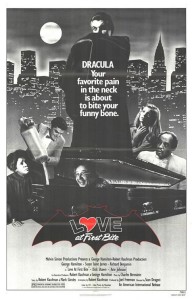 In The 40-Year-Old Critic, Venganza Media creator and host Arnie Carvalho recalls a memorable film for each year of his life. This series appears daily on the Venganza Media Gazette.
In The 40-Year-Old Critic, Venganza Media creator and host Arnie Carvalho recalls a memorable film for each year of his life. This series appears daily on the Venganza Media Gazette.
It’s not easy to choose a favorite film from 1979 — so many of that year’s films have influenced my life in one way or another, from The Muppet Movie, which solidified a love for the older-skewing Muppets, to Alien, which scared the pants off me (and Sigourney Weaver), to The Jerk (which may be Steve Martin’s finest ludicrous performance). And I cannot leave out Francis Ford Coppola’s mad masterpiece Apocalypse Now, which is certainly the most engaging and best-made film from 1979.
But while I always enjoy getting lost in the jungles of Coppola’s Vietnam, I didn’t see the film until adulthood, and it hasn’t shaped my life or my views.
The movie that did was a little George Hamilton horror spoof, Love At First Bite. The story tells of Dracula (George Hamilton) coming to (then) modern-day New York City to find his true love Mina Harker, who has been reincarnated as supermodel Cindy (Susan Saint James). His quest is thwarted by Cindy’s psychiatrist boyfriend Jeffrey Rosenberg (Richard Benjamin), who also just happens to be a descendant of Dracula’s nemesis van Helsing.
Barely in first grade, I was probably far too young to be watching Love At First Bite. I was too naieve to really understand all the references to the swinging seventies, and the meaning of the word “kinky.” More, the social commentary about urban youth rehabilitation, psychiatry, and religion was all mostly lost on me.
Yet I was enraptured by this movie. As I have mentioned in previous reviews, I have always been fascinated by horror. I was mesmerized by trailers on television for movies like Friday the 13th and Evil Dead. It was as if seeing them would be like reading from the Necronomicon itself, opening me to a world of demons and monsters. To an imaginative young boy that thought is rapturous, and terrifying. I would watch horror films through slatted fingers; I could not bear to see the monsters but I also could not look away. The few times I would try to watch horror films — including Frank Langella’s Dracula from this same year — I needed an adult nearby to protect me from the “evil” radiating from the screen.
But in Love at First Bite — here was a Dracula I could handle. Hamilton was sharing the screen with familiar faces like George and Weezie Jefferson (Sherman Hemsley and Isabel Sanford, respectively). He didn’t want to slaughter innocents, he wanted to be reunited with his centuries-old-love! He wasn’t turning people into ghastly, zombie-like minions, he was feeding on winos and getting drunk off their blood! I understood this Dracula to be silly.
Now, just because I thought he was funny didn’t mean I wasn’t also in awe of Dracula, his immortality and powers. His magical ability to transform into bats and dogs, and his thirst for blood, still held me in thrall. The movie didn’t intend it, but I must admit, I was slightly afraid of George Hamilton’s Dracula.
This was a movie that made horror accessible to a 6-year-old. It was the stepping stone for me between Sesame Street’s Count (always my favorite Muppet, as I secretly hoped one day he’d count the other Muppets on which he’d fed) and true horror killers like Freddy and Jason. I especially liked the crazy antics of Arte Johnson as Dracula’s servant Renfield, the actor throwing himself into the role with wild abandon.
I have since revisited Love at First Bite and can see its many flaws. The film is very much a product of its time. It’s a desperate Mel Brooks wannabe, attempting to be a vampire version of Young Frankenstein, but, strangely, adds the racist humor of Blazing Saddles. The jokes are dated and most don’t hold up, the effects are shoddy and obvious, and while the score is amazing, the best song in the movie — Alicia Bridges’ “I Love the Nightlife” — has been cut from home video releases due to rights issues. Still, some of the Dracula jokes, such as “Creatures of the night….shut up!” still make me giggle. Revisiting Love at First Bite in 2014 was not a rewarding experience and if this were a review for Now Playing Podcast, I’d struggle with giving it a recommend.
Yet this film helped me accept a dichotomy in my own mind that monsters could be frightening and alluring. Just as I was repulsed by — yet drawn to — horror films, Cindy was drawn to — yet frightened by — her undead on-screen lover. The fine line between terror and turn-on was revealed to me. It’s something I’d explore further in Hellraiser, but I recognize that I was first exposed to it by Love at First Bite.
In the 30-some years since I have read Bram Stoker’s original novel and watched countless versions of the quintessential vampire on screen, but when I think of Dracula, it’s George Hamilton that I picture in my mind. So for that long-lasting bite this film gave me, it is the film from 1979 that I remember most.
Next — 1980!
Arnie is a movie critic for Now Playing Podcast, a book reviewer for the Books & Nachos podcast, and co-host of the collecting podcasts Star Wars Action News and Marvelicious Toys. You can follow him on Twitter @thearniec
August 9, 2014 Posted by Arnie C | 40-Year-Old Critic, Movies, Now Playing Podcast, Podcasts, Reviews | 40-Year-Old Critic, Arnie, Comedy, Dracula, Entertainment, Film, George Hamilton, Love at First Bite, Movie, Movies, Now Playing, Now Playing Podcast, Podcasts, Review, Reviews, Vampire | 2 Comments
Now Playing soars on iTunes, Bleeding Cool covers ‘The 40-Year-Old Critic’
Venganza Media celebrated dual successes on Thursday, as Now Playing Podcast’s Guardians of the Galaxy review cracked the Top 5 on iTunes, while the company’s latest project — Arnie Carvalho’s The 40-Year-Old Critic — received a welcome reception from pop culture website BleedingCool.com.
“I love hearing people talk passionately about their interests, and there are fewer people that do so with as much vigor and resourcefulness as one Arnie Carvalho,” Bleeding Cool’s Jeremy Konrad wrote of the Venganza Media founder and Now Playing Podcast co-host.
In anticipation of his 40th birthday, Carvalho has been taking a look back at an influential film for every year of his life. That list includes hits like Jaws and E.T., but also notorious flops such as Popeye and Howard the Duck – the latter having previously been featured in one of Now Playing Podcast’s most famous episodes.
Konrad’s Q&A also covers the podcast’s popular donation shows, Carvalho’s toy collection, and Now Playing Podcast’s continued dominance of Apple’s iTunes podcast page.
Now Playing Podcast is currently featured in iTunes “What’s Hot” section, and on Thursday the review of Guardians of the Galaxy reached No. 3 on the Top 200 TV & Film episode chart. The review — released Monday — is the latest entry into Now Playing’s celebrated Marvel Comics Movie Retrospective Series, which began in 2011 and has covered every theatrical and television film featuring a Marvel superhero.
Now Playing Podcast is also wrapping up its Teenage Mutant Ninja Turtles retrospective, with the final film in the five-episode series scheduled for release Tuesday, Aug. 12.
https://venganzamedia.com/Gazette/2014/07/31/venganza-media-announces-the-40-year-old-critic-series/
August 8, 2014 Posted by Arnie C | 40-Year-Old Critic, Comic Books, Marvelicious Toys, Movies, News, Now Playing Podcast, Podcasts, Reviews, Site Information, Star Wars Action News | 40-Year-Old Critic, BleedingCool, Howard the Duck, Jeremy Konrad, Marvel, Marvelicious Toys, Movies, Now Playing, Now Playing Podcast, Press Release, Review, Star Wars, Star Wars Action News, Venganza Media | Comments Off on Now Playing soars on iTunes, Bleeding Cool covers ‘The 40-Year-Old Critic’
40 Year-Old-Critic: Superman (1978)
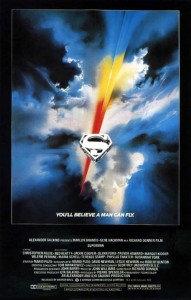 In The 40-Year-Old Critic, Venganza Media creator and host Arnie Carvalho recalls a memorable film for each year of his life. This series appears daily on the Venganza Media Gazette.
In The 40-Year-Old Critic, Venganza Media creator and host Arnie Carvalho recalls a memorable film for each year of his life. This series appears daily on the Venganza Media Gazette.
I look at 1978 as the middle-child of movie years. Moviegoers were still wowed by 1977’s Star Wars, which was continuing to play on many screens in’78. Lucas’ masterpiece had just set Hollywood on its own space race, but it took a couple of years for Lucas imitators and other sci-fi directors to get their films produced. As such, many of the sci-fi films I grew up with and celebrate as seminal were not released until 1979. But what about the year in-between? It had Dawn of the Dead, a smart mix of social commentary and horror, and Grease, which is a fun sing-a-long romp that I’ve watched more times than I can count. Still, neither changed my life nor my view of film. And please don’t bring up Jaws 2, Animal House, or Every Which Way But Loose. No, in 1978 there are only two films that resonated with me. The first was Halloween, an annual must-watch for me that iterated the Texas Chain Saw Massacre formula and is the father of the 80s slasher film. But its impact pales in comparison to the single 1978 movie that made me believe a man could fly — Superman: The Movie. I was 4 years old when this superhero film was released, but my parents took me to see this in theaters despite my young age. In one viewing my focus changed.
I’ve gone back and looked at family photo albums. From September ‘74 through November ‘78 all my photos were full of the usual childhood accouterments: I had PlaySkool’s wooden Sesame Street figures, clown items, Cookie Monster designs on my 4th birthday cake. You can see the changes after December ‘78. My clothes were no longer Big Bird T-Shirts, now they were superhero Underoos. Away went the baby PlaySkool toys and, in their place, was a collection of Mego Superheroes. And on my bedroom wall were two new posters: Lou Ferrigno as CBS’s The Incredible Hulk, and Christopher Reeve, arm pointing to the sky, advertising Superman: The Movie. Obviously, many films captured my imagination (and my parents’ dollars) as a child. That alone is not enough to warrant the title of Most Important Film of 1978. However, when I look at my life, and when I look at the hit movies of today, it’s impossible not to see the legacy of star Christopher Reeve and director Richard Donner. In the mid-70s superheroes were seen as campy entertainment for children. Comic books had long been stigmatized as pulp trash, and that reputation was solidified by the 1960s Batman TV series. Early drafts of Superman reflected that attitude as well (you can hear all about that in the Now Playing Podcast Superman review). But with this Superman film Donner saw an opportunity to make a more serious superhero adventure. He gave A-list stars Marlon Brando and Gene Hackman top billing, brought in state-of-the-art special effects, and allowed John Williams to create that emotional, rousing anthem for his hero. The result was a film that lived up to the promise on its poster, and as a 4-year-old I believed a man could fly. Admittedly, Superman did not completely abandon some campy scenes and performances; Ned Beatty’s Otis could have been teleported right from that 60s Batman series. Still, by taking the material as seriously as it did Donner and company created the first modern superhero film.
You can see the lineage: Superman begat 1989’s Batman, which begat The Crow five years later, which begat Blade in ‘98, which begat 2000’s X-Men (also produced by Donner), which begat 2002’s Spider-Man, which led to the creation of the Marvel Cinematic Universe, starting with Iron Man in 2008, and The Avengers four years later. And those are just the game changers. More than 100 other big-budget, major motion pictures follow Superman’s example of treating the material with respect and casting big-name stars as iconic comic characters. To this very day, almost every single superhero film is still following the mold created by Donner. As the Now Playing Podcast reviews show, the Superman series went downhill very quickly. Producers Alexander Salkind and Ilya Salkind fired Donner, and without his vision the series devolved into a Richard Pryor yuk-fest. It took Tim Burton’s Batman to remind Hollywood that audiences will turn out for a serious superhero film. Then, like Superman before it, the Batman series quickly collapsed when Burton moved on. It was finally Bryan Singer’s X-Men that ignited what has become the blockbuster movie genre of the 21st century. (Don’t get me started on what Singer did to Superman, you can hear my review of that travesty in the Now Playing Podcast archives.) As for me: seeing 1978’s Superman at such a young, impressionable age forever changed my world view. While I was never heavy into comic books, Superman turned me on to multimedia superheroes. My morning cartoons became filled with Batman and Spider-Man and Hulk, and every time there was a new comic-based television series or film I was in the audience.
I am forever chasing the sense of wonder I felt in 1978 when Clark Kent ripped open his shirt and I saw the bright red and yellow S. Better still, this is a good movie. Unlike Texas Chain Saw Massacre, which I don’t enjoy but which fathered films I love, Superman: The Movie is always a joy to watch. While the pacing (especially in the director’s cut) may bore some people, I love the character exploration and world-building that Donner indulges. This love of superhero movies would be a direct catalyst for the creation of Now Playing Podcast, a show that’s been downloaded by hundreds of thousands of people across the globe. The idea for what would become Now Playing came to me as I was leaving a screening of the Marvel Comics movie Ghost Rider, and our first review was Sam Raimi’s Spider-Man 3. The excitement for Marvel’s The Avengers kicked off Now Playing’s longest retrospective series, and turned the podcast into a weekly show as we revisited every Marvel movie, starting with George Lucas’ Howard the Duck.
It is also Marvel’s Iron Man 2 that made me a serious collector of comic book-related merchandise. That led to the creation of the podcast Marvelicious Toys and my sizable Marvel collection, full of movie-based Hot Toys figures, quarter-scale statues, and even some one-of-a-kind production materials from Howard the Duck. And while my collecting focus has been the Marvel films, I do own one single collectible from the DC universe: a Hot Toys figure of Christopher Reeve from 1978’s Superman. I own it not as a collector, but as a fan, and I display it in my home theater as a reminder that I still believe a man can fly.
Next — 1979!
Arnie is a movie critic for Now Playing Podcast, a book reviewer for the Books & Nachos podcast, and co-host of the collecting podcasts Star Wars Action News and Marvelicious Toys. You can follow him on Twitter @thearniec
August 8, 2014 Posted by Arnie C | 40-Year-Old Critic, Comic Books, Marvelicious Toys, Movies, Now Playing Podcast, Podcasts, Reviews | 40-Year-Old Critic, Arnie, Christopher Reeve, Comic Books, Comics, Enertainment, Film, Movie, Movies, Now Playing, Now Playing Podcast, Podcasts, Review, Reviews, Richard Donner, Superman | 6 Comments
40 Year-Old-Critic: Star Wars (1977)
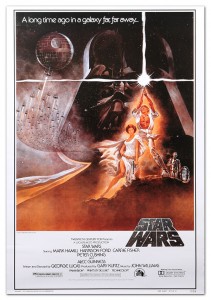 In The 40-Year-Old Critic, Venganza Media creator and host Arnie Carvalho recalls a memorable film for each year of his life. This series appears daily on the Venganza Media Gazette.
In The 40-Year-Old Critic, Venganza Media creator and host Arnie Carvalho recalls a memorable film for each year of his life. This series appears daily on the Venganza Media Gazette.
For each year of this series I spent quite a bit of time deciding which film was the most influential on my life. I read lists of all films released, as it’s certainly possible a low-grossing cult hit could have impacted me more than any blockbuster or award-winner. I spent at least 30 minutes researching every year before making my decision.
Well, every year except 1977.
I only half-jokingly ask: Were any movies released in 1977 other than Star Wars? More accurately, do any other films matter when stacked up against Star Wars? Looking at the year’s biggest films, there was Close Encounters of the Third Kind, which furthered Stephen Spielberg’s career and has legions of fans (I’m not one of them). The Woody Allen crowd will point to Oscar-winner Annie Hall. It’s an okay film but, to me, forgettable. Smokey and the Bandit and Oh, God! were products of their time, and neither aged well. Even that year’s James Bond release — The Spy who Loved Me — is a letdown.
But then there is Star Wars (and note, I refuse to call it A New Hope; when it came out in 1977 it was simply Star Wars). The film is more than a cultural phenomenon, it is a global icon. Star Wars transcends nationality, race, gender, and age. Everywhere I go, from Illinois to California to Germany to Spain to Mexico, I find Star Wars fans and collectibles.
It is not hyperbole to say Star Wars forever changed cinema. On a meager budget George Lucas’ team developed entirely new ways to film special effects. John Dykstra’s computer-controlled Dykstraflex camera allowed for dynamic, active shots of ships in space without use of visible fishing lines. The rapid-fire, Academy Award-winning editing — courtesy of Paul Hirsch, Richard Chew, and (George’s ex-wife) Marcia Lucas — created an excit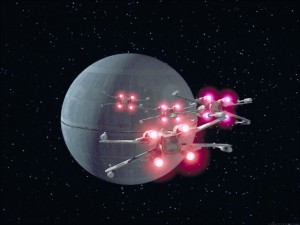 ing feel while trusting audiences to keep up with a story that starts in the middle of the action. Not only did Star Wars raise the bar for science-fiction and action spectacles, it quite literally and fundamentally changed the way movies were made.
ing feel while trusting audiences to keep up with a story that starts in the middle of the action. Not only did Star Wars raise the bar for science-fiction and action spectacles, it quite literally and fundamentally changed the way movies were made.
I have heard and read the complaints that Star Wars forever ruined movies by relying on hackneyed character tropes, choosing action over acting, and making audiences care more about the spectacle than the story.
I dismiss those comments as rhetoric. People love to lay blame, and there’s a hipster-coolness to attacking any cultural touchstone.
Yes, there are numerous Star Wars imitators that have taken these impulses to mind-numbing extremes, but that is the fault of each film’s creator. Star Wars simply showed moviegoers and movie-makers alike what could be done.
Personally, Star Wars was a film that would shape the way I view movies. As a child it made me believe in magic. In my late teens it introduced me to Campbellian mythological structure and archetypes. Honestly, it has — directly or indirectly — influenced every major decision of my life.
I’m told my parents took me to see Star Wars in 1977. I would have been 3, maybe 4 years old, and I have no memory of seeing it on the big screen.
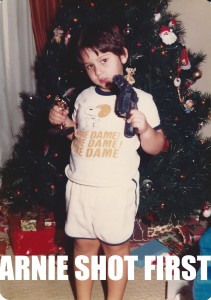 I do remember the toys. When I was still too young to read I saw a little green alien action figure (Greedo) in the toy aisle of our Kroger grocery store and I wanted him. My parents read this as me loving the film and started to buy me more figures in the toy line — which confused me at first. But over time I grew to understand not just the figures, but the movie which I watched in an endless loop for many years. Then I expanded to the video games (on the Atari 2600), Star Wars novels, role-playing games, and more.
I do remember the toys. When I was still too young to read I saw a little green alien action figure (Greedo) in the toy aisle of our Kroger grocery store and I wanted him. My parents read this as me loving the film and started to buy me more figures in the toy line — which confused me at first. But over time I grew to understand not just the figures, but the movie which I watched in an endless loop for many years. Then I expanded to the video games (on the Atari 2600), Star Wars novels, role-playing games, and more.
As the Star Wars sequels were released I became even more enthralled with the universe, and it is a love that never waned. In the late 80s, when Star Wars was in a lull, I still watched the movies and reread the books. In 1993 my college dorm held Star Wars Sundays. HBO seemed to play the trilogy every week, and I formed a bond with my fellow students through this shared childhood love.
It was Star Wars that led me to online forums. It was Star Wars that motivated me in 1996 to build my first personal website about the Star Wars toys I collected and the role-playing game I was running. In 2005, it was Star Wars that motivated me to look up the definition of a podcast, and then to dig an old microphone out of the closet and start my first show, Star Wars Action News.
Throughout the past nine years I have traveled across this country — and to Germany — taking part and speaking at several conventions. I have hosted sold-out Star Wars fan events and even presented on the Kotobukiya stage at San Diego Comic-Con.
I was honored to have StarWars.com claim my Star Wars collection was one of the largest in the world. I have had the honor of touring Lucasfilm, and even briefly met George Lucas himself. Since starting Star Wars Action News I’ve gone to new places, had new experiences, interviewed actors, producers and writers, and made dozens of new friends.
All of that goes back to this one film from 1977.
The truth is, without Star Wars you would not be reading this article. My love of Star Wars grew into a love of film, and my Star Wars podcasting grew into a network of podcasts that includes the movie review show Now Playing Podcast, which has become our most-downloaded show and a staple in the iTunes top TV & Film audio podcasts category.
As a film critic, Star Wars is the film by which I measure all other blockbusters. Transformers may have modern effects and louder explosions, but does it create the same sense of wonder in its audience? Is Sam Witwicky a suitable audience avatar — a hero in the vein of Luke Skywalker?
(Answer: he’s not. Listen to our Transformers Movie Review Retrospective to hear why.)
Now, I do realize every Star Wars film has its flaws, from wooden acting to redundant plot points to convenient character revelations. But I don’t care. I may be turning 40, but when I watch Star Wars I’m 6 years old again, and I love it.
Star Wars has shaped my life, and there is no other film from 1977 that can compete.
Tomorrow — 1978!
Arnie is a movie critic for Now Playing Podcast, a book reviewer for the Books & Nachos podcast, and co-host of the collecting podcasts Star Wars Action News and Marvelicious Toys. You can follow him on Twitter @thearniec
August 7, 2014 Posted by Arnie C | 40-Year-Old Critic, Movies, Now Playing Podcast, Podcasts, Reviews, Star Wars Action News | 1970s, 40-Year-Old Critic, Arnie, Enertainment, Force, George Lucas, Hasbro, Movie, Movies, Now Playing, Now Playing Podcast, Podcasts, Reviews, Star Wars, Star Wars Action News | 4 Comments
40 Year-Old-Critic: Jaws (1975)
 In The 40-Year-Old Critic, Venganza Media creator and host Arnie Carvalho recalls a memorable film for each year of his life. This series appears daily on the Venganza Media Gazette.
In The 40-Year-Old Critic, Venganza Media creator and host Arnie Carvalho recalls a memorable film for each year of his life. This series appears daily on the Venganza Media Gazette.
My childhood was defined by the summer blockbuster. Each year I can think of one, and only one, major movie that held me — and the entire country it seemed — in its thrall. E.T. (1982), Return of the Jedi (1983), Jurassic Park (1993), Independence Day (1996), the list goes on. Each year there seemed to be one film that unified audiences, and I could discuss this film with everyone I met. I never thought about why this was the case, it simply was a fact.
What I didn’t realize for more than thirty years was that the summer blockbuster phenomenon had not always been, but rather started just before my first birthday with the release of Steven Spielberg’s Jaws.
The director’s breakthrough film didn’t have an immediate impact on me. Jaws had become part of our cultural lexicon by the time I was able to speak. John Williams’ theme music was omnipresent in films and television, the film’s dialogue was quoted regularly, and the ride was a staple at Universal Studios theme park. As such, I never felt the need to watch Jaws — I figured pop culture had exposed me to all I needed to know. I even saw Jaws 3D before viewing the Spielberg original, the red-and-blue gimmick glasses drawing me in 1983.
Finally, in 2011, as part of Now Playing Podcast’s Spring Donation Drive (an exclusive series for donors) I watched the original Jaws and realized I only thought I knew that movie.
Jaws is not just Spielberg’s breakthrough picture, it’s the original blueprint for the stereotypical “Steven Spielberg Film.” Though it’s based on Peter Benchley’s novel, Spielberg initiated several rewrites to the script to make the film more fun, the characters more likable, and the ending more explosive.
T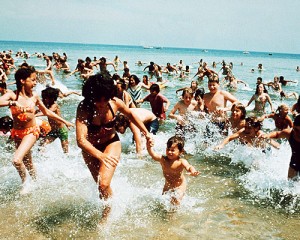 he story follows Amity Island Police Chief Martin Brody (Roy Scheider), a man who must defend his family and his town from a man-eating shark. While the story is presumably about the hunt for the shark, the film focuses more on Amity Island town politics and Brody’s relationship to his wife and children. Creating relatable character drama with a backdrop of extraordinary events is the hallmark of Spielbergian filmmaking, and it all started here with a shark tale.
he story follows Amity Island Police Chief Martin Brody (Roy Scheider), a man who must defend his family and his town from a man-eating shark. While the story is presumably about the hunt for the shark, the film focuses more on Amity Island town politics and Brody’s relationship to his wife and children. Creating relatable character drama with a backdrop of extraordinary events is the hallmark of Spielbergian filmmaking, and it all started here with a shark tale.
The result became his cinematic template — the way Amity Island is made real with its cast of colorful characters is echoed in Spielberg films I had seen throughout my childhood, films like E.T., Poltergeist, Gremlins and Goonies. I was dumbstruck when I realized that with Jaws, Spielberg created a narrative that he would copy, and see imitated by others, for decades.
The impact of Jaws, obviously, was felt even more at the box office. It changed moviegoing forever. Until that summer, Hollywood viewed the winter months as the time to release its blockbuster films; summer was a dumping ground for under-performers. But first with Jaws and, a few years later, Star Wars, Hollywood studios began to program the “summer movie.” More, the summer blockbuster had a type: high-concept, audience-pleasing characters, ever-improving special effects.
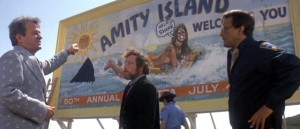 These films captivated moviegoers year-after-year, and throughout the 1980s I was one of the summer masses going to theaters for every big opening day. It was the heirs to Jaws’ legacy that made me love movies.
These films captivated moviegoers year-after-year, and throughout the 1980s I was one of the summer masses going to theaters for every big opening day. It was the heirs to Jaws’ legacy that made me love movies.
It took me 36 years to get around to watching Jaws, but when I did I immediately recognized that this film’s DNA was passed on to all of the favorite films from my youth.
Tomorrow — 1976!
Arnie is a movie critic for Now Playing Podcast, a book reviewer for the Books & Nachos podcast, and co-host of the collecting podcasts Star Wars Action News and Marvelicious Toys. You can follow him on Twitter @thearniec
August 5, 2014 Posted by Arnie C | 40-Year-Old Critic, Now Playing Podcast, Podcasts, Reviews | 40-Year-Old Critic, Arnie, Jaws, Now Playing, Now Playing Podcast, Review, Shark, Steven Spielberg, Summer Blockbuster | 6 Comments
40 Year-Old-Critic: The Texas Chain Saw Massacre (1974)
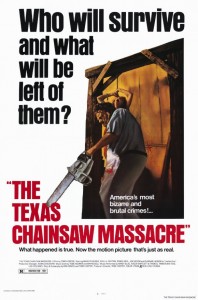 In The 40-Year-Old Critic, Venganza Media creator and host Arnie Carvalho recalls a memorable film for each year of his life. This series appears daily on the Venganza Media Gazette.
In The 40-Year-Old Critic, Venganza Media creator and host Arnie Carvalho recalls a memorable film for each year of his life. This series appears daily on the Venganza Media Gazette.
I was born in 1974, and if my parents took me to a movie that year I have no memory of the trip. In the 40 years since, I’ve caught up on many of the classics from that year such as The Godfather Part II, Blazing SaddlesThe Conversation, and Young Frankenstein. But, truthfully, none of those pictures shaped my life nearly as much as the small indie film The Texas Chain Saw Massacre.
Of course, I didn’t see this film in its original release. I was only 19 days old when Texas Chain Saw hit theaters. And while my parents were pretty lax with the content of movies I watched or books I read, even they would have had serious concerns about my watching teens carved up for food. I got into true, hard R-rated horror films when I turned 12, and the constant Chain Saw references in the 1987 Mark Harmon film Summer School had me finally rent this grindhouse film on VHS.
I was unimpressed.
I had built Leatherface up in my mind as a Freddy, a Jason, or a Michael Myers. But, in truth, Leatherface had none of the slick, commercial appeal of those later imitators. As such, the film was less fun for me as a teen. I later returned to Texas Chain Saw in 2010 for Now Playing Podcast’s retrospective series and, to the shock of many listeners, I gave it a red arrow. The cacophonic score, annoying performances, and dirty, low-budget look of the film still made it a movie I couldn’t enjoy. I labeled it “horror homework” — great for aficionados of the genre but not a film I’d recommend for the masses.
But while I may not recommend watching the film I truly recognize there are few films more important than this. It is no exaggeration to say that without The Texas Chain Saw Massacre the horror films I love may never have come to be.
First, Texas Chain Saw was a hugely successful film, costing only $300,000 to make and grossing over $30 million at the US box office (which, per BoxOfficeMojo is more than $131 million adjusted for inflation). This showed studios that inexpensive horror films could make bank.
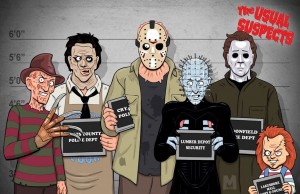 In addition to showing studios a pathway to profit, Texas Chain Saw also inspired screenwriters and directors. This film, along with Alfred Hitchcock’s Psycho, provided a template for the “slasher” sub-genre of film, combining a masked killer with an iconic weapon Later horror films like Halloween, Friday the 13th, A Nightmare on Elm Street, and even Scream and I Know What You Did Last Summer, all series that I love, took this formula and refined it for even greater success. And Leatherface’s greatest successor may just be Hannibal Lecter, another cinematic cannibal that has captured my imagination.
In addition to showing studios a pathway to profit, Texas Chain Saw also inspired screenwriters and directors. This film, along with Alfred Hitchcock’s Psycho, provided a template for the “slasher” sub-genre of film, combining a masked killer with an iconic weapon Later horror films like Halloween, Friday the 13th, A Nightmare on Elm Street, and even Scream and I Know What You Did Last Summer, all series that I love, took this formula and refined it for even greater success. And Leatherface’s greatest successor may just be Hannibal Lecter, another cinematic cannibal that has captured my imagination.
More, this film launched director Tobe Hooper into the spotlight, paving the way for him to direct Poltergeist, another seminal horror film of the haunted house variety. (And yes, we discussed how much influence Hooper had on Poltergeist in Now Playing Podcast’s 2011 Spring Donation Drive. Those podcasts are no longer available.)
While this film doesn’t click with me as entertainment, I credit Texas Chain Saw for paving the way for later horror films I love. This film was born the same time I was, and without it I would not be the man, or the movie critic, I am today.
I do, however, stand by that red arrow. As I found out when I was 13, this isn’t a film I can recommend for those looking for the same glossy thrill given by Friday the 13th Part VI. It is not a Hollywood production and it shows. But while I can’t recommend it, I love it for the future films it enabled.
Tomorrow — 1975!
Arnie is a movie critic for Now Playing Podcast, a book reviewer for the Books & Nachos podcast, and co-host of the collecting podcasts Star Wars Action News and Marvelicious Toys. You can follow him on Twitter @thearniec
August 4, 2014 Posted by Arnie C | 40-Year-Old Critic, Now Playing Podcast, Podcasts, Reviews | 40-Year-Old Critic, Arnie, Freddy, horror, Leatherface, Michael Meyers, Now Playing, Now Playing Podcast, Review, Texas Chain Saw Massacre, Texas Chainsaw Massacre, Tobe Hooper | 10 Comments
Pre-Order Alert: Hot Toys Exclusive Star-Lord Figure
“My name is Peter Quill. There’s one other name you may know me by: Star-Lord.”
No doubt, Guardians of the Galaxy has gone from Marvel’s riskiest film to date to being a sure-fire hit–the only question now is how big of a hit? But with crowd-pleasing trailers featuring Groot, Rocket Raccoon, Gamora, Drax, and, yes, Star-Lord anticipation is high for this film.
And, of course, what would a new Marvel movie be without Hot Toys based on it? 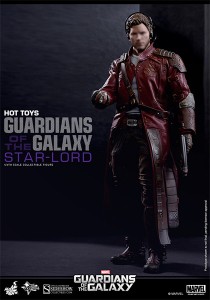
Now the third of the Guardians is up for order–and there’s an exclusive edition!
Both versions of Star-Lord come with 5 pairs of gloved palms, 2 guns, a sling pack, a cassette player, and a realistic plasma orb. But if you hurry and get the Exclusive Edition you also get handcuffs and the silver Orb we see Quill trying to steal in the trailer!
I’ve seen this figure in person at SDCC (photo above was taken by me). The coat has amazing detail and tailoring. The facial likeness is spot-on. The accessories are intricite. This is a great figure of what appears to be an amazing new character in the Marvel Cinematic Universe.
So what are you waiting for? Hurry and get your order in now, before you call Sideshow to order Star-Lord and they reply “Who??? He’s sold out.”
July 30, 2014 Posted by Arnie C | Comic Books, Marvelicious Toys, Movies, News, Podcasts | Drax, Exclusive, Gamora, Groot, Guardians of the Galaxy, Hot Toys, Marvel, Marvel Comics, Marvelicious Toys, Movie, Movies, Nova, Now Playing, Orb, Peter Quill, Podcasts, Pre-Order, Rocket Raccoon, Sideshow Collectibles, Star-Lord, Toys | Comments Off on Pre-Order Alert: Hot Toys Exclusive Star-Lord Figure
Captain America – The Winter Soldier on DVD and Blu-Ray 9/9
MARVEL’S FIRST AVENGER RETURNS IN THE YEAR’S
BIGGEST BLOCKBUSTER ACTION ADVENTURE!
MARVEL’S CAPTAIN AMERICA:
THE WINTER SOLDIER
Own The Movie That Changed Everything, along with Exclusive Bonus Features!
Get it First on Digital 3D and Digital HD, plus Disney Movies Anywhere August 19th, and on 3D Combo Pack, Blu-ray, DVD and On-Demand September 9th
BURBANK, Calif. May 30, 2014— From the studio that brought you the biggest Super Hero movie of all time, Marvel’s The Avengers, comes this year’s #1 live-action adventure, Marvel’s Captain America: The Winter Soldier, available early on Digital 3D and HD August 19th, 2014, and on 3D Blu-ray Combo Pack, Blu-ray, DVD and On-Demand September 9th, 2014, from Walt Disney Studios Home Entertainment. Saluted by critics as “action-packed” (NY Daily News), “thrilling” (Cinema Blend) and “better than The Avengers” (Access Hollywood), this blockbuster second chapter in the Captain America series teams Marvel’s First Avenger, Captain America, with Black Widow and new ally The Falcon as they battle their most mysterious and powerful enemy yet, the Winter Soldier.
Directed by Anthony and Joe Russo from a screenplay by Christopher Markus & Stephen McFeely and starring Chris Evans as Captain America, Scarlett Johansson as Black Widow, Sebastian Stan as The Winter Soldier, Anthony Mackie as The Falcon, with Robert Redford as Alexander Pierce and Samuel L. Jackson as Nick Fury,Marvel’s Captain America: The Winter Soldier arrives on 3D Blu-ray Combo Pack and Digital HD armed with explosively entertaining bonus features, including Making-of Featurettes, Audio Commentary, Never-Before-Seen Deleted Scenes, Bloopers and More…
Bring home the movie that changed everything and expand your Marvel collection in the following formats with bonus features as listed:
Bonus Materials Overview for These Products:
Digital 3D, HD, & SD*
3D Blu-ray Combo Pack (3D BD + Single Disc BD + Digital Copy)
Blu-ray
Includes:
- Making-of Featurettes
- Audio Commentary
- Never-Before-Seen Deleted Scenes
- Bloopers
- And More…
*Digital bonus offerings will vary per retailer
1-Disc DVD
Includes:
- Making-of Featurette
- Never-Before-Seen Deleted Scene
Feature Run Time: Approximately 136 minutes
Rating: Feature Film: “PG-13” in U.S., G in Canada (CE and CF)
Additional Bonus Features Not Rated
Aspect Ratio: 3-D Blu-ray Feature Film = 2.40:1
Blu-ray Feature Film = 2.40:1
DVD Feature Film = 2.40:1
Hear our review of this film now at Now Playing Podcast!
May 30, 2014 Posted by Arnie C | Comic Books, Marvelicious Toys, Movies, News, Now Playing Podcast, Podcasts | Avengers, Blu-ray, Captain America, Captain America: The Winter Soldier, Comic Books, Comics, DVD, Enertainment, Film, Marvel, Marvelicious Toys, Movie, Movies, News, Now Playing, Now Playing Podcast, Podcasts, Release, Winter Soldier | Comments Off on Captain America – The Winter Soldier on DVD and Blu-Ray 9/9
Halloween 35th Anniversary Blu-Ray: The Night HE Looks Better Than Ever!

Review copy provided courtesy of Anchor Bay
If Psycho is the granddaddy of the slasher film, Halloween is the father of modern horror. While the 1970s had its fair share of horror films, including The Texas Chain Saw Massacre and Black Christmas in ‘74, Carrie in ‘76, Dawn of the Dead in ‘78 and so many more, it was Halloween’s critical and box office success that put a new spotlight on horror cinema.
For many the Halloween season is a time to rewatch Halloween the film, and this year you can watch John Carpenter’s classic like never before. On Tuesday, September 24th, Anchor Bay releases the 35th Anniversary Edition of Halloween on Blu-ray.
Halloween has been released to home video many times. I personally have bought DVDs of the original cut, the longer cut with the TV footage added, the 25th Anniversary Edition DVD, and the original 2007 Blu-ray release. Given that I’ve spent so much money on Halloween, and that I already owned it on Blu-ray, I was skeptical that another release would be worth the purchase. It felt like another “double dip” Blu-ray release.
I quickly learned how wrong I was when I looked at the disc in person. Bound in a gorgeous, gold embossed DVD case, the video boasts an all new commentary with Carpenter and star Jamie Lee Curtis. There is also a new documentary following Curtis as she makes a rare appearance at a fan convention. These are great new bonus features for fans of the film. Additionally, as bonus features, you get an older featurette and the extra footage shot for the TV release.
I rarely find bonus features worth the repurchase of an entire movie, so despite the quality of these new additions I was still unmoved that a new copy was worth a buy. Special features, commentaries, these are items I watch once at most; it’s the film itself that gets played time and again in my home theater and which motivates my purchases. So could this new release impress me enough, especially since I already own a copy of Halloween in 1080p?
The answer is an unequivocal “YES!” With the 35th Anniversary Blu-ray you can see this horror classic at home like never before. I have seen Halloween in theaters at conventions and in the above listed DVDs and Blu-rays. With all of those in mind, I say without a doubt it has never looked better to me than it does on this video release. The picture is crisp and the motion smooth, as I have come to expect from high-grade Blu-rays. But often on even quality Blu-ray releases I’ve noticed colors that are too saturated or a picture that has had too much grain removed, giving the entire film a blurry quality. None of those earmarks of Blu-ray audience pandering are on this disc. This Blu-ray contains a brand new transfer of the film overseen by Dean Cundy, the movie’s original Director of Photography. You are now, for the first time, able to see this movie the way Cundy envisioned it as it was shot, and the difference is marked. The colors are more muted than I’ve come to expect, and the result fits both that 70s vibe as well as the film’s atmospherem. The color timing was a point of contention for many with the original Halloween Blu-ray release, and Anchor Bay has certainly corrected it here. Anchor Bay did this film a great service in hiring Cundy to oversee the video.
Additionally the audio is perfect, with a mono score for the purists, as well as a 7.1 TrueHD lossless soundtrack. Carpenter’s haunting piano and synth score has never sounded as good as it does here, and the movie audio is rich and immersing. The effects are a bit center-channel heavy, which is common for upmixes of older films, but it’s a great effort for those of us who prefer multi-channel audio.
All that said, there are a few areas where I wish this release was beefed up. There are many bonus features that were released previously, including older commentaries and documentaries, that are not included here. As such, for bonus feature collectors, this release is not a one-stop shop. Additionally, the bonus made-for-TV footage is presented in an ugly DVD resolution with colors much more saturated than the actual film. I would have liked to see the TV footage given the same treatment as the movie and a branching option available to watch both the movie’s extended cut, with those scenes reintegrated, as well as the original theatrical cut. But while these are features that would have been nice to have, they are not requirements. As I’m certain this is not the last time HE will come home on video, perhaps these bonuses are being held back for a future release.
But as stated, the true value of this disc, the “feature” I’ll revisit again and again, is the movie, and now owning this disc this is the only version of Halloween I will ever rewatch. The transfer, the audio, the overall production values, are exceptions. So Trick-or-Treat yourself to this movie, available today.
As for the movie itself, you can hear Stuart, Arnie, and Brock review Carpenter’s original Halloween as well as all the sequels, remakes, and sequels to remakes in the franchise, in the archives at NowPlayingPodcast.com
September 24, 2013 Posted by Arnie C | Movies, Now Playing Podcast, Podcasts, Reviews | 1970s, Anchor Bay, Blu-ray, Halloween, John Carpenter, Michael Myers, Movie, Movies, Now Playing, Review | Comments Off on Halloween 35th Anniversary Blu-Ray: The Night HE Looks Better Than Ever!
Review: The Chronicles of Riddick: Dark Fury
At the end of Pitch Black only three passengers of the spaceship Hunter-Gratzner were still alive. These three, Riddick, Jack, and Imam, took to space, destination unknown. Possibly New Mecca, if their little shuttle could make the trip. At the beginning of Pitch Black’s follow-up film, The Cronicles of Riddick, Riddick is a shaggy haired, scruffy bearded refugee on U.V. 6 chased by a bounty hunter named Tooms, Imam is on a planet called Hellion Prime, and Jack is a captive on the prison world of Crematoria.
Did you wonder how these three survivors split up? Why they were not all living happily together on New Mecca? Nope, those questions never crossed my mind either, but continuing to answer questions fans never asked come DVD bonus features and animated interquel films, such as The Chronicles of Riddick: Dark Fury.
This direct-to-video animated short picks up immediately where Pitch Black left off. We see Riddick’s shuttle had barely left the planet when a mercenary ship arrived and captured the three survivors of the Hunter-Gratzner. But this is no ordinary merc troupe—this cadre is led by Antonia Chillingsworth, a psychopath who equates murder with art. She has traveled the galaxy collecting the most notorious killers and turning them into frozen, living statues in her gallery, cherishing the artistry of homicide.
What are the odds of such a collector randomly stumbling across Riddick, one of the galaxies most infamous killers? Slim. But logic goes out the window early in this action-fest who’s real purpose is not to tell a story but to entice Pitch Black fans with more of Vin Diesel’s monotone lines, and more of Riddick’s talent for killing.
The short was directed by Peter Chung, and without knowing his name I knew his work—the animation style, violence, and sensibility of Dark Fury closely mirrors that of Chung’s best-known creation Aeon Flux. Despite being based on a story by Riddick’s creator David Twohy, the film has Chung’s fingerprint on every frame. As such, your opinion of Chung’s old Liquid Television action heroine will likely influence your viewing experience of this Riddick animated movie.
With Chung’s style-over-substance approach Dark Fury’s 35 minute running time drags despite being almost nonstop action from start to finish. The fights are inventively staged; Riddick’s final showdown with Junner, Chillingsworth’s lover and chief lieutenant, is a highlight. But for me the animated violence fails to adrenalize. Like the merc leader I appreciate Chung’s artistry but feel no passion for it myself.
And if the action doesn’t work there is little else in the movie. The character moments entirely reprise those from Pitch Black—Jack idolizes Riddick; Riddick will risk his life to save Jack and Imam despite seeming to care for nobody but himself. We’ve seen it all before, done better. The film also introduces a new nemesis for Riddick: Tooms. This establishes Tooms as a soldier for Chillingsworth before we see him as a merc in The Chronicles of Riddick film, creating an unnecessary bridge between the two films.
But despite being unnecessary, I enjoyed this short far more than the film that succeeded it. It is stylized and violent with a good hint of dark humor as well. I have long been a fan of Aeon Flux and appreciate Chung’s return to form. It’s something only a fan of Chung or Riddick can appreciate, but as a fan of both I give it a recommend.
September 6, 2013 Posted by Arnie C | Movies, Now Playing Podcast, Podcasts, Reviews | 2000s, Action, Animation, Direct-To-Video, DVD, Movie, Movies, Now Playing, Pitch Black, Review, Riddick, sci-fi, Vin Diesel | Comments Off on Review: The Chronicles of Riddick: Dark Fury
Review: Into Pitch Black
Before Pitch Black hit theaters audiences were invited Into Pitch Black–a Sci Fi Channel special promoting the film. But unlike most TV specials promoting new release films with their behind-the-scenes footage and “making of” documentaries, Into Pitch Black took us into the Pitch Black universe with a fully dramatized story. It’s a rarity not included on any home release of the Riddick films, nor easily obtained online. But as part of Now Playing’s Riddick Retrospective Series I did my best merc impression and captured a copy.
Taking place several months after the events in Pitch Black we follow an unnamed law enforcement officer charged with finding escaped convict Richard B. Riddick, last seen aboard the spaceship Hunter-Gratzner. Unable to find any leads, the officer hires a female bounty hunter to help his investigation.
As the two dig into the background of several passengers on the Hunter-Gratzner we are treated to many scenes from the actual movie Pitch Black. Of the special’s 45-minute running length, about 15 minutes are scenes from the movie. We witness the spaceship’s crash-landing and several of the survivors exploring the planet. The narrative sells these scenes as information found during the investigation.
To try and expand the universe beyond the events in Pitch Black we also get footage, shot night-vision style, of “Cutter”, the psychologist who studied Riddick in prison. In the only useful piece of trivia in the special we find Cutter was the doctor who “shined” Riddick’s eyes, giving him night vision (a fact later retconned out in the video game The Chronicles of Riddick: Escape from Butcher Bay).
Despite the aspirations of being a mini-story set in Riddick’s universe, Into Pitch Black never escapes the trappings of a promo TV special. There is a lot of emphasis in teasing the audience with Pitch Black footage. More, the low production values of this special, from the washed-out home-video camerawork to the worse-than-porno acting makes this show virtually unwatchable. To have this amateurish footage intercut with high value production and acting by Keith David and Vin Diesel makes the new scenes seem even more pathetic.
I believe the obscurity of this piece is because it is an embarrassment–nothing any Riddick fan would really want to revisit. I give it a strong Not Recommend.
August 28, 2013 Posted by Arnie C | Movies, Now Playing Podcast, Podcasts, Reviews, Television | Now Playing, Pitch Black, Review, Sci-Fi Channel, Syfy, Television, Vin Diesel | Comments Off on Review: Into Pitch Black
Movie Review: Kate & Leopold
This was released on Christmas Day…I’d have preferred the lump of coal.
Today The Wolverine opens in US theaters. Excited for this next film in the X-Men saga I watched Kate & Leopold, a 2001 romantic comedy starring Meg Ryan and Hugh Jackman.
No, I wasn’t just going to watch any Jackman film; Kate & Leopold is directed by James Mangold, and based off their working relationship in this film Jackman tapped Mangold to direct The Wolverine when first choice Darren Aronofsky dropped out. Jackman has said in interviews this decision was based largely off their relationship founded during Kate & Leopold.
While Mangold has done many other respected films, including award-winning Walk the Line, Girl, Interrupted and 3:10 to Yuma, plus the Tom Cruise action/comedy Knight and Day, I wanted to see this Jackman-Mangold time-travel rom-com collaboration to set my expectations for The Wolverine. Would I see something in Kate & Leopold, a spark of creativity, a visual flare, that would show Mangold a good fit for a high-octane comic book film? Would Jackman’s performance be one no other director had been able to get from the actor? Would I see anything in this film to indicate through style or sensibility that Mangold was the man to give fans, as the TV ads state, “the Wolverine film you’ve been waiting for”?
Having now seen Kate & Leopold I certainly hope not.
Jackman stars as Leopold, a 19th century Duke and future inventor of the elevator (which, the credits admit, is not historically accurate). With his family fortune dwindling Leopold is forced to take a wealthy wife, though Leopold has never loved anyone. But at the party where his engagement will be announced Leopold spots Stuart (Liev Screiber)–a strange, shifty man carrying a miniature camera.
Stuart is actually Leopold’s great-great-grandson from present day New York City. Through the laziest time travel explanation ever (he just jumped off a bridge), Stuart came back in time to see his ancestor. But Leopold gives chase and both he and Stuart arrive in 21st Century Manhattan. There, Leopold meets Stuart’s ex-girlfriend Kate (Ryan), a cynical, bitter, career-minded woman, working in market research. Eventually Kate’s resistance melts and she falls in love with the Duke, but Leopold must return to his own time lest a paradox remove all elevators from modern life.
From the trailers and description, I expected Kate & Leopold to be a version of Back to the Future. Jackman plays a man unfamiliar with modern technology and customs, so the obvious plot would be that his focus is to return home while also falling in love. Plus the ancient-man-in-modern-times concept has many opportunities for hilarity, as seen in Jean Renot’s The Visitors.
But under Mangold’s direction Kate & Leopold eschew most all attempts at comedy or realism. The film is a banal romantic fantasy tailored for aging, lonely women. As Leopold, Jackman is polite, charming, and handsome. More, his every attention is given only to Kate–he has no job, no friends, nothing else to occupy his time; Kate is the center of his world. He makes her breakfast in the morning, does her dishes in the evening, and stands up when a lady leaves the table. Leopold doesn’t even seem to want to return to his own time, he’s happy to just stay in the future, living in Stuart’s apartment and romancing Kate.
In Ryan’s introductory scene she is doing market research on a rote rom-com which isn’t working. The researchers think the female lead is unlikeable, and the film’s director exclaims that marketers are sucking the soul from the art of film. That is certainly true of Kate & Leopold. The entire film is so obvious it is set to play to a test audience of the least sophisticated of Americans. An audience with expectations set so low as to simply find comfort in the familiar.
And a romantic comedy with Meg Ryan as the female lead is nothing if not familiar. Here, in the waning years of her popularity, her face taut and lips inflated by the work of a plastic surgeon, Ryan is breaking no new ground. Her character Kate observes a neighbor who plays the soundtrack for Breakfast at Tiffany’s every night, and the same can be said for much of Ryan’s career, stuck in an endless loop of interchangeable roles as a romantic lead. Certainly she does nothing here to broaden the range of her characters.
I am a fan of escapist fantasy, but Kate & Leopold is too obvious in its pandering, and painful to watch in that it ignores its own ironies. Kate broke up with Stuart because he was an unemployed dreamer, yet she falls in love with his ancestor who is just a more romantic version of that same persona. More, as Kate eventually travels back in time to marry Leopold, the film glosses over the icky fact that for four years Kate was sleeping with Stuart, her great-great-grandson!
The film does have several chase scenes, such as Leopold running down a mugger in Central Park and Kate having to rush to travel back in time before the portal closes. Under Mangold’s direction these scenes have no spark to them. They feel obligatory, not exciting. Kate and Leopold stole the plot from Back to the Future’s climax, but got none of its excitement.
This film is not recommended for any but the loneliest of spinsters who want to dream of finding love before their lady parts dry up.
And Kate and Leopold has given me a feeling of trepidation as I prepare to see The Wolverine. There is no doubt Jackman made friends while hanging out on sets leftover from Gangs of New York–Schreiber would play his “brother” Sabertooth in the first Wolverine film; Mangold would direct the second. But in a film this unoriginal I see nothing that makes me think Mangold is a fit for The Wolverine.
But we will find out! You can hear Now Playing’s review of The Wolverine on August 13th at NowPlayingPodcast.com
July 25, 2013 Posted by Arnie C | Comic Books, Marvelicious Toys, Movies, Now Playing Podcast, Podcasts, Reviews | 2000s, Comics, Hugh Jackman, James Mangold, Marvel, Meg Ryan, Now Playing, Review, Romance, Romantic Comedy, Romcom, Time Travel | Comments Off on Movie Review: Kate & Leopold
Film Fans of All Types Can Enjoy Days of the Dead
To someone who’s never been to a horror convention the thought could be as frightening as the blood-soaked splatter fests that appear on screen. One could imagine pale, pierced social misfits and psychopaths standing in line to meet their favorite serial killer. Many may feel if they aren’t into the gory or the grotesque then a horror convention is not for them.
That impression is totally false as shown last weekend at the Days of the Dead horror convention in Indianapolis. Of course it was a blast for those into fright films, but it also had entertainment to offer any movie lover!
One of the big draws of the convention were the large number of celebrity guests in attendance. The stereotype of a celebrity on the autograph circuit is an actor with his career on the decline, clinging to former fame. Days of the Dead proved that image wrong by bringing in several A-list celebrities promoting current films. Some of the headlining guests have big movies out soon included Danny Trejo (Machete Kills in October), Keith David (recently in Cloud Atlas and a dozen more films in production), and Academy Award Nominee Gary Busey (Behaving Badly due out this year). This is an amazing roster for a con only in its third year, besting some of the other national companies who host conventions in the Midwest.
Access to the celebrities was incredibly easy. At many conventions fans have to wait in line for four hours or more to meet their idols. At Days of the Dead my wait time to see Trejo was 10 minutes, and only 15 minutes for Busey.
More, the prices were very reasonable. At conventions such as Dragon*Con or San Diego Comic-Con I’ve paid over $100 for signatures from actors who have not worked in several decades. At Days of the Dead the majority of autographs were $20 and headliners Busey and Trejo were just $40. Trejo would take a picture free with an autograph, while Busey charged only $10 additional for a photo; at some conventions photo opportunities start at $20 and can be as high as $150.
While all of the celebrities have horror films on their resumes, Trejo would sign a copy of the comedy Bubble Boy as rapidly as the vampire film From Dusk ‘Til Dawn, and Busey had available photographs of his roles in Lethal Weapon and Point Break. I did not see anyone asking Keith David to sign their copy of Requiem for a Dream but I doubt he’d have declined.
All the guests were not just polite but completely engaged with the fans, having short conversations and truly making the con attendee feel appreciated. This is far better than the assembly-line like atmosphere found by some guests at Wizard World or New York Comic Con. In fact, the longest line to see a celebrity seemed to be A Nightmare on Elm Street 4 star Lisa Wilcox who would spend up to 5 minutes talking with her fans while signing their items. (Unfortunately for Wilcox one of those fans I observed was a socially awkward male in his twenties regaling her with a story about a specially lit photo he had of Wilcox in his bedroom…so while some of the stereotypes were present at the con most of the attendees were overwhelmingly normal).
Even the guests whose primary work was in horror had non-horror items available. For example, Wilcox is best known for starring in A Nightmare on Elm Street but the actress also had available a wide selection of photos from her single-episode guest-starring role in Star Trek: The Next Generation. As she rarely appears in the Midwest, Wilcox was a draw for Trekkers and horror fans alike. Original Nightmare on Elm Street star Heather Langenkamp also had a minor role in this summer’s Star Trek: Into Darkness.
Of course, the horror fan had much to celebrate. Icons of the genre including Tony Todd (Final Destination, Candyman, Wishmaster), Derek Mears (the Friday the 13th reboot, 2007’s The Hills Have Eyes II), Tyler Mane (Michael Myers in both Rob Zombie’s Halloween films), Leslie Easterbrook (Zombie’s Halloween and The Devil’s Rejects), several stars of Cabin Fever, and over a dozen more horror film character actors were also there.
The vendor areas of the convention were a shopper’s delight. While the non-horror fan would find less that appeals to them in the vendor booths, there were plenty of superhero toys and Star Wars collectibles to choose from. I bought an original painting based on the Howard the Duck movie!
Many booths catered to all children of the 80’s, including Don’t Eat the Gum – a company that sells trading cards from the 1980s and 1990s (and my wife should have listened to the company name as she almost broke her tooth on a stick of gum from Howard the Duck trading cards…the gum was made in 1986). Also there was Adjust Your Tracking selling movies on VHS that were never officially available on DVD.
Of course, being a horror convention, slasher-film fans could buy items not found anywhere else. Many booths offered DVDs of horror movies, including bootlegs of some incredibly rare films like Fright Night 2 and Silent Night, Deadly Night: Initiation.
There were also custom T-Shirts, paintings, and other original expressions of creative horror. At one booth Curious Goods offered custom action figures, including Rob Zombie, and Deathtroopers–Star Wars Stormtroopers turned zombies.
The exhibit floor was split into two small ballrooms, a sign that Days of the Dead is quickly outgrowing the space offered by the Wyndham Indianapolis West hotel. Having Days of the Dead split among several walled-off areas did make the convention feel smaller than it was. While it were ever too crowded, as is often found at larger conventions, the lines often crossed and merged, making celebrity areas hard to navigate. This is likely the product of becoming incredibly popular in only three years, and something I’m sure will be corrected at future conventions.
Overall Days of the Dead Indianapolis was an incredible experience, and I will certainly be attending their Chicago convention this November. While the only guests announced thus far are stars of the Return of the Living Dead and The Blair Witch Project it’s sure to be fun!
When not attending conventions across the globe Arnie can be found hosting the movie review podcast Now Playing, which has reviewed hundreds of movies of all genres, as well as the toy collecting podcasts Star Wars Action News and Marvelicious Toys. He also reviews books on the Books & Nachos podcast.
-

- Gnomes protect your flowers…by eating the babies that crawl by! Another gory custom from Curious Goods.
July 12, 2013 Posted by Arnie C | Comic Books, Conventions, Marvelicious Toys, Movies, News, Now Playing Podcast, Podcasts, Reviews, Star Wars Action News | Chicago, Comics, Curious Goods, Danny Trejo, Days of the Dead, Gary Busey, horror, HorrorCon, Illinois, Indiana, Indianapolis, Movie, Movies, News, Now Playing, Review, Television | Comments Off on Film Fans of All Types Can Enjoy Days of the Dead
-
Archives
- February 2021 (1)
- January 2021 (1)
- December 2020 (1)
- November 2020 (3)
- October 2020 (2)
- September 2020 (1)
- August 2020 (2)
- July 2020 (1)
- June 2020 (1)
- May 2020 (1)
- April 2020 (3)
- March 2020 (2)
-
Categories
-
RSS
Entries RSS
Comments RSS
Site info
Venganza Media GazetteTheme: Andreas04 by Andreas Viklund. Get a free blog at WordPress.com.




